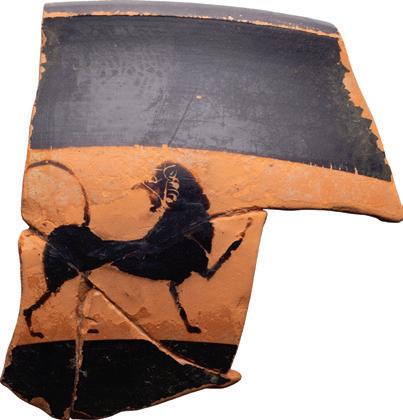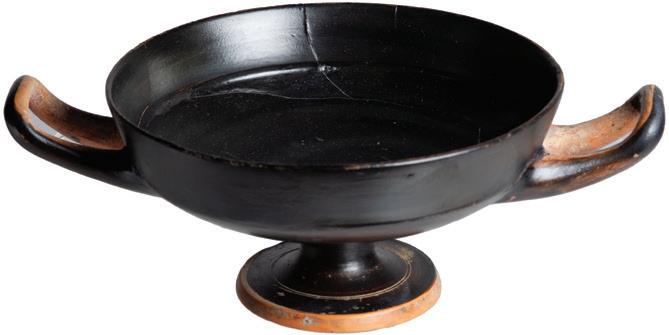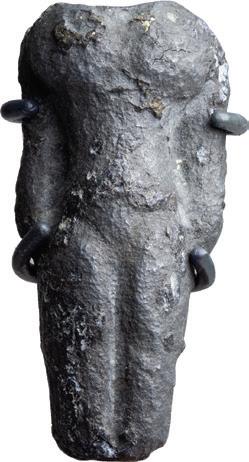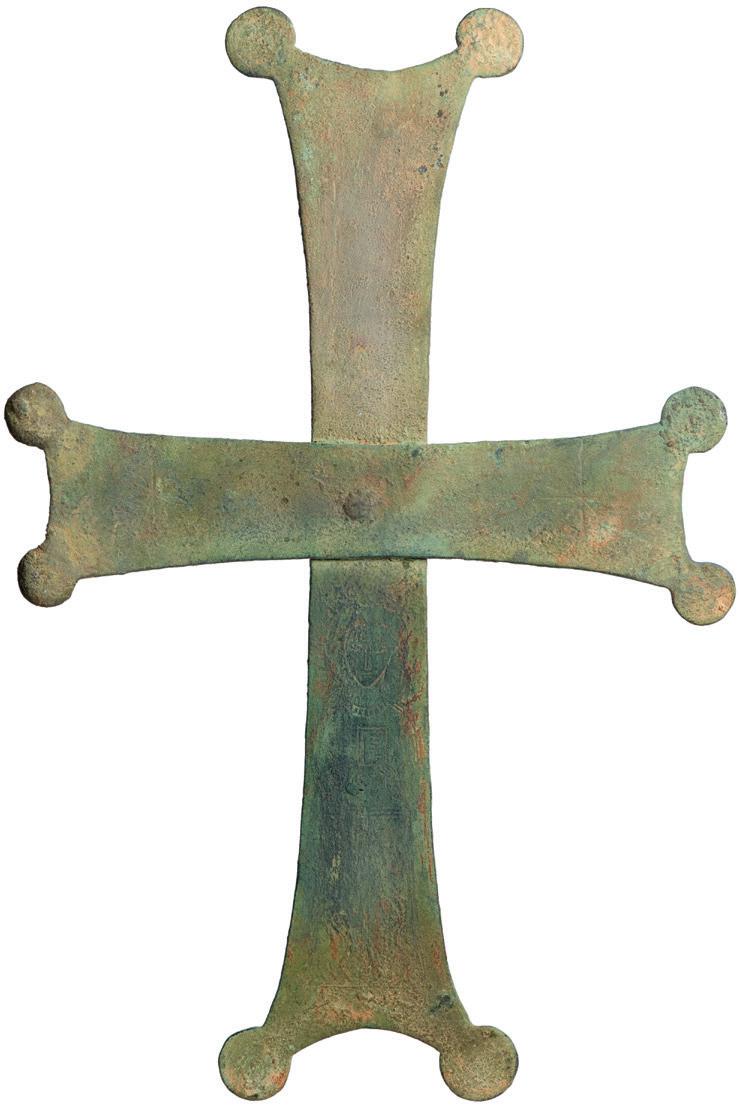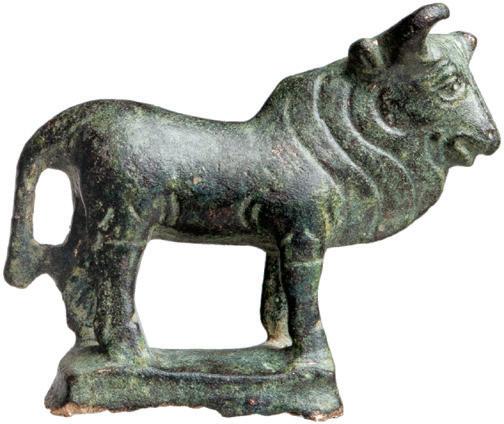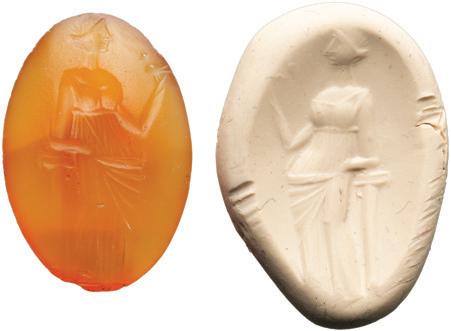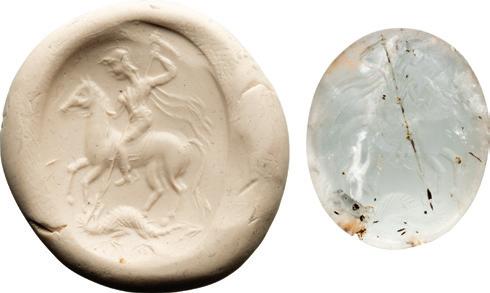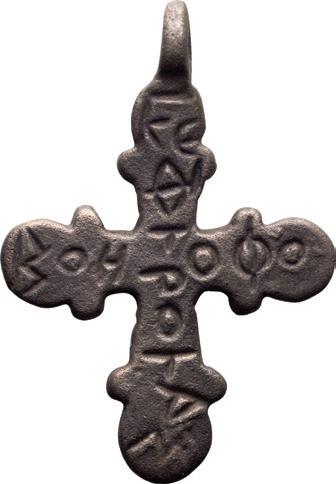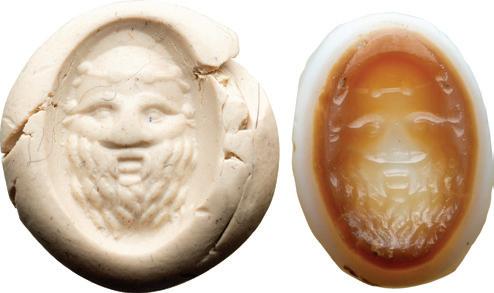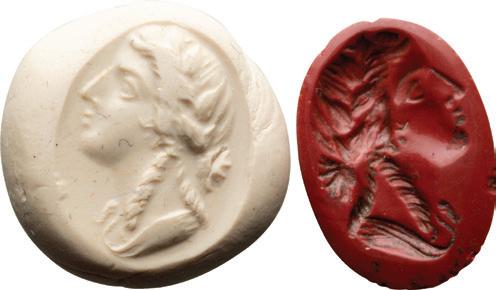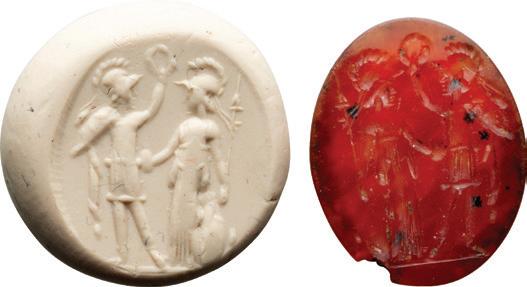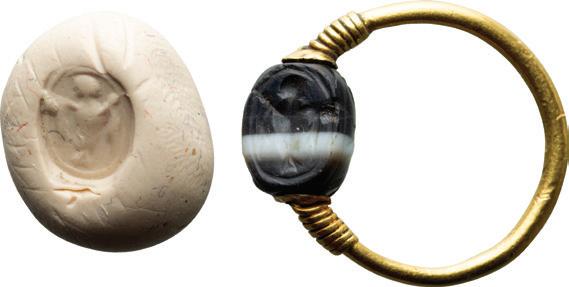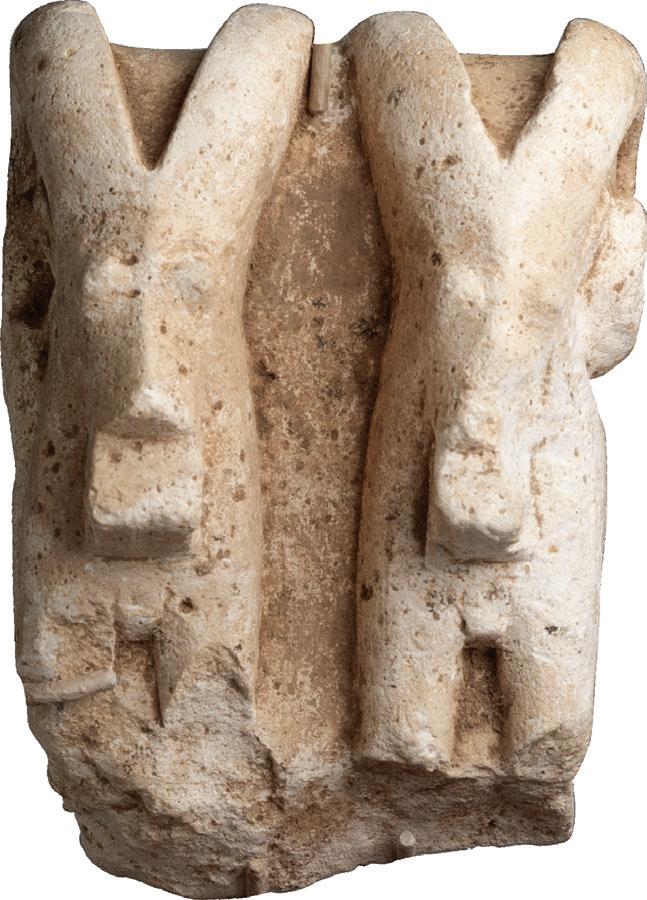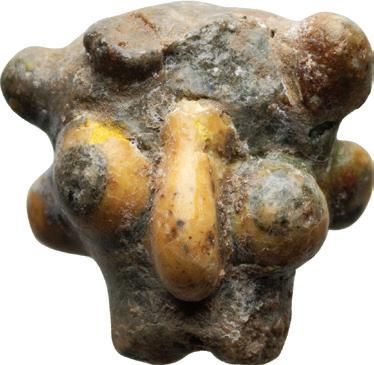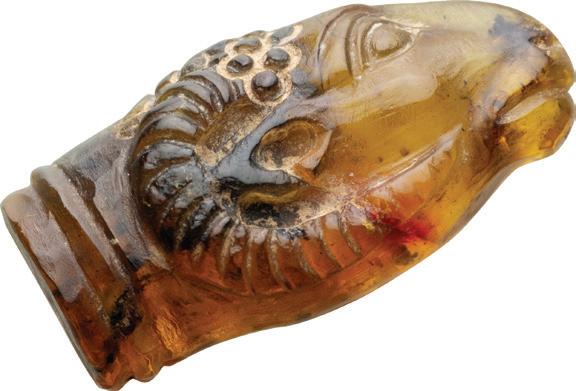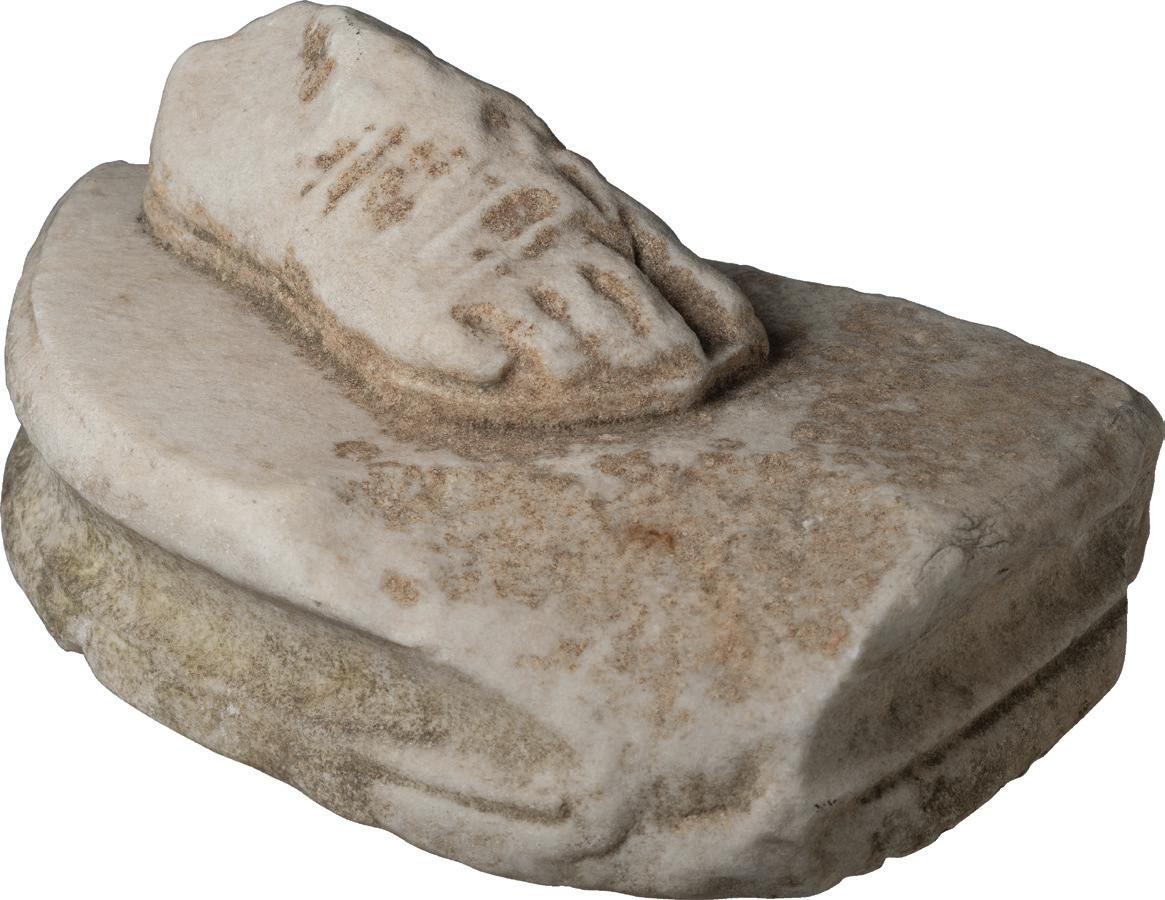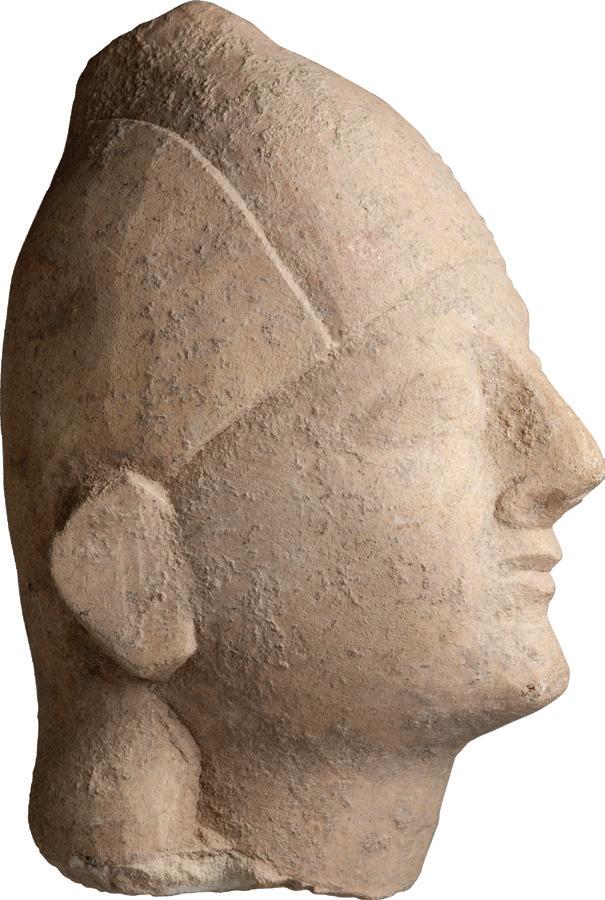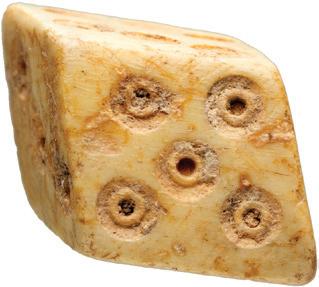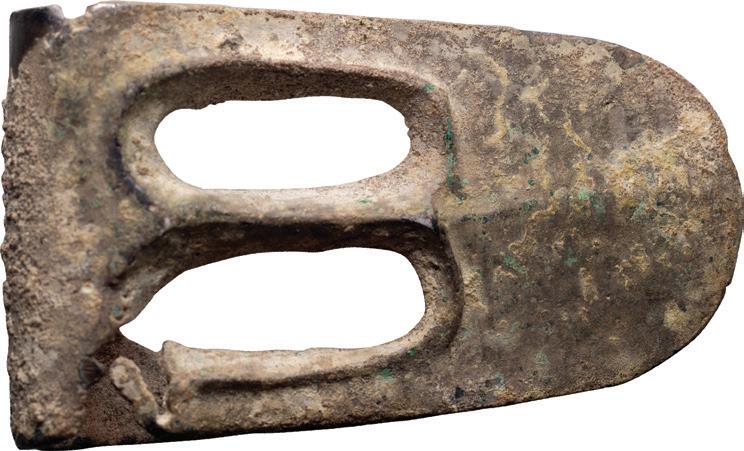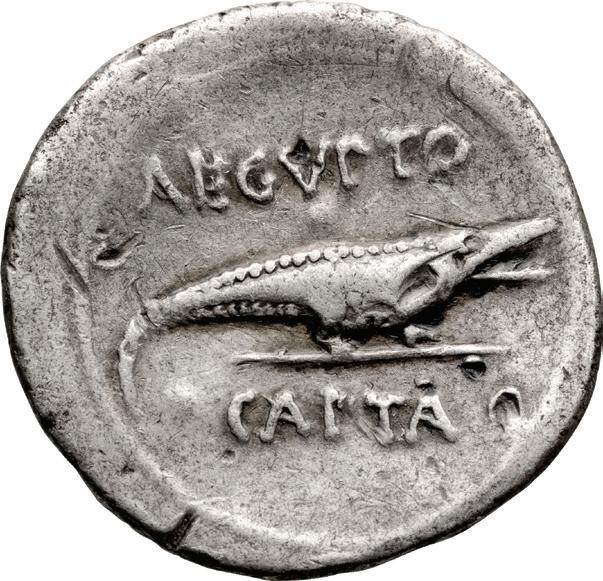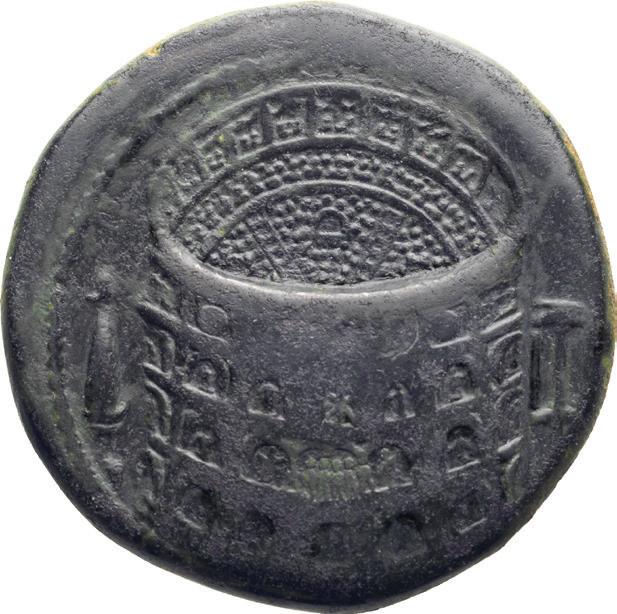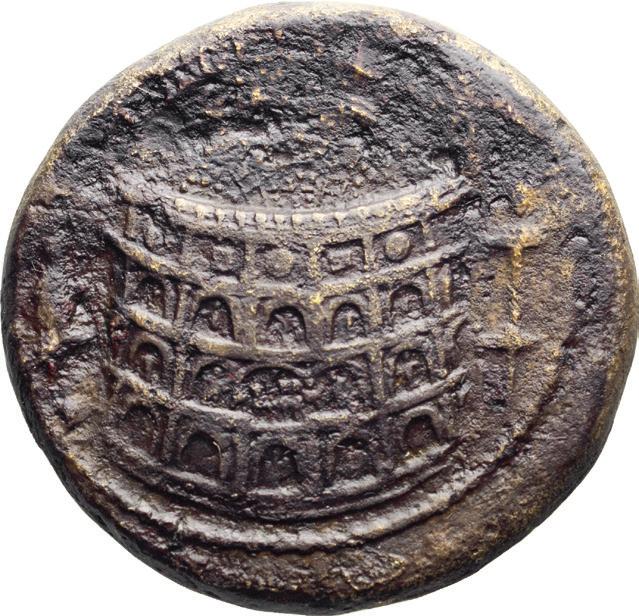Harlan J. Berk, Ltd.
“The
Art & Science of Numismatics”
232nd BUY OR BID SALE
Over
60 Years of Business




The Closing Date is August 7, 2025

“The
Over




The Closing Date is August 7, 2025
Tel: (312) 609-0018 31 N. Clark Street • Chicago, Illinois 60602
www.hjbltd.com
Facebook/Harlan J. Berk, Ltd.
YouTube/coinman.ancient
Istagram/coinman969

Fax: (312) 609-1309
Email: info@hjbltd.com OVER 60 YEARS! Established 1964

Harlan J. Berk, Ancients • Aaron Berk, Ancients & Antiquities • Curtis Clay, Roman Phil Davis, Ancients • Jay Harper, Ancients • Jennifer Saban, Antiquities • Laura Wakeland, World Pablo Saban, IT Manager • Photos & Videos by Andrew Steiner & Craig Hard • Layout by Aaron Berk
Harlan J. Berk, Ltd. has presented an innovation in antiquities and numismatics for some time now. The system is simple. When you want an antiquity or coin in the sale, just bid the estimated price by phone, fax, web site, email or post. We will send you the antiquity or coin immediately with no buyer’s fees and no waiting for the closing of the sale. Any and all antiquities or coins not sold before the closing date will be sent to the highest bidder after August 7. All items carry a lifetime guarantee of authenticity.
EXAMPLE—You bid estimate on an item valued at $100.00 and if your bid is the 1st to reach us, you will receive the item immediately at $100. If on the other hand, you bid $75.00 on the same item and are still the high bidder at the end of the sale, the item will be mailed to you after the closing. There is a 2.5% fee for credit card use. If you are ever in the area, stop in to see us! Of course, it’s best to call first. Harlan J. Berk, Ltd. reserves the right to refuse any bids.
The Curtis Clay Roman Coin Collection Lot 1-110 REGULAR LOTS START ON LOT 111
We are pleased and honored to have purchased Curtis Clay’s collection of Roman coins, amounting to over 5,000 pieces. Curtis mostly collected coins that were rare or unpublished, focusing especially on varieties unrepresented in the enormous, nearly definitive British Museum Collection. In the spotlight of Curtis’ expert knowledge and meticulous eye, seemingly common coins were recognized as extreme rarities. What we are offering today is another series of sales that will appear over the next two years or more, representing the cream of his collection. When completed, a book will be published of these coins, entitled “The Highlights of the Curtis Clay Collection”. Other coins from the collection will be offered in online sales. All coins will be labeled “Curtis Clay Collection”, and some of them will be included in the Highlights book as well. The coins offered in our Buy or Bid Sales will be in chronological order, organized by Curtis himself. Most lots will include Curtis’ original tickets, with provenance information and in some cases more extensive historical or numismatic notes than space in the catalogue allows. These sales will represent a chance for fortunate and astute collectors of Roman coins to fill their own collections with these special pieces. A rare opportunity!
1. CARACALLA; 198-217 AD, Rome, 204 AD or later, Quinarius, 1.25g. King-p. 348, 6 (5 spec.), pl. 20 and pl. H (same dies). Obv: ANTONINV[S] - PIVS AVG Head laureate r. Rx: [N]OBI - LITAS to l. and r., Nobilitas standing r. holding statuette and scepter. Ex Curtis L. Clay Collection; ex CNG E240, 8 Sept. 2010, lot 393. On aurei, denarii, sestertii, and middle bronzes, this Nobilitas reverse type was struck for Geta only, probably in 204 AD, and not also for Caracalla, as on this silver quinarius. Very rare. Obverse has ancient gilding. Light hairline on cheek. aEF 1650
2. CARACALLA; 198-217 AD, Rome, 211 AD, Quinarius, 1.54g. BM-7, pl. 65.5 (same rev. die). Obv: ANTONINVS PIVS - AVG BRIT Head laureate r. Rx: P M TR P - XIIII COS III P P on l. and r., Victory advancing l., holding [wreath] and palm over shoulder. Ex Curtis L. Clay Collection; ex CNG E183, 5 March 2008, lot 190. Possibly only the fourth known specimen, after those in the BM, Oxford, and Copenhagen as reported by Cohen-189. aEF 750
3. CARACALLA; 198-217 AD, Rome, 211-213 AD, Quinarius, 0.98g. King-p. 348, 5 (5 spec., including ours). Obv: ANTONINVS PIVS - AVG BRIT Head laureate r. Rx: COS III P P around, Victory advancing l., holding wreath and palm over shoulder. Ex Curtis L. Clay Collection; ex G. Hirsch 186, 10 May 1995, lot 1214. Only five specimens recorded by King, including ours. Small mark in upper hair. VF 450
4. CARACALLA; 198-217 AD, Rome, 215 AD, Antoninianus, 4.92g. Cf. BM-117, pl. 70.13. Obv: ANTONINVS PIVS AVG GERM Bust radiate, cuirassed r., seen from front; the cuirass strap over Caracalla’s r. shoulder is decorated with a wavy line and pellets; on his l. shoulder, fold of cloak and three short pteryges. Rx: P M TR P XVIII - COS IIII P P around, Jupiter seated l., holding Victory and scepter; at his feet, eagle standing l., head turned back r. Ex Curtis L. Clay Collection; ex Lanz, eBay, 19 Aug. 2012. Apparently not in the standard catalogues with this bust variety. Toned EF 650
5. CARACALLA; 198-217 AD, Rome, 215 AD, Antoninianus, 4.98g. Cf. BM-111. Obv: ANTONINVS PIVS AVG GERM Bust radiate, draped, cuirassed r., seen from front; on l. shoulder three pteryges from cuirass extending horizontally r. Rx: P M TR P XVIII - COS IIII P P on l. and r., Jupiter standing r., head l., holding thunderbolt at side and scepter. Ex Curtis L. Clay Collection. Toned aEF 200
6. CARACALLA; 198-217 AD, Rome, 215 AD, Antoninianus, 4.72g. BM-111. Obv: ANTONINVS PIVS AVG GERM Bust radiate, draped, cuirassed r., seen from front; on l. shoulder three pteryges from cuirass extending horizontally r. Rx: P M TR P XVIII COS IIII P P around, Jupiter standing r., head l., holding thunderbolt at side and scepter. Ex Curtis L. Clay Collection; ex Frank Robinson 97, 5 Aug. 216, lot 265. MS 450 Quadriga
7. CARACALLA; 198-217 AD, Rome, Antoninianus, 4.93g. BM-141, pl. 71.4. Obv: ANTONINVS PIVS AVG GERM Bust radiate, cuirassed r., with fold of cloak on front shoulder and behind neck. Rx: P M TR P XVIII COS IIII P P around, Sol holding reins and whip, mounting quadriga of four horses that leap l. with hind legs extended. Ex Curtis L. Clay Collection; ex CNG 41, 19 March 1997, lot 2031. Rare; only three specimens in Reka Devnia hoard. EF 425
8. CARACALLA; 198-217 AD, Rome, 215 AD, Antoninianus, 4.57g. Bust var. of BM-77. Obv: ANTONINVS PIVS AVG GERM Bust radiate, draped, cuirassed r. Rx: VENERI VICTRICI around, Venus standing l., resting l. elbow on shield set on helmet, and holding Victory and transverse scepter. Ex Curtis L. Clay Collection; acquired from Arsoff, eBay, 13 July 2006. Rare; probably only one specimen in Reka Devnia hoard. Toned. EF 400
9. CARACALLA; 198-217 AD, Rome, 216 AD, Antoninianus, 5.47g. BM-152 note, citing Reka Devnia, p. 113. Obv: ANTONINVS PIVS AVG GERM Bust radiate, draped, cuirassed r., seen from front; on l. shoulder three pteryges from cuirass extending horizontally r. Rx: P M TR P XVIIII COS IIII P P around, Jupiter standing r., head r., l. leg bent, holding thunderbolt at side and reversed spear. Ex Curtis L. Clay Collection; ex Lanz, eBay, 9 July 2010. Choice EF 350
10. CARACALLA; 198-217 AD, Rome, 216 AD, Antoninianus, 4.75g. BM-163, pl. 71.19 (same rev. die). Obv: ANTONINVS PIVS AVG GERM Bust radiate, draped r. Rx: P M TR P XVIIII COS IIII P P around, Serapis or Pluto seated l., polos on head, extending r. hand and holding vertical scepter in l.; at his feet, seated, three-headed Cerberus (weakly struck). Ex Curtis L. Clay Collection; acquired from Lanz, eBay, 8 July 2015. EF / VF 225
11. CARACALLA; 198-217 AD, Rome, 217 AD, Antoninianus, 4.90g. BMC-189 note, citing C-386. Obv: ANTONINVS PIVS AVG GERM Bust radiate, draped, cuirassed r. Rx: P M TR P XX - COS IIII P P on l. and r., Serapis wearing polos (small and indistinct) on head, seated l. on throne, holding wreath and wheat ear (?) in r. hand and vertical scepter in l. Ex Curtis L. Clay Collection; acquired from W. Phillips List 254, May 2000, no. 213. An unusual reverse type, and rare; only one specimen in Reka Devnia hoard. Toned EF / VF 400
12. CARACALLA; 198-217 AD, Rome, 217 AD, Antoninianus, 4.84g. BMC-p. 628, 183A*, citing two specimens in G.R. Arnold Collection. Obv: ANTONINVS PIVS AVG GERM Bust radiate, draped, cuirassed r. Rx: P M TR P XX COS IIII P P around, Jupiter seated l. on throne, holding patera and vertical scepter. Ex Curtis L. Clay Collection; ex Zeus E9, eBay, 20 June 2020, lot 665. EF 325
13. CARACALLA; 198-217 AD, Rome, 217 AD, Antoninianus, 5.27g. BMC-p. 628, 183A*, citing two specimens in G.R. Arnold Coll. Obv: ANTONINVS PIVS AVG GERM Bust radiate, draped, cuirassed r. Rx: P M TR P XX COS IIII P P around, Jupiter seated l. on throne, holding patera and vertical scepter. Ex Curtis L. Clay Collection; ex Naumann E79, eBay, 7 July 2019, lot 591. aEF 275
14. CARACALLA; 198-217 AD, Rome, 217 AD, Antoninianus, 3.79g. BM-187, pl. 72.17. Obv: ANTONINVS PIVS AVG GERM Bust radiate, cuirassed r., seen from front. Rx: P
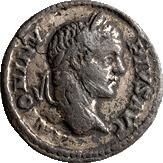
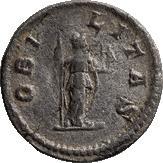
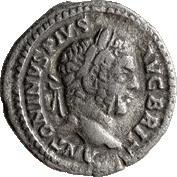
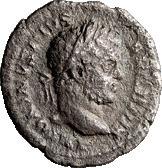

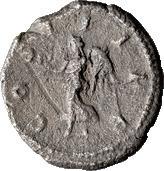



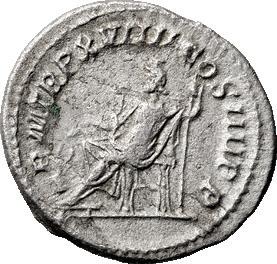




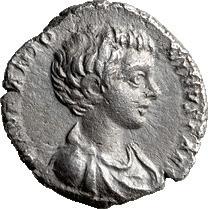
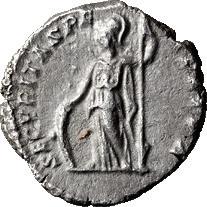
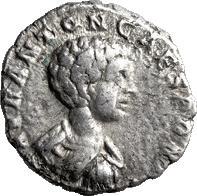
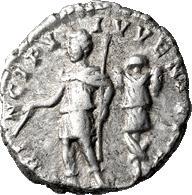
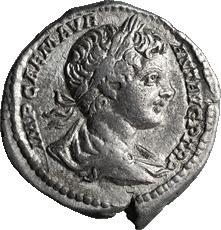
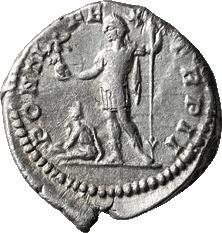
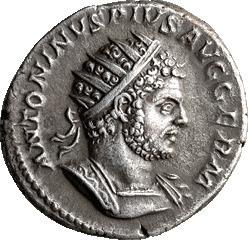
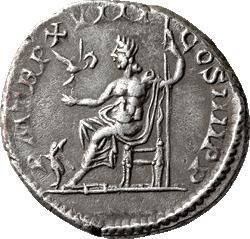
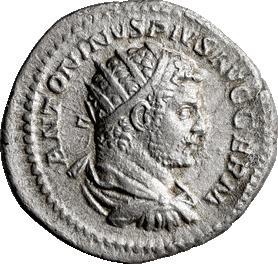


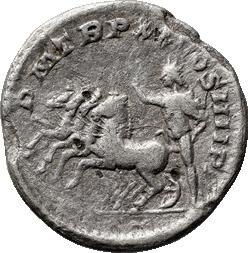
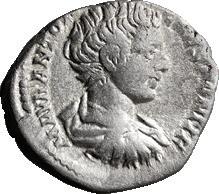
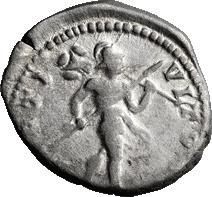
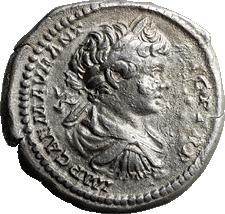
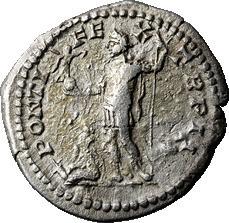
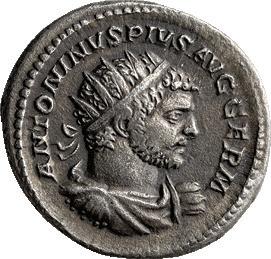

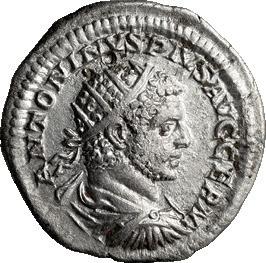
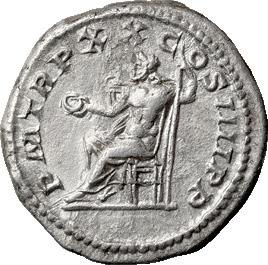
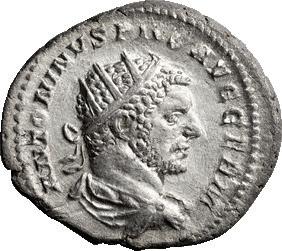
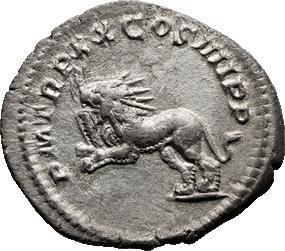

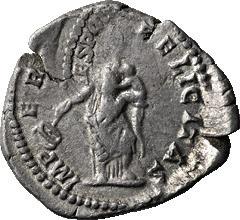
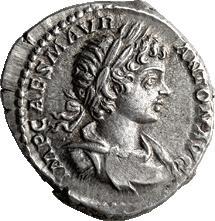
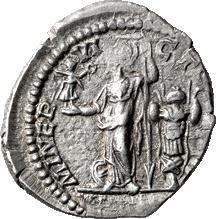

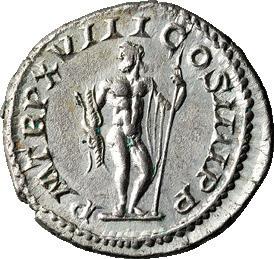

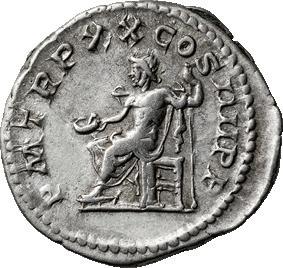


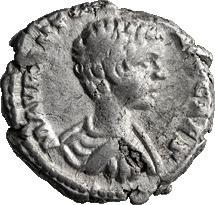
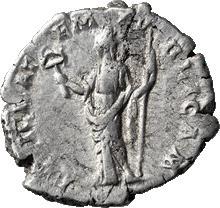
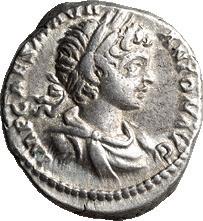
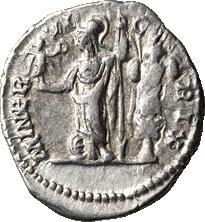
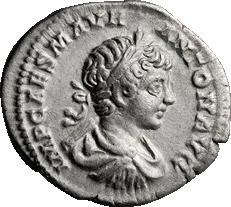
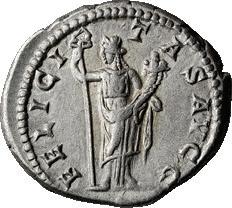
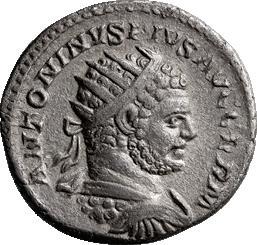
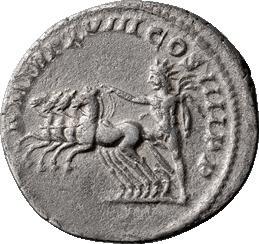
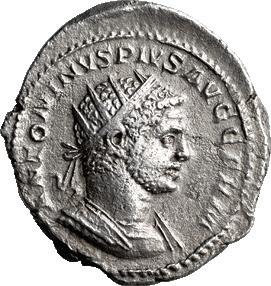

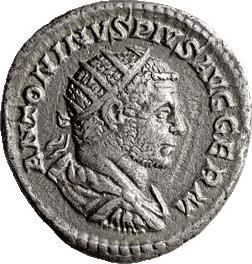
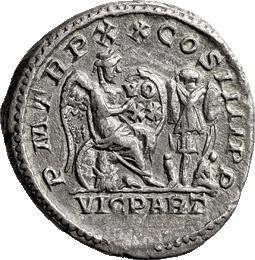
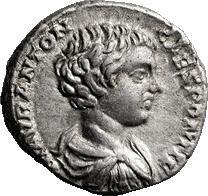



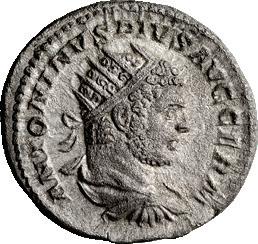
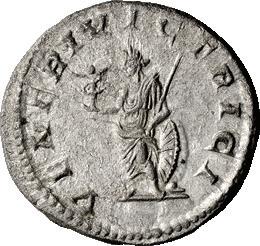
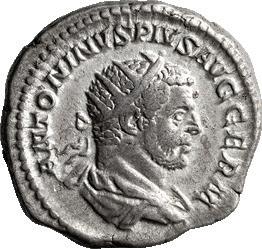

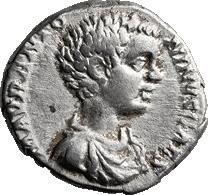
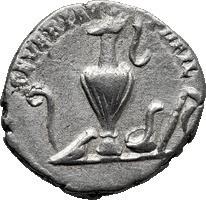


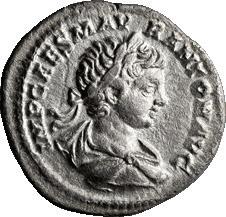


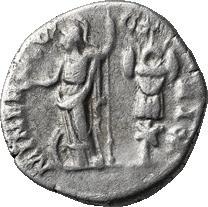
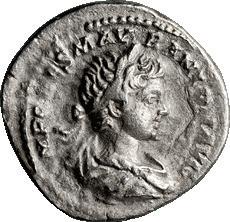
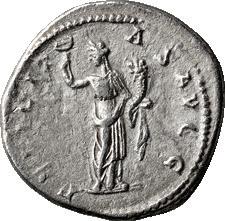
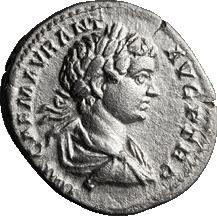
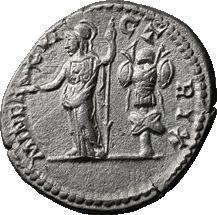
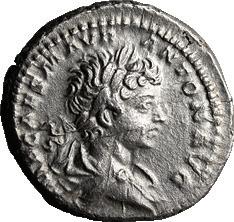
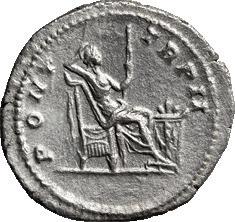
M TR P XX COS IIII P P around, Serapis wearing polos on head, standing r., head l., holding wreath and two wheat ears (?) in r. hand and vertical scepter in l. Ex Curtis L. Clay Collection, acquired from ARC (Ancient Roman Coins), Sept. 2010. EF 275
15. CARACALLA; 198-217 AD, Rome, 217 AD, Antoninianus, 5.83g. Bust var. of BM-187, pl. 72.17. Obv: ANTONINVS PIVS AVG GERM Bust radiate, draped r. Rx: P M TR P XX - COS IIII P P on l. and r., Serapis wearing polos on head, standing r., head l., holding wreath and two wheat ears (?) in r. hand and vertical scepter in l. Ex Curtis L. Clay Collection. aEF 285 Only One Recorded
16. CARACALLA; 198-217 AD, Rome, 217 AD, Antoninianus, 4.80g. Cf. RSC-392a (denarius). Obv: ANTONINVS PIVS AVG GERM Bust radiate, draped r. Rx: P M TR P XX - COS IIII P P on l. and r., Serapis wearing polos on head, standing r., head l., raising r. hand and holding slightly slanting scepter in lowered l. hand. Ex Curtis L. Clay Collection; ex CNG E324, 9 April 2014, lot 419. Apparently a very rare variant with Serapis raising r. hand and holding scepter in lowered l. hand. Virtually MS675 Exquisite Portrait
17. CARACALLA; Rome, 217 AD, Antoninianus, 4.82g. RSC-390c, citing Paris. Obv: ANTONINVS PIVS AVG GERM Bust radiate, draped r. Rx: P M TR P XX COS IIII P P around, Radiate Sol standing r., head l., raising r. hand and holding globe in l. Ex Curtis L. Clay Collection; ex CNG 81, 20 May 2009, lot 1094. Rare with Sol holding globe rather than whip; this variant absent from Reka Devnia hoard. MS 1100 18. CARACALLA; 198-217 AD, Rome, 217 AD, Antoninianus, 3.46g. BM-p. 628, 195A. Obv: ANTONINVS PIVS AVG GERM Bust radiate, draped, cuirassed r. Rx: P M TR P X[X] COS IIII P P around, Radiate Sol mounting quadriga of four horses l., raising r. hand and holding whip in l. Ex Curtis L. Clay Collection; ex Lucernae, eBay, 11 Oct. 2011, lot 354. A rare type with date TR P XX; none in Reka Devnia hoard. Fine 250
Very rare Leaping Lion
19. CARACALLA; 198-217 AD, 217 AD, 2.68g. BMC-196 note, citing G.R. Arnold Coll. Obv: ANTONINVS PIVS AVG GERM, Bust radiate, draped r. Rx: P M TR P XX COS IIII P P around, Radiate lion leaping l., holding thunderbolt in jaws. Ex Curtis L. Clay Collection;; acquired from Pagane, 1 June 2006. A rare reverse type with lion leaping rather than walking. There were no such antoniniani or denarii in the Reka Devnia hoard. This is a magnificent example of a rare and desirable type; Possibly only the second recorded. MS 1200
20. CARACALLA; 198-217 AD, Rome, 217 AD, Antoninianus, 4.90g. BM-184, pl. 72.14 (same dies). Obv: ANTONINVS PIVS AVG GERM Bust radiate, draped, cuirassed r. Rx: P M TR P XX CO[S] IIII P P around, Luna, with crescent on head and fold of drapery in circle around head, standing in biga of bulls prancing l., their back legs bent, whose reins Luna holds in her r. hand. Ex Curtis L. Clay Collection. A rare type dated TR P XX; none in Reka Devnia hoard. EF 600 Very Rare
21. CARACALLA; 198-217 AD, Rome, 217 AD, Antoninianus, 2.78g. BM-199, pl. 73.5; C-648 (Paris, 8 Fr.); RIC-297d. Obv: ANTONINVS PIVS AVG GERM Bust radiate, draped, cuirassed r. Rx: VIC PART in exergue, P M TR P XX COS IIII P P around, Victory seated r. on cuirass and shield, inscribing VO / XX on shield that she balances on her knee, trophy and two seated captives to r. Very rare; only about ten specimens recorded, none in Reka Devnia hoard. Commemorates Caracalla’s successful raid into Parthia and the upcoming twentieth anniversary of his accession in January 218, which he did not live to celebrate. VF 600 Rare Frontal Bust Type
22. CARACALLA AS CAESAR; 195-198 AD, Rome, 195-6 AD, Denarius, 3.15g. BM-186 corr. Obv: M AVR ANTO - NINVS CAES Bare-headed, draped bust r., seen from front. Rx: SEVERI AV[G] - PII FIL on l. and r., Priestly implements: lituus, knife, tall pitcher, ladle, sprinkler. Ex Curtis L. Clay Collection. Bust seen from front is considerably scarcer on this denarius than bust seen from behind. BMC pp. 50-51 fails to point out that only one of the museum’s five specimens of this denarius, no. 186, shows the scarcer “seen from front” portrait. EF 485 Unpublished
23. CARACALLA AS CAESAR; 195-198 AD, Rome, 196 AD, Denarius, 3.44g. Bust type var. of BM-181, pl. 10.1. Obv: M AVR ANTO - NINVS CAE[S] Bareheaded bust draped r., seen from front. Rx: SECVRITAS PE - [R]PETVA on l. and r., Minerva standing l., holding shield balanced on ground and vertical spear with point downward. Ex Curtis L. Clay Collection; ex Dionysos, eBay, 13 Nov. 2014. Apparently unpublished with this “seen from front” bust type, though that same type had already been used on scarce denarii of Caracalla as Caesar earlier in the same year, as shown by the preceding lot in this sale. It is difficult to be certain whether the bust types on these denarii show cuirass flaps on the Caesar’s shoulder, so are draped and cuirassed, or instead omit those cuirass flaps, so are draped only. Toned EF 600
24. CARACALLA AS CAESAR; 195-198 AD, Rome, 197 AD, Denarius, 2.98g. Cf. BM-209, pl. 10.13. Obv: M AVR ANTON CAES PONT[IF] Bare-headed, draped, cuirassed bust r. Rx: [P]RI - NCIPI - IVVE[NTVTIS] on l. and r., Prince standing l. beside trophy, holding baton and scepter. Ex Curtis L. Clay Collection. Unbroken obverse legends as on this denarius seem to be unusual in this Rome-mint issue of aurei and denarii of Caracalla as Caesar and Pontifex: cf. BMC pp. 52-54 and pl. 10. VF 75
25. CARACALLA AS CAESAR; 195-198 AD, Rome, 197 AD, Denarius, 3.38g. RSC-154a, citing ANS. Obv: M AVR ANTON CAES PONTIF Bare-headed, draped, cuirassed bust r. Rx: [MA]RTI VLT[ORI] Mars advancing r. holding spear and trophy over shoulder. Ex Curtis L. Clay Collection; ex Ancient Auction House, eBay, 9 Feb. 2003. Seems to be a scarce bust variant, draped and cuirassed rather than just draped. aEF 75
26. CARACALLA AS CAESAR; 195-198 AD, Rome, 197 AD, Denarius, 2.40g. Cf. BM-201, pl. 10.9. Obv: [M A]VR ANTON - CAE[S] PON[TIF] Bare-headed, draped bust r. Rx: IMP - ER[II] FELICITAS on l. and r., Felicitas standing l., holding short caduceus and child. Before Felicitas’ face, part of overstruck obverse legend, [CA] ES PON[TIF]. Ex Curtis L. Clay Collection; ex Lanz, eBay, 4 Nov. 2009. Apparently a flip strike, with parts of the obverse legend appearing on both the obverse and the reverse. aEF 200
27. CARACALLA AS CAESAR; 195-198 AD, Rome, 197 AD, Denarius, 2.93g. Cf. BM-180A note, citing P.V. Hill Coll.; C-73 (30 Fr.); RIC-1. Obv: M AVR ANT[ONINVS] CAES Bare-headed, draped, cuirassed bust r. Rx: FELICITAT - EM - PV - BLICAM Felicitas standing l., holding short caduceus and scepter. Ex Curtis L. Clay Collection; acquired from Lanz, eBay. Scarce: only five specimens in Reka Devnia hoard. A reverse legend in the accusative case (rather than nominative or dative) is unusual on Roman imperial coins. VF 150
28. CARACALLA AS CAESAR; 195-198 AD, Rome, 197 AD, Denarius, 3.61g. BM197, pl. 10.8 (same rev, die); C-74 (30 Fr.). Obv: M AVR ANTON - CAES PONTIF Bare-headed, draped, cuirassed bust r. Rx: FELICITAT - EM - [P]V - BLICAM Felicitas standing l., holding short caduceus and scepter. Ex Curtis L. Clay Collection; ex Helios, eBay, 18 Nov. 2012. Scarce: only eight specimens in Reka Devnia hoard. A reverse legend in the accusative case (rather than nominative or dative) is unusual on Roman imperial coins. EF 240
29. CARACALLA; 198-217 AD, Rome, 198 AD, Denarius, 3.09g. BM-107 note, C-159, RIC-25b. Obv: [I]MP CAE M AVR - ANT AVG P TR P Bust laureate, draped, cuirassed r. Rx: MI[N] - ER - VI[CT] - RIX Minerva standing l. holding Victory and reversed spear, shield at feet, trophy behind. Ex Curtis L. Clay Collection; ex Dionysos, eBay, 28 May 2014. This denarius seems scarce with cuirass flaps on the emperor’s shoulder (draped and cuirassed). EF / VF 225
30. CARACALLA; 198-217 AD, Rome, 198 AD, Denarius, 3.17g. BM-107 note, C-159, RIC-25a. Obv: IMP CAE M AVR - ANT AVG P TR P Bust laureate, draped, cuirassed r. Rx: MINER - VI - CT - RIX Minerva standing l. holding Victory and reversed spear, shield at feet, trophy behind. Ex Curtis L. Clay Collection; ex Savoca, London, Blue E5, 11 Aug. 2019, lot 779. This denarius seems scarce with cuirass flaps on the emperor’s bust (draped and cuirassed). EF / VF 140
31. CARACALLA; 198-217 AD, Rome, 198 AD, Denarius, 3.07g. Cf. BM-107, C-159, and RIC-25b. Obv: IMP CAE M AVR ANT - AVG P TR P Bust laureate, draped, cuirassed (?) r. Rx: MINER - VI - CT - RIX Minerva standing l. holding Victory and reversed spear, usual shield at feet omitted, trophy behind. Ex Curtis L. Clay Collection; ex Gitbud-Naumann, eBay, 24 Sept. 2015. Rare variant omitting the usual shield at Minerva’s feet, probably just by engraver’s error. Virtually MS 185
32. CARACALLA; 198-217 AD, Rome, obv. of 198 AD (TR P), rev. of 199 AD (TR P II, mule), Denarius, 3.07g. BM-p. 184 (in BM, Tinchant Gift, 1935). Obv: IMP CAE M AVR - ANT AVG P TR P Bust laureate, draped r. Rx: PONTI - FE - X - TR P II around, Caracalla standing l., holding Victory on globe and reversed spear; at his feet, captive seated l., wearing peaked cap and supporting head with hand. Ex Curtis L. Clay Collection; ex Gitbud-Naumann, eBay, 5 Nov. 2015. A rare mule, in standard mint style, combining an obverse die of 198 AD (TR P) with a reverse die of 199 AD (TR P II). High points flatly struck. EF
275
33. CARACALLA; 198-217 AD, Rome, obv. 198 AD, rev. 199 AD (mule), Denarius, 3.18g. BM-p. 184 (in BM, Tinchant Gift, 1935). Obv: IMP CAE M AVR ANT - AVG P TR P Bust laureate, draped, cuirassed r. Rx: PONTI - FE - X - TR P II around, Caracalla standing l., holding Victory on globe and reversed spear; at his feet, captive seated l., wearing peaked cap and supporting head with hand. Ex Curtis L. Clay Collection; ex Gitbud-Naumann, eBay, 5 Nov. 2015. A rare mule, in standard mint style, combining an obverse die of 198 AD (TR P) with a reverse die of 199 AD (TR P II). Reverse flatly struck. EF
275
34. CARACALLA; 198-217 AD, Rome, 199 AD, Denarius, 3.31g. Bust var. of BM-117, pl. 29.13. Obv: IMP CAES M AVR - ANTON AVG Bust laureate, draped, cuirassed r., seen from front. Rx: MINER - VI - CT - [RIX] Minerva standing l. holding Victory and reversed spear, shield at feet, trophy behind. Ex Curtis L. Clay Collection; ex Savoca, Blue E10, 30 Sept. 2018, lot 1464. With rare seen from front bust type. From the same obverse die as the next coin in this sale Bust flatly struck. Toned EF 350
35. CARACALLA; 198-217 AD, Rome, 199 AD, Denarius, 3.54g. Bust variety of BM-117, pl. 29.13. Obv: IMP CAES M AVR - ANTON AVG Bust laureate, draped, cuirassed r., seen from front. Rx: MINER - VI - CT - RIX Minerva standing l. holding Victory and reversed spear, shield at feet, trophy behind. Ex Curtis L. Clay Collection. With rare seen from front bust type. From the same obverse die as the preceding coin in this sale. VF 250
Unpublished Variety
36. CARACALLA; 198-217 AD, Rome, 199 AD, Denarius, 3.35g. BMC-p. 173, *; C-63 (Asselin); RIC-18. Obv: IMP CAES M AVR - ANTON AVG Bust laureate, draped, cuirassed r. Rx: FELICI - TAS AVGG Felicitas standing r., head l., holding long caduceus and cornucopia. Ex Curtis L. Clay Collection; ex Ancient Auction House, eBay, 12 Sept. 2004. A rare type with this obverse legend: not represented in Reka Devnia hoard, not in BM by 1975 or in Paris by Cohen’s day, quoted by Cohen from a French private collection. The present specimen may also be an unpublished variety because of its draped and cuirassed bust type, rather than just draped. EF300 Possibly Unpublished
37. CARACALLA; 198-217 AD, Rome, 199 AD, Denarius, 3.37g. BMC-p. 173, *; C-63 (Asselin); RIC-18. Obv: IMP CAES M AVR - ANTON AVG Bust laureate, draped r. Rx: FELICI - TAS AVGG Felicitas standing r., head l., holding long caduceus and cornucopia. Ex Curtis L. Clay Collection; from a G. Hirsch auction, Dec. 1998ex Ancient Auction House, eBay, 12 Sept. 2004. A rare type with this obverse legend: not represented in Reka Devnia hoard, not in BM by 1975 or in Paris by Cohen’s day, cited by Cohen from a French private collection. Magnificent portrait. Virtually MS 850
38. CARACALLA; 198-217 AD, Rome, 199 AD, Denarius, 3.00g. BMC-p. 173, *; C-63 (Asselin); RIC-18. Obv: IMP CAES M AV - R ANTON AVG Bust laureate, draped r. Rx: FELICI - TAS AVGG Felicitas standing r., head l., holding long caduceus and cornucopia. Ex Curtis L. Clay Collection; ex Ancient Auction House, eBay, 6 Feb. 2005. A rare type with this obverse legend: not represented in Reka Devnia hoard, not in BM by 1975 or in Paris by Cohen’s day, cited by Cohen from a French private collection. From the same dies as the next coin in this sale. MS 500
39. CARACALLA; 198-217 AD, Rome, 199 AD, Denarius, 2.96g. BMC-p. 173, *; C-63 (Asselin); RIC-18. Obv: [I]MP [CAE]S M AV - R ANTON AVG Bust laureate, draped r. Rx: FEL[ICIT] - AS AVGG Felicitas standing r., head l., holding long caduceus and cornucopia. Ex Curtis L. Clay Collection; acquired from Harlan Berk, Jan. 2015. A
rare type with this obverse legend: not represented in Reka Devnia hoard, not in BM by 1975 or in Paris by Cohen’s day, cited by Cohen from a French private collection. From the same dies as the preceding coin in this sale. Planchet irregularities. gVF 200
40. CARACALLA; 198-217 AD, Rome, 199 AD, Denarius, 3.05g. BMC-p. 183, * corr., citing Ball VI, 1932, lot 1874 (same obv. die). Obv: IMP CAES M AVR - ANTON AVG Bust laureate, draped r. Rx: PONT - TR P II on l. and r., Securitas seated r., supporting head with r. hand and holding scepter in l. hand; at her feet, altar. Ex Curtis L. Clay Collection; acquired from Ancient Auction House, eBay, 17 Aug. 2009. A rare variant; none with this obverse legend in Reka Devnia hoard. Microscopic porosity. Virtually MS 200
41. CARACALLA; 198-217 AD, Rome, 199 AD, Denarius, 3.73g. BMC-p. 174, citing R.It. 1908, p. 394. Obv: IMP CAES M AVR - ANTON AVG Bust laureate, draped r. Rx: SPES PV - BLICA on l. and r., Spes advancing l., holding flower and raising skirt. Ex Curtis L. Clay Collection. Scarce with this obverse legend; only three specimens in Reka Devnia hoard. Our example is definitely of Rome-mint style and fabric, so disproves Carson and Hill’s suggestion, in their second edition (1975) of BMC V, p. 174, * note, that this denarius was probably struck only at the eastern new-style mint, and not at Rome. EF 275
42. CARACALLA; 198-217 AD, Rome, 199 AD, Denarius, 3.32g. BMC-p. 284, * (citing Atti et Memoria, 1925, p. 66; misattributed to the New-Style mint, rather than Rome). Obv: IMP CAES M AVR - ANTON AVG Bust laureate, draped r. Rs: FIDES P - VBLICA on l. and r., Fides standing r., holding two wheat ears and plate of fruit. Apparently a rare type combination, not represented in the Reka Devnia hoard. EF 200
43. CARACALLA; 198-217 AD, Rome, 199 AD, Denarius, 3.31g. BMC-p. 284, (citing Atti et Memoria, 1925, p. 66, misattributed to the New-Style mint, rather than Rome). Obv: IMP CAES M AVR - ANTON AVG Bust laureate, draped r. Rs: [F]IDES PV - BLICA on l. and r., Fides standing r., holding two wheat ears and plate of fruit. Ex Curtis L. Clay Collection; acquired from Carl Subak, Chicago, March 1996. Apparently a rare type combination, not represented in the Reka Devnia hoard. New denarius obverse legend. aEF 200
44. CARACALLA; 198-217 AD, Rome, 198-9 AD, Denarius, 2.58g. Obv: M AVR ANTO - NINVS AVG Bust laureate, draped r. Rs: FIDES - P -VBLICA on l. and r., Fides standing r., holding two wheat ears and plate of fruit. Ex Curtis L. Clay Collection; acquired from Lanz, eBay, 28 Jan. 2010. Apparently a new obverse legend variety for this reverse type on Rome-mint denarii of Caracalla in 198 or 199 AD. We might have expected the legend IMP CAES M AVR ANTON AVG instead, as on the two preceding lots of this sale. A close variant of the new denarius obverse legend, namely M AVRELIVS ANTON AVG, also occurs on a dynastic aureus of Caracalla as young Augustus and Geta as Caesar: see BM-121, pl. 29.16. Virtually MS 525
45. CARACALLA; 198-217 AD, Rome, 199 AD, Denarius, 3.59g. Bust var. of BMC161. Obv: ANTONINVS - AVGVSTVS Bust laureate, draped, cuirassed r. Rx: FELICI - TAS AVGG on l. and r., Felicitas standing r., head l., holding long caduceus and cornucopia. Ex Curtis L. Clay Collection; ex Lanz, eBay, 24 July 2012. Scarce draped and cuirassed bust type. EF 135
46. CARACALLA; 198-217 AD, Rome, c. 200 AD, Denarius, 3.14g. BMC-174 note, citing C-614. Obv: ANTONINVS - AVGVSTVS Bust laureate, draped r. Rx: VIC - T AE - TE - RN around, Victory flying l., holding garland with both hands over shield set on base. Ex Curtis L. Clay Collection; ex Dionysos, eBay, 14 Sept. 2014. Seems scarce with bust draped only, not draped and cuirassed. Slight porosity. Virtually MS 250
47. CARACALLA; 198-217 AD, possibly from a branch mint, after c. 200 AD, Denarius, 3.31g. Obv: ANTONINVS - AVGVSTVS Bust laureate, draped, cuirassed r. Rx: FVNDAT[OR] - PACIS on l. and r., Septimius Severus standing togate l., holding branch. Ex Curtis L. Clay Collection; acquired from Dionysos, eBay, 10 March 2020. In competent style and decent metal, but a little cruder than Rome, and on this coin mistakenly combining an obverse of Caracalla with a reverse of Septimius Severus. Possibly from a branch mint, copying Roman types in order to meet a financial need in a Roman province, but without having to transport the coins from Rome? . VF325 Imperial Galley
48. CARACALLA; 198-217 AD, Branch Mint, After c. 202 AD, Denarius, 3.51g. Cf. BM-267, pl. 33.14. Obv: ANTONINVS - AVGVSTVS Bust laureate, draped r. Rx: ADVENT AVG - G, Imperial galley proceeding l. through waves; at stern of galley, the three emperors seated l. under an arch, an officer on deck facing the emperors, and two standards above and behind the emperors; at prow of ship, a small sail on a slanted mast. Ex Curtis L. Clay Collection; purchased from Barry Murphy, Nov. 2010. In competent style and decent metal, but perhaps a little cruder and baser than the standard Rome-mint coin, and also showing a hybrid legend combination, since the correct obverse legend for Caracalla’s ADVENT AVGG reverse type would have been ANTONINVS PIVS AVG rather than ANTONINVS AVGVSTVS. Possibly from a branch mint, copying Roman types in order to meet a financial need in a Roman province, without having to transport the coins from Rome? . EF 875
49. CARACALLA; 198-217 AD, Rome, 200 AD, Denarius, 3.42g. Cf. BM-179, C-413, and RIC-30. Obv: ANTONINVS - AVGVSTVS Bust laureate, draped r, seen from front. Rx: PONTIF - TR P III on l. and r., Caracalla standing r., head l., laureate, nude but for cloak over l. shoulder, holding globe and reversed spear. Ex Curtis L. Clay Collection; ex Rauch E15, 16 June 2024, lot 244. Rare bust variety, seen from front rather than from back. From the same obverse die as the next coin in this sale . MS 450
50. CARACALLA; 198-217 AD, Rome, 200 AD, Denarius, 3.46g. Cf. BM-179, C-413, and RIC-30a. Obv: ANTONINVS - AVGVSTVS Bust laureate, draped r., seen from front. Rx: PONTIF - TR P III on l. and r., Caracalla standing r., head l., laureate, nude but for cloak over l. shoulder, holding globe and reversed spear. Ex Curtis L. Clay Collection; ex Lanz, eBay, 22 Dec. 2017. Rare bust variety, seen from front rather than from back. From the same obverse die as the next coin in this sale. VF 300
51. CARACALLA; 198-217 AD, Rome, early 201 AD, Denarius, 3.85g. Cf. BM-179, C-413, and RIC-30a. Obv: ANTONINVS - AVGVSTVS Bust laureate, draped, cuirassed r., seen from front. Rx: PONTIF - TR P III on l. and r., Caracalla standing r., head l., laureate, nude but for cloak over l. shoulder, holding globe and reversed spear.
Ex Curtis L. Clay Collection. Rare bust variety, seen from front rather than from back. EF 325
52. CARACALLA; 198-217 AD, Rome, late 200-early 201 AD, Denarius, 3.56g. Bust var. of BM-264A, pl. 33.11. Obv: ANTONINVS - AVGVSTVS Bust laureate, draped, cuirassed r. Rx: PON - TIF - TR P IIII on l. and r., Caracalla standing r., head l., laureate, nude but for cloak over l. shoulder, holding globe and reversed spear. Ex Curtis L. Clay Collection. This denarius is common with date TR P III but rare with TR P IIII, as indicated by Reka Devnia counts of 157 and only two specimens respectively. Apparently the type was discontinued soon after Caracalla became TR P IIII on 10 December 2000. Virtually MS 225
53. CARACALLA; 198-217 AD, Rome, 201 AD, Denarius, 3.35g. Bust var. of BM264. Obv: ANTONINVS - PIVS AVG Bust laureate, draped, cuirassed r., seen from front. Rx: PART MAX - PONT - TR P IIII around, Trophy between two seated captives. Ex Curtis L. Clay Collection; purchased from Barry Murphy, Nov. 2002; ex B.P. Murphy Online Severan Silver Collection, no. 359. Rare with the emperor’s bust seen from front rather than from back. EF 300 High Relief Portrait
54. CARACALLA; 198-217 AD, Rome, 201 AD, Denarius, 3.40g. Busr var. of BM264. Obv: ANTONINVS - PIVS AVG Bust laureate, draped, cuirassed r., seen from front. Rx: PART MAX PONT TR P IIII around, Trophy between two seated captives. Ex Curtis L. Clay Collection; ex CNG E141, 7 June 2006, part lot 300. Rare with the emperor’s bust seen from front rather than from back. Reverse softly struck. Virtually MS 350
55. CARACALLA; 198-217 AD, Rome, 201 AD, Denarius, 1.93g. Bust var. of BM264. Obv: ANTONINVS - PIVS AVG Bust laureate, draped, cuirassed r., seen from front. Rx: PART MAX PONT TR P IIII around, Trophy between two seated captives. Ex Curtis L. Clay Collection; acquired from Slavey, eBay, 25 Nov. 2010. Rare with the emperor’s bust seen from front rather than from back. Toned aEF 200
56. CARACALLA; 198-217 AD, Rome, 201 AD, Denarius, 3.11g. Cf. BM-262. Obv: ANTONINVS - PIVS AVG Bust laureate, draped, cuirassed r. (or just draped). Rx: PART MA[X PONT] TR P IIII, Trophy between two seated captives, at top weakly struck second groundline, probably all that remains from the first strike of a “Kraay overstrike” from alternating reverse dies. Ex Curtis L. Clay Collection; purchased from Harlan Berk, Aug. 1996. Virtually MS 250 High Relief Portrait
57. CARACALLA; 198-217 AD, Rome, 201 AD, Denarius, 3.33g. BMC-p. 385, 161. Obv: ANTONINVS - PIVS AVG Bust laureate, draped, cuirassed r. (or just draped). Rx: PART MAX P - M - TR P VIIII around, Trophy between two seated captives. Ex Curtis L. Clay Collection; acquired from PBJI Ancient Coins, August 2007. A rare mule: the reverse legend with P M and TR P VIIII was meant for obverses of Septimius not Caracalla. MS 600 Unpublished
58. CARACALLA, FROM MISDATED REVERSE DIE; 198-217 AD, Rome, 201 AD, Denarius, 3.44g. Cf. BMC-p. 385, 161. Obv: ANTONINVS - PIVS AVG Bust laureate, draped, cuirassed r. (or just draped). Rx: PART MAX PO - NT TR P VIIII around, Trophy between two seated captives. Ex Curtis L. Clay Collection; acquired from Herb Kreindler. Struck from a misdated reverse die, apparently unpublished: since PONT was a title of Caracalla not Septimius, the cited tribunician number should also have been of Caracalla, that is TR P IIII not TR P VIIII. Toned MS 685
59. CARACALLA; 198-217 AD, Rome, 202 AD, Denarius, 3.12g. BM-p. 385, 163, pl. 64.13 (same rev. die). Obv: ANTONINVS - PIVS AVG Bust laureate, draped, cuirassed r. (or just draped). Rx: PART MAX P - M - TR P X around, Trophy between two seated captives. Ex Curtis L. Clay Collection; ex Ancient Auction House, eBay, 9 Jan. 2007. A rare mule: the reverse legend with P M and TR P X was meant for obverses of Septimius not Caracalla. From the same reverse die as the following lot in this sale. EF 400
60. CARACALLA; 198-217 AD, Rome, 202 AD, Denarius, 2.55g. BM-p. 385, 163, pl. 64.13 (same rev. die). Obv: ANTONINVS - PIVS AVG Bust laureate, draped, cuirassed r. (or just draped). Rx: PART MAX P - M - TR P X around, Trophy between two seated captives. Ex Curtis L. Clay Collection; ex Triskeles E9, 24 Oct. 2023, part lot 151. A rare mule: this reverse legend with P M and TR P X was meant for obverses of Septimius not Caracalla. From the same reverse die as the preceding lot in this sale. Toned MS 350
61. CARACALLA; 198-217 AD, Rome, 203 AD, Denarius, 3.17g. BM-284, pl. 34.5. Obv: ANTONINVS - PIVS AVG Bust laureate, draped, cuirassed r. Rx: IIII LIBERA - LITAS AVGG around, Liberalitas standing l., holding coin counter and cornucopia. Choice EF 150
62. CARACALLA; 198-217 AD, Rome, 203 AD, Denarius, 3.31g. BM-284, pl. 34.5. Obv: ANTONINVS - PIVS AVG Bust laureate, draped, cuirassed r. Rx: IIII LIBE - RA - LITAS AVGG around, Liberalitas standing l., holding coin counter and cornucopia. Ex Curtis L. Clay Collection; ex Ancient Auction House, eBay, 30 Aug. 2004. Virtually MS 150
63. CARACALLA; 198-217 AD, Rome, 203 AD, Denarius, 3.32g. BM-435-6 corr. Obv: ANTONINVS - PIVS AVG Bust laureate, draped, cuirassed r. Rx: PONT TR P - VI COS on l. and r., Virtus standing l., holding Victory and reversed spear. Ex Curtis L. Clay Collection; ex Dionysos, eBay, 15 Nov. 2017. aEF 125
64. CARACALLA; 198-217 AD, Rome, 203 AD, Denarius, 3.40g. BM-435-6 corr. Obv: ANTONINVS - PIVS AVG Bust laureate, draped, cuirassed r. Rx: VIRTVSAVGG on l. and r., Virtus standing l., holding Victory and reversed spear. Ex Curtis L. Clay Collection; ex Lanz, eBay, 12 Sept. 2008. EF 200
65. CARACALLA; 198-217 AD, Rome, 203 AD, Denarius, 3.16g. BM-435-6 corr. Obv: ANTONINVS - PIVS AVG Bust laureate, draped, cuirassed r. Rx: VIRTVSAVGG on l. and r., Virtus standing l., holding Victory and reversed spear. Ex Curtis L. Clay Collection; ex Lanz, eBay, 12 Sept. 2008. EF 100
66. CARACALLA; 198-217 AD, Rome, 204 AD, Denarius, 3.23g. Bust var. of BM280, pl. 34.3. Obv: ANTONINVS - PIVS AVG Bust laureate, draped, cuirassed r. Rx: IN[D]VLGEN - TIA AVG - G around, [I]N CARTH in exergue, Dea Caelestis, head r. and holding thunderbolt and scepter, riding r. on lion above water flowing from rocks. Ex Curtis L. Clay Collection; ex Gitbud-Naumann, eBay, 29 June 2012. Scarce

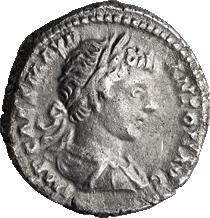


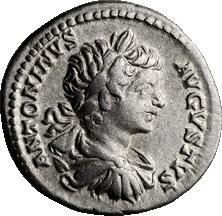
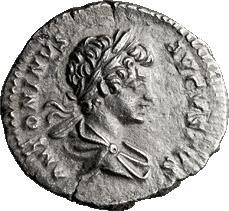


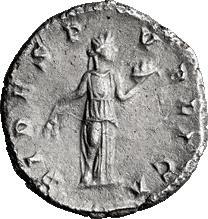

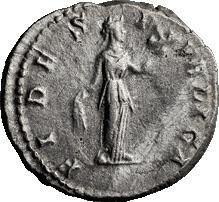
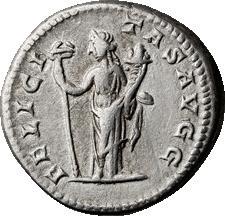
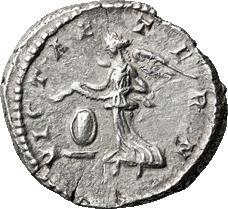
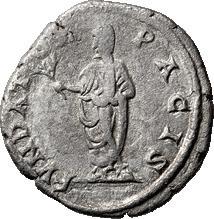
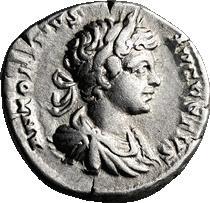
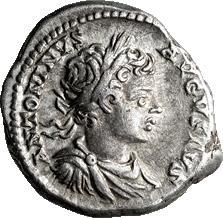
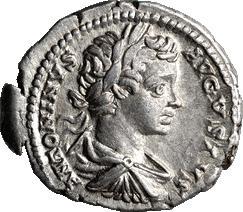



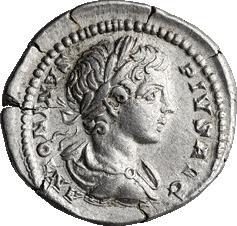
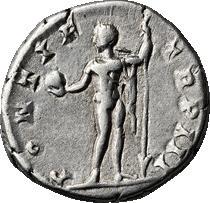
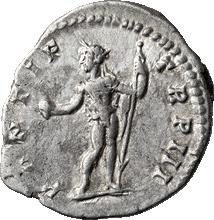

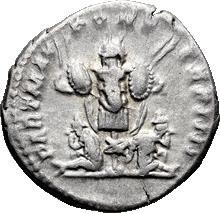
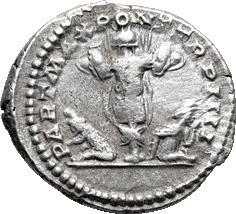
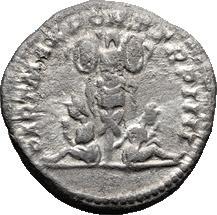
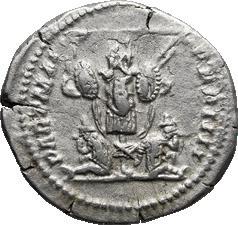


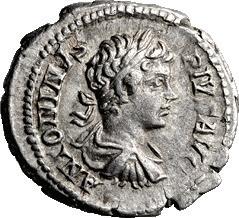
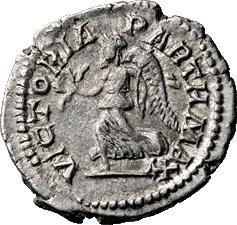



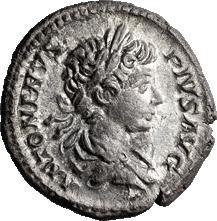

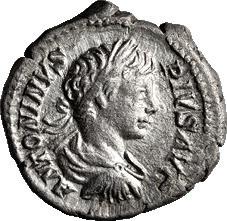
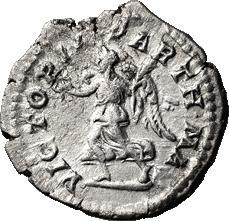
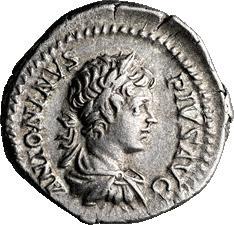

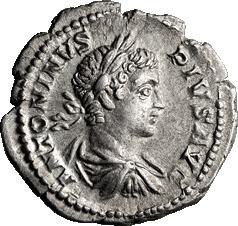



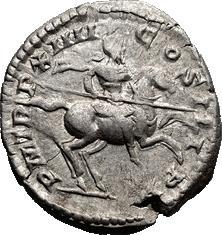


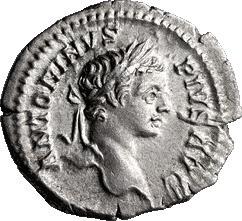

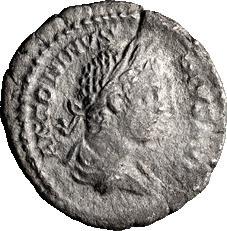
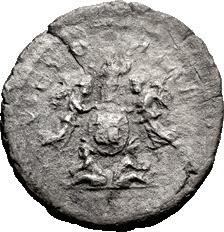
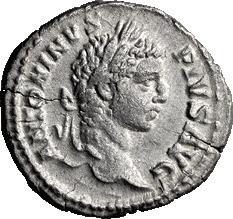
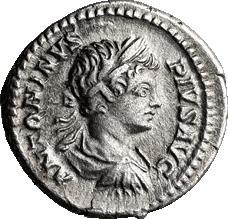
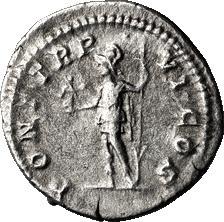
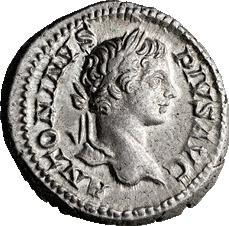
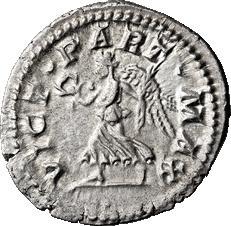

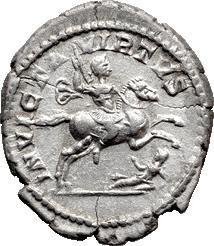

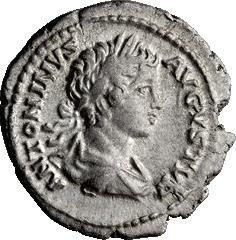
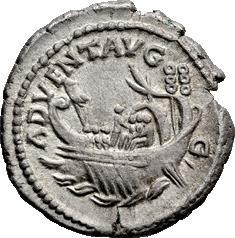



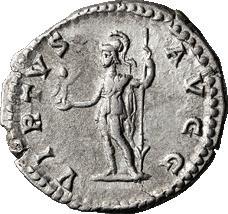

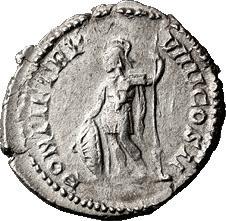


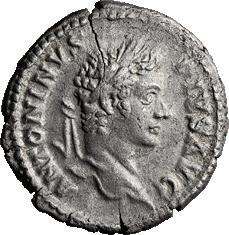
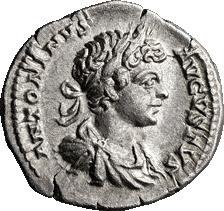

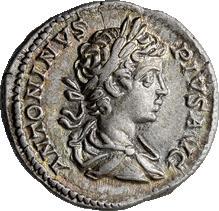
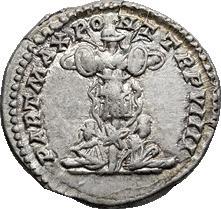

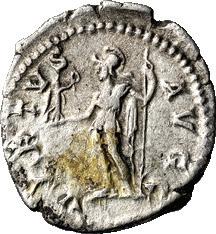


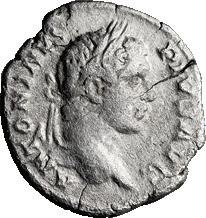
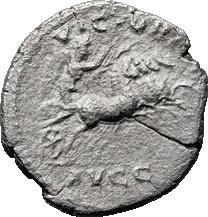


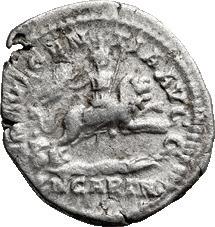
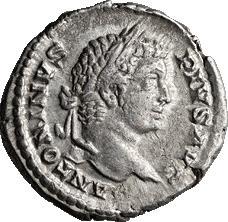

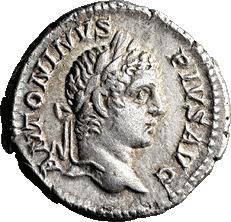
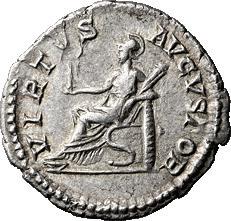
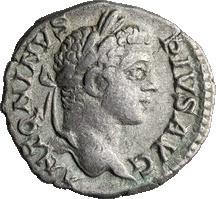

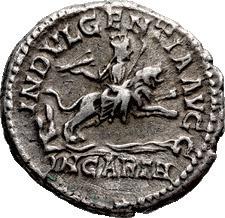


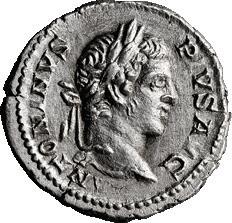
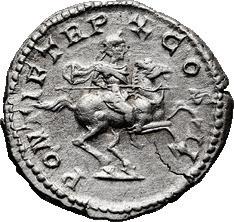
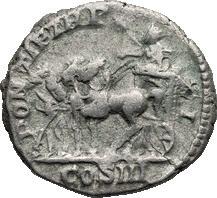
draped and cuirassed bust type. Reverse flatly struck. EF 175 67. CARACALLA; 198-217 AD, Rome, 204 AD, Denarius, 3.13g. Cf. BM-280, pl. 34.3. Obv: ANTONINVS - PIVS AVG Head r. Rx: INDVLGENTIA AVGG around, IN CARTH in exergue, Dea Caelestis, head r. and holding thunderbolt and scepter, riding r. on lion above water flowing from rocks. Ex Curtis L. Clay Collection; acquired from Ignasi Serrahima, March 2021. Earlier ex Freeman & Sear, MBS 17, 15 Dec. 2009, lot 467 (A. Lynn Coll.) and CNG 47, 16 Sept. 1998, lot 1809. This head laureate bust type of Caracalla was used only briefly on his denarii in 204 AD, with the reverse types INDVLGENTIA AVGG IN CARTH and VICT PART MAX, before becoming his standard bust type on denarii from late 206 AD on. Toned EF 375
68. CARACALLA; 198-217 AD, Rome, 204 AD, Denarius, 3.51g. Bust var. of BM298, pl. 34.11. Obv: ANTONINVS - PIVS AVG Bust laureate, draped, cuirassed r. Rx: VICTORIA - PARTH MAX Victory advancing l., holding wreath and palm. Ex Curtis L. Clay Collection; acquired from Carl Subak, Chicago, Nov. 1995. Scarce with reverse legend beginning with VICTORIA rather than just VICT, only six specimens in Reka Devnia hoard; rare with bust draped and cuirassed rather than just draped. EF 250
Rare Bust Variety
69. CARACALLA; 198-217 AD, Rome, 204 AD, Denarius, 3.31g. Cf. BM-298, pl. 34.11. Obv: ANTONINVS - PIVS AVG Bust laureate, draped, cuirassed r. Rx: VICTORI[A] PARTH MA[X] around, Victory advancing l., holding wreath and palm. Ex Curtis L. Clay Collection; ex Grotjohann, eBay, 15 Oct. 2009. Scarce with reverse legend beginning with VICTORIA rather than just VICT; only six such specimens in Reka Devnia hoard. Moreover rare with bust draped and cuirassed rather than just draped. EF 200
70. CARACALLA; 198-217 AD, Rome, 204 AD, Denarius, 3.74g. BMC-296 note. Obv: ANTONINVS - PIVS AVG Bust laureate, draped, cuirassed r. Rx: VICT - PART MAX around, Victory advancing l., holding wreath and palm. Ex Curtis L. Clay Collection; ex CNG E322, 12 March 2014, part lot 322. Scarce with bust draped and cuirassed rather than just draped. MS 275
Very Rare Bust Variety
71. CARACALLA; 198-217 AD, Rome, 204 AD, Denarius, 3.37g. BMC-p. 261, f (citing Reka Devnia, p. 116, 1 spec.). Obv: ANTONINVS - PIVS AVG Head laureate, r. Rx: VICT - PART - MAX around, Victory advancing l., holding wreath and palm. Ex Curtis L. Clay Collection; ex Dionysos, eBay, 13 Nov. 2011. This lot, like lot 67 above and lot 72 below, employs a very rare Head Laureate only bust type, that appeared briefly on Caracalla’s denarii in 204 AD with the reverse types VICT PART MAX and INDVLGENTIA AVGG IN CARTH, at a time when his standard obverse types on denarii were either bust laureate, draped or bust laureate, draped and cuirassed. MS 550
Same Rare Bust Variety as Previous Lot
72. CARACALLA; 198-217 AD, Rome, 204 AD, Denarius, 3.52g. BMC-p. 261, f (citing Reka Devnia, p. 116, 1 spec.). Obv: ANTONINVS - PIVS AVG Head laureate r. Rx: VICT - PART - MAX around, Victory advancing l., holding wreath and palm. Ex Curtis L. Clay Collection; ex Dionysos, eBay, 13 Nov. 2011. This lot, like lot 67 above and lot 71 below, employs a very rare Head Laureate only bust type, that appeared briefly on Caracalla’s denarii in 204 AD with the reverse types VICT PART MAX and INDVLGENTIA AVGG IN CARTH, at a time when his standard obverse types on denarii were either laureate, draped or laureate, draped and cuirassed. MS 500
73. CARACALLA; 198-217 AD, Rome, 206 AD, Denarius, 3.22g. Bust var. of BM497, pl. 40.11. Obv: ANTONINVS - PIVS AVG Bust laureate, draped, cuirassed r. Rx: PONTIF TR P - VIIII COS II on l. and r., Mars standing l., placing r. hand on shield and holding reversed spear. Ex Curtis L. Clay Collection; ex Lanz, eBay, 1 June 2012. Rare with bust cuirassed as well as draped. EF / VF 160
74. CARACALLA; 198-217 AD, Rome, c. 206 AD, Denarius, 3.39g. BMC-302 note = 526A corr. Obv: ANTONINVS - PIVS AVG Bust laureate, draped r. Rx: VOTA SVSCEPTA XX on l. and r., Togate, veiled emperor standing l., holding patera over tripod altar in r. hand and roll in l. Ex Curtis L. Clay Collection; ex Grotjohann, eBay, 2 Feb. 2010. A rare mule, with reverse type of Septimius not Caracalla; none in Reka Devnia hoard. Fine 275
75. CARACALLA; 198-217 AD, Rome, c. 206 AD, Denarius, 3.22g. Cf. BMC-302 note = 526A corr. Obv: ANTONINVS - PIVS AVG Head laureate r. Rx: VOTA SVSCEPTA XX on l. and r., Togate, veiled emperor standing l., holding patera over tripod altar in r. hand and roll in l. Ex Curtis L. Clay Collection. A rare mule, with reverse type of Septimius not Caracalla; none in Reka Devnia hoard. VF 250
76. CARACALLA; 198-217 AD, Rome, c. 206 AD, Denarius, 3.47g. Cf. BMC-302 note = 526A corr. Obv: ANTONINVS - PIVS AVG Head laureate r. Rx: VOTA SVS - CEPTA XX on l. and r., Togate, veiled emperor standing l., holding patera over tripod altar in r. hand and roll in l. Ex Curtis L. Clay Collection; ex Lanz, eBay, 1 Feb. 2015. A rare mule, with reverse type of Septimius not Caracalla; none in Reka Devnia hoard. VF 300
77. CARACALLA; 198-217 AD, Rome, c. 206 AD, Denarius, 4.25g. BM 524, pl. 41.8. Obv: ANTONINVS - PIVS AVG Head laureate r. Rx: VOTA SVS - CEPTA X on l. and r., Togate, veiled emperor standing l., holding patera over tripod altar in r. hand and roll in l. Ex Curtis L. Clay Collection; acquired from Harlan Berk, Oct. 1996. Overweight specimen. EF 200 Extremely Rare Reverse
78. CARACALLA; 198-217 AD, Rome, c. 206 AD, Denarius, 4.13g. C-626; BMC-p. 261, g; RIC-171. Obv: ANTONINVS - PIVS AVG Head laureate r., unbearded. Rx: VICTORIAE AVGVST Victory, naked to waist, seated r. on low seat, placing l. hand atop shield resting on column before her and holding parazonium at her side in r. hand; below seat, cuirass lying sideways on ground. Ex Curtis L. Clay Collection; ex CNG 85, 15 Sept. 2010, lot 947. An exceptional type, known so far only for Caracalla (though perhaps a pendant for Septimius should be expected), and only on denarii, not on aurei or bronze coins too. The abbreviation AVGVST rather than AVGG or AVGVSTORVM in the reverse legend is unusual; likewise the tipped-over cuirass and the fact that Victory holds a parazonium rather than a writing utensil to inscribe her shield. Cohen-626 originally reported a specimen of this denarius from Imhoof-
Blumer’s collection in 1886, and Imhoof’s coin was later sold, though without illustration, in J. Hirsch XVIII, 27 May 1907, Imhoof-Blumer, lot 1148 (graded “schön”, the equivalent of today’s “VF” or “Good VF”; weight not given). Now Imhoof-Blumer, Cohen=Feuardent, and Jacob Hirsch were eminent authorities, but in the absence of an illustration they were unable to persuade later numismatists of this coin’s regularity: Pink in his Aufbau considered it doubtful, Mattingly in BMC listed the type as “uncertain” and repeated Pink’s “doubtful”, B.A. Seaby left it unpriced in his Roman Silver Coins, and P.V. Hill omitted the type from his Coinage of Septimius Severus and his Family of the Mint of Rome. The type has been vindicated, however, by the recent appearance in trade of two clearly authentic specimens from the same pair of dies: first the present specimen, ex CNG 85, 15 September 2010, lot 947, acquired by Curtis Clay, and second a specimen from a British private collection sold by Dix-Noonan-Webb, 15 March 2012, part of lot 1150 (four coins), which was also acquired by Curtis Clay and later resold by Harlan J. Berk in a Buy or Bid Sale. So either two or three specimens of this denarius are now known to exist, depending on whether or not the CNG coin or the DNW coin is the same as the one formerly owned by Imhoof-Blumer. The features of Caracalla suggest that this type was struck c. 206 AD; the date must in any case be between mid-206, when Caracalla’s “head only” portrait replaced his “draped bust” on denarii, and mid-209, when his portrait changed from clean-shaven to bearded. This excessively rare reverse type is not used anywhere else in the Roman world. Thus, an amazing coin, without which any Roman collection would not be truly complete. aEF 5500
79. CARACALLA; 198-217 AD, Rome, 206 AD, Denarius, 1.79g. C-619, citing Vienna (80 Fr.), BMC-p. 211, , and RIC-146 (R3), both citing Cohen. Obv: ANTONINVS - PIVS AVG Bust laureate, draped r. Rx: VICTO - RIAE on l. and r., Two flying Victories holding shield inscribed AV/GG; above the shield, figure of Septimius, bearded, holding globe and scepter; below the shield, two captives wearing Phrygian caps seated back to back. Ex Curtis L. Clay Collection; acquired from Ancient Treasures, eBay, 2 Oct. 2008. Apparently only the fourth specimen recorded, all from the same pair of dies, the other three being in Vienna, in Trau-2248, and in Gorny & Mosch 169, 13 Oct. 2008, lot 340. VF / F 1000
80. CARACALLA; 198-217 AD, Rome, c. 207 AD, Denarius, 2.99g. BM-506, C-105. Obv: ANTONINVS - PIVS AVG Head laureate r. Rx: INVICT[A - V] IRTVS on l. and above, Caracalla on horse galloping r., brandishing javelin at prostrate foe. Ex Curtis L. Clay Collection; ex Freeman and Sear, Mail Bid Sale 1, March 1995, lot 534. Rare: none in Reka Devnia hoard, only one specimen in Berk photofile. MS 450
81. CARACALLA; 198-217 AD, Rome, c. 207 AD, Denarius, 3.94g. BM-515, C-549 (5 Fr.). Obv: ANTONINVS - PIVS AVG Head laureate r. Rx: RESTITVTOR - VRBIS on l. and r., Roma seated l. above shield, holding Palladium. Ex Curtis L. Clay Collection; ex Dixie-Noonam-Webb, 15 March 2012, part lot 1150 (4 den.) Scarce: only 14 specimens in Reka Devnia hoard. Heavy specimen. MS 400
82. CARACALLA; 198-217 AD, Rome, 206-7 AD, Denarius, 2.61g. Cf. BM-518, pl. 41.4. Obv: ANTONINVS - PIVS AVG Head laureate r. Rx: VICTORI[A]E above, AVGG in exergue, Victory charging r. in quadriga, holding whip and reins (attributes uncertain). Ex Curtis L. Clay Collection; acquired from J. Kern, c. 2005. Apparently only the second known denarius of this type showing Victory in a quadriga rather than a biga; the first was in Ball VI, 9 Feb. 1932, lot 1885 (from different dies; overlooked in BMC). Flan crack. Fine
275
83. CARACALLA; 198-217 AD, Rome, c. 206-7 AD, Denarius, 2.88g. BM-522, pl. 41.7. Obv: ANTONINVS - PIVS AVG Head laureate r. Rx: VIRTVS - AVGVSTOR on l. and r., Roma seated l. on throne, resting l. elbow on shield seen from edge, holding Victory and parazonium. Ex Curtis L. Clay Collection; ex Dix-NoonanWebb, 15 March 2012, part lot 1150. Despite the legend naming Virtus, the goddess in this reverse type is actually Roma, according to Dressel, Berlin medallions, pp. 144-5. This reverse die is unusual for showing the goddess’ shield from the edge rather than from the front or back. EF / VF
350
84. CARACALLA; 198-217 AD, Rome, 207 AD, Denarius, 3.47g. BMC-p. 267, *, citing C-436 (Paris). Obv: ANTONINVS - PIVS AVG Head laureate r. Rx: PONTIF TR P - X COS - II on l. and r., Caracalla holding spear on horse prancing r. Ex Curtis L. Clay Collection; ex Rauch, MBS 4, part lot 988. Rare; only three specimens in Reka Devnia hoard. Tiny flan crack at 7:00. EF 300 Rare Mule
85. CARACALLA MULE; 198-217 AD, Rome, 206 AD, Denarius, 3.52g. BM-156, pl. 64.9 (same rev. die). Obv: ANTONINVS - PIVS AVG Head laureate r. Rx: P M TR P XIIII - COS - III P [P] on l. and r., Septimius holding spear on horse prancing r. Ex Curtis L. Clay Collection; ex Rauch 66, lot 293. A rare mule combining an obverse die of Caracalla with a reverse die of Septimius Severus. Wrongly classified as barbarous or irregular in BMC, p. 384. Planchet defect at 5:00. Choice EF 600 Galley
86. CARACALLA; 198-217 AD, Rome, 207 AD, Denarius, 3.02g. BM-557, C-443 (40 Fr., citing Vienna), RIC-98 (R2). Obv: ANTONINVS - PIVS AVG Head laureate r. Rx: PONTIF - TR P X around, COS II in exergue, Galley l. with standards, emperor under roof and two rudders at stern, standing officer and small sail at prow, three rowers and four oars in center, waves below. Ex Curtis L. Clay Collection; ex CNG E372, 6 April 2016, Cederlind Estate, lot 476. Rare reverse type, only about twenty specimens recorded, including two in Reka Devnia hoard. MS 600 Galley
87. CARACALLA; 198-217 AD, Rome, 207 AD, Denarius, 3.13g. BM-557, C-443 (40 Fr., citing Vienna), RIC-98 (R2). Obv: ANTONINVS - PIVS AVG Head laureate r. Rx: PONTIF - TR P X around, COS II in exergue, Galley l. with standards, emperor under roof and two rudders at stern, standing officer and small sail at prow, three rowers and four oars in center, waves below. Ex Curtis L. Clay Collection; ex CNG E463, 11 March 2020, lot 412, stated to be ex Phil Peck Collection. Rare reverse type, only about twenty specimens recorded, including two in Reka Devnia hoard. Flan crack at 5:00 and 11:00. EF 450
One of Only Three Recorded
88. CARACALLA; 198-217 AD, Rome, 208 AD, Denarius, 3.17g. BMC-p. 271, citing C-451 (Khell, 60 Fr., “confirmation required”). Obv: ANTONINVS - PIVS AVG
Head laureate r. Rx: PON - TIF TR P - XI around, COS III in exergue, Caracalla in consular quadriga l., holding eagle-tipped scepter. Ex Curtis L. Clay Collection; ex CNG 61, 25 Sept. 2002, M. Melcher Coll., lot 1960. Very rare: Curtis Clay’s two specimens offered here for sale may be just the second and third known, the first being the example in Vienna reported by Khell and Cohen. VF 800 One of Only Three Recorded 89. CARACALLA; 198-217 AD, Rome, 208 AD, Denarius, 2.54g. BMC-p. 271, citing C-451 (Khell, 60 Fr., “confirmation required”). Obv: ANTONINVS - PIVS AVG Head laureate r. Rx: PON - TIF TR P - [X]I around, COS III in exergue, Caracalla in consular quadriga l., holding eagle-tipped scepter. Ex Curtis L. Clay Collection; ex Jacquier List 17, Oct. 1995, lot 451. Very rare: Curtis Clay’s two specimens offered here for sale may be just the second and third known, the first being the example in Vienna reported by Khell and Cohen. Reverse softly struck. EF 600 Unpublished Reverse 90. CARACALLA; 198-217 AD, Rome, Denarius, 3.07g. Cf. BM-578. Obv: ANTONINVS - PIVS AVG Head laureate r. Rx: VOTA SOLV - TA DEC COS III on l. and r., Togate Caracalla standing l., holding in l. hand short scepter and in r. hand patera over lighted tripod altar and slain sacrificial bull. Ex Curtis L. Clay Collection; acquired from Barry Murphy, Jan. 2006. A scarce type, with only six specimens in Reka Devnia hoard. This is an apparently unpublished reverse legend variant, showing SOLVTA rather than the normal SOLVT. Porous surface. F 300
91. CARACALLA; 198-217 AD, Rome, 208 AD, Denarius, 2.99g. BM-527, pl. 41.9. Obv: ANTONINVS - PIVS AVG Head laureate r. Rx: VOTA SVSCEPT - A XX around, Togate Caracalla standing r., holding patera over lighted tripod altar; on r. before the emperor, a flute player and a lictor holding fasces. Ex Curtis L. Clay Collection; ex Lanz, eBay, 30 June 2012. Rare; only one specimen in Reka Devnia hoard. VF 350
Geta Reverse
92. CARACALLA MULE; 198-217 AD, Rome, Late 206-207 AD, Denarius, 2.99g. Obv: ANTONINVS - PIVS AVG Head laureate r. Rx: (of Geta as Caesar) PRINC - IV - [VENT] around, COS in exergue, Geta riding r., looking back at two other youths on horseback. Ex Curtis L. Clay Collection; ex Munz Zentrum Sale, lot 588. A rare moneyer’s error, combining an obverse die of Caracalla with a reverse die of Geta as Caesar. Not in the standard catalogues or the Reka Devnia hoard. Toned VF 800
93. CARACALLA; 198-217 AD, Rome, 209 AD, Denarius, 3.06g. Obv: ANTONINVS - PIVS AVG Head laureate r. Rx: (of Septimius Severus) P M TR P XVII - COS III P P, Salus seated l., feeding serpent that coils up from her lap. Ex Curtis L. Clay Collection; ex Ancient Auction House, eBay, 23 April 2002. A rare moneyer’s error, combining an obverse die of Caracalla with a reverse die of Septimius Severus. Not in the standard catalogues or the Reka Devnia hoard. EF 450 94. CARACALLA; 198-217 AD, Rome, 208 AD, Denarius, 3.64g. BM-p. 171, 571A; RSC-456a, citing G.R. Arnold Coll., with photo. Obv: ANTONINVS - PIVS AVG Head laureate r. Rx: PONTIF TR - P XI COS III around, Caracalla holding transverse spear on horse pacing r. Ex Curtis L. Clay Collection; acquired from G. Singer, April 1997. A scarce variant when, as here, the usual PROF is omitted from exergue. The Reka Devnia hoard lacked this variant. MS 300
95. CARACALLA; 198-217 AD, Rome, 208 AD, Denarius, 3.34g. BM-p. 171, 571A; RSC-456a, citing G.R. Arnold Coll., with photo. Obv: ANTONINVS - PIVS AVG Head laureate r. Rx: PONTIF TR P XI COS III around, Caracalla holding transverse spear on horse pacing r. Ex Curtis L. Clay Collection. A scarce variant when, as here, the usual PROF is omitted from exergue. The Reka Devnia hoard lacked this variant. Toned EF / VF 225
Unpublished Variant
96. CARACALLA; 198-217 AD, Rome, 209 AD, Denarius, 3.68g. Obv: ANTONINVS - PIVS AVG Head laureate r. Rx: PROF in exergue, PONTIF TR P XII COS III around, Caracalla holding transverse spear on horse pacing r. Ex Curtis L. Clay Collection; purchased from Harlan Berk, July 1995. This is a common denarius, BM474/5, with date TR P XI, but seems to be an unpublished variant with date TR P XII. EF 750
97. CARACALLA; 198-217 AD, Rome, 208 AD, Denarius, 2.31g. Cf. BM-573, pl. 42.10; C-512 corr. (15 Fr.); and RIC-107 note. Obv: ANTONINVS - PIVS AVG Head laureate r. Rx: PROF in exergue, [P]ONTIF TR P XI COS - III around, Caracalla on horseback r., holding spear, preceded by helmeted Mars advancing r., looking back, grasping horse’s reins with r. hand and holding spear and shield with l. arm. Ex Curtis L. Clay Collection; acquired from Dionysos, eBay, 3 Feb. 2019. Rare: only three specimens in Reka Devnia hoard. This and the next coin also show a possibly unpublished variant of the type with Mars grasping the reins of the emperor’s horse on the reverse. VF 450
98. CARACALLA; 198-217 AD, Rome, 208 AD, Denarius, 3.47g. BM-573, pl. 42.10; C-512 corr. (15 Fr.); RIC-107 note. Obv: ANTONINVS - PIVS AVG Head laureate r. Rx: PROF in exergue, [P]ONTIF TR P XI COS - III around, Caracalla on horseback r., holding spear, preceded by helmeted Mars advancing r., looking back, grasping horse’s reins with r. hand and holding spear and shield with l. arm. Ex Curtis L. Clay Collection; acquired from Herb Kreindler. Rare: only three specimens in Reka Devnia hoard. This and the preceding coin also show a possibly unpublished variant of the type with Mars grasping the reins of the emperor’s horse on the reverse. Small cracks at top and bottom edges. EF 550
99. CARACALLA; 198-217 AD, Rome, 209 AD, Denarius, 3.36g. BM-14, pl. 53.7; C-468 (4 Fr.); RIC-113. Obv: ANTONINVS - PIVS AVG Head laureate r. Rx: PONTIF TR P XII COS III Caracalla on horseback l., riding down British enemy. Ex Curtis L. Clay Collection; acquired from Rauch stock, Dec. 1996. Scarce reverse type: only two specimens in Reka Devnia hoard. EF 400 100. CARACALLA; 198-217 AD, Rome, 210 AD, Denarius, 2.55g. BM-39, pl. 54.2; C-487 (4 Fr.); RIC-118b. Obv: ANTONINVS - PIVS AVG BRIT Head laureate r. Rx: PONTIF TR P XIII COS III Caracalla on horseback l. riding down British enemy. Ex Curtis L. Clay Collection; ex CGB, Rome 8, 2000, lot 350. Scarce reverse type; very scarce variant, lacking in the Reka Devnia hoard, with date TR P XIII and title BRIT. MS 450
Amazing Reverse Re-Strike
101. CARACALLA; 198-217 AD, Rome, 210 or 211 AD, Denarius, 3.08g. Cf. BM105, pl. 55.16. Obv: ANTONINVS PIVS - AVG BRIT Head laureate r. Rx: Overtype VICTO - RIAE BR[IT], Victory advancing l., holding wreath and palm; Undertype: Dated type (TR P XIII or XIIII), with legend ending COS III; type and most of the legend eradicated by the overstrike. Ex Curtis L. Clay Collection. An interesting “Kraay Overstrike” with overstruck reverse type, an error that appears to turn up more frequently on sestertii and middle bronzes than on denarii and antoniniani. Flan crack at 1:00. MS 500
102. CARACALLA MULE; 198-217 AD, Rome, 210 AD, Denarius, 2.98g. BMC-p. 259, citing C-631 (Paris, but coin seems to be missing). Obv: ANTONINVS - PIVS AVG Head laureate r. Rx: VICT - ORIAE BRIT around, Victoria advancing l., holding wreath and palm. Ex Curtis L. Clay Collection; ex Rauch 52-I, April 1994, part lot 382. A rare mule, lacking in the Reka Devnia hoard, apparently struck from an old obverse die. BRIT in the reverse legend suggests that the same title should also have been added to the obverse legend. aEF 450
103. CARACALLA; 198-217 AD, Rome, 211 AD, Denarius, 3.14g. C-7 (Paris, 10 Fr.), BM p. 370 (citing Cohen), RIC-212. Obv: ANTONINVS PIVS - AVG BRIT Head laureate r. Rx: ADVENTVS - AVGVSTI around, Caracalla on horseback l., raising r. hand in greeting and holding transverse spear in l. hand. Ex Curtis L. Clay Collection; ex Savoca Silver E31,10 March 2019, lot 506. Rare: none in Reka Devnia hoard, about a dozen specimens known to C. Clay, including the three offered in this sale. Commemorates Caracalla’s return to Rome, along with Geta and Julia Domna, after the death of Septimius Severus in York on 4 Feb. 211 AD. MS 375 Cohen 10 Francs
104. CARACALLA; 198-217 AD, Rome, 211 AD, Denarius, 3.62g. C-7 (Paris, 10 Fr.), BM p. 370 (citing Cohen), RIC-212. Obv: ANTONINVS PIVS - AVG BRIT Head laureate r. Rx: ADVENTVS - AVGVSTI around, Caracalla on horseback l., raising r. hand in greeting and holding transverse spear in l. hand. Ex Curtis L. Clay Collection; ex Rauch, MBS 4, part lot 908. Rare: none in Reka Devnia hoard, about a dozen specimens known to C. Clay, including the three offered in this sale. Commemorates Caracalla’s return to Rome, along with Geta and Julia Domna, after the death of Septimius Severus in York on 4 Feb. 211 AD. EF
400
105. CARACALLA; 198-217 AD, Rome, 211 AD, Denarius, 2.98g. C-7 (Paris, 10 Fr.), BM p. 370 (citing Cohen), RIC-212. Obv: ANTONINVS PIVS - AVG BRIT Head laureate r. Rx: ADVENTVS - AVGVSTI around, Caracalla on horseback l., raising r. hand in greeting and holding transverse spear in l. hand. Ex Curtis L. Clay Collection; ex Roma E22, 28 Nov. 2015, lot 687. Rare: none in Reka Devnia hoard, about a dozen specimens known to C. Clay, including the three offered in this sale. Commemorates Caracalla’s return to Rome, along with Geta and Julia Domna, after the death of Septimius Severus in York on 4 Feb. 211 AD. VF
300
106. CARACALLA; 198-217 AD, Rome, 211 AD, Denarius, 2.77g. BMC-p. 420, *, citing C-186 (Paris); RIC-187. Obv: ANTONINVS PIVS AVG BRIT Head laureate r. Rx: P M TR P XIIII - COS III P P on l. and r., Virtus standing r., placing l. foot on helmet, holding spear and parazonium. Ex Curtis L. Clay Collection. A scarce late issue of this Virtus type of Caracalla, absent from the Reka Devnia hoard. Struck after the arrival in Rome of news of Septimius’ death in York, since Caracalla already bears the titles P M and P P. aEF 375
107. CARACALLA; 198-217 AD, Rome, 211 AD, Denarius, 3.17g. BM-3A, p. 419. Obv: ANTONINVS PIVS - AVG BRIT Head laureate r. Rx: P M TR P XIIII - COS III P P on l. and r., Concordia seated l., holding patera and double cornucopia. Ex Curtis L. Clay Collection, acquired from a Rauch sale, lot 517. A scarce late issue of this Concordia type of Caracalla, represented by only five specimens in the Reka Devnia hoard. Struck after the arrival in Rome of news of Septimius’ death in York, since Caracalla already bears the titles P M and P P. From the same reverse die as the next coin in this sale. MS 500
108. CARACALLA; 198-217 AD, Rome, 211 AD, Denarius, 2.89g. BM-3A, p. 419. Obv: ANTONINVS PIVS - AVG BRIT Head laureate r. Rx: P M TR P XIIII - COS III P P on l. and r., Concordia seated l., holding patera and double cornucopia. Ex Curtis L. Clay Collection, acquired from J. Kern, June 1997. A scarce late issue of this Concordia type of Caracalla, represented by only five specimens in the Reka Devnia hoard. Struck after the arrival in Rome of news of Septimius’ death in York, since Caracalla already bears the titles P M and P P. From the same reverse die as the preceding coin in this sale. gVF 100
109. CARACALLA; 198-217 AD, Rome, 211 AD, Denarius, 4.33g. BM-3, pl. 65.2 (same obv. die). Obv: ANTONINVS PIVS - AVG BRIT Head laureate r. Rx: FORT RED P M TR P XIIII COS III P P around, Fortuna seated l., holding rudder on globe and cornucopia, wheel under seat. Ex Curtis L. Clay Collection; acquired in April 2002. A rare type with titles P M and P P; apparently none in the Reka Devnia hoard. Overweight specimen. aEF 175
110. CARACALLA; 198-217 AD, Rome, 211 AD, Denarius, 3.24g. BM-3, pl. 65.2. Obv: ANTONINVS PIVS - AVG BRIT Head laureate r. Rx: FORT RED P M TR P XIIII COS III P P around, Fortuna seated l., holding rudder on globe and cornucopia, wheel under seat. Ex Curtis L. Clay Collection; ex St. Paul Antiques E3, London, lot 282. A rare type with titles P M and P P; apparently none in the Reka Devnia hoard. Toned EF 275 CLAY COLLECTION ENDS REGULAR SALE LOTS BEGIN GOLD
111. UNCERTAIN MINT IN IONIA 1/12 STATER; c. 650-600 BC, EL 1/12 Stater, 1.14g. SNG Kayhan-676, SNG von Aulock-7763. Obv: Blank, smooth globule. Rx: Square incuse punch. MS 650
112. LYDIA,. ALYATTES – CROESUS 1/3 STATER; c. 620-540 BC, EL 1/3 Stater, 4.69g. Weidauer-Group XVI, SNG Kayhan-1013. Obv: Lion’s head r., radiate globule on forehead. Rx: Two incuse squares. Banker’s mark on obverse. aVF 2250
113. LYDIA, CROESUS 1/3 STATER; 610-546 BC, EL 1/3 Stater, 4.75g. Weidauer-88. Obv: Lion, r., with sunray over nose Rx: Two-part incuse punch. Perfectly centered. Virtually MS 3250
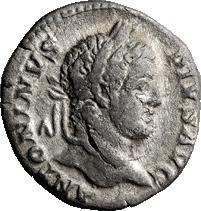
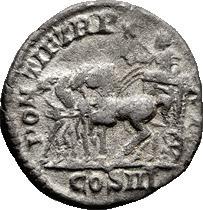
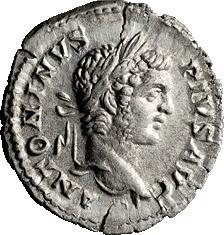
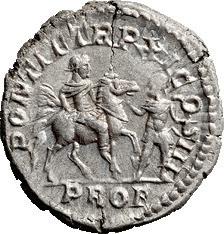



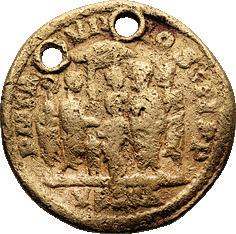
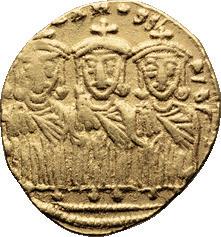

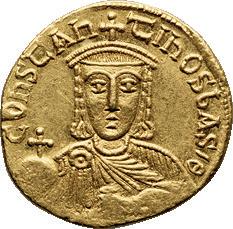
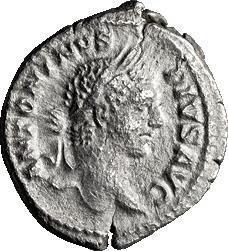
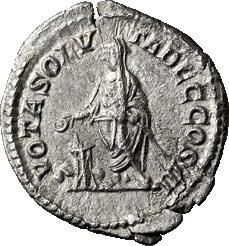
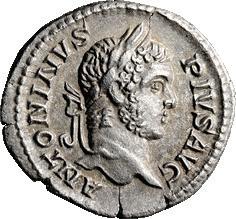
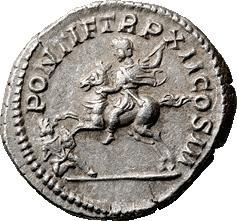
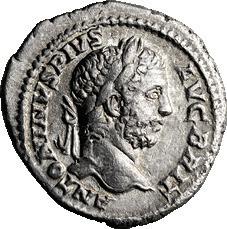


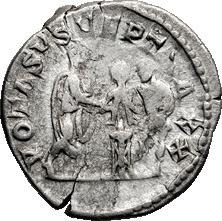


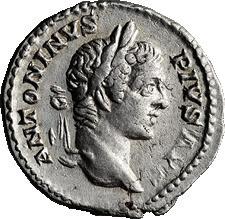
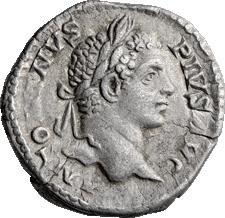

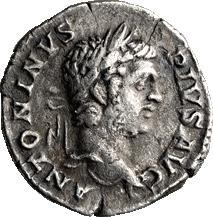

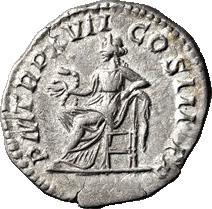
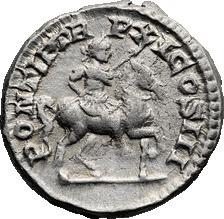
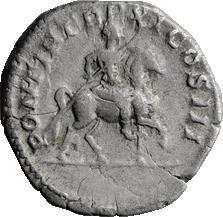
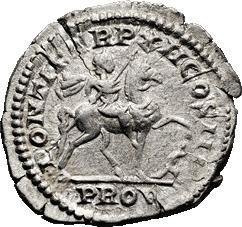



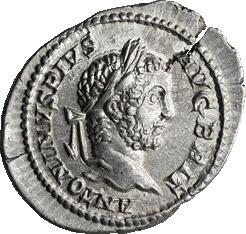
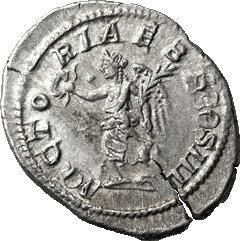

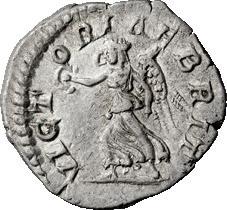
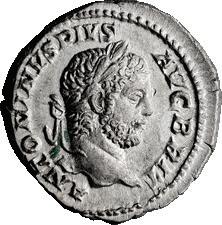

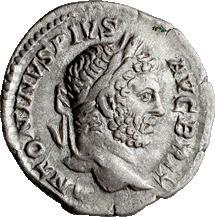
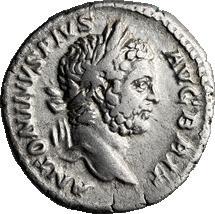

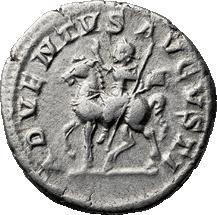
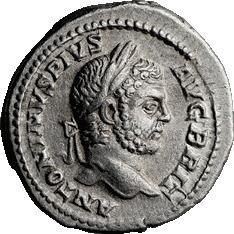
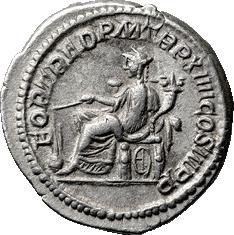
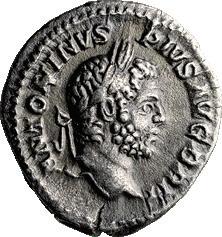



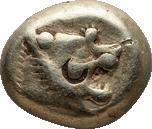




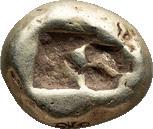
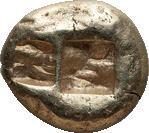

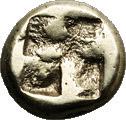

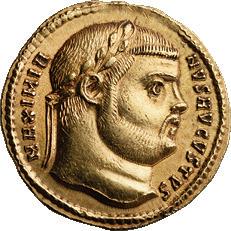
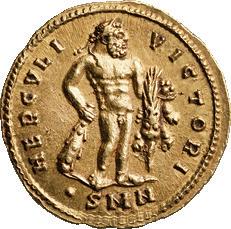

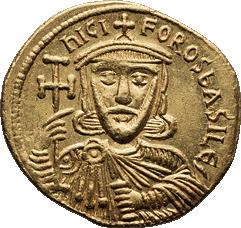
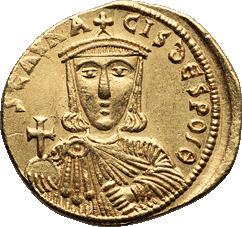
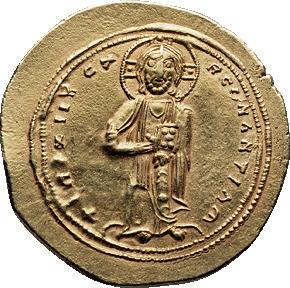
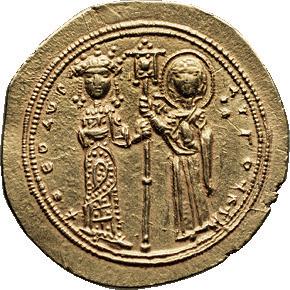
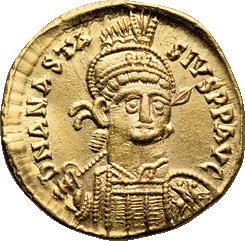
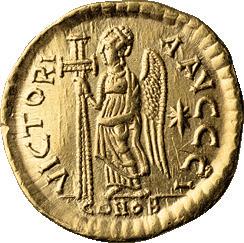



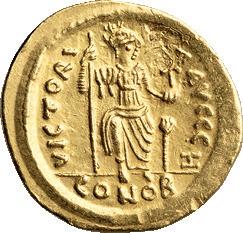
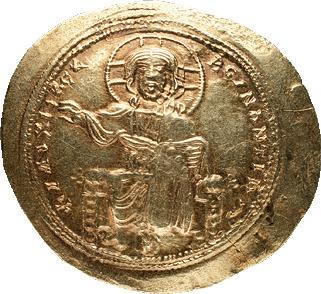
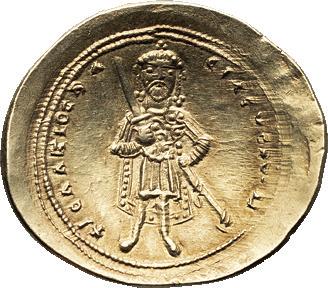


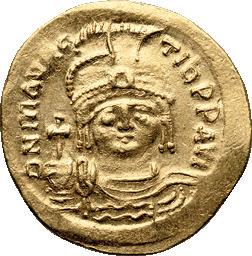

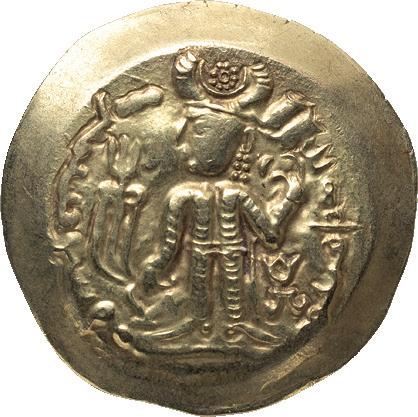
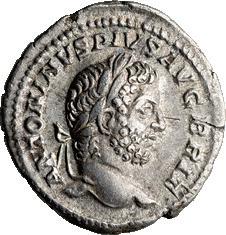
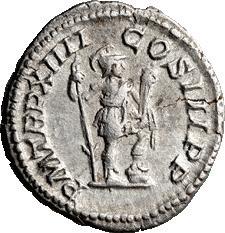
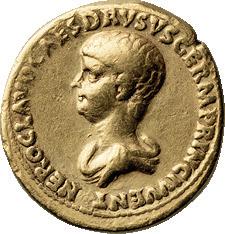

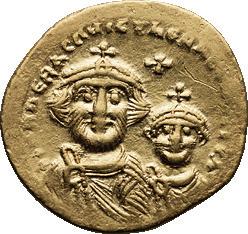

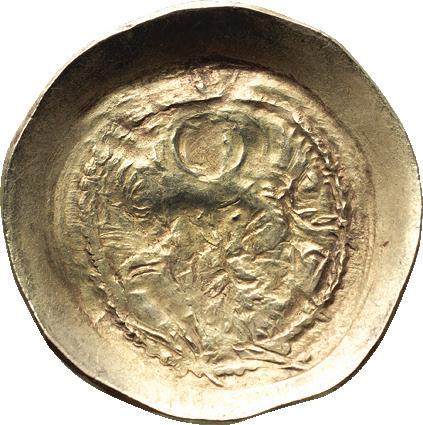
Sphinx
114. MYSIA, CYZICUS HECTE; c. 550-450 BC, Hecte, 2.64g. von Fritze-72, Boston-1451, SNG Paris BN-201. Obv: Sphinx with foreleg raised standing l. on tunny. Rx: Four part incuse square. Ex CNG 126, 28-9 May 2004, lot 212. Virtually MS 2350
115. IONIA, PHOCAEA; ca. 521-478 BC, El Hecte, 2.52g. Bodenstedt-48. Obv. Head and forepart of bull left; to right, small seal upward. Rx. Quadripartite incuse square. EF 1550
116. IONIA, PHOCAEA; ca. 477-388 BC, El Hecte, 2.53g. Bodenstedt-96. Obv. Head of Io left, small seal below to left. Rx. Quadripartite incuse punch. Nose off-flan. aEF 900
117. NERO AS CAESAR; 54-68 AD, Lugdunum, 51-4 AD, Aureus, BM-84, Paris-91, C-311 (50 Fr.), RIC-76 (R2), Calicó-441. Obv: NERO CLAVD CAES DRVSVS GERM PRINC IVVENT Bare-headed, draped bust l. Rx: SACERD COOPT IN OMN CONL SVPRA NVM EX S C Priestly implements: simpulum and tripod on l., lituus and patera on r. These dies not illustrated by von Kaenel, Claudius, pl. 14. This rare reverse type makes a contribution to history, for it informs us that Nero Caesar was “co-opted as supernumerary priest into all priestly colleges in accordance with a decree of the Senate”, a fact that is not mentioned in the surviving literary sources. The occasion of this honor was doubtless Nero’s assumption of the toga of manhood in 51 AD, when Tacitus does tell us that the Senate granted Nero other honors, including the title Prince of the Youth, which is included in the obverse legend of our coin. Perfectly centered, excellent young portrait. aEF 5500
New aureus type: possible imperial return from Britain to Rome in 209 or 210 AD 118. SEPTIMIUS SEVERUS; 193-211 AD, Rome, 209 or 210 AD, Aureus, 6.81g. A new reverse type, missing in the standard catalogues. Obv: SEVERVS - [P]IVS AVG Head laureate r. Rx: VESTA in exergue, sacrifice scene dated TR P XVII or XVIII before temple of Vesta. Ex Curtis L. Clay Collection; ex CNG E180, 23 Jan. 2008, lot 264. This new aureus reverse type, unknown until its appearance in CNG E180 of 2008, suggests that Septimius Severus and his wife and sons may have returned to Rome for one of the winters during his British campaign of 208-211 AD, despite the silence of the literary or epigraphic sources about any such trip. The style of the coin is that of the mint of Rome, though this specimen eventually made its way to India, where it was found according to the CNG cataloguer, and where Roman aurei and imitations of Roman aurei were often pierced with double holes, as on our coin. As to the figures in the reverse type, the three on the right might represent Septimius, Geta, and Julia Domna, Julia’s head only being shown; and the three on the left Caracalla sacrificing at an altar, an attendant or guard standing behind Caracalla, and a boy attendant standing to the right of Caracalla’s altar and below Julia Domna’s head. A similar scene of imperial sacrifice before the round temple of Vesta appeared on aurei of Caracalla four or five years later, in 214 AD, apparently to commemorate the emperor’s return to Rome after his German victories of 213 AD; see BMC pl. 70.5-6. Fine 3000
Ex Sternberg XVI, 16 Nov. 1985
119. MAXIMIANUS; 286-305 AD, Nicomedia, c. 295 AD, Aureus, 5.38g. BM-8 (R4).
Obv: MAXIMIA - NVS AVGVSTVS Head laureate r. Rx: HERCVLI - VICTORI on l. and r., .SMN in exergue, Hercules standing r., with r. hand grasping handle of club resting on globe behind him, with l. hand holding apples and lionskin. Ex Tom Cederlind. Ex Sternberg XVI, 16 Nov. 1985, lot 343. Powerful portrait. MS 18500 120. ANASTASIUS I; Constantinople, ca. 492-507, Solidus, 4.34g. S-3, Berk-3a. Obv. D N ANASTA-SIVS P P AVC Helmeted and cuirassed bust of Anastasius I facing, head turned slightly to right, wearing diadem, holding a spear with right hand and a shield, ornamented with a horseman, over left shoulder. Rx. VICTORI-A AVCCC I Victory standing left, holding long cross; in right field, star; in exergue, CONOB. I = 10th officina, 492-507. Slightly wavy planchet on left. MS 585 121. ANASTASIUS I, 491-518 AD; Constantinople, ca. 492-518 AD, Tremissis, 1.49g. MIB-12, S-8, DO-10. Obv. D N ANASTASIVS P P AVG Pearl-diademed, draped and cuirassed bust of Anastasius to right.Rx. VICTORIA AVGVSTORVM, Victory advancing right, head to left, holding wreath in her right hand and globus cruciger in her left; in field to right, star; in exergue, CONOB. Usual wavy planchet. EF 325 122. JUSTIN II; Constantinople, 565-578 AD, Solidus, 4.42g. DO-4g, MIB-5, S-345. Obv: Bust of Justin facing, holding Victory on globe in his upraised right hand and with a shield bearing a horseman over his left shoulder. Rx: Constantinopolis seated facing, head turned to right, holding spear in her right hand and globus cruciger in her left. MS 600
123. MAURICE TIBERIUS (582-602 AD); Constantinople, ca. 582 AD, Solidus, 4.47g. S-476, MIB-4, DO-3b. Obv. DNTIBERMAVRICPPAV Draped and cuirassed bust of Maurice Tiberius facing, wearing plumed helmet with diadem and pendillia, holding globus cruciger in his right hand. Rx. VICTORIAAVCCHI Angel standing facing, holding long P-cross staff surmounted by staurogram in right hand and globus cruciger in left; in exergue, CONOB. MS 650
124. HERACLIUS AND HERACLIUS CONSTANTINE (610-641 AD); Constantinople, ca. 622-627 AD, Solidus, 4.44g. Sear-852, MIB-77, DO-188a. Obv. DNNHERACLI4STPPA Busts side by side facing of Heraclius left, short-bearded, and his son beardless, right. Rx. VICTORIA AVS4A Cross potent set on three steps; in exergue, CONOB. Usual areas of flat striking in outer field; flawless portraits. MS 600
125. CONSTANTINE VI AND IRENE WITH LEO III-IV AND CONSTANTINE V; Constantinople, c. 790-92 AD, Solidus, 4.40g. Sear-1593, DO-1. Obv: Facing busts of Constantine VI and Irene, both crowned, each holding cross on globe, Irene also holding cruciform scepter; between their heads cross and centering pellet. Rx: Leo III, Constantine V, and Leo IV seated facing, each wearing crown and chlamys. Flatly struck on face of emperor to left, not unusual for this highly detailed type. Mint State 3100
126. CONSTANTINE VI AND IRENE; Constantinople, c. 792-7 AD, Solidus, 4.47g. Berk-235, DO-3, S-1594. Obv: IR[InH] - AΓOVStI Bust of Irene facing, wearing crown and loros, and holding cross on globe and cruciform scepter. Rx:
COnSTAntInOS bAS’Θ Bust of Constantine VI facing, beardless, wearing crown and chlamys, and holding cross on globe and akakia. Mint State 6000
127. NICEPHORUS I AND STAURACIUS; 802-811 AD. Constantinople, 803-811 AD, Solidus, 4.37g. Berk-238, Sear-1604. Obv: nICI - FOROS bASIL E’ Bust of Nicephorus facing, with short beard, wearing crown and chlamys, and holding cross potent and akakia. Rx: STAVRA - CIS dESPO’Θ Similar facing bust of Stauracius, but beardless and holding cross on globe and akakia. Mint State 2250
128. THEODORA; Constantinople, 1055-1056 AD, Histamenon Nomisma, 4.47g. Berk-308, DO-1a, Sear-1837. Obv: + IhS XIS RЄX-RЄΣNANTIhm, Christ standing facing on dais, wearing nimbus cruciger with single pellet in each arm; r. hand raised in benediction, book of Gospels cradled in l. arm; all within double border Rx: + ΘЄOΔΩPA-AVΓOVCTA, Theodora and Virgin Mary standing facing, holding labarum between them; [M-Θ] in fields around Virgin, all within double border. Ex Grapevine Collection, Ex Economopoulos Numismatics. Very rare; virtually flawless strike. MS 6250
129. ISAAC I; Constantinople, 1057-1059 AD, Hyperpyron, 4.39g. Sear-1843, Berk-313, DO-2. Obv: Christ Pantokrator seated facing on throne Rx: Isaac standing facing, holding drawn sword and scabbard. Ex Grapevine Collection, Ex Economopoulos Numismatics. Perfectly centered; slight toning. FDC 3000
130. JOHN III, TREBIZOND; Magnesia, 1222-1254 AD, Hyperpyron, 4.54g. DO-5, S-2073, Hendy-31,1332,5. Obv: Christ enthroned. Rx: Mary blessing the emperor, who is holding labarum and akakia. Virtually MS 650
131. CENTRAL ASIA. ALCHON HUNS. KING KHINGILA; CENTRAL ASIA. Alchon Huns. King Khingila, c. 440-490 AD. Pale gold dinar, 7.11g, Gandhara mint. Obv: Khingila standing l., sacrificing at altar and holding scepter; filleted trident to l., tamgha to r., Bactrian inscription around. Rx: Siva facing, holding diadem and trident; behind, the bull Nandi standing l. Alram-29; Göbl, Dokumente, Em.-85; Vondrovec85c. Struck from worn dies. MS 875 GREEK SILVER
132. CELTIC GAUL, THE SEQUANI; 1st century BC, Quinarius, 2.01g. De La Tour5405, BM-346. Obv: Celticized head of Roma l., [Q] DOC[I] before. Rx: Horse galloping l., [Q DOCI] above, SAΛ [F] below (often read as SAM F.). Well-centered obverse. EF 100
133. SPAIN, SEKOBIRIKES; 2nd century BC, Denarius, 3.70g. SNG Spain-1049-51. Obv: Male head r ; crescent behind. Rx: Horseman with lance r., Iberian legend SEKOBIRIKES below. gVF 250
134. CAMPANIA, NEAPOLIS; ca. 395-385 BC, Didrachm, 7.25g. SNG ANS-376. Obv. Diademed head of nymph r. Rx. Man-headed bull advancing r., head facing; above, crowning Nike flying right; below, Θ between legs. aEF 600 Rare Boy Spearing Mackerel
135. CALABRIA, TARENTUM; ca. 380-345 BC, Stater, 7.90g. Vlasto-398 (1 die). Obv. Naked horseman galloping right, raising whip in right hand behind him; ΘPA below. Rx. TAPAΣ in right field, Taras seated sideways on dolphin right, spearing mackerel with trident. This coin is overstruck on a another issue, only leaving a few areas showing the undertype. A really rare and wonderful type wih one one previous example in Valastro. aEF 1450
136. CALABRIA, TARENTUM; ca. 344-340 BC, Stater, 7.80g. Vlasto-448.
Obv. Naked horseman on galloping horse right, wearing belt and helmeted, his back partially visible and a shield behind him, holding in left hand a spear; beneath horse, |-. Rx. TAPAΣ in right field above; Taras seated to left on dolphin, his left hand resting on dolphin’s back with right hand holding out one-handled vase; below, Π and waves. EF 750
137. CALABRIA, TARENTUM; ca. 302-290 BC, Stater, 7.90g. Vlasto-575. Obv. Naked rider on horse prancing to right, holding round shield, two lances and spear; lancing downward to right. Rx. ΤΑΡΑΣ in right field above, Taras seated astride dolphin to left, holding spindle over his left shoulder; before, eagle standing to left; below, ΦI and waves. This is an unusual reverse type, and rather desirable. EF 750 Only One Die in Vlasto
138. CALABRIA, TARENTUM; ca. 280 BC, Stater, 7.80g. Vlasto-696 (only 1 die). Obv. Naked horseman on prancing horse to right lancing downwards; behind large round shield and two javelins, preparing to throw spear and holding shield and two more spears; ΣI in left field, ΔAKIMOΣ below. Rx.[TAPAΣ] in field to right; Taras astride dolphin to left, holding out in right hand small dolphin; ΔA below. Overstruck on earlier Tarentum, leaving unusual edge at 9:00. MS 950 Rider Crowned by Victory
139. CALABRIA, TARENTUM; ca. 290-281 BC, Stater, 7.80g. Vlasto-502-4. Obv. Naked rider (ephebos) crowning with wreath a stationary horse right, which raises off foreleg; behind, Nike flying right and crowning the rider; below, ΣΙΜ. Rx. ΤΑΡΑΣ in field to right, Taras seated astride dolphin to left, holding trident with his left hand and rising trident with his right hand; below dolphin’s tail, ⊢HP; below, waves. This is a rather unusual type showing the rider crowning the horse, while the rider himself is crowned by Victory. Virtually MS 675 Unpublished
140. LUCANIA, METAPONTUM; c. 540-510 BC, Drachm, 2.52g. Noe-, SNG ANS-, HN Italy-. Obv: METAΠ upwards to r. of six-grained barley ear; circular banker’s mark in l. field. Rx: six-grained barley ear incuse. Apparently unpublished. The expanded METAΠ inscription is distinctive to Noe’s Class VII, which, however, contains only nomoi/staters, no drachms at all. Also unnoticed in the literature is the obverse banker’s mark; see NAC O, lot 1104 and Stack’s Bowers 172, lot 11523 for a virtually identical mark on nomoi/staters, surely a product of the same workshop. Toned gVF 1750
141. LUCANIA, METAPONTUM; 330-290 BC, Nomos, 7.54g. Johnston, Metapontum-4.28. Obv: Head of Demeter left wearing barley wreath. Rx: Ear of barley with leaf. Ex Mark Gibbons Collection. Exceptional image of Demeter, in somewhat high relief. Toned MS 2500 After Euainetos
142. LUCANIA, METAPONTUM; 330-300 BC, After Euainetos, Stater, 7.64g. Johnston-506-509 var. Only three dies in the entire series of this type. Obv: Head of Persephone right. Rx: Wheat ear with unrecorded symbols in the right field. This is a
very rare type. Of the 1000+ dies of Metapontum, only three dies are taken after the decadrachms of Euainetos, and this coin even features an unpublished reverse. aEF 2000
143. SICILY, AKRAGAS; 510-470 BC, Period 1. Didrachm, 8.877g, Jenkins-1b, ANS SNG-915 (same dies), Westermark-42 (O21/R20). Obv: Eagle with closed wings standing l. Rx: Crab. Ex HJB Fixed Price, January 2008, cc49925. Planchet defect on reverse. MS 4750
144. SICILY, KATANE; c. 450-435 BC, Tetradrachm, 16.82g. Rizzo-pl. X, 1, SNG ANS-1244. Obv: Charioteer driving walking quadriga r. Rx: Laureate head of Apollo r. EF / VF 3500
145. SICILY, LEONTINI; ca. 430-425 BC, Tetradrachm, 17.46g. SNG ANS-257, Boehringer-55. Obv: Laureate head of Apollo l. Rx: Lion’s head l.; around, four barley grains and one leaf. Extremely beautiful head of Apollo; flat striking on upper jaw of lion. MS 4850
Beautifully Centered
146. SICILY, ZANKLE-MESSANA; c. 500-493 BC, Drachm, 5.88g. Gielow-40 (same obv. die), SNG ANS-302, SNG Cop-388. Obv: Dolphin swimming l. within harbor; DANKLE below. Rx: Scallop shell in center of nine-part incuse square. Ex Prof. Robert Gaupp Jr. Collection (1907-1978); ex Münzen und Medaillen 32, 20 October 1966, lot 44. Toned EF 9850
Ex Lanz 1983
147. SICILY, SELINUS; ca. 430-425 BC, Tetradrachm, 17.20g. SNG ANS-700. Obv: Apollo and Artemis carried in slow biga right, Apollo drawing bow, while his sister holds the reins; barley-grain in exergue. Rx: Selinus standing left, short horns sprouting from head, holding laurel-branch and pouring libation from phiale onto garlanded altar before which stands cockerel left; behind a selinon leaf and a bovine idol. Ex Lanz 24 April 1983, lot 121. The reverse of this coin has many areas in its prescribed image, all of which are perfectly centered and on-flan. gVF 6500
148. SICILY, SYRACUSE; 510-485 BC, Tetradrachm, 16.75g. Boehringer-106 (V73/ R115). Obv: Charioteer driving slow quadriga r.; above, Nike flying r., crowning horses. Rx: Diademed head of Arethusa r.; around, four dolphins swimming clockwise. VG / Fine 500
Exquisite Archaic Arethusa
149. SICILY, SYRACUSE; c. 485-479 BC, Tetradrachm, 16.96g. Obv: Charioteer driving slow quadriga r.; above, Nike flying r. to crown horses. Rx: Head of Arethusa r., ΣVPA-KOΣ-IO-N and four dolphins around. While this coin has a slight mark on the hair, and a contact mark at 3:00, the image of Arethusa is highly detailed, on a level almost never seen on these early coins of Syracuse. They normally come with extremely worn images. This is a wonderful example of an early Syracusan tetradrachm. gVF / EF 5300
150. SICILY, SYRACUSE; c. 485-466 BC, Tetradrachm, 17.22g. Boehringer-336. Obv: Charioteer driving quadriga r.; above, Nike flying r., crowning charioteer. Rx: Head of Arethusa r.; four dolphins around. aEF 2750
151. SICILY, SYRACUSE; c. 466-405 BC, Tetradrachm, 17.16g. Boehringer-677. Obv: Charioteer driving slow quadriga r.; above, Nike flying r., crowning charioteer. Rx: Head of Arethusa r.; four dolphins around. gVF 1500 Only Four Recorded in Gallatin
152. SICILY, SYRACUSE; c.400-390 BC, Decadrachm, 41.84g. Unsigned by Euainetos. Only Four Recorded with these dies. Gallatin-RXXI/JII. Obv: Galloping quadriga driven l. by charioteer, crowned by Nike; armor in exergue. Rx: Wreathed head of Arethusa l., wearing triple-pendant earring and necklace; pellet under chin; dolphins around, representing the island mint and original site of the city. Miniscule porosity on obverse; rather beautiful reverse. Struck in usual high relief. EF 41500
153. SICILY, SICULO-PUNIC; 350-330 BC, Tetradrachm, 18.37g. Jenkins-193c. Cf. SNG-6434. Obv: Female head left wreathed with wheat, four dolphins around. Rx: Head and neck of horse left, border around. Ex Davissons 27, September 2008, lot 31. Fresh surfaces; lightly toned; excellent style with magnificent horse’s head. EF 3600
154. THRACE, THASOS; c. 500-480 BC, Stater, 9.49g. Le Rider-2, SNG Cop-1008. Obv: Nude ithyphallic satyr r., carrying off protesting nymph. Rx: Quadripartite incuse square. Excellent archaic faces of satyr and nymph; flat strike on nymph’s legs at left edge. EF 1000
155. THRACE, THASOS; 500-480 BC, Obol, 0.56g. HGC-6, 337, SNG Cop-1020. Obv: Two dolphins swimming in opposite directions Rx: Quadripartite incuse square. gVF 300
156. THRACIAN CHERSONESE; ca. 386-338 BC, Hemidrachm, 2.15g. McClean-4071, Sear-Greek-1349. Obv. Forepart of lion r., head looking back, paws raised. Rx Four-part incuse square, pentagram. EF 250
157. CHALCIDIAN DISTRICT, TERONE; 5th Century BC, Hemiobol, 0.23g. SNG ANS-755. Obv. Oinochoe (wine jug); T-E. Rx. 4-part incuse. Toned EF 600
158. CHALCIDIAN DISTRICT, ACANTHUS TETARTEMORION; c. 500480 BC, tetartemorion, 0.19g. Cf SNG ANS-51, cf SNG Ashmolean-2221, cf SNG Lockett-1291. Obv: Bull’s head r., border of dots. Rx: Four-part incuse square. The references cited here (and others) are all for hemiobols, with weights ranging from 0.35-0.45g, appropriate for the denomination. This is surely a tetartemorion, perhaps unpublished as such. EF 300
159. CHALCIDIAN DISTRICT, ACANTHUS; 470-390 BC, Tetrobol, 2.31g. SNG ANS-33. Obv: Forepart of bull, l., head turned back to r. Rx: Quadripartite incuse square. Toned VF 200
160. CHALCIDIAN DISTRICT, MENDE; 520-480 BC, Tetartemorion (¼ obol), 0.21g. SNG ANS-310. Obv. Mule standing r. Rx. Crow l. VF 400
161. CHALCIDIAN DISTRICT, MENDE; 460-425 BC, Trihemitartemorion, 0.39g. SNG ANS-355. Obv: Ass standing Rx: Rx. Crow l. VF / F 400
162. MACEDONIA, ALEXANDER I; 495-454 BC, Tetrobol, 2.05g. Grose-3286. Obv: Archaic style horse walking r., l. foreleg raised, Rx: Crested helmet, right, in linear within incuse square. Bold Fine 150
163. MACEDONIA, PERDICCAS II, 451-413 BC; ca. 443/2-438.7 BC, Tetrobol, 2.33g. Raymond-187, SNG Cop-499, SNG ANS-47, 52. Obv. Rider on walking horse, r., petasus at nape of neck, holding two spears. Rx. Lion forepart r., in incuse square. VF / VG 250
164. MACEDONIA, ARCHELAUS I; 413-400/399 BC, Tetrobol, 2.14g. SNG ANS71; Alpha Bank 150. Obv. Free horse, left. Rx: APXEMO in left field; crested helmet inside linear square. Toned VF 450
165. MACEDONIA, AMYNTAS III; 381-369 BC, Diobol, 1.23g. SNG ANS-956, SNG Alpha Bank-200. Obv. Head of Herakles r., wearing lion skin headdress. Rx. Eagle standing l., head r., within incuse square. Miniscule porosity. EF 600 Patterned After Zeus of Olympics
166. MACEDONIA, PHILIP II (359-336 BC); Lifetime Issue c. 348-343/2 BC, Tetradrachm, 14.45g. Le Rider-213 (same hand), Rose Type Reverse (few dies). Obv. Laureate head of Zeus right. Rx. ΦΙΛΙΠ-ΠΟΥ Naked youth on horse prancing right, rose below horse. This is an exquisite, high relief image of Philip II as Zeus. Since Philip was at the Olympics to prove to the Greeks that despite his Macedonian heritage, he too was a Greek, he was therefore in possession of Olympic issues of Zeus, since participants in the Olympics had to change their money for Olympic money. It seems obvious that Philip patterned his early tetradrachms after the Olympic issues, varying them slightly to show his own portrait. This particular issue with the rose symbol is quite rare, and closest to the Olympic Zeus, as compared to other early issues by Philip II that commemorated his horse’s Olympic victory. There is a possibility that Philip himself was involved in the creation of these dies. Miniscule countermark at bottom of field. MS 5000
167. MACEDONIA, ALEXANDER III THE GREAT, 336-323 BC; Amphipolis, Lifetime issue struck under Antipater, c.325-322 BC, Tetradrachm, 17.01g. Price-79. Obv: Head of Herakles r., wearing lion skin. Rx: Zeus seated l., cock in l. field. Hairline on reverse. VF 500
168. MACEDONIA, ALEXANDER III THE GREAT, 336-323 BC; Uranopolis (?), c. 300-290 BC, Tetradrachm, 17.22g. Price-509. Obv: Head of Herakles r., wearing lion skin. Rx: Zeus seated l., star on cone above X in l. field, wreath below throne. Virtually MS 1750
169. MACEDONIA, ALEXANDER III THE GREAT, 336-323 BC; Miletus, c. 323319 BC, Tetradrachm, 16.96g. Price-2099. Obv: Head of Herakles r., wearing lion skin. Rx: Zeus seated l., grain-ear in l. field. EF 1400
170. MACEDONIA, ALEXANDER III THE GREAT, 336-323 BC; Tarsus, Lifetime issue c. 327-323 BC, Tetradrachm, 17.06g. Price-3044. Obv: Head of Herakles r., wearing lion skin. Rx: Zeus seated l., caduceus and Nike r. in l. field, monogram below throne. EF / VF 750
171. MACEDONIA, ALEXANDER III THE GREAT, 336-323 BC; Babylon, c. 317311 BC, Tetradrachm, 17.00g. Price-3704. Obv: Head of Herakles r., wearing lion skin. Rx: Zeus seated l., monogram in wreath in l. field, H below throne. VF 625
172. MACEDONIA, ALEXANDER III THE GREAT, 336-323 BC; Struck under Philip V in Pella, c. 180 BC, Tetradrachm, 1570.00g. Price-634. Obv: Head of Herakles r., wearing lion skin. Rx: Zeus seated l., AΛEΞANΔPOY and tripod in l. field; B below throne. Quite rare; we find only one example on Coin Archives. It’s quite unusual to find Alexander’s name placed on the left side as opposed to the normal right. Perhaps an engraver’s error, quickly corrected, as more common dies of this issue place the name on the right as expected. VF 1250
173. MACEDONIA, ALEXANDER III THE GREAT, 336-323 BC; Pella (?), c. 300290 BC, Tetradrachm, 15.88g. Price-526. Obv: Head of Herakles r., wearing lion skin. Rx: Zeus seated l., Triton l. in l. field, monogram below throne. Scarce symbol. Minor test-cut at edge of 10:00. VF 750
174. MACEDONIA, ALEXANDER III THE GREAT, 336-323 BC; Cyme, c. 215200 BC, Tetradrachm, 16.99g. Price-1628. Obv: Head of Herakles r., wearing lion skin. Rx: Zeus seated l., monogram and jug in l. field. VF 1250
175. MACEDONIA, ALEXANDER III THE GREAT, 336-323 BC; Magnesia, c. 225-200 BC, Tetradrachm, 16.88g. Price-2043 var (monogram position). Obv: Head of Herakles r., wearing lion skin. Rx: Zeus seated l., monograms in l. field and below throne; maeander in exergue. VF 1000
176. MACEDONIA, ALEXANDER III THE GREAT, 336-323 BC; Mytilene, c. 188-170 BC, Tetradrachm, 17.05g. Price-1736. Obv: Head of Herakles r., wearing lion skin. Rx: Zeus seated l., monogram and lyre in l. field, ivy-leaf below throne. Struck on extremely broad flan; slight flat striking on hair above forehead. EF 1000
177. MACEDONIA, ALEXANDER III THE GREAT, 336-323 BC; Miletus, c. 210190 BC, Tetradrachm, 17.04g. Price-2171 var (r. field monogram rotated). Obv: Head of Herakles r., wearing lion skin. Rx: Zeus seated l., star, lion and monogram in l. field, monogram in r. field. aEF 1250
178. MACEDONIA, ALEXANDER III THE GREAT, 336-323 BC; Chios, c. 210190 BC, Tetradrachm, 16.85g. Price-2402. Obv: Head of Herakles r., wearing lion skin. Rx: Zeus seated l., monogram and sphinx l. on thunderbolt in l. field. Rare; we find only one example on Coin Archives. Struck on extremley broad flan. EF 1500
179. MACEDONIA, ALEXANDER III THE GREAT, 336-323 BC; Samos, c. 201 BC, Tetradrachm, 16.96g. Price-2447, Barron-4. Obv: Head of Herakles r., wearing lion skin. Rx: Zeus seated l., prow above B in l. field. Ex Triton XIV, 4 January 2011, lot 316. VF 2000
Rare Mylasa Mint
180. MACEDONIA, ALEXANDER III THE GREAT, 336-323 BC; Mylasa, c. 210190 BC, Tetradrachm, 16.92g. Price-2494. Obv: Head of Herakles r., wearing lion skin. Rx: Zeus seated l., trident and monogram in l. field. High relief for issue. MS 2000
181. MACEDONIA, ALEXANDER III THE GREAT, 336-323 BC; Uncertain mint in Macedon or Greece, c. 310-275 BC, Drachm, 4.20g. Price-862A. Obv: Head of Herakles r., wearing lion skin. Rx: Zeus seated l., apluster in l. field. VF 350
182. MACEDONIA, ALEXANDER III THE GREAT, 336-323 BC; Lampsacus, c. 323-317 BC, Drachm, 4.21g. Price-1380. Obv: Head of Herakles r., wearing lion skin. Rx: Zeus seated l., buckle and Δ in l. field, AI below throne. Virtually MS 450
183. MACEDONIA, ALEXANDER III THE GREAT, 336-323 BC; Lampsacus, c. 310-301 BC, Drachm, 4.11g. Price-1398. Obv: Head of Herakles r., wearing lion skin. Rx: Zeus seated l., KI in l. field, monogram below throne. VF 200
184. MACEDONIA, ALEXANDER III THE GREAT, 336-323 BC; Lampsacus, c. 310-301 BC, Drachm, 4.15g. Price-1417. Obv: Head of Herakles r., wearing lion skin. Rx: Zeus seated l., amphora in l. field, monogram below throne. VF / F 225


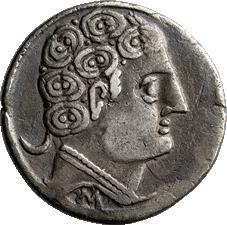

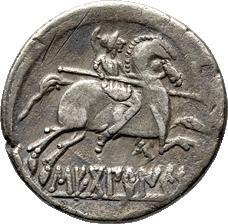


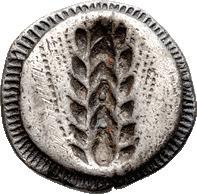
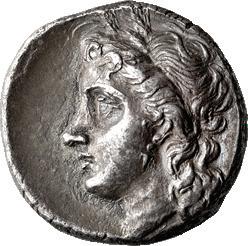

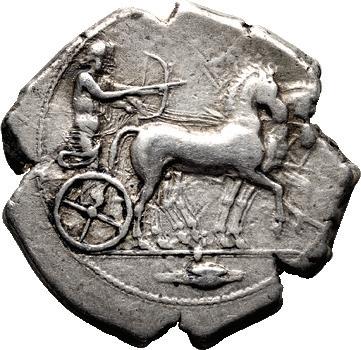
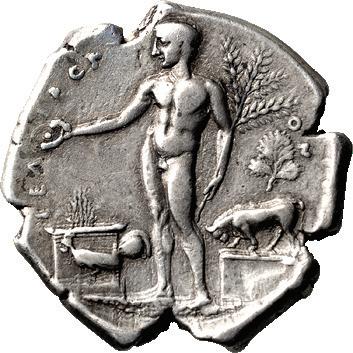

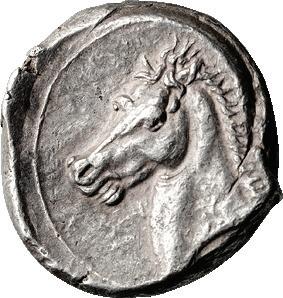

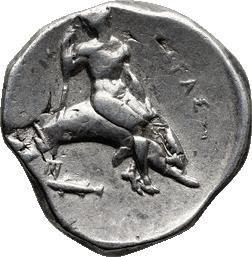

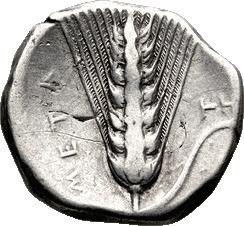
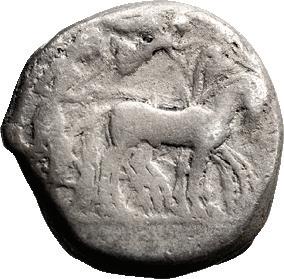

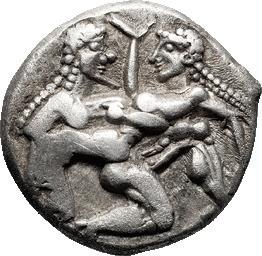
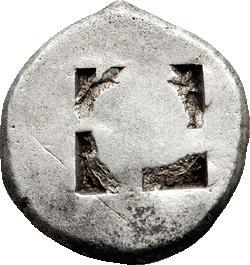
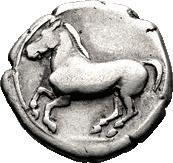
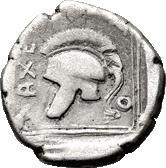

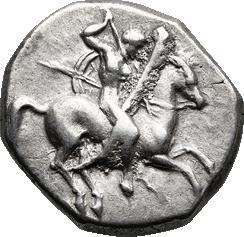

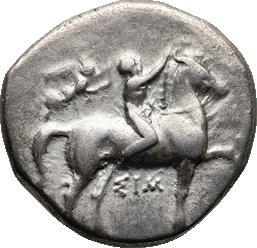
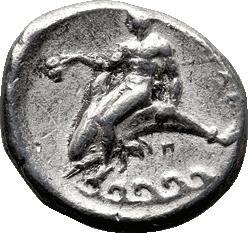

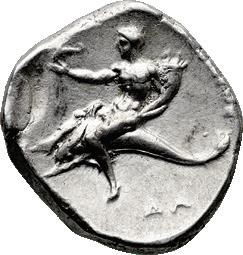


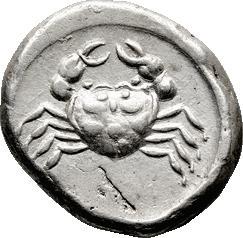
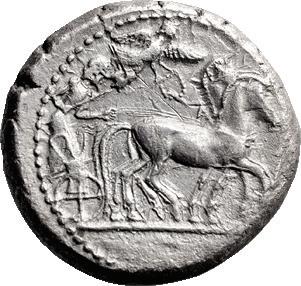


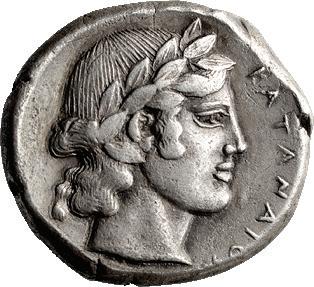


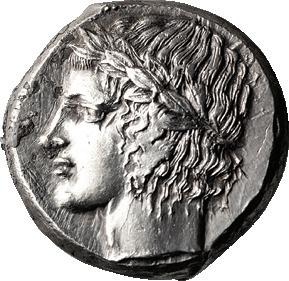

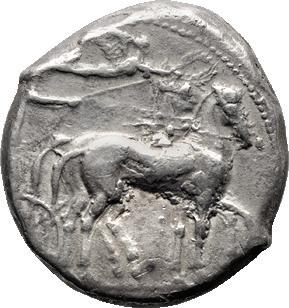


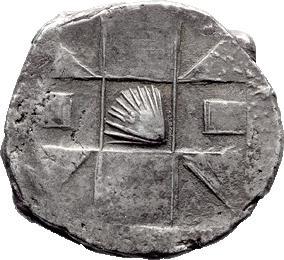
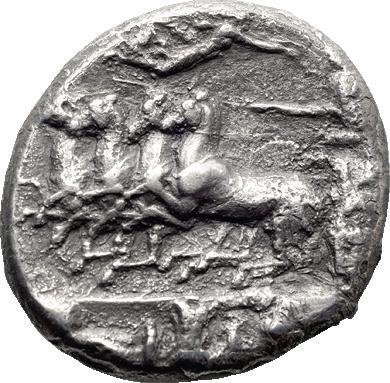



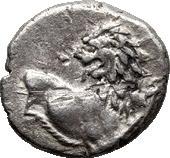











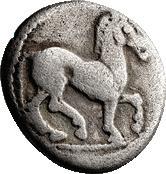

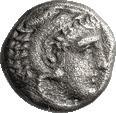


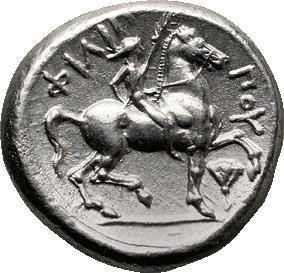

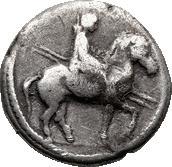

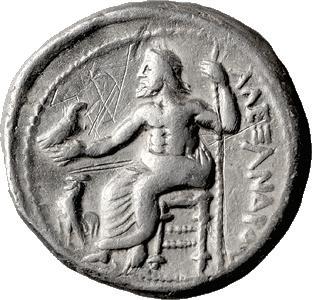


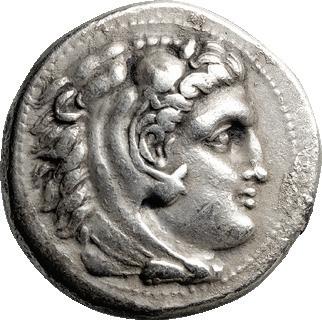
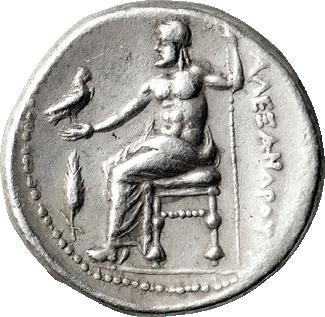
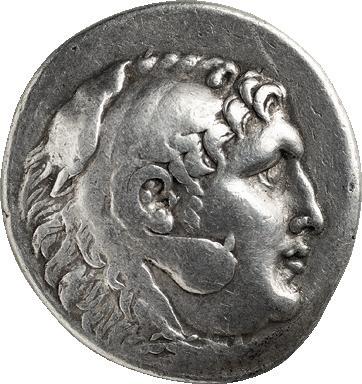


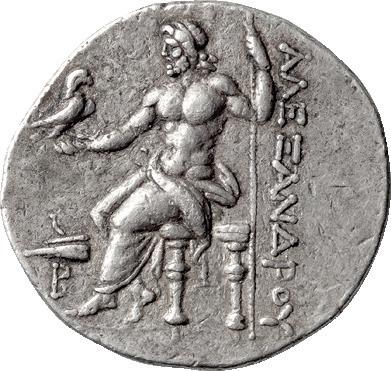
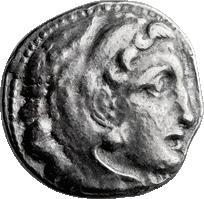
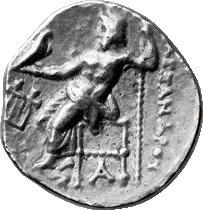
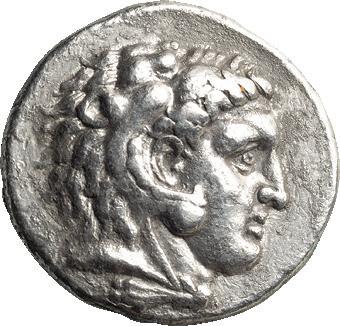
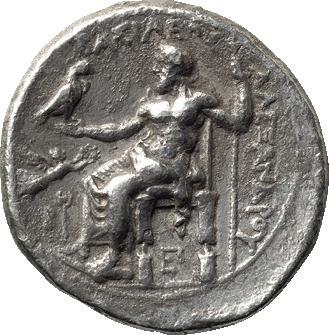
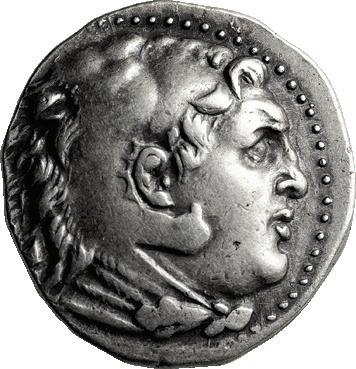







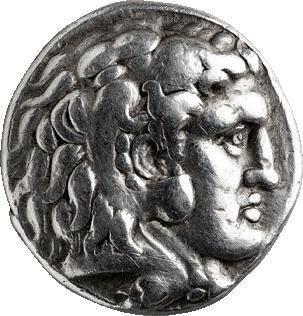

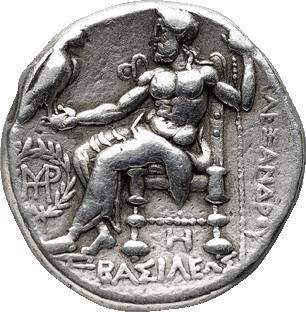
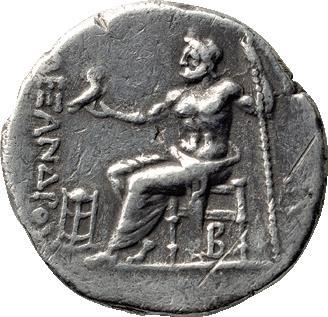
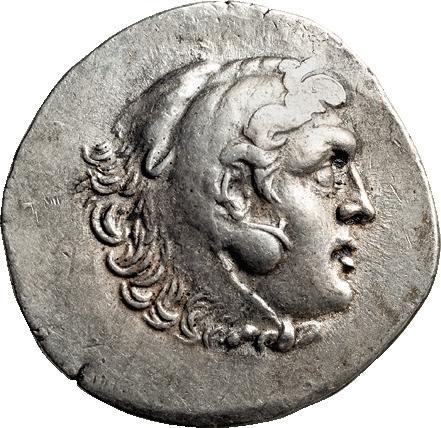




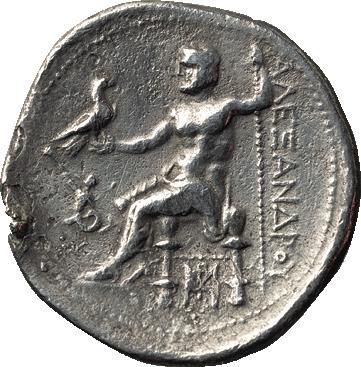

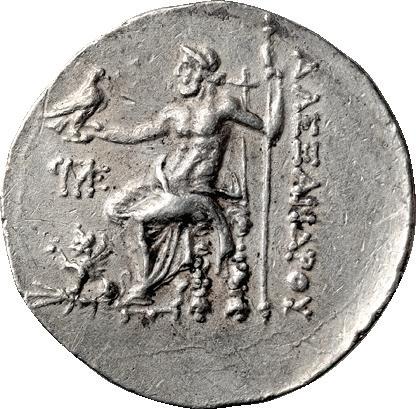




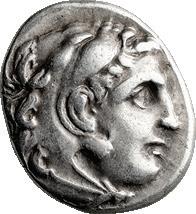
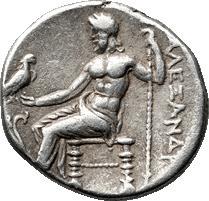
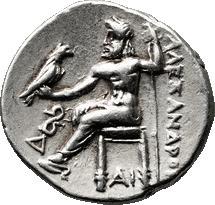
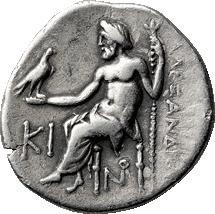



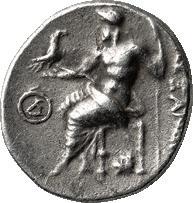

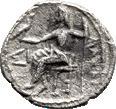

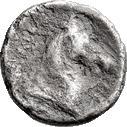
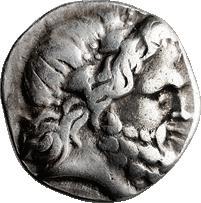
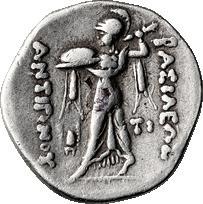


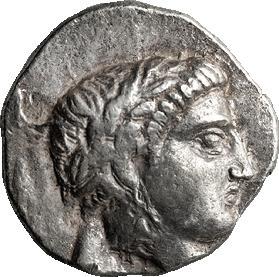

185. MACEDONIA, ALEXANDER III THE GREAT, 336-323 BC; Drachm, 4.21g. Price-1555. Obv: Head of Herakles r., wearing lion skin. Rx: Zeus seated l., ivy leaf in l. field, lion looking back below throne. VF 300
186. MACEDONIA, ALEXANDER III THE GREAT, 336-323 BC; “Colophon,” c. 323-319 BC, Drachm, 4.11g. Price-1769. Obv: Head of Herakles r., wearing lion skin. Rx: Zeus seated l., kithara in l. field, A below throne. Toned aVF 250 187. MACEDONIA, ALEXANDER III THE GREAT, 336-323 BC; Miletus, c. 300295 BC, Drachm, 4.26g. Price-2138. Obv: Head of Herakles r., wearing lion skin. Rx: Zeus seated l., helmet-crest in l. field, double-ax below throne. High relief obverse for issue. EF / VF 400
188. MACEDONIA, ALEXANDER III THE GREAT, 336-323 BC; “Teos,” 310-301 BC, Drachm, 4.02g. Price-2307. Obv: Head of Herakles r., wearing lion skin. Rx: Zeus seated l., ram’s head in l. field. VF 275 189. MACEDONIA, ALEXANDER III THE GREAT, 336-323 BC; Uncertain mint, probably Western Asia Minor, c. 323-280 BC, Drachm, 4.14g. Price-2747. Obv: Head of Herakles r., wearing lion skin. Rx: Zeus seated l., ΔΕ monogram within circle in l. field, lion’s head below throne. Quite rare; we find only one on Coin Archives. EF 500
Lifetime Issue
190. MACEDONIA, ALEXANDER III THE GREAT, 336-323 BC; Lifetime issue, Sidon, c. 332/1 BC or later, Obol, 0.49g. Price-3476. Obv: Head of Herakles r., wearing lion skin. Rx: Zeus seated l., ΣΙ in l. field. VF 150 191. MACEDONIA, KASSANDER ISSUE UNDER THE NAME OF PHILIP II; ca. 323/2–315 BC, 1/10 Stater, 1.09g. Le Rider-482 (255-397), SNG ANS-437, Weber-2066; one die used for entire issue. Obv. Laureate head of Apollo, right. Rx. Head of horse, right. Only one pair of dies for issue; some porosity. gVF 300 192. MACEDONIA, ANTIGONUS GONATAS; 277-239 BC, Drachm, 3.78g. SNG Oxford-3262, SNG Copenhagen-1203. Obv. Head of Zeus r, diademed Rx. ΒΑΣΙΛΕΩΣ to r, ΑΝΤΙΓΟΝΟΥ to l, Athena facing l, holding a shield in l hand and a branch r hand, ΤI mark below branch. VF 600
193. UNDER THE ROMANS, BOTTIAEA; 185-168 BC, Tetrobol, 1.84g. SNG Cop136, SNG Cop-1289. Obv: Macedonian shield; star ornament in center Rx: MAKE/ [Δ]ONΩN stern of galley. l., star above. gVF 200 194. PAEONIA, PATRAOS; c. 335-315 BC, Tetradrachm, 12.71g. BM-4. Obv: Laureate head of Apollo r. Rx: Π - A[ΤP]AoY Horseman in crested helmet charging r., spearing fallen enemy carrying Macedonian shield. Ex Paeonian Hoard. Beginning and end of king’s name legible. EF / VF 685
195. MACEDONIA, AMPHIPOLIS; 167-149 BC, Tetradrachm, 16.45g. SNG Cop1314, AMNG-177. Obv. Head of Artemis of Macedonia r., wearing a tunic and a quiver, with a bow over her shoulder, surrounded by a shield. Rx. Mace within wreath, ΜΑΚΕΔΝΩΝ above, ΠΡΩTΗΕ below. Fine 400 196. THRACE, LYSIMACHUS, 323-281 BC; Struck in Byzantion, c. 1st century BC, Tetradrachm, 15.31g. Obv: Head of deified Alexander r. Rx: Athena seated l., monogram under outstretched arm, BY on throne, trident below. VF / F 300 Kingdom of Thrace
197. THRACE, LYSIMACHUS; 323-281 BC, Drachm, 4.12g. Thompson-173. Obv. Diademed head of the deified Alexander right, wearing horn of Ammon. Rx. Athena Nicephoros seated left, arm resting on shield and transverse spear behind, BAΣIΛEΩΣ to right, ΛYΣIMAXOY to left, spear head to inner left and A on throne. VF / F 250 198. DANUBIAN DISTRICT, ISTRUS; 400-350 BC, 1/4 Stater, 0.77g. SNG BM Black Sea- 258. Obv:Two facing male heads side by side, one inverted Rx: ΙΣΤΡI[H] Sea eagle standing l. on dolphin. VF 200
199. BOEOTIA, THEBES; Diok. magistrate, ca. 363-338 BC, Stater, 11.96g. BCD-550, HGC-1334. Obv: Boeotian shield. Rx: Volute Krater, DI-OK across fields. EF 1000 200. BOEOTIA, THEBES; Agla- magistrate. ca. 363-338 BC, Stater, 11.97g. BCD-551, HGC-1334. Obv: Boeotian shield. Rx: ΑΓ-ΛΑ, volute krater with a decorated upper half, all within incuse concave circle. Edge porosity at upper part of reverse. aEF975
201. BOEOTIA, THEBES HEMIDRACHM; ca. 379-371 BC, Hemidrachm, 2.59g. Sear Greek Coins-2396v, BMC Boeotia-50ff, SNG Copenhagen-177 var. Obv. Boeotian shield. Rx. “BO” in left field, “I” in right field (BO-I); kantharos with club above. VF 175
Persian War Issue
202. ATTICA, ATHENS; About 499-480 BC, Tetradrachm, 17.00g. Issue for Persian War. Obv: Helmeted Bust of Athena right. Rx: [A]ΘE Standing owl and olive leaf left This coin is very well centered for issue, though struck with worn dies, evidence of how quickly tetradrachms had to be issued to finance the war. gF 1575
Exquisite Tetradrachm
203. ATTICA, ATHENS; c. 454-449 BC, Tetradrachm, 17.17g. Starr-Group V.B, Series-3, similar to 191. Obv: Helmeted head of Athena r. Rx: Owl standing r., head front, crescent and olive twig with two leaves behind, ΑΘΕ downwards in r. field. This coin is struck in flawless high relief on both obverse and reverse, showing a beautiful youthful Athena and a magnificent, powerful owl. While Starr Group V are normally quite nice, this coin is extremely exceptional. FDC 4000
Exceptional Starr Group VB
204. ATTICA, ATHENS; c. 454-449 BC, Tetradrachm, 17.20g. Starr-Group V.B, Series-3; close to 197. Obv: Helmeted head of Athena r. Rx: Owl standing r., head front, crescent and olive twig with two leaves behind, ΑΘΕ downwards in r. field. This is one of the last issues of Starr Group V. Athena is very beautiful, but somewhat referential to the standard types. Struck in high relief with exquisite detail throughout the entire coin. MS 3500
205. ATTIC, ATHENS; 440 BC, Tetradrachm, 17.22g. Kroll-8, Svoronos-pl.12-13 passim. Obv: Head of Athena r., wearing crested Attic helmet decorated with three olive leaves and palmette. Rx: ΑΘΕ Owl standing r., head front, crescent and olive twig with two leaves behind, all within incuse square. Virtually MS 2000
206. ATTICA, ATHENS; 435 BC, Tetradrachm, 17.15g. Obv: Helmeted head of Athena r. Rx: Owl standing r., head facing, olive sprig behind, AΘE downward on r.; all within incuse square. Virtually MS 2000
207. ATTICA, ATHENS; 435 BC, Tetradrachm, 17.23g. Kroll-8, Svoronos-pl.12-13 passim. Obv: Head of Athena r., wearing crested Attic helmet decorated with three
olive leaves and palmette. Rx: ΑΘΕ Owl standing r., head front, crescent and olive twig with two leaves behind, all within incuse square. Virtually MS 1900
208. ATTICA, ATHENS; 435 BC, Tetradrachm, 16.53g. HGC-4, 1597, SNG Copenhagen-31. Obv. Head of Athena right, wearing crested Attic helmet adorned with three olive leaves and a palmette, a circular earring and a pearl necklace. Rx. AΘE; Owl standing to right, head facing; in field to left, olive spray and crescent; all within incuse square. Obverse in high relief. EF 1450
209. ATTICA, ATHENS; c. 430 BC, Tetradrachm, 16.63g. Obv: Helmeted head of Athena r. Rx: Owl standing r., head front, crescent and olive twig with two leaves behind, ΑΘΕ downwards in r. field. Hairline on Athena’s cheek and in reverse field. aEF 1000
210. ATTICA, ATHENS; c. 430 BC, Tetradrachm, 16.50g. Obv: Helmeted head of Athena r. Rx: Owl standing r., head front, crescent and olive twig with two leaves behind, ΑΘΕ downwards in r. field. Hairline initial A in obverse cheek. aEF 950
211. ATTICA, ATHENS; c. 430 BC, Tetradrachm, 16.06g. Obv: Helmeted head of Athena r. Rx: Owl standing r., head front, crescent and olive twig with two leaves behind, ΑΘΕ downwards in r. field. VF / F 875
212. ATTICA, ATHENS; c. 425 BC, Tetradrachm, 16.78g. Obv: Helmeted head of Athena right. Rx: Owl standing right, head front; ΑΘΕ downwards on right. Tiny mark on cheek. VF 1300
213. ATTICA, ATHENS; c. 425 BC, Tetradrachm, 16.41g. Obv: Helmeted head of Athena right. Rx: Owl standing right, head front; ΑΘΕ downwards on right. aEF750 Exceptional Late Issue
214. ATTICA, ATHENS; c. 393-294 BC, Tetradrachm, 17.07g. Obv: Helmeted head of Athena r. Rx: Owl standing r., head front, crescent and olive twig with two leaves behind, ΑΘΕ downwards in r. field. The late issues of Athena with profile eye tend to be on small flans, and poorly-centered. This coin however is struck on a broad flan, well-centered for issue, with an extremely beautiful image of Athena. A coin this good of this period must be very early, since it was followed by quite inferior coins. EF 1750
Rare Drachma
215. ATTICA, ATHENS; c. 454-404 BC, Drachm, 4.26g. SNG Cop-41. Kroll-10. Obv: Helmeted head of Athena r. Rx: Owl standing r., head front, olive sprig in l. field, AΘΕ downwards in r. field. Ex Mark Gibbons collection. EF 750
216. ATTICA, ATHENS; 454-404 BC, Hemiobol, 0.33g. SNG Cop-59, Kroll-14. Obv: Helmeted head of Athena r. olive sprig behind. Rx: Owl standing r., head facing, AΘ[E] downward on r.; all within incuse square. aEF 300 Exceptional High Relief
217. ATTICA, AEGINA; c. 510-490 BC, Stater, 12.22g. Obv: Sea Turtle with smooth shell with dotted center. Rx: Incuse with four sunken segments. This stater is struck in ultra-high relief, perfectly centered, with a flawless head of the sea turtle sharply evident. This is one of the finest examples of this early period recorded, with the high relief of this coin almost unknown. Ex Sotheby’s. Zurich. Sold on the Instructions of Numismatic Fine Arts. October 27-28, 1993, lot 554. Ex Triton XXVII, 9 January 2024, lot 187; ex HJB 216, July 2021, lot 56. This is one of the earliest Aegean Turtles, and pictures in ANS museum notes. Struck in high relief, showing everything, not only the dots on the shell, but also the turtle’s head, both front legs, and portions of the rear legs, something rarely seen on these issues, which concentrated on weight, rarely centering. Toned EF 11000
218. ATTIC, AEGINA OBOL; c. 480-450 BC, Obol, 0.90g. SNG Lockett-1967, HGC 6-450. Obv: Sea Turtle. Rx: Incuse with skew pattern. Beautifully centered for such a small coin. aEF
500
219. CORINTHIA, CORINTH; c. 480-450 BC, Stater, 8.36g. Calciati-82. Obv: Pegasus flying r., Ϙ below. Rx: Head of Athena r., Ϙ behind; all within incuse square. Fine 475 220. CORINTHIA, CORINTH; c. 330-300 BC, Stater, 8.38g. Calciati-375. Obv: Pegasus flying l. Rx: Head of Athena l., amphora before, E behind. EF 750 221. CORINTHIA, CORINTH; c. 330-300 BC, Stater, 8.53g. Calciati-453. Obv: Pegasus flying l. Rx: Head of Athena l., Δ before, Artemis with flaming torch behind. EF 800 222. ACARNANIA, LEUCAS; 350-330 BC, Stater, 8.53g. Calciati-64/1. Obv: Λ Pegasos flying left Rx: ΛΕY Head of Athena to left, wearing Corinthian helmet; behind, wreath. MS 900
223. ELIS, OLYMPIA; 364-323 BC, Hemidrachm, 2.60g. Seltman-pl. XII, 25. Obv: Head of Hera, r., wearing stephane Rx: Eagle r., head turned back to l.; to r., thunderbolt; to l., “FA”. Fine 225 224. PHOCIS, PHOCAEAN LEAGUE OBOL; c. 478-460 BC, Obol, 0.92g. Williams-119, BM-34. Obv: Facing head of bull. Rx: Forepart of boar r. EF / VF350 225. PONTUS, AMISUS (AS PEIRAIEOS); c. 435-370 BC, Drachm, 5.58g. SNG BM-, SNG Cop-, SNG von Aulock-, BM-. Obv: Head of Hera l., wearing stephane, earring, and necklace. Rx: Owl standing facing with wings spread, A to l. Π to r., ΠΕΙΡ in exergue. Rare; not in references consulted. Large test cut at at 10:00. EF 225
226. BITHYNIA. KALCHEDON; ca. 367-340 BC, Drachm, 3.90g. SNG BM-104, HGC-7, 511. Obv. Bull standing l. on grain ear; kerykeion and monogram to l. Rx. Quadripartite square with stippled surface. Bull’s head off-flan. MS 150
227. AEOLIS, CYME; c. 480-450 BC, Hemiobol, 0.35g. SNG Aulock-1623, Rosen-538. Obv: Head of eagle l., K before, Rx: Quadripartite incuse square. Bold Fine 150
228. AEOLIS, CYME; After 190 BC, Tetradrachm, 16.53g. Oakley, Museum Notes 27, obverse die 12. Obv: Head of Amazon Kyme r. wearing hairband. Rx: Horse stepping r., one-handled cup below horse’s raised l. foreleg, magistrate’s name Kallias in exergue, mint name downwards before horse, all in laurel wreath. MS 3000
229. LYDIA, SARDES; c. 135-128 BC, Cistophoric Tetradrachm, 12.51g. Kleiner/Noe22a. Obv: Serpent emerging from cista mystica; ivy-wreath around. Rx: Bowcase with serpents; monogram above, [Σ]ΑΡ to l., female figure to r. Very scarce mint for cistophors. gVF 475
230. IONIA, UNCERTAIN; ca. 6th centuty BC, 0.55g. SNG von Aulock-1817, Rosen-403. Obv: Forepart of lion, facing Rx: Scorpion l., in incuse square. aEF 150 231. IONIA, EPHESUS; ca. 360-350 BC, Tetradrachm, 13.99g. cf. S.4372, Coin Hoards CH IX, Class F [obv.89], Pixodarus Hoard, magistrate noted in Oxford 1929. Obv:
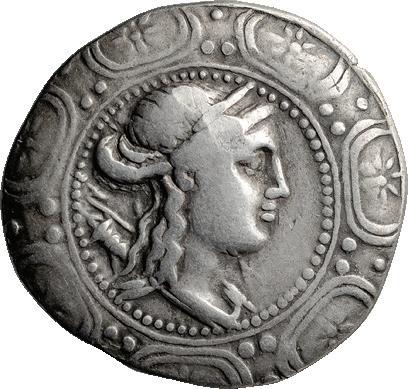


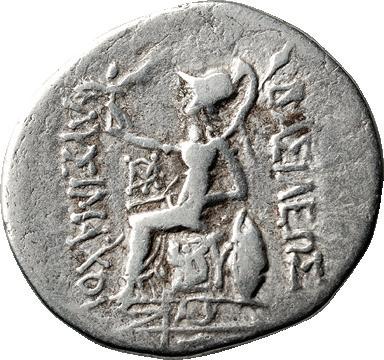
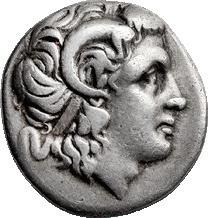



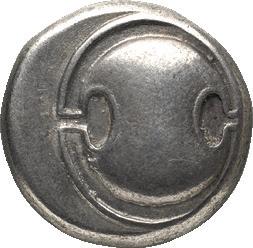
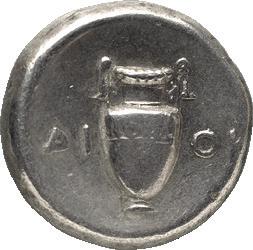
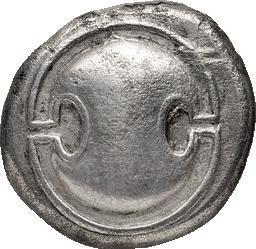
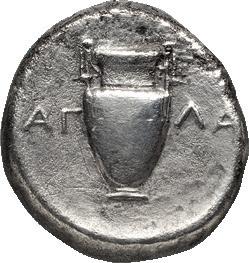
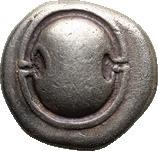
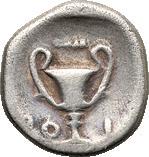

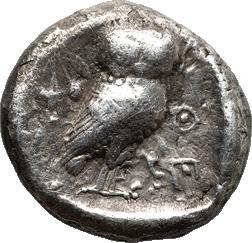

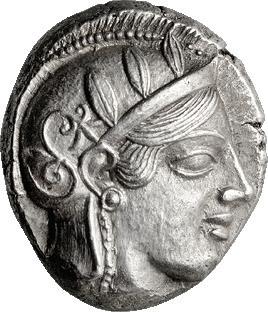



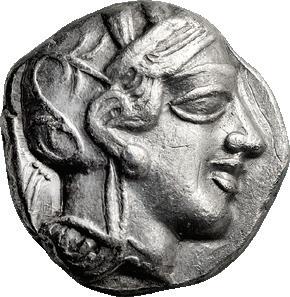


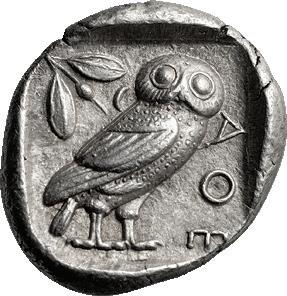

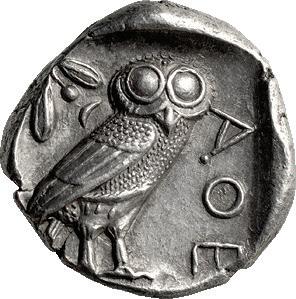
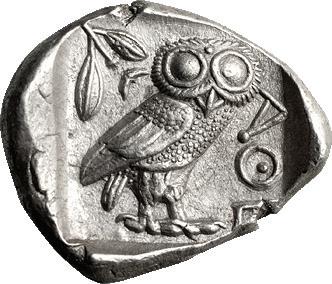
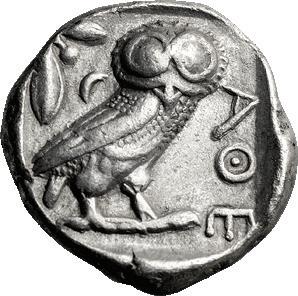
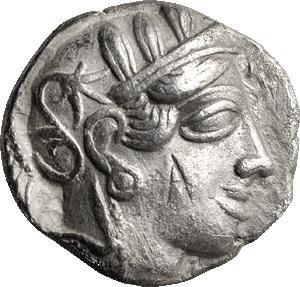
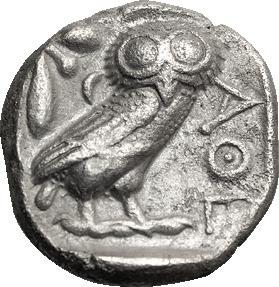
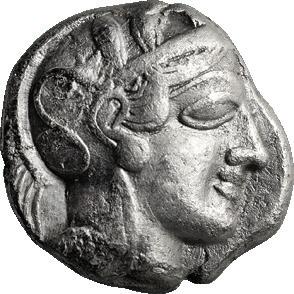


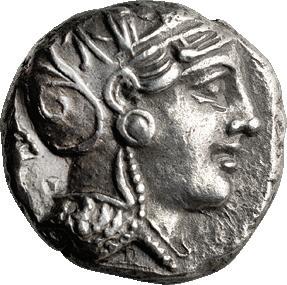

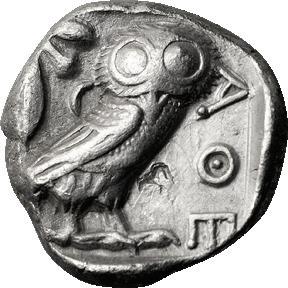




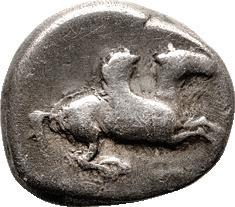

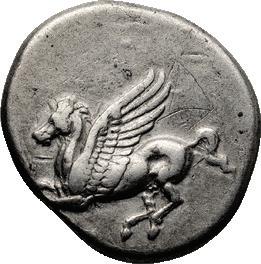
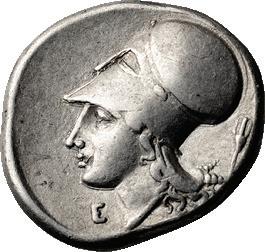
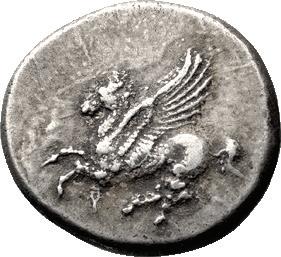
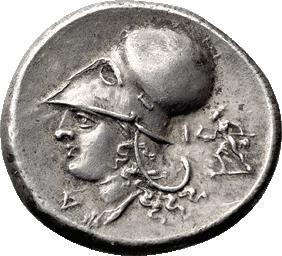

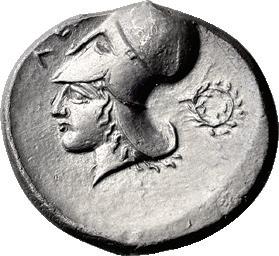
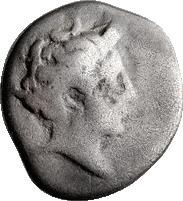

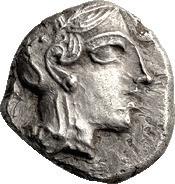
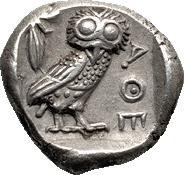
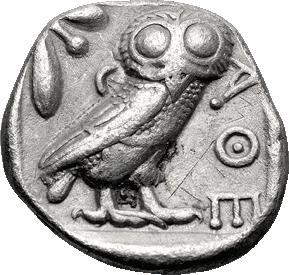


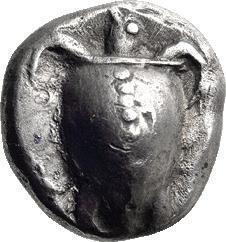
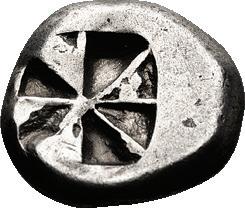


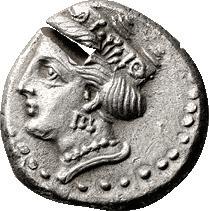



Timolas as magistrate. Bee, Ε-Φ across fields. Rx: Forepart of stag right, head left; palm tree to left, ΤΙΜΟΛΑΣ to right. Some strong corrosion in reverse field; dark toning. aVF 1000
232. IONIA, MILETOS; c. 340-325 BC, Hemidrachm, 1.32g. SNG Cop-967. Obv: Laureate head of Apollo l. Rx: Lion standing l., looking back at star; monogram to l. Ex CNG E572, 9 October 2024, lot 306. VF 900
233. CARIA, RHODES; 394-304 BC, Didrachm, 6.58g. BMC-Caria, Pl. XIV, 5; HGC 6, 1437; SNG Copenhagen-731; SNG von Aulock-2793; Müller-705; Cohen-111. Obv. ³⁄₄ Facing head of Helios r. Rx. Rose with bud r. and grape cluster l. - ΡΟΔΙΩΝ above [E]-Y below. The design incorporates a pun on the city’s name: Ῥόδος (Rhodes) is derived from ῥόδον (rhódon), meaning “rose,” which is reflected in the coin’s imagery. The Graff Collection, 1992. High relief. VF 600 Dynasty Lycia
234. LYCIAN; 480-460 BC, 1/3 Stater Tetrobol, 2.85g. Traite-157, pl. XCII, 18, BMC(cf. 45, Stater). Obv. Boar standing facing l. Rx. Triskeles in recessed square. Light porosity. aEF 450
235. PAMPHYLIA, ASPENDUS; ca. 465-430 BC, Stater, 10.28g. SNG Cop- SNG France 13. SNG BN-12. Obv: Helmeted hoplite warrior advancing right, shield in left hand, spear in right. Rx: Triskeles set on lion walking left. Ex Numismatik Naumann 116, 1 May 2022, lot 447 Well-centered obverse. gVF / EF 900
236. CITIUM, BAALMELEK II; ca. 425-400 BC, Stater, 10.82g. Dewing-2521, SNG Copenhagen-, BMC-VSL 40, RRP-485. Obv: Hercules, r., wearing lion skin and raising club Rx: Lion attacking crouching stag, r. Ex Leu Numismatik AG Web Auction 31, Sept 7 2024, lot 620, formerly in a European collection formed before 2005; Ex Vilmar Numismatics. Hercules obverse is softly struck but better than usual. VF 485
237. PHOENICIA, SIDON; 435-425 BC, 1/16 Shekel, 0.88g. HCG-10, 217. Obv: Galley sailing over waves Rx: King shooting arrow. Test cut in center of reverse, but galley looks perfect. EF / F 200
238. SIDON, NICE; 342-332 BC, 1/16 shekel, Phoenicia, Sidon, 0.74g. Betlyon, MN 21, 38. Obv: Galley l. Rx: Persian king standing r., about to slay erect lion whose mane he seizes; Phoenician letters between. F or better; well-centered and good metal for these. Well-centered and good metal for these. F+ 250 King Azemilkos
239. PHOENICIA, TYRE; King Azemilkos (349-333.32 BC), Year 13=336/5 BC, Didrachm, 8.76g. HGC-10, 349, Fitz-6085. Obv: Melquart riding hippocamp over waves; dolphin below Rx: Owl, r., head facing; crook and flail behind. VF / F 500 Reign of Caligula
240. PHOENICIA, TYRE; Year 163=37-38 AD (Reign of Caligula), Shekel, 13.27g. HGC-357, RPC-Online 4695A but with different monogram under KP. Obv: Laureate head of Melqart r. Rx: Eagle l., palm branch on shoulder; ΡΞΓ(date) in l. field above club, KP and monogram in r. field, Phoenician letter between legs. Rare with only 2 specimens in RPC and unlisted with this symbol combination. This late issue is quite rare, with only two coins in RPC. Isolated obverse porosity. VF / EF 1500
241. SYRIA, SELEUCUS I, 312-281 BC, TYPES OF ALEXANDER III THE GREAT; Laodicea, early 3rd century BC, Tetradrachm, 16.98g. SC-5. Obv: Head of young Herakles r. in lion headdress. Rx: ΣΕΛΕΥΚ[ΟΥ] on r., ΒΑΣΙΛΕΩΣ in exergue; Zeus seated l., holding eagle and scepter; dolphin and monogram MP in wreath in l. field, monogram below throne. aEF / VF 750 242. SYRIA, SELEUCUS I; 312-280 BC. Ai Khanoum, from c. 285 BC, Drachm, 3.79g. Cf. SC-273. Obv: Laureate head of Zeus r., dotted border. Rx: [ΒΑΣΙΛΕΩΣ] on l., ΣΕΛΕΥ[ΚΟΥ] in exergue, Athena in elephant quadriga r., brandishing spear and shield, A O monogram and anchor above elephants, dotted border. aVF 250
243. SYRIA, SELEUCUS I; Babelon, c. 306-281 BC, 1/8 Stater, 1.74g. SC-90. Obv: Ba’al enthroned l., holding scepter. Rx: Lion walking l., head reverted, anchor above (Seleucid symbol). Ex CNG 41, 19 March 1997, lot 657. F / VF 200 244. SYRIA, SELEUCUS I; Seleucia on the Tigris, after 296/5 BC, Drachm, 4.06g. SC140.2. Obv: Head of young Heracles r. in lion-skin headdress. Rx: ΣEΛEY[KoY] on r., Zeus seated l., holding eagle and scepter; anchor with flukes upward in l. field, dot within circle under throne. aEF 600
Seleucid Kingdom
245. SYRIA, SELEUCUS I (312-281 BC); Susa mint, ca. 305/4-295 BC. Tetradrachm, 17.14g. Lorber-195. Obv. Head of hero right, wearing helmet covered with panther skin and adorned with bull horns and ear, panther skin tied around neck; dotted border. Rx. BAΛΣΙΛΕΩC / ΣΕΛΕΥΚΟΥ, Nike standing left, facing right and crowning trophy built on tree trunk; two monograms at bottom (ΠΥΙ in right field between Nike and trophy; other monogram below left wing). This coin shows Seleucus as a hero. Several of these coin have recently come into the market, making it possible for us to offer this coin at this highly desirable price. gEF 6000
246. SYRIA, SELEUCUS I; Susa, c. 305/4-295 BC, Obol, 0.57g. SC-176. Obv: Head of helmeted hero r., assimilating Seleucus, Alexander, and Dionysus. Rx: King’s name in Greek, mostly illegible; Nike standing r., crowning trophy. F 175 247. SELEUCID, ANTIOCHUS I; Probably Ai Khanoum, Drachm, 3.96g. SC-431.3. Obv: Diademed head of Antiochus I r., with elderly features. Rx: BAΣIΛEΩΣ on l., [ANTIoXoY] in exergue, horned and bridled horse head r., with flamelike forelock; before horse’s neck, control Δ within circle. F / VF 500
248. SYRIA, SELEUCUS III; Tetradrachm, 16.83g. SC-921.1. Obv: Diademed head of Seleucus III r., with long sideburn. Rx: [B]AΣΙΛΕΩ[Σ] on r., [Σ]ΕΛE - ΥΚοΥ on l., Apollo seated l. on omphalos, testing arrow and resting l. hand on grounded bow, between monograms in outer l. and outer r. fields. aVF 300
249. SYRIA, ANTIOCHUS III; Antioch, Tetradrachm, 16.74g. SC-1044.1. Obv: Diademed head of Antiochus III r. Rx: BAΣΙΛΕΩΣ on r., ANT - IoXoΥ on l., nude Apollo seated l. on omphalos, testing arrow and resting l. hand on grounded bow, control mark inverted Ω above P in outer l. field . Toned VF 400
250. SYRIA, ANTIOCHUS III; Series 2, Late in Reign, Drachm, 3.71g. SC-1136a. Obv: Diademed head of king r. Rx: ΒΑΣΙΛΕΩ[Σ] above, ANTIOX[OY] in exergue, Elephant walking r., control mark ΕΣ before elephant’s head (mainly off flan). F 300 Gorgon in Spread Aegis
251. SYRIA, ANTIOCHUS IV; Hemidrachm, 1.87g. SC-1405. Obv: Radiate, diademed
head of king r. Rx: [BAΣIΛEΩΣ] / ANTIoXo[Y] on r., OEoY / EΠIΦANoY[Σ] on l., Spread aegis with gorgoneion in center. This issue is very rare, and not usually seen with such a beautiful reverse. Toned aEF 1000
252. SYRIA, DEMETRIUS I; Antioch, Tetradrachm, Year 161=152/1 BC, 16.70g. SC1641.6. Obv: Diademed head of king r., without legend, laurel wreath border. Rx: BAΣIΛEΩΣ on r., ΔHMH - TPIοY / [ΣΩ]T - HPo[Σ] on l., Tyche, draped, seated l. on backless throne with winged tritoness support, holding short scepter and cornucopia; date AΞP in exergue, two control monograms in outer l. field are off flan. VF 350 253. SYRIA, ALEXANDER I; Seleucia on the Tigris, Tetradrachm, 15.84g. Cf. SC-1858.3. Obv: BAΣI[ΛEΩΣ] / AΛEXAN[ΔPoY] on r., OEoΠATo[PoΣ] / EYEPΓE[ToY] on l., Zeus enthroned l., resting on scepter and holding Nike facing r., offering wreath. In exergue, uncertain letters or monogram. VF 375 254. SYRIA, ANTIOCHUS VI; Hemidrachm, 1.74g. SC-2004. Obv: Diademed radiate head r. Rx: ΒΑΣΙΛΕΩΣ / ΑΝΤΙΟΧΟΥ (above), EΠΙΦΑΝΟΥΣ / [ΔΙΟΝΥΣΟΥ] (below), panther standing l., foreleg raised, broken spear in mouth, ΣΤΑ in field above panther’s tail. Flan crack at 3:00 on obverse; some porosity. gVF 200 255. SYRIA, ALEXANDER II, 128-122 BC; Hemidrachm, 1.97g. SC-2225. Obv: Diademed head of king r. Rx: BAΣIΛEΩΣ on r., AΛEXAN[ΔPoY] on l., Cornucopia. Controls: uncertain monogram on outer l.; A on inner l. (not I/A, since the possible I above the A seems to be just one of the two bunches of grapes hanging down from the rim of the cornucopia). Toned EF 250 GREEK BRONZE
256. SPAIN, CASTULO; Early 1st cent. BC, AE 19, 7.83g. SNG BM-1386, SNG Cop-225. Obv: Bare male head l.; on l. before portrait, Iberian inscription M.BAL.F downwards, with AL ligate. Rx: Bull standing r., head facing; above, Iberian inscription [M].Q.F. VF 125
257. ANONYMOUS, SPANISH IMITATION; c. 1st century BC, Semis, 4.42g. cf Cr56/3. Obv: Head of Saturn r., S behind. Rx: Prow l., S above, ROMA retrograde below. Clearly, the obverse and reverse dies are the products of different engravers, as the obverse is oriented correctly, while both the prow and the legend on the reverse are retrograde. aVF 400
258. BRUTTIUM, BRUTTI; c. 211-208 BC, AE 20, 7.41g. HN Italy-1988, SNG ANS107, SNG Cop-1658. Obv: Laureate head of Zeus r., thunderbolt behind. Rx: Naked warrior advancing r., holding shield and spear; bucranium in lower r. field. Ex de Falco, Naples, with old ticket. flat strike at lower part of obverse. Near MS 525 259. SICILY, PANORMUS; after 241 BC, AE 17, 4.40g. Calciati-3, Lindgren-521. Obv: Veiled head of Homonoia r. Rx: Cornucopia. Ex Munzen & Medaillen De 16, 19 May 2005, lot 39. Ex J. P. Righetti Collection. gVF
250 260. SICILY, PETRA HEMILITRON; c. 354-344 BC, Hemilitron, 25.15g. Calciati-1. Obv: Head of Zeus r. Rx: Aphrodite seated r., holding dove. Very scarce city. Coins issued from this city are very scare, and this is a rather exceptional large issue. Dies made by a crude Celator. aVF 875
261. CAMPANIA, NEAPOLIS; c. 325-320 BC, AE 16, 6.34g. HN Italy-568. Obv: Laureate head of Apollo r. Rx: Forepart of man-headed bull r. F / VF 150
262. SICILY, SYRACUSE; 344-336 BC, Time of Timoleon, Hemilitron, 16.58g. Calciati-72, BMC-313, Sear-1192. Obv: Laureate and bearded head of Zeus Eleutherios l. Rx: Thunderbolt; eagle in r. field. EF 485
263. SICILY, SYRACUSE, TIME OF AGATHOKLES, 317-289 BC; Struck c. 310-305 BC, AE 17, 4.90g. Calciati-85, SNG ANS-644. Obv: Head of Apollo l. Rx: Pegasus flying l., Δ below. VF 100
264. SICILY, SYRACUSE, AGATHOKLES, 317-289 BC; AE 20, 7.98g. BM422, Sear 1200, SNG Cop-779, Calciati-142. Obv: Bust of Artemis r. Rx: Winged thunderbolt. EF 175
265. SICILY, SYRACUSE, TIME OF AGATHOKLES, 317-289 BC; Struck c. 295289 BC, AE 20, 7.82g. BM-422, SNG Cop-779, Calciati-142. Obv: Bust of Artemis r. Rx: Winged thunderbolt. VF / EF 250 Sardinia
266. ZEUGITANA, CARTHAGE; Sardinian Mint, c. 216 BC, AE 17, 4.77g. SNG Cop387. Obv: Head of Tanit l. Rx: Bull standing r., star above. Choice EF 200 JEWISH BRONZE Herod III Antipas
267. JUDEA, HEROD III ANTIPAS (4 BCE-39 CE); Tiberias, RY 43=39/40 CE AE unit (full denomination), 12.36g. Hendin-6246, Meshorer-91, RPC-I 4934. Obv. ΓAIΩ KAICAP ΓEPMA NIKΩ (for Gaius Caesar Germanicus) in four lines within wreath. Rx. HPWΔHC TETPAPXHC (Herod the Tetrarch), ETO CMΓ (year 43), seven-branched palm tree with two date clusters. Struck for Roman Emperor Gaius (Caligula). Rare. EF 2500 Herod III Antipas
268. JUDAEA, HEROD III ANTIPAS 4 BC - 39 AD; Year 34=30/1 AD, Tiberias AE Unit, 12.27g. Hendin-6238. Obv. TIBЄ/PIAC in two lines within wreath. Rx. HPWΔOY TЄTPAPXOY, L ΛΔ (year 34) flanking, palm branch upright. Rare. EF 2500 Agrippa II
269. JUDEA, AGRIPPA II, WITH CLAUDIUS 49/50-94/95 CE; YR 13=53/54 CE, Tiberias AE 4 units, 11.05g. Hendin-6297, RPC I-4852. Obv. TIBE/PIAC within wreath. Rx. KΛAYΔIOY KAICAPOC, L IΓ (year 13) across field; palm branch upright. Rare. EF 2500
270. JUDEA, FIRST JEWISH WAR 66-70 AD; Jerusalem ca. 69-70 AD. 1/8 Shekel, 4.50g. Mildenberg-115; Hendin-6398, Meshorer-214. Obv. (Paleo-Hebrew, “Year Four”), lulav bunch flanked by an etrog on either side. Rx. (‘To the redemption of Zion,’ in Proto-Hebrew), chalice with pearled rim. Ex. Numismatik Naumann GmbH, Auction 148, Jan 2025. Virtually MS 575
271. BAR KOKHBA REVOLT -- THE SECOND JEWISH REVOLT; Jerusalem, Year 2 = 133/4 AD Middle Bronze, 11.87g. Hendin-6436, Mildenberg-71 (O5/R35); TJC 260a. Obv. (Paleo-Hebrew, “ShMA”) – Double meaning: “Hear” (Shema) or abbrev. for Simon (Bar Kokhba); seven-branched palm tree with two bunches of dates. Rx. (Paleo-Hebrew, “Shin-Bet” abbrev. for “Year 2”) – “Year Two of the Freedom of Israel;” vine leaf on tendril. Ex. Ira & Larry Goldberg Auctioneers, Sale 142, Lot 446 Oct 2024. EF 575
272. JUDEA, BAR KOKHBA REVOLT (SECOND JEWISH WAR) 132-135 AD; Jerusalem, Year 3 = 34/5 AD Middle Bronze, 11.00g. Hendin-6464; Mildenberg-105. Obv. - Paleo-Hebrew, “Shimon” – abbrev. for “Shimon” [Simon Bar Kokhba]; sevenbranched palm tree with two bunches of dates. Rx. (Paleo-Hebrew, “For the freedom of Jerusalem”) – “Shin-Gimel” for “Year 3” – “Year Three of the Freedom of Jerusalem;” vine leaf on tendril. Ex. Sternberg Auction XXVI, Lot 163, 1992. EF 750
273. JUDEA, BAR KOKHBA REVOLT (SECOND JEWISH WAR) 132-135 AD; Jerusalem, Year 3 = 34/5 AD. Middle Bronze, 9.80g. Mildenberg-114 (O10/R78), SNG ANS-569 (same dies). Obv. (Paleo-Hebrew, “Shimon” - for “Shimon” [Simon Bar Kokhba]); seven-branched palm tree with two bunches of dates.Rx. (PaleoHebrew, “For the freedom of Jerusalem”) – “Shin-Gimel” for “Year 3” – “Year Three of the Freedom of Jerusalem.” Five-lobed vine-leaf with strongly accentuated ribs, hanging from curved branch, short tendril right. No die flaws. Ex CNG eAuctions 577, Lot 191, Dec 2024. VF 425
274. BAR KOKHBA REVOLT (SECOND JEWISH WAR) 132-135 CE; Year One = 132/3 CE, AE middle bronze, 6.56g. Hendin-6406. Obv: (‘Shimon Prince of Israel’ - proto-Hebrew), palm branch within a wreath. Rx: (‘year one for the redemption of Israel’), wide lyre (nevel or chelys) of six (sometimes four or five) strings. Rare. Exceptional quality, wonderfully centered. Choice EF 2500 ROMAN REPUBLICAN SILVER
275. L. JULIUS; 141 BC, Denarius, 3.93g. Cr-323/1, Syd-585, Julia-3. Obv: Helmeted head of Roma r., wheat ear behind. Rx: Victory in biga r., L IVLI below. aVF 145
276. SEX. POMPEIUS FOSTLUS; 137 BC, Denarius, 3.93g. Cr-235/1c, Pompeia 1a, Syd-461a. Obv: Helmeted head of Roma r., X below chin, jug behind. Rx: SEX PO FO[STLVS] She-wolf r. suckling Twins, shepherd Faustulus on l., birds in tree behind, [RO]MA in exergue. gVF 325
277. CN. DOMITIUS AHENOBARBUS; 128 BC, Denarius, 3.91g. Syd-514, Cr261/1, Domitia 14. Obv: Helmeted head of Roma r., wheat ear behind, mark of value before. Rx: Victory in biga r., holding whip; below, man fighting lion; ROMA above horses, CN DOM in exergue. Toned VF 265
278. L. CAECILIUS METELLUS DIADEMATUS; 128 BC, Denarius, 3.89g. Cr262/1, Syd-496, Caecilia 38. Obv: Head of Roma r., mark of value behind. Rx: Pax in biga r., elephant’s head with bell around neck and ROMA below. EF 295
279. CN. BLASIO CN.F.; 112-111 BC, Denarius, 3.62g. Cr-296/1h. Obv: Helmeted head r. (Scipio Africanus?), palm branch behind. Rx: Jupiter standing between Juno and Minerva, BLA monogram in field. Scarcer variety with BLA. Toned VF 300
280. C. CLAUDIUS PULCHER; 110-109 BC, Denarius, 3.93g. Cr-300/1, Syd-569, Claudia 1. Obv: Helmeted head of Roma r., without legend. Rx: Victory in biga r., C PVLCHER in exergue. Toned EF 325
281. L. FLAMINIUS CHILO; 109/8 BC, Denarius, 3.95g. Cr-302/1, Syd-540, Flaminina 1. Obv: Head of Roma r., X below chin, ROMA behind. Rx: Victory in biga r., L FLAMINI below, CILO in exergue. Toned MS 325
282. L. SCIPIO ASIAGENUS; 106 BC, Denarius, 3.46g. Cr-311/1d, Syd-576b, Cornelia 24. Obv: Head of Jupiter l. Rx: Jupiter in quadriga r., pellet over B above horses. VF 175
283. C. COELIUS CALDUS; 104 BC, Denarius, 3.84g. Cr-318/1b, Syd-582a, Coelia 3. Obv: Helmeted head of Roma l. Rx: Victory in biga l., CALD below horses, dot I in exergue. Toned VF 200
284. Q. THERMUS M.F.; 103 BC, Denarius, 3.81g. Cr-319/1, Syd-592, Minucia 19. Obv: Head of Mars l. Rx: Two warriors fighting, the one on the l. protects fallen comrade, the other wears horned helmet; Q THERM M F in exergue. VF 265
285. Q. THERMUS M.F.; 103 BC, Denarius, 3.98g. Cr-319/1, Syd-592, Minucia 19. Obv: Head of Mars l. Rx: Two warriors fighting, the one on the l. protects fallen comrade, the other wears horned helmet; Q THERM [M F] in exergue. Toned aEF
300
286. C. FABIUS C.F. HADRIANUS; 102 BC, Denarius, 3.92g. Cr-322/1a, Syd-589, RSC-Fabia-15. Obv: Head of Cybele r., K behind. Rx: Victory in biga r., stork before, C FABI C F in exergue. Toned EF 265
287. P. SERVILIUS M.F. RULLUS; 100 BC, Denarius, 3.81g. Cr-328/1, Syd-601, Servilia 14. Obv: Bust of Roma l., wearing Corinthian helmet and aegis; RVLLI behind. Rx: Victory in biga r., P below horses; in ex.,[ P.] SERVILI M.F. Toned EF 250
288. L. CAECILIUS METELLUS; 96 BC, Denarius, 3.90g. Cr-335/1b, Syd-611a, Caecilia 45. Obv: Head of Apollo r., star below, L METEL behind, A ALB SF before. Rx: Roma seated l. on pile of shields; Victory stands behind, crowning her; C MALL on l., [R]OMA in exergue. VF 195
289. M. CATO; 89 BC, Quinarius, 1.98g. Cr-343/2a, Syd-596 var. Obv: Head of Liber r., M CATO behind. Rx: Victory seated r., holding patera; VICTRIX in exergue. Scarce without obverse control; missing in Sydenham. Fine 110
290. MN. FONTEIUS C.F.; 85 BC, Denarius, 3.83g. Cr-353/1a, Syd-724, Fonteia 9. Obv: Laureate head of Vejovis r., monogram below chin, thunderbolt below head, MN FONTEI C F behind. Rx: Infant winged genius seated on goat r., caps of the Dioscuri above, thyrsus below, all within laurel wreath. Toned VF 250
291. L. FARSULEIUS MENSOR; 75 BC, Denarius, 3.80g. Cr-392/1a, Syd-789a, Farsuleia 1. Obv: Diademed, draped bust of Liberty r., S C below chin, MENSOR before, cap of Liberty and control numeral LXXX behind. Rx: Roma in biga r., assisting togate figure to mount into chariot, scorpion below horses’ feet, L.FARSVLEI in exergue. Toned aEF 450
292. L. SCRIBONIUS LIBO; 62 BC, 62 BC, Denarius, 3.90g. Cr-416/1a, Syd-928, Scribonia 8a. Obv: BON EVENT before diademed head of Bonus Eventus r., Libo behind, Rx: PVTEAL above well-head ornamented with two lyres, hammer and festoons, SCRIBON in exergue. Toned EF 325
293. M. AEMILIUS SCAURUS AND PUB. PLAUTIUS HYPSAEUS; 58 BC, Denarius, 3.79g. Cr-422/1b, Syd-913, Aemilia 8. Obv: Kneeling figure (King Aretas of Nabataea) holding reins of camel; [M SCAVR/AED]CVR above, [EX] on l., S C on r.; [RE]X ARETAS in exergue. Rx: Jupiter in quadriga l.; P HYPSAE / AED CVR above; CAPT V on r., C HYPSAE COS PREIV in exergue; scorpion below horses.
Toned EF
300
294. M. AEMILIUS SCAURUS AND PUB. PLAUTIUS HYPSAEUS; 58 BC, Denarius, 3.85g. Cr-422/1b, Syd-913, Aemilia 8. Obv: Kneeling figure (King Aretas of Nabataea) holding reins of camel; M SCAVR / AED CVR above, [EX] on l., S C on r.; [REX] ARETAS in exergue. Rx: Jupiter in quadriga l.; P HYPSAE / AED CVR above; CAPT V on r., C HYPSAE COS PREIV in exergue; scorpion below horses. Toned aEF 250
Exquisite Example
295. P. CORNELIUS LENTULUS MARCELLINUS; 50 BC, Denarius, 3.83g. Cr439/1, Syd-1147, RSC Claudia-11. Obv: Head of the consul M. Claudius Marcellinus r., MARCELLINVS before, triskeles behind. Rx: M. Claudius Marcellinus carrying trophy within tetrastyle temple, MARCELLVS on r., COS QVINQ on l. Ex CNA IX, 7 December 1989, lot 335. While this coin is only considered scarce, it rarely comes in this quality. EF 3850
296. MAN. ACILIUS GLABRIO; 49 BC, 49 BC, Denarius, 3.94g. Cr-442/1a, Syd-922, Acilia 8. Obv: Laureate head of Salus r., SALVTIS upward behind. Rx: Valetudo standing l., leaning on column and holding snake, MN ACILIVS III VIR VALETV behind and before. VF 150
297. T. CARISIUS; 46 BC, Denarius, 3.79g. Cr-464/3a, Carisia 4, Syd-984b, Sear, Imperators-71a. Obv: Head of Roma r.in Attic helmet, ROMA behind, Rx: Cornucopia on celestial globe between scepter and rudder, T CARISI below, all in wreath. EF 425 ROMAN IMPATORIAL SILVER
298. JULIUS CAESAR; Military Mint, 49-48 BC, Denarius, 3.86g. Cr-443/1; Syd-1006; Sear, Imperators-9. Obv: Elephant r. trampling serpent, CAESAR in exergue. Rx: Pontifical emblems: ladle, sprinkler, ax with lion’s head mounted on handle above blade, apex (priest’s hat). Exceptional. MS 2950
299. JULIUS CAESAR; Military Mint, 49-48 BC, Denarius, 3.83g. Cr-443/1,; Syd1006; Sear, Imperators-9. Obv: Elephant walking r., trampling serpent, CAESAR in exergue. Rx: Pontifical emblems: ladle, sprinkler, ax with lion’s head mounted on handle above blade, apex (priest’s hat). Clear name. F 400
300. JULIUS CAESAR; 47-46 BC, Denarius, 3.88g. Cr-458/1, Syd-1013, Sear, Imperators-55. Obv: Head of Venus r. Rx: Aeneas l. carrying palladium and Anchises; CAESAR behind. Formerly encapsulated, NGC 6708988-010. strike 5/5, surfaces 3/5. EF 2250
301. JULIUS CAESAR; 47-46 BC, Denarius, 3.92g. Cr-458/1, Syd-1013, Sear, Imperators-55. Obv: Head of Venus r. Rx: Aeneas l. carrying palladium and Anchises; CAESAR behind. EF / VF 1350
302. JULIUS CAESAR; 46 BC, Denarius, 4.01g. Cr-467/1b, Syd-1024, Sear Imperators57a. Obv: COS TE[RT] - [DI]CT ITER Head of Ceres r. Rx: AVGVR above, [PO]NT MAX below, Ladle, sprinkler, pitcher, and lituus; M in r. field. EF 1650
303. L. VALERIUS ACISCULUS; 45 BC, Denarius, 3.51g. Cr-474/1b, Syd-998a, Valeria 16, Sear, Imperators-90a. Obv: Head of Apollo r., hair tied with band, [star] above, ACISCVLVS and pickaxe behind. Rx: Europa seated on bull r., holding with both hands veil billowing above her head; L VALER[IVS] in exergue. Toned MS 875
Cleopatra and Antony
304. CLEOPATRA AND MARK ANTONY; c. 36 BC, Tetradrachm, 14.14g. RPC4094 (43 spec., 21 obv. dies). Obv: [BACIΛIC]CA KΛEOΠATPA ΘEA NEW[TEPA] Diademed, draped bust of Cleopatra r. Rx: ANTWNIOC AYTOKPATW[P TPIT]ON TPIWN A[NΔPWN] Bare head of Antony r. This coin displays relatively powerful portraits of both Antony and Cleopatra. Microscopic porosity in field. Toned gVF 12500 ROMAN IMPERIAL SILVER
305. AUGUSTUS; 27 BC-14 AD, c. 36-31 BC, Denarius, 3.44g. BM-617, Paris-98, RIC264, C-115. Obv: Victory on prow r., holding wreath and palm; no legend. Rx: IMP CAE[SAR] in exergue, Octavian holding branch and reins in triumphal quadriga r. Fine 300
Aegypto Capta
306. AUGUSTUS; 27 BC-14 AD, 28 BC, Denarius, 3.65g. BM-650, Paris-906, C-2 (25 Fr.), RIC-275a. Obv: CAESAR - COS VI Head bare r., lituus behind. Rx: AEGYPTO / CAPTA (“Egypt Captured”) Crocodile standing r. with jaws open. Rare: only 22 specimens from 10 obverse and 11 reverse dies catalogued by Sutherland, Octavian’s Gold and Silver Coinage from c. 32 to 27 BC, Quaderni ticinesi 1976, pp. 139-40, unfortunately with an illustration of only one piece, not every die. VF 3850
307. AUGUSTUS; 27 BC-14 AD, Spanish Mint, c. 19-18 BC, Denarius, 3.46g. BM-334, Paris-1311, C-294, RIC-42a. Obv: CAESAR - AVGVSTVS Head bare r. Rx: Round shield inscribed S.P.Q.R / CL.V in two lines. Coin repaired from chip at 5:00. Toned EF 350
308. AUGUSTUS; 27 BC-14 AD, Lugdunum, 2 BC-4 AD, Denarius, 3.74g. BM-519, C-43, Paris-1651, RIC-207. Obv: CAESAR AVGVSTVS - DIVI F PATER PATRIAE Head laureate r. Rx: [C L C]AESAR[ES] in exergue, [AVG]VSTI F COS DESIG PRINC IVVEN[T] around, Gaius and Lucius Caesars standing holding honorary shields and spears, ladle and lituus above. Toned EF 800
309. TIBERIUS; 14-37 AD, Lugdunum, Denarius, 3.74g, RIC pp. 94-5. Obv: TI CAESAR DIVI AVG F AVGVSTVS, Laureate head of Tiberius r. Rx: PONTIFMAXIM Livia as Pax seated r., holding branch and spear or scepter. Toned VF 600
310. TIBERIUS; 14-37 AD, Lugdunum, Denarius, 3.68g. RIC-28, BM-45, C-16 (2 Fr.). Obv: TI CAESAR DIVI - [AVG F AVGVS]TVS Head laureate r. Rx: PONTIFMAXIM Livia seated r. holding spear with point downwards and branch, throne legs ornamented, two lines beneath throne. Toned VF 750
311. TIBERIUS AND DIVUS AUGUSTUS; Alexandria, Year 20 =33/34 AD, Billon Tetradrachm, 12.83g. RPC-5097 (7 spec.). Obv: TIBEPIOΣ ΚΑΙΣΑP
Laureate head of Tiberius r., date LK before neck. Rx: ΘEOΣ - ΣEBAΣTOΣ on r. and l., Radiate head of Divus Augustus l. Ex Joel Malter. Ex Lanz. Ex Peter Lowrek Collection. Possibly finest known. Mint State 3000 Magnificent Early Portrait
312. NERO; 54-68 AD, Lugdunum, 56-7 AD, Denarius, 3.56g. Cf. RIC-12 (R2) and BM14. Obv: NERO CAESAR AVG IMP Bare head r. Rx: [PO]NTIF MAX TR [P P III P P] around oak wreath enclosing EX S C. The tribunician number on the reverse is not


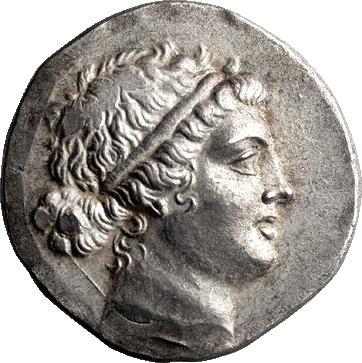
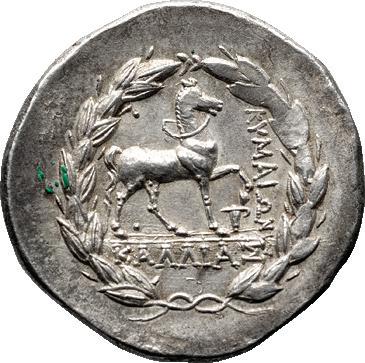



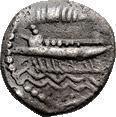

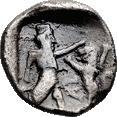
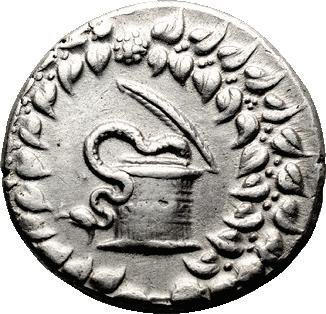
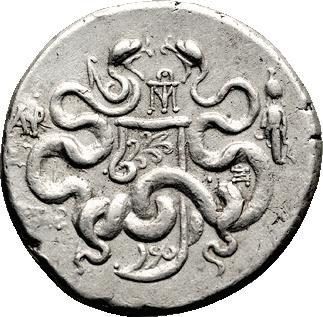




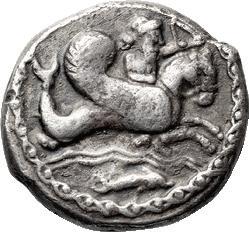

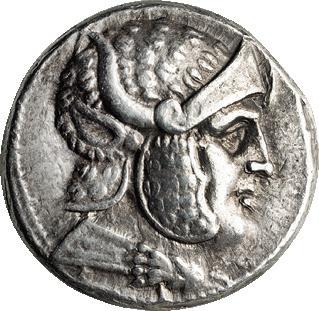
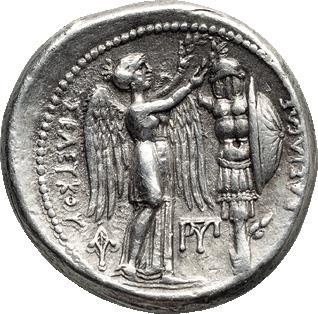

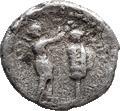




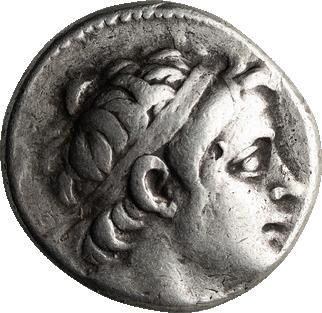

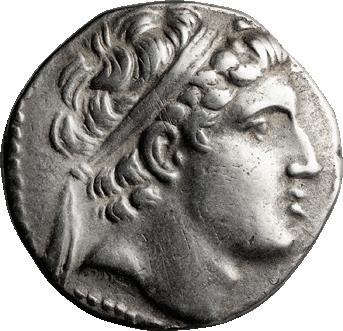


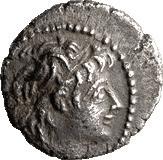
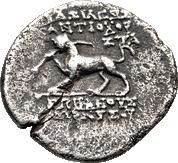
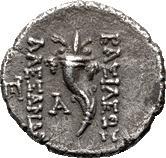
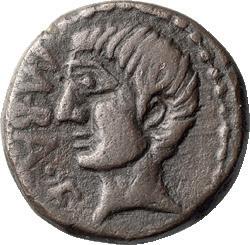


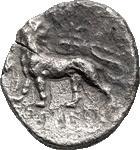
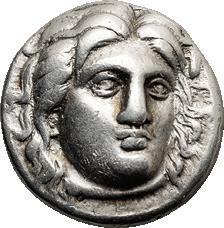

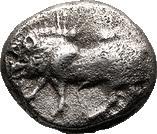
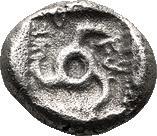


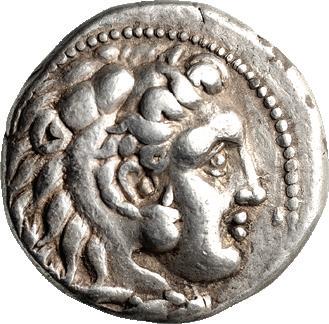



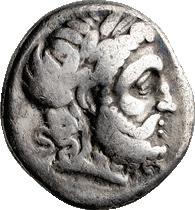
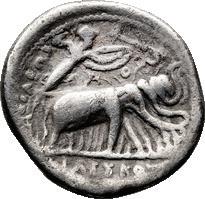







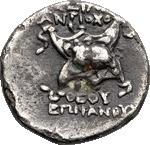

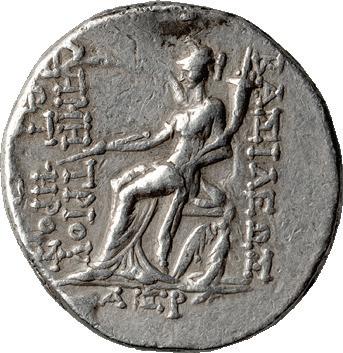
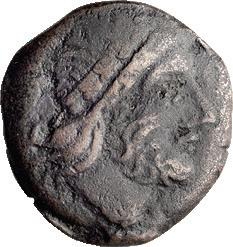

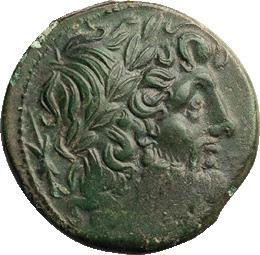

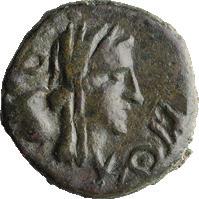
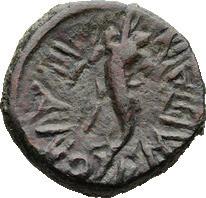
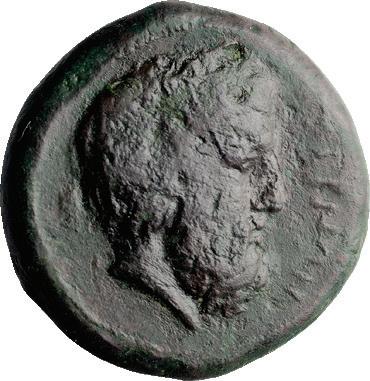
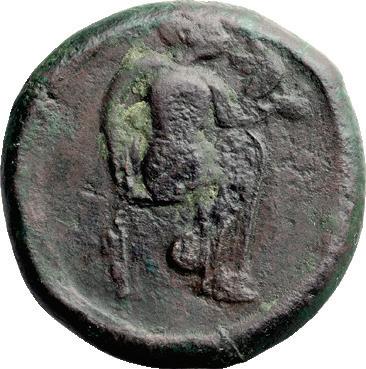





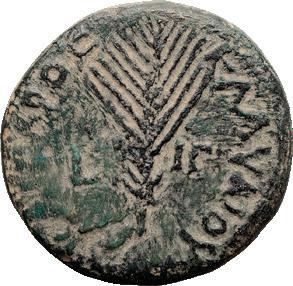
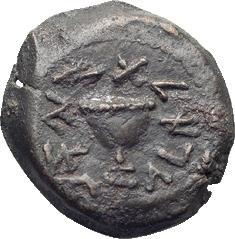
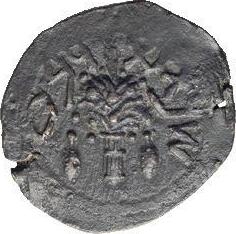


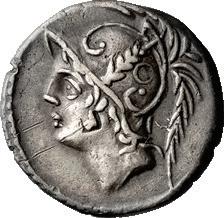

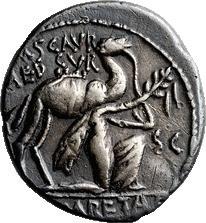


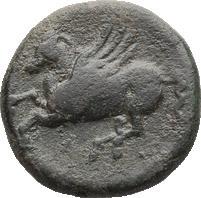


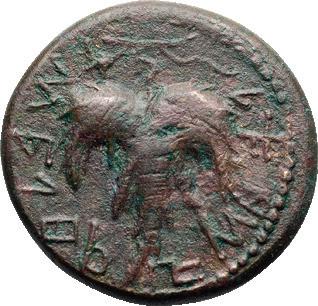


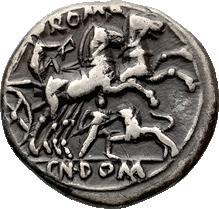
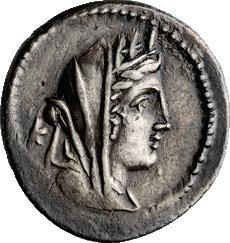

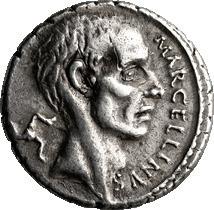


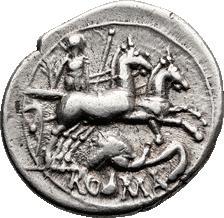
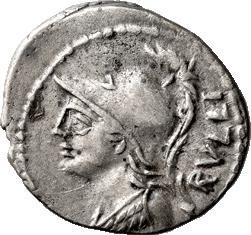
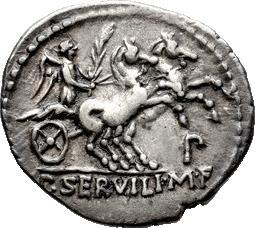
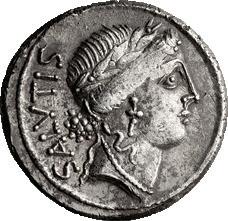

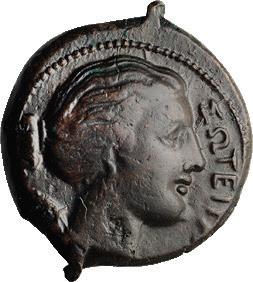
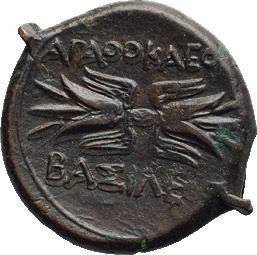
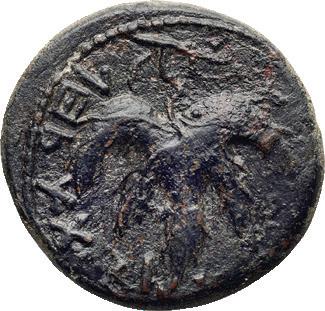




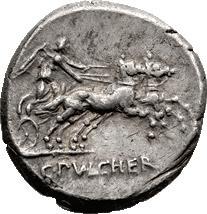


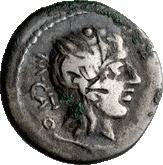

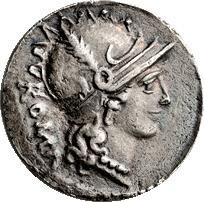
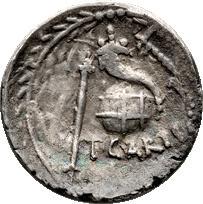

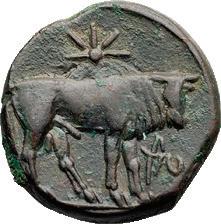
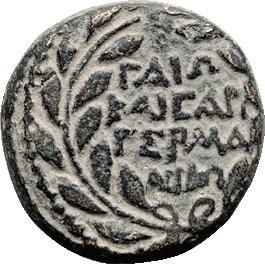



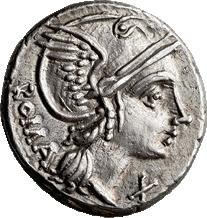
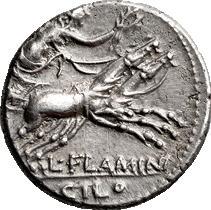
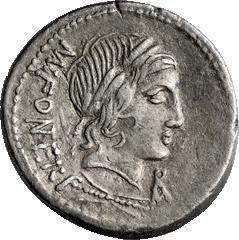
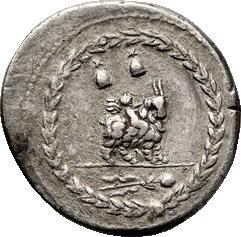


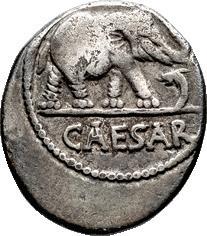
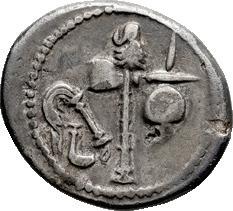

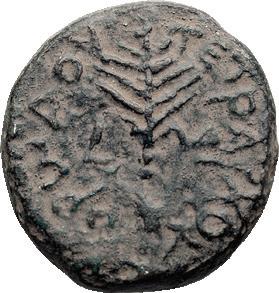


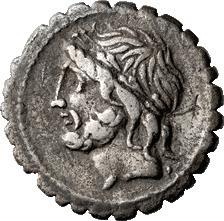
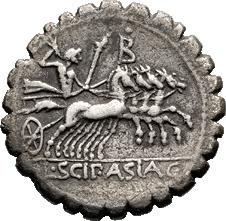
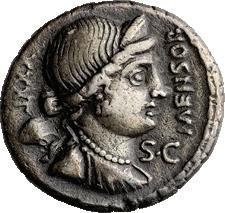
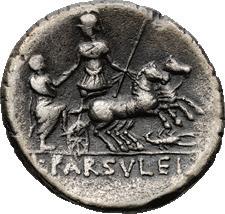

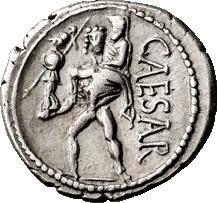
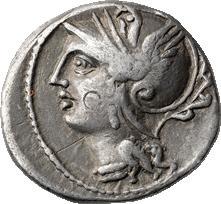
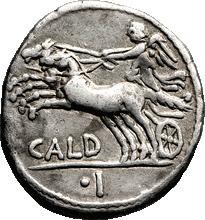

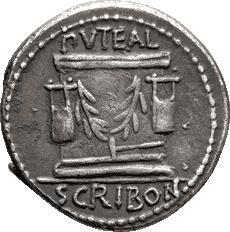
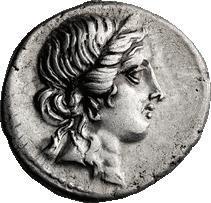

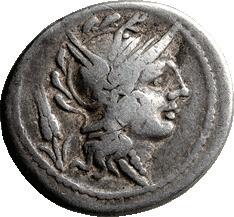

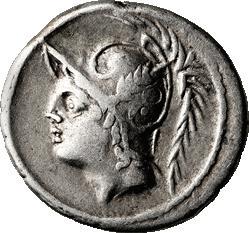
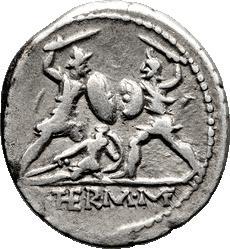


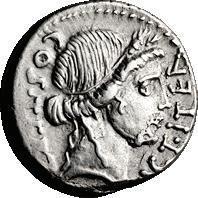

clearly legible. Previously in NGC holder, graded Ch XF, 4/5, 3/5. Ex HJB 121st Buy or Bid Sale, 10 July 2001, lot 316. MS 6500
313. NERO AND POPPAEA; 54-68 AD, Rome, 64-5 AD, Denarius, 3.86g. BM-54, pl. 39.12. Obv: NERO CAESAR - AVGVSTVS Head laureate r. Rx: AVGVSTVS - AVGVSTA Nero and his consort, probably Poppaea, standing l. beside each other; Nero is togate and radiate and holds patera and scepter; Poppaea is draped and veiled and holds patera and cornucopia. A scarce reverse type; there were only three such coins among the 102 denarii of Nero in the Reka Devnia hoard. Toned VF 600 Nero and Poppea
314. NERO; 54-68 AD, Rome, 64-5 AD, Denarius, 2.75g. RIC-45; BM-54, pl. 39.12; C-43 (10 Fr.). Obv: NERO CAESAR - AVGVSTVS Head laureate r. Rx: AVGVSTVS - AVGVSTA Nero and Poppaea standing l. beside each other; Nero is togate and radiate and holds patera and scepter; Poppaea is draped and veiled and holds patera and cornucopia. Rare: only three such coins among the 102 denarii of Nero in the Reka Devnia Hoard. The figures on the reverse can hardly be Augustus and Livia, since neither is called divine. They must be Nero and his consort, and the issue date of the coin requires that the consort be Poppaea, who was made Augusta when she gave birth to a daughter in 63, and who died in 66. See Mattingly in BMC, p. clxxiii. Flan crack at 6:00. aVF 425
315. NERO; 54-68 AD, Rome, 67-8 AD, Denarius, 3.26g. BM-98, C-316, Paris-241, RIC71 (R). Obv: [IMP NERO CAESAR] - AVG P P Head laureate r. Rx: SALV[S] in exergue, Salus seated l. holding patera in r. hand and resting l. elbow on arm rest of throne. Rare with this latest obverse legend of the reign and SALVS in exergue on the reverse: probably only three specimens in Reka Devnia hoard. Bold Fine 350 Rare Bonus Eventus Reverse
316. GALBA; 68-69 AD, Spain, 68-69 AD, Denarius, 3.27g. BMC-p. 343, pl. 54.1 (Vienna, prob. same dies), C-14 (50 Fr.). Obv: IMPERATO (sic) GALBA Head laureate r. on globe. Rx: [BON] - EVEN Bonus Eventus standing l. holding patera in r. hand and two wheat ears and poppy in l. Ex Curtis L. Clay Collection; ex Palladium List 14 Buy or Bid April 1997, 249, #326. Extremely rare reverse type, missing in the BM. We find no recent sales on Coin Archives. The closing R of IMPERATOR in the obverse legend seems to have been left out by the engraver. Portrait struck in high relief. VF 3400
Quinarius
317. GALBA; 68-69 AD, Lugdunum, Quinarius, 1.57g. BM-244, pl. 5.10; Paris-63, pl. V; C-317 (30 Fr.); RIC-132 (R2); King-1 (18 spec.). Obv: SER GALBA IMP CAESAR AVG P M T P Head laureate r. Rx: VICTORIA - GALBAE AVG Victory standing r. on globe, holding wreath and palm. gVF 585 Exquisite Otho
318. OTHO; 69 AD, Rome, Denarius, 3.59g. BM-17. Obv: IMP M OTHO CAESAR AVG TR P Head bare r. Rx: SECVR - I - TAS P R on l. and r., Securitas standing l. holding wreath and scepter. This coin is about as good as Otho gets, with a complete name, good portrait, and strong reverse. Virtually MS 12500 319. OTHO; 69 AD, Rome, Denarius, 3.19g. BM-9, Paris-24, C-11 (12 Fr.), RIC-20 note. Obv: [IM]P OTHO CAESAR AVG TR P Head bare r. Rx: PONT MAX Ceres standing l. holding wheat ears and cornucopia. Rare second issue of reign, comprising five types all with reverse legend PONT MAX. Fine 700 320. OTHO; 69 AD, Rome, Denarius, 3.12g. BM-19, Paris-11, C-15 (12 Fr.), RIC-10 (R3). Obv: IMP O[THO] CAESAR AVG TR P Head bare r. Rx: [SECVR]I - TAS [P R] Securitas standing l. holding wreath and scepter. Fine 500 321. VESPASIAN; 69-79 AD, Rome, 69-70 AD, Denarius, 2.40g. RIC-2, Hendin-6509. Obv: IMP CAESAR VESPASIANVS AVG, laureate head r. Rx: IVDAEA in exergue, Judaea seated r. in attitude of mourning, with trophy behind her. aF 275 322. VESPASIAN; 69-79 AD, Rome, 73 AD, Denarius, 3.22g. BM-98, Paris-86, C-387, RIC-65. Obv: IMP CAES VESP - AVG CENS Head laureate r. Rx: PONTIFMAXIM Emperor seated r. on curule chair holding scepter and branch. The reverse copies Tiberius’ “tribute penny”, probably because Vespasian was restriking masses of heavier denarii from before Nero’s reform and wanted to preserve a record of some of their famous reverse types on his own denarii. gVF 500
323. VESPASIAN; 69-79 AD, Rome, 74 AD, Denarius, 3.19g. BM-136, pl. 4.2; Paris-110; C-364; RIC-702 (C). Obv: IMP CAESAR - VESPASI[ANVS AVG] Head laureate r. Rx: PON MAX - [T]R P COS V on l. and r., Vespasian , togate, seated r. on curule chair, holding branch and scepter. VF 210
324. TITUS; 79-81 AD, Rome, 79 AD, Denarius, 3.21g. RIC-16 (R2), pl. 84. Obv: IMP TITVS CAES VESPASIAN AVG P M Head laureate l. Rs: TR P VIIII - IMP XIIII - COS VII around, Venus, seen half from behind, naked except for drapery around hips, standing r., resting l. elbow on column, legs crossed, holding helmet in extended r. hand and transverse scepter in l. The scarcity of this issue of aurei and denarii of Titus that still omit P P from his titles after 1 July 79 AD, suggests that he must have accepted that title from the Senate fairly soon thereafter, perhaps even before the end of July. gVF 300
325. TITUS; 79-81 AD, Rome, 79 AD, Denarius, 3.12g. RIC-89 (C); BM-106, pl. 46.18; C-25 (15 Fr.). Obv: IMP TITVS CAES VESPASIAN AVG P M Head laureate r. Rx: BONVS EVENTVS AVGVSTI around, Bonus Eventus standing l. holding patera in r. hand and wheat ears and poppy in l. The only denarius of Titus’ reign with a descriptive legend rather than his imperial titles on the reverse. Scarce: only seven specimens in Reka Devnia hoard. VF 325
326. DOMITIAN; 81-96 AD, Rome, 89 AD, Denarius, 3.17g. RIC-688 (C2), BM-163, Paris-156, C-255. Obv: [IMP] CAES DOMIT AVG - GERM P M TR P VIIII Head laureate r. Rx: IMP XXI COS XIIII CENS P P P Minerva standing l. with spear, l. hand on hip. VF / F 150
327. DOMITIAN; 81-96 AD, Rome, 92-3 AD, Denarius, 3.66g. BM-205, Paris-185, C-279, RIC-741 (C3). Obv: IMP CAES DOMIT AVG - GERM P M TR P XI[I] Head laureate r. Rx: IMP XXII COS XVI CENS P P P Minerva standing l. holding thunderbolt and spear, shield on ground behind her. VF 240
328. DOMITIAN; 81-96 AD, Rome, 93-4 AD, Denarius, 3.07g. BM-218, Paris-193, C-283, RIC-763 (C3). Obv: IMP CAES DOMIT AVG - GERM P M TR P XIII
Head laureate r. Rx: IMP XXII COS XVI CENS P P P Minerva standing l. holding thunderbolt and spear, shield on ground behind her. gVF 240
329. DOMITIAN; 81-96 AD, Rome, 95-6 AD, Denarius, 3.29g. RIC-789 (C2), BM234, Paris-208, C-291 (2 Fr.). Obv: IMP CAES DOMIT AVG GERM P M TR P XV
Head laureate r. Rx: IMP XXII COS XVII CENS P P P Minerva standing l. holding thunderbolt and spear, shield on ground behind her. aEF 235
330. HADRIAN; 117-138 AD, Rome, 118 AD, Denarius, 3.01g. BM-69, RSC-745, RIC114. Obv: IMP CAESAR TRAIA[N HADRIANVS AVG] Bust laureate r. with bare chest, fold of cloak on l. shoulder. Rx: FORT RED in exergue, P M TR P [COS II] around, Fortuna Redux, veiled, seated l., holding rudder and cornucopia. EF 300
331. HADRIAN; 117-138 AD, Rome, c. 124-5 AD, Denarius, 3.08g. BM-392, RIC-716 (C). Obv: HADRIANVVS - AVGVSTVS Bust laureate r., with fold of cloak on l. shoulder. Rx: COS III around, Concordia seated l., holding patera and resting l. elbow on statuette of Spes. Virtually MS
300
332. HADRIAN; 117-138 AD, Rome, c. 124-5 AD, Denarius, 3.40g. BM-402, RIC720 (C). Obv: HADRIANVS - AVGVSTVS Head laureate r. with fold of cloak on l. shoulder. Rx: COS - III on l. and r., Libertas standing l. holding cap and transverse rod. EF 300
333. HADRIAN; 117-138 AD, Rome, Denarius, 3.19g. BM-577, RIC-1046 (R). Obv: HADRIANVS - AVGVSTVS Head bare r. Rx: TRANQVIL - LITAS AVG P P on l. and r., COS III in exergue, Tranquillitas standing l., leaning with l. arm on column and holding scepter in r. hand. Superb portrait. EF 285
334. HADRIAN; 117-138 AD, Rome, c. 137-8 AD, Denarius, 3.35g. BM-635, RIC-2335 (C). Obv: [HADRI]ANVS - AVG COS III [P P] Head bare r. Rx: [FO]RTV - NA AVG on l. and r., Fortuna standing l. holding rudder on globe and cornucopia. High relief portrait. EF 285
335. HADRIAN; 117-138 AD, Rome, c. 133-5 AD, Denarius, 3.50g. Cf. BM-715; C-1336; RIC-2048 (C2). Obv: H[A]DRIANVS - AVG COS III P P Bare-headed bust r., with fold of cloak on l. shoulder. Rx: SALVS - AVG on l. and r., Salus standing r., holding out patera and extending r. hand towards snake rising from altar. EF 350 Rare Bust Type
336. ANTONINUS PIUS; 138-161 AD, Rome, 159 AD, Denarius, 3.37g. Strack-347. Obv: ANTONINVS - AVG PIVS P P Head bare r. Rx: TEMPLVM DIV AVG REST around, COS IIII in exergue, Temple of eight columns with standing statues before the two outer columns, containing seated statues of Divus Augustus and Diva Livia. Ex Curtis L. Clay Collection; ex Ancient Auction House, eBay, 24 Feb. 2005. Rare bare-headed bust variety. MS 450
337. MARCUS AURELIUS AS CAESAR; 139-161 AD, Rome, 157 AD, Denarius, 3.51g. BM-893, C-721, RIC-473. Obv: AVRELIVS C[AES - AN]TON AVG PII F Head bare r. Rx: TR POT XI - COS II Virtus standing l. holding parazonium and double-pointed spear. Ex HJB 198th, lot 233, 2017. MS 385
338. LUCIUS VERUS; 161-169 AD, Rome, 166 AD, Denarius, 2.74g. BM-428, pl. 61.1. Obv: L VERVS AVG ARM - PARTH MAX Head laureate r. Rx: PAX in exergue, TR P - VI - IMP IIII COS II, Pax standing l., holding branch and cornucopia. Toned MS 350
339. LUCIUS VERUS; 161-169 AD, Rome, 167 AD, Denarius, 2.55g. BM-447, C-297, RIC-576. Obv: L VERVS AVG ARM - PARTH MAX Head laureate r. Rx: TR P VII IMP IIII COS III around, Aequitas standing l., holding scales and cornucopia. Toned MS 339
340. FAUSTINA II; Rome, c. 148-9 AD, Denarius, 3.67g. BM-1072, pl. 23.2. Obv: FAVSTINAE [AVG] - PII AVG FIL Bust draped r., with Strack’s coiffure b and single band of pearls. Rx: VE - NVS Venus standing l., holding apple and rudder, dolphin coiled around rudder. EF / VF 250 Unique Quinarius
341. COMMODUS; 177-192 AD, Rome, 178 AD, Quinarius, 1.26g. King-p. 334, no. 23A (this coin). Obv: L AVREL COM - MODVS AVG Bust laureate, draped r. Rx: COS - P P on l. and r., Victory advancing l. holding wreath and palm. Ex Curtis L. Clay Collection; ex G. Hirsch 223, 26 Sept. 2002, lot 2186. Apparently unique as a silver quinarius. The same dies were also used to strike a single surviving gold quinarius: King-23, pl. 17. This quinarius is the only one recorded in a recent book, and thus highly unusual, as frequently when a book is written, other coins come to light. EF 4000
342. PERTINAX; 193 AD, Rome, Denarius, 3.47g. BMC-10 note, citing C-40. Obv: IMP CAES P HELV - PERTIN AVG Head laureate r. Rx: PROVID - DEOR COS II Providentia standing l., raising both hands towards radiate star in upper l. field. Ex Curtis L. Clay Collection; acquired from Ed Waddell. This is the scarcer of Pertinax’ two Providentia types on denarii, with only two specimens in the Reka Devnia hoard. On the other type, with seven specimens in the hoard, Providentia’s arms are bent rather than straight and her left arm is harder to make out because it overlaps with her body and does not extend into the field. gVF 1650
Stars and Crescent Moon
343. PESCENNIUS NIGER; 193-194 AD, Antioch, Denarius, 2.84g. Cf.BMC-p. 71, citing C-1 (Paris). Obv: IMP CAES P - ESCE NIGER Head laureate r. Rs: AETERNITATIS AVG . Crescent and seven stars. Ex Curtis L. Clay Collection; ex CNG E196, 1 October 2008, lot 300. aVF / EF 2750
344. CLODIUS ALBINUS AS AUGUSTUS; 195-196 AD, Lugdunum, Denarius, 3.09g. Cf. BMC-p. 70, (b). Obv: IMP CAE D CLO - SEP ALB AVG, Head laureate r. Rx: FORTVNA AVG COS around, II in exergue, Fortuna standing l. holding rudder on globe and cornucopia. Ex Curtis L. Clay Collection; acquired from Lennox Galleries List, Sept. 1996. Struck with worn obverse die, with die break across face. Without this defect, coin would grade Extra Fine. aEF 875
345. SEPTIMIUS SEVERUS; 193-211 AD, Rome, 193 AD, Denarius, 3.51g. BMC-p. 21, citing C-257 (Wiczay). Obv: [IMP CAE L S]EP SEV - PERT AVG Head laureate r. Rx: LEG I - IT - AL on l. and r., TR P COS in exergue, Legionary eagle between two standards. Ex Curtis L. Clay Collection; ex Aufhauser 12, Oct. 1996, lot 597. Rare: only one specimen in Reka Devnia hoard. MS 800
346. SEPTIMIUS SEVERUS; 193-211 AD, Rome, 197 AD, Denarius, 2.15g. BM-224, C-349 (3 Fr.), RIC-100. Obv: L SEPT SEV P[ERT] AVG [IMP] VIII[I] Head laureate r. Rx: [MVNIFI]CENTIA AVG Elephant walking r., with crosshatching on its body and legs indicating its wrinkly skin. Commemorates the games also mentioned in the Historia Augusta that were given by Severus in mid 197 prior to his departure on his
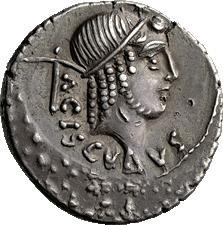
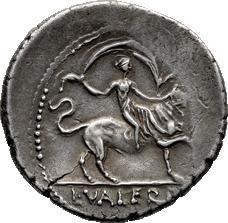
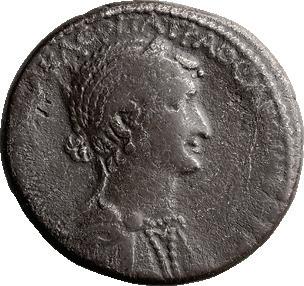

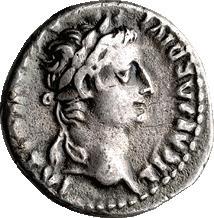
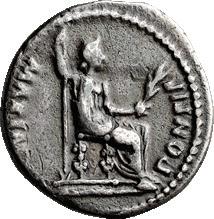


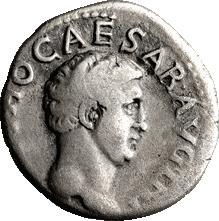
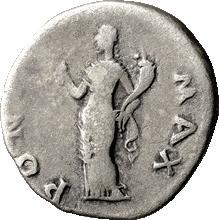


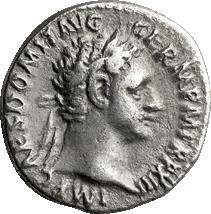
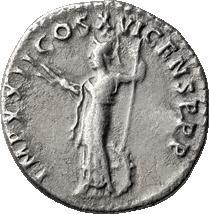

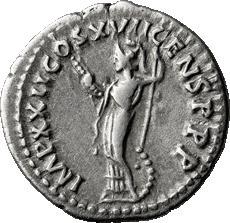




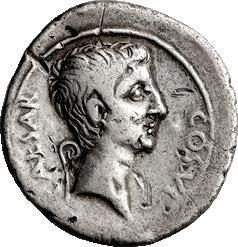


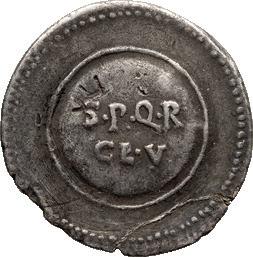

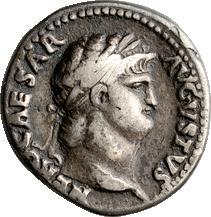

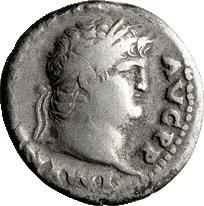
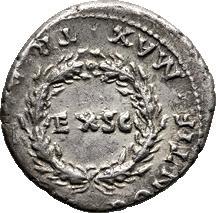
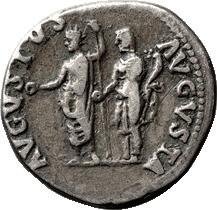
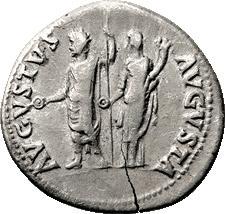
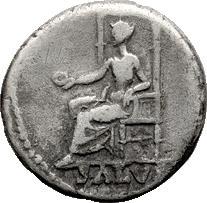

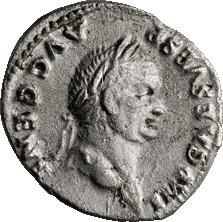



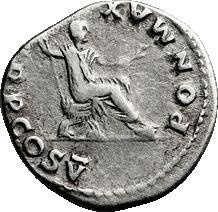


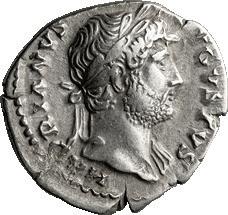

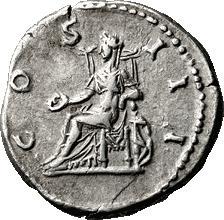
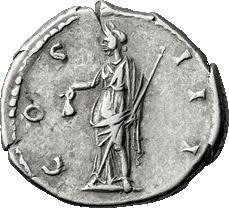

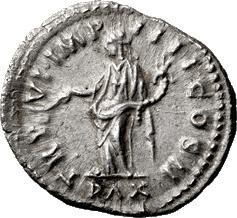
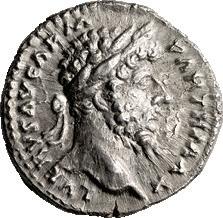
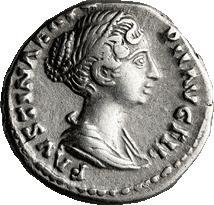




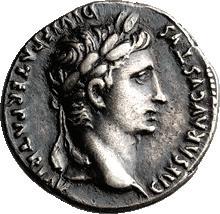

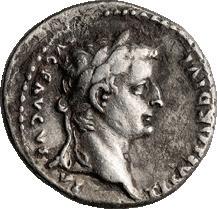

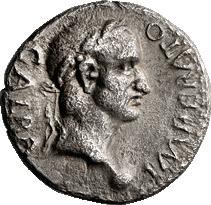


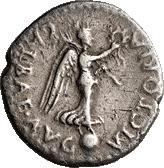


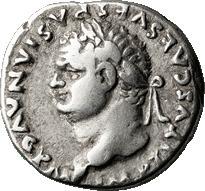


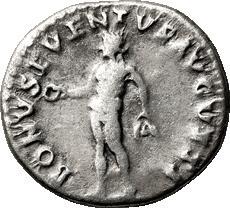
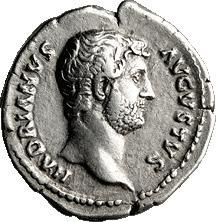




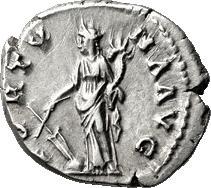

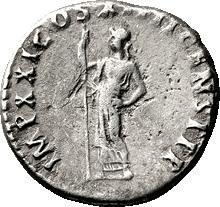


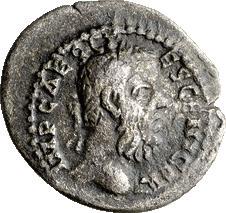
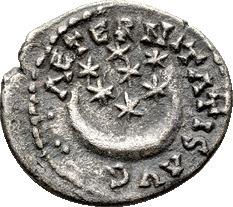


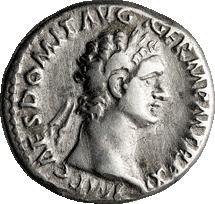
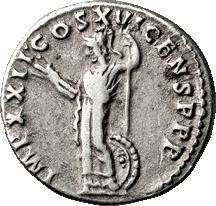


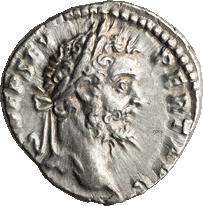
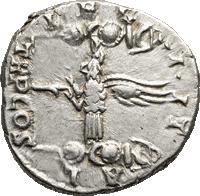
second Parthian expedition. Underweight specimen. VF 275 Twenty Year Vows
347. SEPTIMIUS SEVERUS; 193-211 AD, Rome, 208 AD, Denarius, 3.43g. BM-377. Obv: SEVERVS - PIVS AVG Head laureate r. Rx: VOTA SVSCEPT - A XX around, Septimius standing r. holding patera over tripod altar; on r. attendant standing l., holding rod; in center background, flute player, half-length, facing. Ex Curtis L. Clay Collection; ex CNG E360, 30 Sept. 2015, lot 470. Septimius undertakes vows for twenty years. Rare: only one specimen in Reka Devnia hoard. Virtually MS 1750 Quinarius
348. SEPTIMIUS SEVERUS; 193-211 AD, Rome, 195-6 AD, Quinarius, 0.96g. Cf. BM-80, pl. 7.14. Obv: L SEPT SEV PERT - AVG IMP VII Head laureate r. Rx: COSII P P, Victory advancing r. holding wreath and palm over shoulder. Ex Curtis L. Clay Collection. This is an excessively rare quinarius. VF 1000
349. JULIA DOMNA; 193-211 AD, Rome, ca. 193-211, Denarius, 3.50g. S-1739. Obv: IVLIA - AVGVSTA, Bust draped r. Rx: HILARITAS around, Hilaritas standing l., holding long palm and cornucopia. Excellent high relief portrait. Virtually MS 160
350. CARACALLA; 198-217 AD, Rome, 213 AD, Denarius, 23.00g. RSC-508, Foss77. Obv. ANTONINUS PIVS AVG BRIT; laureate and bearded head right. Rx. PROFECTIO AVG; Caracalla standing right, holding spear; two signa to left. Struck 213 AD on the emperor’s departure for campaigns in Germany. MS 185
351. CARACALLA; 198-217 AD, Rome, 215 AD, Denarius, 3.10g. S-1836v. Obv. ANTONINUS PIVS AVG GERM; laureate and bearded head right. Rx. P M TR P XVIII COS IIII P P; Aesculapius standing facing, holding serpent-wreathed rod. Virtually MS 200
352. ELAGABALUS (218-222 AD); 218-222 AD, Rome, ca. 218-222 AD, Denarius, 3.30g. RSC-143. Obv. IMP ANTONINVS AVG, laureate and draped bust to right. Rx. P M TR P II COS II P P, Pax walking to left, holding branch and scepter. Toned MS 200
353. ELAGABALUS (218-222 AD); 218-222 AD, Rome, ca. 220-222 AD, Denarius, 3.00g. RSC-276. Obv: IMP ANTONINVS PIVS AVG, laureate and draped bust right, wearing horn (“horned portrait”). Rev: SVMMVS SACERDOS AVG, Emperor standing left, sacrificing over tripod with patera and holding branch; star in left field. MS 225
354. SEVERUS ALEXANDER; 222-235 AD, Rome, 224-5 AD, Denarius, 2.58g. BM222, RSC-52a, RIC-139. Obv: IMP C M AVR SEV - ALEXAND AVG Bust laureate, draped r. Rx: FIDES - M - I - LITVM Fides standing l. holding two standards. MS 210
355. SEVERUS ALEXANDER; 222-235 AD, Rome, 224-5 AD, Denarius, 3.50g. BM269, C-564, RIC-180. Obv: IMP C M AVR SEV - ALEXAND AVG Bust laureate, draped r. Rx: VICTO - R - I - AVG, Victory advancing l., holding wreath and palm. Virtually MS 180
356. MAXIMINUS I THRAX; 235-238 AD, Rome, 235-238 AD, Denarius, 3.20g. S-2242, RIC-3. Obv. IMP MAXIMINUS PIVS AVG; emperor facing right. Rx. P M TR P II COS P P; emperor standing left between two standards. aEF 150
357. MAXIMUS AS CAESAR; 235-238 AD, Rome, Denarius, 2.53g. BM-118, pl. 37; C-1 (20 Fr.); RIC-1. Obv: IVL VERVS MAXIMVS CAES Bare-headed, draped bust r. Rx: PIETAS AVG Priestly implements: lituus, knife, pitcher, ladle, whisk. Ex Heritage Auctions, Aug. 2022. Virtually MS 450
358. PHILIP I; Rome, 248 AD, Antoninianus, 2.65g. C-189, RIC-21. Obv: IMP PHILIPPVS AVG Bust radiate, draped, cuirassed r. Rx: SAECVLARES AVGG (“The Saecular Games of the Emperors”) Antelope walking l., officina number UI=6 in exergue. aEF 200
359. PHILIP I; 244-249 AD, Rome, 245 AD, Antoninianus, 3.28g. RIC-26b, C-3. Obv: IMP M IVL PHILIPPVS AVG Bust radiate, draped, cuirassed r. Rx: ADVENTVS AVGG around, Philip on horse pacing l., raising r. hand and holding spear. MS 1775 360. PHILIP I; 244-249 AD, Rome, 244-5 AD, Antoninianus, 3.78g. C-103, RIC-40b. Obv: IMP M IVL PHILIPPVS AVG Bust radiate, draped, cuirassed r. Rx: PAXAETERN around, Pax standing l. holding branch and slanting scepter. MS 175 361. PHILIP I; 244-249 AD, Rome, ca. 245-7 AD, Antoninianus, 4.60g. RIC-44b, RSC169. Obv. IMP M IVL PHILIPPVS AVG; radiate, draped and cuirassed bust right. Rx. ROMAE AETERNAE; Roma seated left on throne, holding Victory in her right hand and spear in her left; at her side, shield. 3rd Emission. MS 175 362. PHILIP I; 244-249 AD, Rome, 246-8 AD, Antoninianus, 4.60g. RIC-48b, RSC-215. Obv. IMP M IVL PHILIPPVS AVG; radiate, draped and cuirassed bust right. Rx. SECVRIS ORBIS; Securitas seated l. holding scepter and supporting head with other hand. MS 200
363. PHILIP I; 244-249 AD, Rome, Antoninianus, 4.70g. RIC-62 NOTE, RSC-50b. Obv: IMP PHILIPPVS AVG; radiate, draped and cuirassed bust of Philip I to right. Rx. FIDES EXERCITVS; Aquila between three signa. Var: No eagle on 3rd standard. 11th Emission, 2nd off. Virtually MS 120
364. PHILIP I; 244-249 AD, Rome, Antoninianus, 4.30g. RSC-173, RIC IV-12, Foss21. Obv. IMP PHILIPPVS AVG, radiate, draped and cuirassed bust right. Rx. SAECVLARES AVGG, lion walking right; I in exergue. Ludi Saeculares (Secular Games) issue, commemorating the 1000th anniversary of Rome. Struck 248 AD at Rome mint; 1st officina, 9th emission. F 200 Hippopotamus
365. OTACILIA SEVERA; Rome, 248 AD, Antoninianus, 3.47g. RIC-116b, C-63 (3 Fr.). Obv: OTACIL SEVERA AVG Bust draped r. wearing stephane, crescent behind shoulders. Rx: SAECVLARES AVGG around, Hippopotamus standing r., lowering head, officina number IIII=4 in exergue. EF / aEF 350
366. PHILIP II AS AUGUSTUS; 247-249 AD, Rome, 248 AD, Antoninianus, 3.87g. RIC-224, C-72 (2 Fr.). Obv: IMP PHILIPPVS AVG Bust radiate, draped, cuirassed r. Rx: SAECVLARES AVGG (“The Saecular Games of the Emperors”) Goat standing l., officina number III=3 in exergue. VF 200
367. PHILIP II AS CAESAR; 245-247 AD, Rome, 246-8 AD, Antoninianus, 3.78g. RIC-226, RSC-6. Obv. IMP M IVL PHILIPPVS AVG; radiate, draped and cuirassed bust right. Rx. AETERNIT IMPER; Sol advancing left, raising hand and holding whip. MS 150
368. GORDIAN III; 238-244 AD, Rome, ca. 238-244 AD, Denarius, 2.90g. RSC-69.
Obv. IMP GORDIANVS PIVS FEL AVG; laureate, draped and cuirassed bust of Gordian III to right. Rx. DIANA LVCIFERA; Diana Lucifera standing right, holding long, lighted torch. MS 200
369. GORDIAN III; 238-244 AD, Rome, ca. 238-244 AD, Antoninianus, 4.10g. RIC-95, S-2368, RSC-404. Obv. IMP GORDIANVS PIVS FEL AVG; laureate, draped and cuirassed bust of Gordian III to right. Rx. VIRTVTI AVG VSTI; Hercules standing right with club and lions skin. MS 200
370. GORDIAN III; 238-244 AD, Rome, 243-244 AD, Antoninianus, 4.68g. RIC-144 corr. Obv: IMP GORDIANVS PIVS FEL AVG Bust radiate, draped, cuirassed r. Rx: FORTVNA REDVX around, Fortuna seated l. holding rudder and cornucopia; under seat, wheel. MS 210
371. GORDIAN III; 238-244 AD, Auxiliary Mint, 243-244 AD, Antoninianus, 4.91g. RIC-210 corr. Obv: IMP GORDIANVS PIVS FEL AVG Bust radiate, cuirassed r. Rx: FORTVNA REDVX around, Fortuna seated l. holding rudder and cornucopia; without wheel under seat. MS 220
372. GORDIAN III; 238-244 AD, Auxiliary Mint, 243-244 AD, Antoninianus, 4.47g. RIC-210 corr. Obv: IMP GORDIANVS PIVS FEL AVG Bust radiate, cuirassed r. Rx: FORTVNA REDVX around, Fortuna seated l. holding rudder and cornucopia; without wheel under seat. MS 210
373. GORDIAN III; 238-244 AD, Auxiliary Mint, 242-4 AD, Antoninianus, 5.26g. RIC213. Obv: IMP GORDIANVS PIVS FEL AVG Bust radiate, cuirassed r. Rx: ORIENS AVG around, Sol standing l., raising r. hand and holding globe in l. MS 225 374. TRAJAN DECIUS; 249-251 AD, Rome, Antoninianus, 3.70g. RSC-86, RIC-21b. Obv. IMOP C M Q TRAINVS DECIVS AVG; laureate bust right. Rx. PANNONIAE; the two Pannoniae, veiled, standing half-left, looking in opposite directions; each holds a standard, the one on right raises right hand. Weakly struck reverse. MS 200
375. QUIETUS; 260-261 AD, Antioch, Antoninianus, 3.69g. Göbl-1738f (9 spec.), RIC-9 (R2), C-11 (30 Fr.). Obv: [IMP C FV]L QVIETVS P F AVG Radiate, draped, cuirassed bust r. Rx: [R]O[M]AE AETERNAE Roma seated l. above shield, holding Victory and spear. Flatly struck on left. EF 200 376. DIVA MARINIANA, WIFE OF VALERIAN; Viminacium, 254-8 AD, Antoninianus, 3.93g. Eauze Hoard-1427 (19 spec.), C-2 (8 Fr.), RIC-3 (S). Obv: DIVAE MARINIANAE Bust draped, veiled r. on crescent, wearing stephane. Rx: CONSECRATIO Peacock with tail spread standing front, head l. Ex HJB LTD BuyBid Sale 141, Lot 337, Nov. 2004. VF 250 377. GALLIENUS; 253-268 AD, Gaul (Trier?), ca. 257-260 AD, Antoninianus, 4.00g. RIC-18(J), Normandy-44. Obv. GALLIENVS P F AVG; bust radiate, cuirassed r., seen from front, fold of cloak on front shoulder and behind neck, inner wreath tie overlaps neck. Rx. GERMANICUS MAX V; trophy and two seated captives. Victory over the Alamanni. EF 110
378. GALLIENUS; 253-268 AD, Antioch, Antoninianus, 3.96g. RIC-668. Obv: GALLIENVS AVG Bust radiate, draped, cuirassed r. Rx: VIRTVS AVG around, Virtus standing l. holding shield and spear, star in upper l. field. MS 125 379. GALLIENUS; 253-268 AD, Antioch, Antoninianus, 2.89g. Göbl-1626a (10 spec.), RIC-656, C-922 (2 Fr.). Obv: GALLIENVS AVG Head radiate l. Rx: SAECVLARHS AVG Stag standing r., palm in exergue. RIC and Cohen give SAECVLARES, but according to Göbl the coins always show the erroneous SAECVLARHS. EF 150
380. GALLIENUS; 253-268 AD, Antioch, 265 AD, Antoninianus, 3.35g. Göbl-1622f (4 spec.), RIC-602, C-847 (3 Fr.). Obv: GALLIENVS AVG Head radiate l. Rx: P M TR P XIII around, C VI P P in exergue, lion walking l., bull’s head before him. Scarce and interesting dated reverse type, rare with portrait left on obverse. toned virtually ms
200
381. GALLIENUS; 253-268 AD, Rome, c. 267-8 AD, Antoninianus, 3.04g. RIC-230. Obv: GALLIENVS AVG Head radiate r. Rx: LIBERO P CONS AVG around, Tigress walking l., B (=officina 2) in exergue. EF
200
382. GALLIENUS; 253-268 AD, Rome, 268 AD, Antoninianus, 4.10g. RIC-267(s), Venera-3018, Cunetio-1275. Obv. GALLIENVS AVG; bust radiate, cuirassed right. Rx. PROVIO AVG; Spes walking left, holding cane and raising fold of flowers; X in right field. 5th emission. MS 100
383. GALLIENUS; 253-268 AD, Uncertain Syrian mint, c. 260 AD, Antoninianus, 4.08g. RIC-445 var. Obv: Radiate bust r. Rx: ORIENS AVG Emperor standing l., facing turreted female standing r. Scarce; perhaps unpublished without wreath on reverse. Virtually MS 200
384. SALONINA; Samasota, Antoninianus, 3.93g. RIC-67, C-103 (1 Fr.). Obv: SALONINA AVG Draped bust r. on crescent, wearing stephane. Rx: ROMAE AETERNAE around, Roma seated l. above shield, holding out Victory in r. hand, vertical spear pointing up in l. hand; before her, togate, laureate emperor standing r., extending r. hand below Roma’s Victory. MS 110
385. VALERIAN II, DIVUS; Lugdunum, Antoninianus, 2.29g. RIC-9. Obv: DIVO VALERIANO CAES Head radiate r. Rx: CONSACRATIO around, Eagle flying r., bearing Caesar to heaven. EF 150
386. VALERIAN II, DIVUS; Rome, Antoninianus, 1.64g. RIC-27. Obv: DIVO CAES VALERIANO Head radiate r. Rx: CONSECRATIO around, S in exergue, Eagle standing r., head l. EF 150
387. CLAUDIUS II GOTHICUS; 268-270 AD, Rome, Antoninianus, 2.57g. RIC-13. Obv: IMP C CLAVDIVS AVG Bust radiate, draped, cuirassed r., seen from front. Rx: ADVENTVS AVG around, Emperor riding l., raising r. hand and holding scepter in l. EF 200
388. CLAUDIUS II GOTHICUS; 268-270 AD, Rome, 269 AD, Antoninianus, 3.80g. RIC-38, Venera-8876. Obv. IMP CLAVDIVS AVG; bust laureate, draped, cuirassed right.Rx. FIDES MILITUM; Fides standing right, holding signum in each hand. 4th Emission. MS 155
389. CLAUDIUS II GOTHICUS; 268-270 AD, Mediolanum, Antoninianus, 3.70g. RIC-144, Venera-9371. Obv. IMP. CLAVDIVS P.F. AVG; radiate bust of emperor right. Rx. DIANA LVCIF; Diana standing on the right with a torch. MS 150
390. AURELIAN; 270-275 AD, Milan, Antoninianus, 4.04g. RIC-135. Obv: AVRELIANVS AVG Bust radiate, cuirassed r., seen from front, “tassle” on l. shoulder. Rx: ORI - E - NS AVG around, Sol standing r., head l., raising r. hand and holding globe in l. hand, at his feet captive wearing peaked cap seated l. with hands
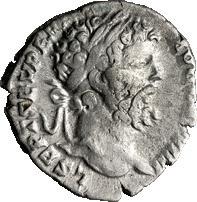
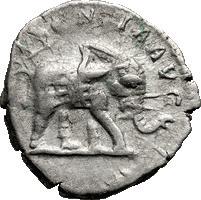


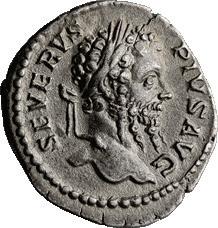
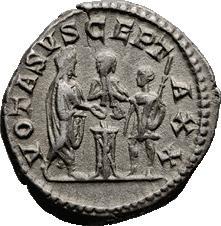
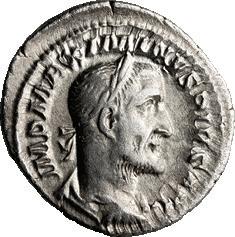


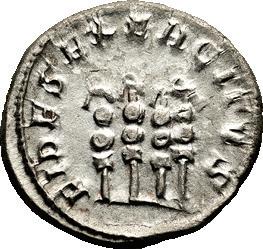
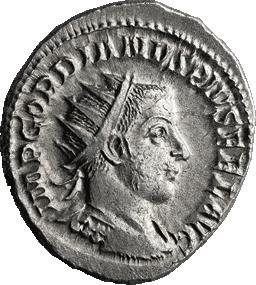
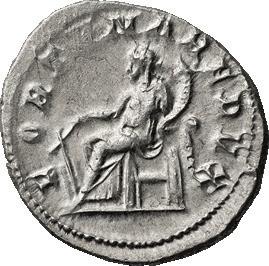
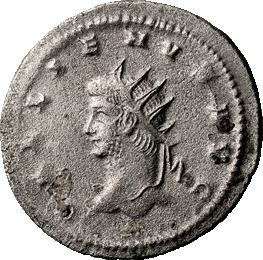
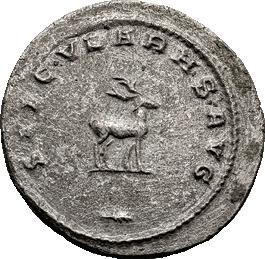


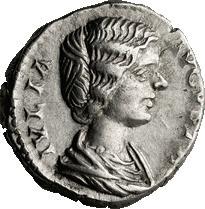

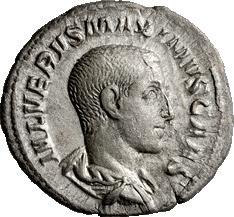
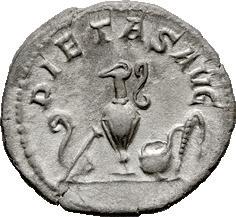





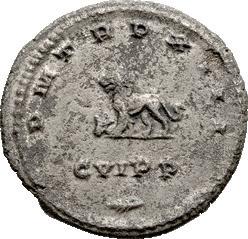
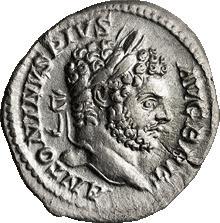

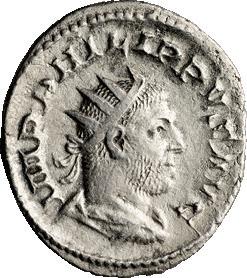



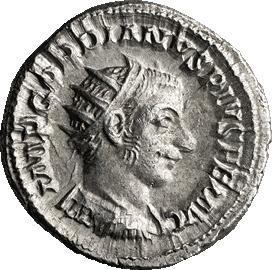
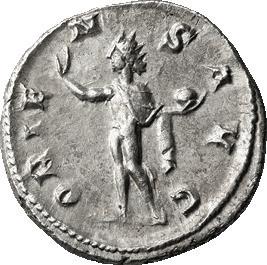

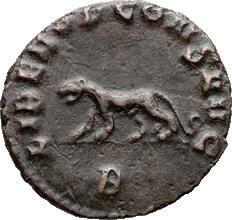


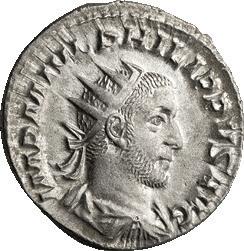




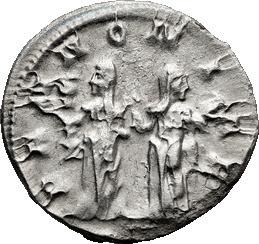
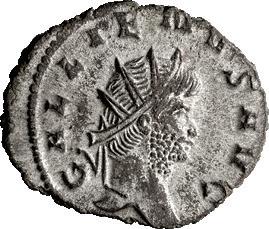


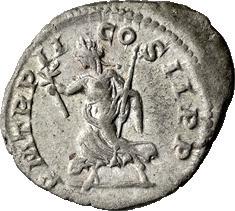

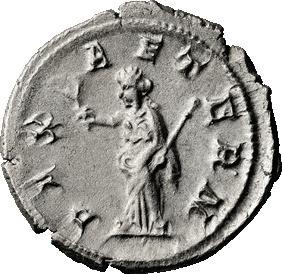


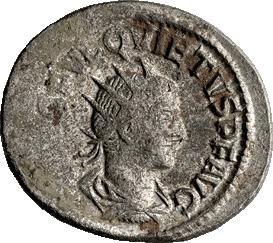

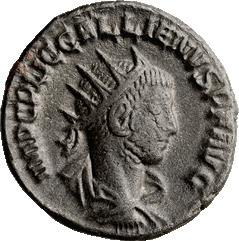



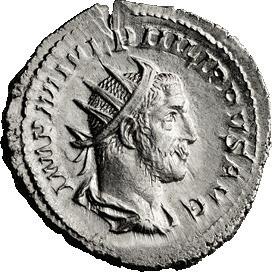
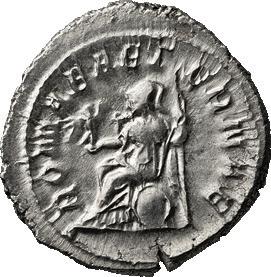
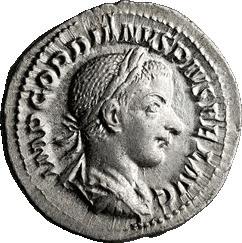
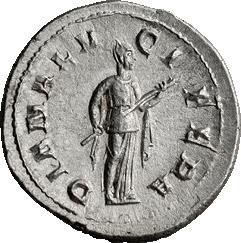
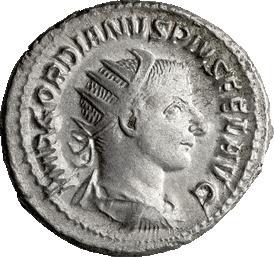
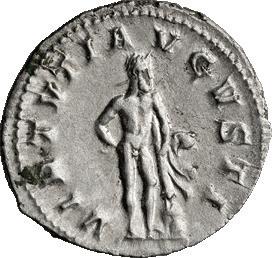

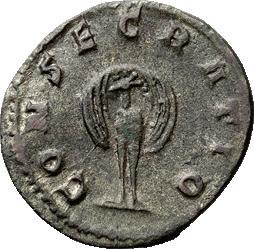

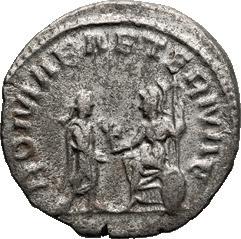


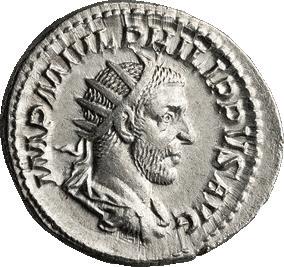
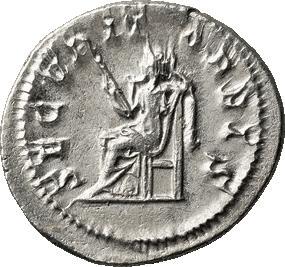
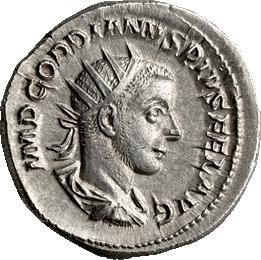
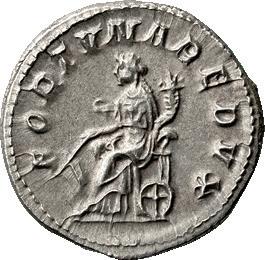

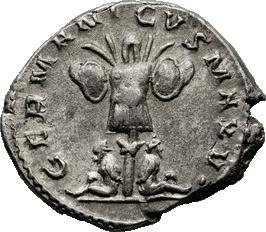
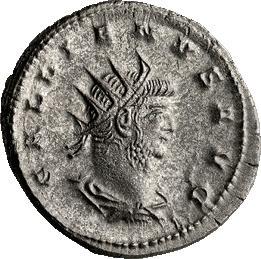

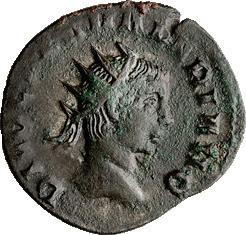
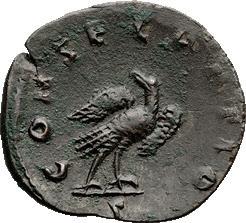
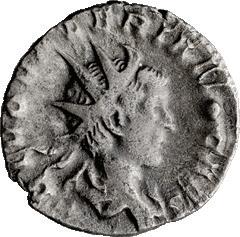
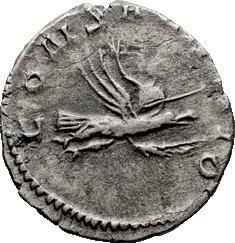
tied behind back; in exergue, P (officina 1). MS 125 391. AURELIAN; 270-275 AD, Milan, Spring 274 AD, Antoninianus, 3.57g. RIC-150. Obv: IMP C AVRELIANVS AVG Bust radiate, cuirassed r., seen from front. Rx: ORI - ENS AVG Sol, raising r. hand and holding globe in l., walking l. between two captives at feet, T - M in exergue. MS 125 392. AURELIAN; 270-275 AD, Siscia, Antoninianus, 3.87g. RIC-233. Obv: IMP AVRELIANVS AVG Bust radiate, cuirassed r., seen from front. Rx: RESTITVTOR ORIENTIS around, *T in exergue, emperor standing l., holding scepter and raising kneeling woman. Ex. Alex G Malloy Inc. Auction Sale LX “The John Aiello Collection of Late Roman Coins”, Lot 145. March 14, 2001. MS 300 393. AURELIAN; 270-275 AD, Serdica, Antoninianus, 3.69g. RIC-258. Obv: IMP C D AVRELIANVS AVG Bust laureate, draped, cuirassed r., seen from front. Rx: CONSERVATOR AVG around, Aesculapius standing r., head l., holding staff entwined with serpent. Virtually MS 250 394. AURELIAN; 270-275 AD, Serdica, Antoninianus, 4.17g. RIC-261. Obv: AVRELIANVS AVG Bust radiate, cuirassed r., seen from front. Rx: IOVI CONSER around, Jupiter standing l., handing globe to emperor standing r., S (=officina 2) in exergue. Scarce with IMP omitted from obverse legend. MS 125 395.
AURELIAN; 270-275 AD, Serdica, Antoninianus, 3.45g. Cf. RIC-268. Obv: IMP C D AVRELIANVS AVG Bust radiate, draped, cuirassed r. Rx: I - O VI STA - TORI around, Jupiter standing l., holding thunderbolt and scepter. A rare variant with this obverse legend and without officina letter in reverse exergue; unrecorded by Estiot, Aurelian, p. 390 . MS 250 396. AURELIAN; 270-275 AD, Serdica, Antoninianus, 3.31g. RIC-290. Obv: AVRELIANVS AVG Bust radiate, cuirassed r., seen from front. Rx: RESTITVTOR - BIS around, KAB in exergue, star in lower field; Woman standing r., presenting wreath to emperor standing l., holding scepter. MS 150
397.
AURELIAN; 270-275 AD, Unattributed Mint, Antoninianus, 3.26g. Bust var. of RIC-401. Obv: [IMP] - AVRELI - ANVS AVG Bust radiate, draped r., possibly also cuirassed, seen from front, holding spear over shoulder with l. hand. Rx: [R] ESTIT[VTOR]I G - ENTIS (sic), Emperor standing l., holding scepter, receiving wreath from woman standing r.; in exergue, probably officina letter [A], mostly off flan. The reverse legend, literally “To the Restorer of the Clan” or “of the Nation”, is probably just an error (added G), for RESTITVT ORIENTIS, “To the Restorer of the East”. Aurelian’s bust type with spear over shoulder is rare at this Unattributed Mint; not attested by Gobl in combination with this erroneous GENTIS reverse type. Unusual heroic bust. MS 350
398. AUREOLUS; Antoninianus, 1.74g. Cunetio-2478, 2485, and 2487-8 (59 spec.). Coinage of Aureolus in the name of the Gallic emperor Postumus, 267-8 AD. Obv: IM[P C] POSTVMVS P F AVG Bust of Postumus radiate, draped, and cuirassed r., seen from front. Rx: [VIRTVS] EQV[IT] (“The Prowess of the Cavalry”) around, T (officina 3) in exergue, Mars advancing r., holding spear and shield. Ex Malloy LX, Aiello Coll., lot 247. Underweight specimen. MS 200
399. TACITUS; 275-276 AD, Gaul, ca. 275-276 AD, Antoninianus, 4.80g. RIC-65. Obv. IMP C M CL TACITVS AVG; radiate, draped and cuirassed emperor bust right. Rx. TEMPORVM FELICITAS; Felicitas draped, standing on the left, holding a long caduceus in her right hand and a cornucopia in her left; A/A in right and left fields. MS 150
400. TACITUS; 275-276 AD, Siscia, ca. 275-276 AD, Antoninianus, 4.20g. RIC-139, Venera-2176. Obv. IMP C M CL TACITVS AVG; radiate, draped and cuirassed emperor bust right. Rx. FELICITAS SAECVLI; Felicitas, small lighted altar at her feet, standing facing, head left and holding patera and long caduceus. MS 125 401. TACITUS; 275-276 AD, Ticinum, ca. 275-276 AD, Antoninianus, 4.00g. RIC-163, C-131, Paris-1662, Venera-1928, Hunter-54. Obv. IMP C M CM TACITUS AVG, emperor facing r. Rx. SECVRIT PERP, Securitas standing l., leaning on column and raising r. hand above head, U (officina 6) in exergue. 2nd emission. MS 150 402. TACITUS; 275-276 AD, Siscia, Antoninianus, 4.20g. RIC-184v (unlisted MM), Venera-2294. Obv: IMP C M CLA TACUTVS AVG, radiate, draped and cuirassed bust right. Rx: FELICITAS SAECVLI, Felicitas standing left, holding caduceus and sacrificing with patera over lighted altar to left; V in exergue. MS 200 403. PROBUS; 276-282 AD, Lugdunum, Antoninianus, 4.70g. C-213, citing M. Tetenoire; RIC-75, note 2. Obv: IMP C PROBVS P F AVG, Bust radiate, cuirassed r., seen from front. Rx: FELICT - TEMP (sic, second I of intended FELICIT omitted), in exergue II (officina 2), Felicitas standing l., holding caduceus and scepter. With a rare engraver’s error (omitted letter) in the reverse legend. Cohen reported a coin with this error in a private collection, but no further specimen seems to be cited in the relevant volume of Bastien’s Lugdunum corpus or in the first two supplementary volumes to that corpus. Our coin was earlier in CNG’s Web Auction # 91143063, where according to the printed ticket the error in the reverse legend was not noticed. The issues of Probus antoniniani are so unusual and beautifully designed that there’s a good possibility that Probus had some input into the designs, as nothing before or after equals their artistry. This offering, if desired, makes it possible to begin a specialized collection of the wonderful antoniniani of Probus. MS 300
404. PROBUS; 276-282 AD, Lugdunum, Antoninianus, 3.34g. RIC-93. Obv: IMP C PROBVS P F AVG Bust radiate, cuirassed r., seen from front. Rx: PIAET - AS AVG on l. and r., III in exergue, Pietas standing l., holding patera over altar at her feet and box of perfumes. MS 100
405. PROBUS; 276-282 AD, Rome, Antoninianus, 3.45g. RIC-157, C-37. Obv: IMP PRO - BVS AVG Bust radiate, cuirassed r., seen from front. Rx: ADVEN - TVS AVG on l. and r., R(crescent and pellet)S in exergue, Probus on horseback l., raising r. hand and holding scepter in l., captive seated l. on ground below raised r. foreleg of horse. MS 200
406. PROBUS; 276-282 AD, Rome, Antoninianus, 3.35g. RIC-186. Obv: IMP PROBVS AVG Radiate, helmeted, cuirassed bust l., seen from front, holding spear over shoulder with r. hand and carrying shield on l. shoulder. Rx: ROMAE - AETER on l. and r., R(crescent)Γ in exergue, Roma seated facing in hexastyle temple, holding Victory and scepter. MS 175
407. PROBUS; 276-282 AD, Rome, 282 AD, Antoninianus, 3.50g. RIC-187, C-528. Obv: PROBV - S P F AVG Bust radiate l., almost half-length, seen from front, wearing
consular robes and holding eagle-tipped scepter. Rx: ROMAE - AETER on l. and r., R(thunderbolt)Δ in exergue, Roma seated front, head l., in six-columned temple, holding Victory or Palladium and scepter. MS 160
408. PROBUS; 276-282 AD, Rome, Antoninianus, 3.38g. Cf. RIC-204 and 207. Obv: IMP - C M AVR PROBVS P AVG Radiate, consular bust l. holding eagle-tipped scepter. Rx: SO - L - I I - NVI - C - TO around, R*B in exergue, Sol standing facing in frontal quadriga, raising r. hand and holding globe and whip in l. Not in RIC with this obverse legend. MS 240 409. PROBUS; 276-282 AD, Rome, Antoninianus, 6.62g. RIC-219 (R, citing BM). Obv: IMP PRO - BVS AVG Bust radiate, cuirassed r., seen from front. Rx: VICTO - RIA GERM Victory advancing r. between two seated captives, holding wreath and trophy, in exergue R*Z (officina 7). Overweight specimen. MS 150
410. PROBUS; 276-282 AD, Ticinum, Antoninianus, 4.17g. RIC-365. Obv: IMP C PROBVS P F AVG Bust radiate, cuirassed r., seen from front. Rx: FIDE - S M - ILIT Fides standing l. holding two standards, VIXXT in exergue (officina 6). MS 200 Emperor Seen From Reverse
411. PROBUS; 276-282 AD, Ticinum, Antoninianus, 4.37g. RIC-388. Obv: VIRTVS
PROBI AVG Radiate, nude bust of Probus l., seen from back, holding spear pointed l. and upwards and wearing large aegis supported by strap over shoulder. Rx: IOVI CONSE - RVAT around, VXXT in exergue, Emperor standing r. holding eagle-tipped scepter and receiving globe from Jupiter standing l. before him, who also holds a scepter. MS 250 Emperor Seen From Reverse
412. PROBUS; 276-282 AD, Ticinum, Antoninianus, 3.46g. RIC-430. Obv: VI - RTVS
PROBI [A]VG Radiate, nude bust of Probus l., seen from back, holding spear pointed left and upwards and wearing large aegis supported by strap over shoulder. Rx: [VI] RTV[S] AV[G] around, [PXX]T in exergue, Mars advancing r., holding spear and trophy over shoulder. Virtually MS 285
413. PROBUS; 276-282 AD, Siscia, Antoninianus, 4.11g. Cf. RIC-611. Obv: IMP C M AVR PROBVS P F AVG Bust cuirassed l. wearing crested, radiate helmet and holding shield on l. arm. Rx: P M TRI P COS II P P around, XXIS in exergue, Lion walking l., with head of ox on ground before him. Extremely rare type. Virtually MS 650 Rare Wolf and Twins Type
414. PROBUS; 276-282 AD, Siscia, Antoninianus, 3.00g. RIC-639. Obv: IMP C M AVR PROBVS AVG bust radiate, draped r. Rx: AETERNITAS AVG around, XXIP in exergue, She-wolf standing l., looking back, suckling Romulus and Remus. VF 200 415. PROBUS; 276-282 AD, Siscia, Antoninianus, 4.36g. Bust var. of RIC-668. Obv: PROB - VS AVG Radiate bust l., seen from front, wearing consular robes and holding eagle-tipped scepter. Rx: CONCORDIA - MILIT around, XXI in exergue, P in lower middle field, Emperor standing r., clasping hands with Concordia standing l. MS200
416. PROBUS; 276-282 AD, Siscia, Antoninianus, 3.41g. Cf. RIC-723. Obv: IMP C M AVR PROBVS P AVG, Helmeted, radiate, cuirassed bust l., seen from front, holding spear over r. shoulder and shield by l. shoulder. Rx: PROVIDEN[T] AVG Providentia standing l. holding globe and transverse scepter, in exergue XXISI (the S in the mintmarkappears to be recut over a previous letter). MS 225 417. PROBUS; 276-282 AD, Serdica, Antoninianus, 3.92g. Cf. RIC-861. Obv: IMP C [M] AVR PROBVS P F AVG, Bust radiate, helmeted, cuirassed l., seen from front, holding spear over r. shoulder and small, round shield by l. shoulder. Rx: [SO]LI INVICTO around, mintmark K[A.Γ]? in exergue, Sol standing in frontal quadriga, raising r. hand . EF 200 418. PROBUS; 276-282 AD, Serdica, Antoninianus, 3.91g. RIC-865. Obv: IMP C M AVR PROBVS PIVS AVG Bust radiate l., seen from front, wearing consular robes and holding eagle-tipped scepter. Rx: S - O - LI INVIC - TO around, KAA in exergue, Sol in frontal quadriga, raising r. hand and holding whip and globe in l. MS 250 419. PROBUS; 276-282 AD, Siscia, Antoninianus, 3.63g. RIC-801, C-840. Obv: IMP C M AVR PROBVS AVG Bust radiate, cuirassed r., seen from front. Rx: VIRTVS AVG around, XXIS in exergue, Probus standing r., holding transverse spear and globe. MS 250 420. PROBUS; 276-282 AD, Siscia, Antoninianus, 3.68g. RIC-818. Obv: IMP C M AVR PROBVS P F AVG, Radiate bust l. seen from front, wearing consular robes and holding eagle-tipped scepter. Rx: VIRTVS PR - OBI AVG around, XXIQ in exergue, Probus on horse charging l., about to hurl spear at enemy kneeling below the horse’s raised forelegs. MS 225
421. CARUS; 282-283 AD, Ticinum, Antoninianus, 4.33g. Cf. RIC-69, C-2, and Venera-315-319 (5 spec.). Obv: IMP CARVS P F AVG Bust radiate, cuirassed r., seen from front; on emperor’s l. shoulder, short horizontal pteryges. Rx: ABVNDANTIA AVG around, TXXI in exergue, Abundantia standing r. emptying cornucopia. Beautiful silvering. MS 300
422. CARINUS; 283-285 AD, Lugdunum, ca. 283-284, Antoninianus, 3.40g. RIC-212, S-3362. Obv. IMP C M AVR CARINVS AVG Radiate, draped and cuirassed bust of Carinus to right. Rx. AEQVITAS AVG Aequitas standing facing, head to left, holding scales with her right hand and cornucopia with her left; in field to right, A. MS 225
423. CARAUSIUS; 287-293 AD, London, Antoninianus, 5.11g. RIC-98. Obv: IMP C CARAVSIVS P F AVG Bust radiate, draped, cuirassed r., seen from front. Rx: [PAX AVG] Pax standing l. holding branch and vertical scepter, letters in field and in exergue illegible. Some silvering. Virtually MS 350
424. ALLECTUS; 293-296 AD, Camulodunum, Quinarius, 2.60g. RIC-126. Obv. IMP C ALLECTVS P AVG, radiate and cuirassed bust right. Rx. LAETITA AVG, galley sailing right; QC in exergue. The “C” mint (Camulodunum, Colchester or Clausentum). VF 275 Extremely Rare Reverse
425. DIOCLETIAN; 284-305 AD, Lugdunum, Antoninianus, 4.80g. RIC-4. Obv: IMP DIOCLETIANVS P AVG Bust radiate, draped, cuirassed r., seen from front. Rx: P M TR P VIII COS IIII P P around, A* in exergue, Radiate lion walking l., holding thunderbolt in mouth. The coins of Diocletian are very standardized, with almost no variation, making this variant reverse an extreme rarity. VF / EF 450
426. DIOCLETIAN; 284-305 AD, Cyzicus, Antoninianus, 3.40g. RIC-306. Obv. IMP C C VAL DIOCLETIANVS AVG; radiated bust Diocletian on right. Rx. CONCORDIA MILITVM; Diocletian on right receiving Victory with laurel wreath from Jupiter with


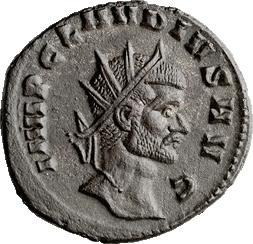
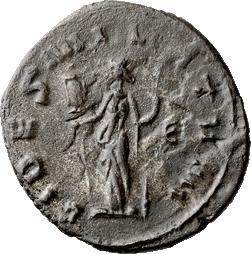
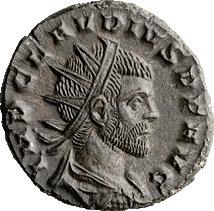
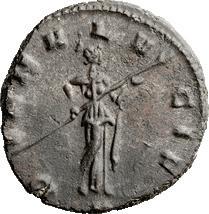
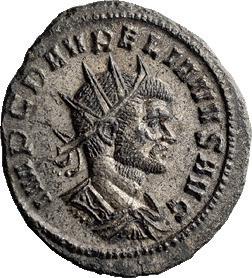
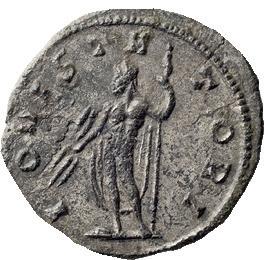
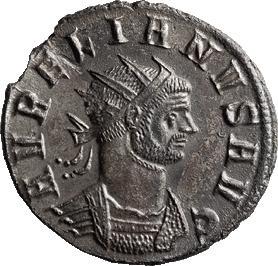
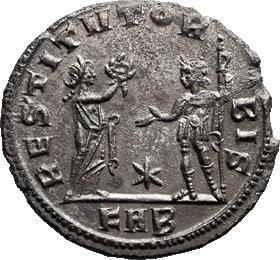


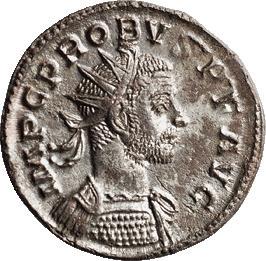


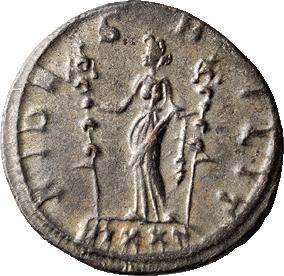


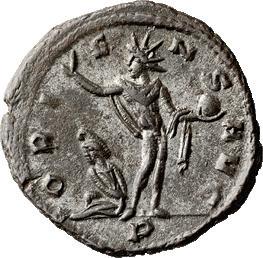
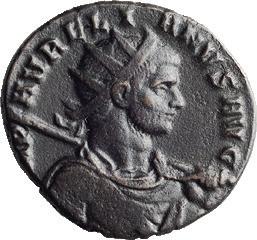


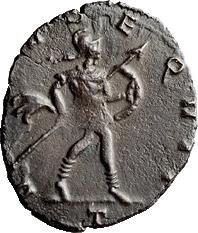



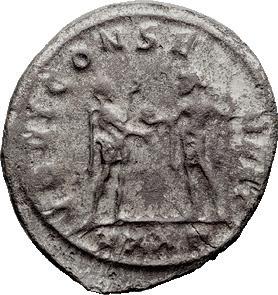


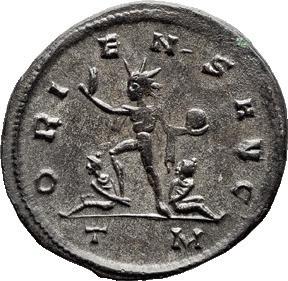
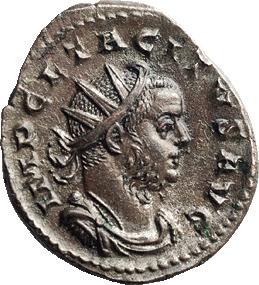


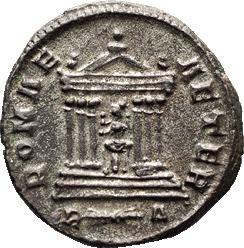
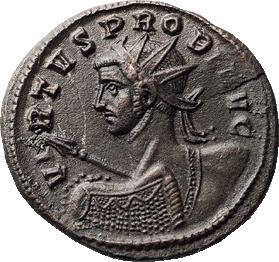
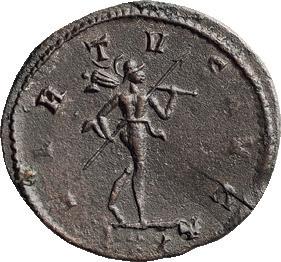


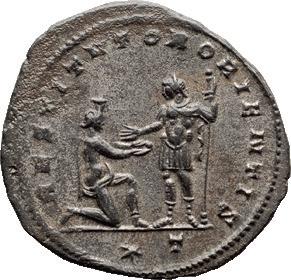

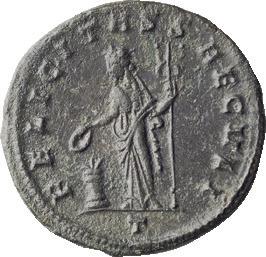
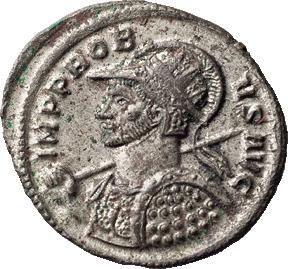
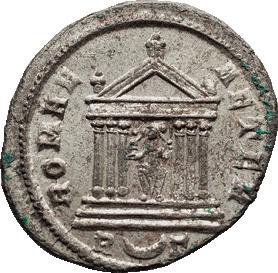


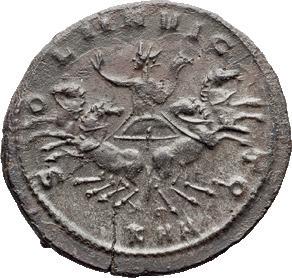

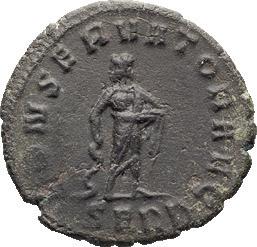
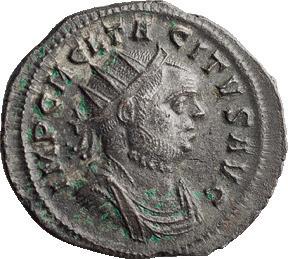
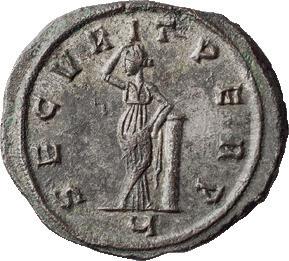


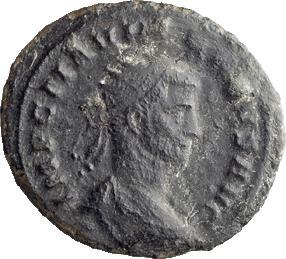



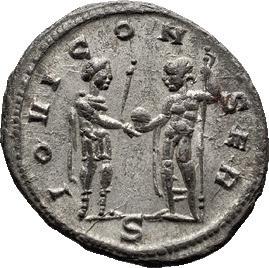

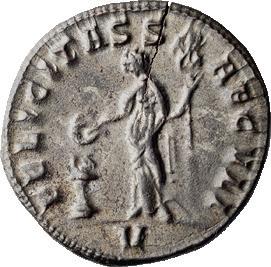
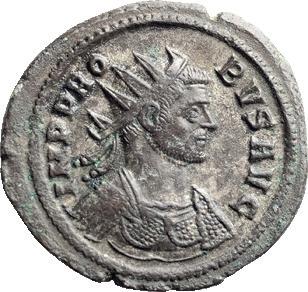

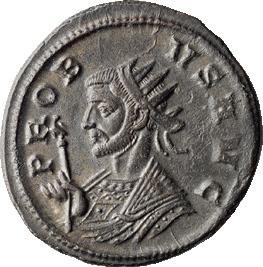
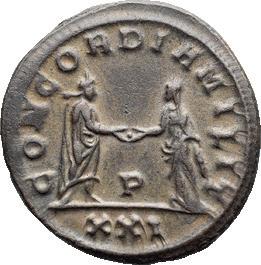
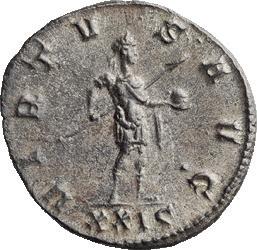
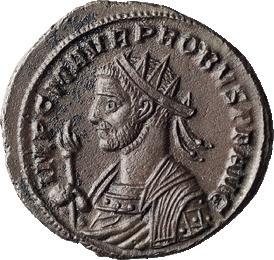


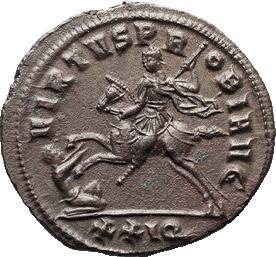
scepter on left; B, in exergue: XXI. MS 100 427. DIOCLETIAN; 284-305 AD, Tripolis, 284 AD, Antoninianus, 3.90g. RIC-330. Obv. IMP C C VAL DIOCLETIANVVS P F AVG; bust of emperor facing right. Rx. IOVI CONSERVATORI AVG; Victorian and Jupiter. MS 100 428. DIOCLETIAN; 284-305 AD, Heraclea, 297-8 AD, Follis, 8.60g. S-3434v, RIC-19a. IMP C C VAL DIOCLETIANVS P F AVG Laureate head of Diocletian to right. Rx. GENIO POPVLI ROMANI / HTΓ The Genius of the Roman people, nude but for chlamys, standing front, head to left, wearing kalathos and pouring ritual libation from patera in his right hand and cornucopiae in his left. gEF 200 429. DIOCLETIAN; 284-305 AD, Cyzicus, Abdication Follis, 8.90g. RIC-29a. Obv. DN DIICLETIANO FELICISSIMO SEN AVG; Laureate and mantled bust r., holding olive-branch and mappa. Rx. PROVIDENTIA DEORVM QVIES AVGG; Providentia standing r., extending hand to Quies standing l., holding branch and leaning on sceptre; S-star-F//KS. Engraver’s error in obverse legend. VF 125 430. DIOCLETIAN, AS SENIOR AUGUSTUS; 284-305 AD, Alexandria, ca. 308-310 AD, Post-Abdication Follis, 6.60g. RIC-109. Obv. D N DIOCLETIANO BAEATISS, laureate bust right, wearing imperial mantle, holding olive branch and mappa. Rx. PROVIDENTIA DEORVM, Providentia standing left, extending branch to Quies standing opposite who holds a scepter; Є/KP between, ALE in exergue. This is a rare variant from the normal abdication type. EF 450 431. MAXIMIANUS; 286-305 AD, Lugdunum, 287-9 AD, Antoninianus, 3.64g. Bastien-218 (17 spec.), C-647, RIC-458. Obv: IMP C MAXIMIANVS P AVG Helmeted, radiate, cuirassed bust r., seen from front. Rx: VIRTVTI AVGG Hercules r. strangling Nemean lion; behind him on ground, club. MS 275 432. CONSTANTIUS I AS CAESAR; 293-305 AD, Ticinum, ca. 294-5 AD, Follis, 10.60g. RIC-30a. Obv. CONSTANTIVS NOB CAES Laureate head right. Rx. GENIO POPVLI ROMANI Genius standing left, holding cornucopia and sacrificing with patera; in exergue, PT. MS 250
433. MAXENTIUS; 306-312 AD, Aquileia, 306-312 AD, Follis, 6.10g. S-3681, C-42, RIC-113. Obv. IMP C MAXENTIVS P F AVG; bust of emperor facing right. Rx. CONSERV VRB SVAE; Roma standing left on shield, handing globe to emperor, captive between, all within Totra-style temple; Victories as Acroteria, wolf and twins in peoiment. EF 200
434. MAXIMINUS II AS AUGUSTUS; 309-313 AD, Trier, c. 313 AD, Billon Unit, 3.03g. RIC-826 (R3), C-175 (10 Fr.). Obv: IMP MAXI - MINVS AVG Bust radiate, draped, cuirassed l., r. hand raised, l. holding globe. Rx: [SO]LI INVIC - TO CO[MITI] around, [P]TR in exergue, Sol standing front, head l., in facing quadriga, raising r. hand and holding globe and whip in l. EF 200
435. MAXIMINUS II AS CAESAR; 305-308 AD, Heraclea, May 305-July 306 AD, Follis, 9.50g. RIC-26b. Obv. GAL VAL MAXIMINVS NOB CAES Laureate head of Maximinus II to right. Rx. GENIO POPVLI ROMANI Genius, nude but for chlamys over his left shoulder, standing front, head to left, holding patera, from which liquor flows, in his right hand and cornucopiae in his left; in exergue, HTΓ. MS 200 436. MAGNENTIUS; 350-353 AD, Arles, Jan. 351-Aug. 352 AD, Centenionalis, 3.76g. RIC-173 (S), officina P=1; Bastien-263 (2 spec.). Obv: D N MAGNEN - TIVS P F AVG, Bare-headed, draped, cuirassed bust r., seen from front; A behind portrait. Rx: VICTORIAE DD NN AVG ET CAES around, Two Victories holding wreath, within which VOT / V / MVL / X; F in field below wreath, PAR in exergue. Rare variant with F in reverse field: only three such coins are recorded by RIC and by Bastien in his corpus of coins struck at Lugdunum. Struck on small flan. EF 175 437. MAGNENTIUS; 350-353 AD, Trier, 351 AD, Centenionalis, 4.86g. RIC-271 (C2), Bastien-32 (31 spec.). Obv: D N MAGNEN - TIVS P F AVG Bare-headed, draped, cuirassed bust r., seen from front, A behind portrait. Rx: GLORIA ROMANORVM Emperor in military dress, shield on l. arm, on horse charging r., spearing barbarian with outstretched arms kneeling l. beneath horse; below horse, shield and broken spear; mintmark TRP followed by crescent in exergue. Nearly MS 225 438. LICINIUS I; 308-324 AD, Thessalonica, ca. 312-313 AD, Follis, 3.40g. RIC VI60. Obv. IMP LIC LICINIVS P F AVG, laureate, draped and cuirassed bust right. Rx. IOVI CONSERVATORI AVGG NN, Jupiter, chlamys over shoulder, leaning on scepter, holding Victory on globe; eagle with wreath below left. In exergue, mintmark dot TS dot A dot. EF 200
Constantine the Great 439. CONSTANTINE I; 307-337 AD, Æ 3, Cyzicus, ca. 317-320 AD, 2.40g. RIC VII8, VM-82. Obv. IMP CONSTANTINVS AVG, laureate bust left, wearing consular robes and holding scepter, globe and mappa. Rx. IOVI CONSERVATORI AVGG, Jupiter standing left, holding scepter and crowning Victory on globe; (wreath)-A, SMK in exergue. MS 140
Constantine the Great 440. CONSTANTINE I; 307-337 AD, Lugdunum, ca. 309-310 AD, Follis, 3.70g. RIC VI-309, VM-63. Obv. IMP CONSTANTINVS P F AVG, laureate, draped and cuirassed bust of Constantine I right. Rx. SOLI INVICTO COMITI, Sol standing left, radiate, chlamys draped across upper chest and left shoulder, holding globe upwards and raising right hand. F-T across fields; PLG in exergue. MS 165 441. CONSTANTINE I; 307-337 AD, Siscia, 320 AD, Æ 3, 2.90g. RIC VII-120, VM92. Obv. CONSTANTINVS AVG, helmeted and cuirassed bust right. Rx. VIRTVS EXERCIT, labarum inscribed VOT/XX in two lines; two captives flanking below; S-F/monogram; in exergue, △SIS★. Some silvering. MS 150 442. CONSTANTIUS II; 337-361 AD, Antioch, AE 2, ca. 351-354, 5.80g. LRBC-2623, RIC-135. Obv. D N CONSTANTIVS P F AVG, diademed, draped and cuirassed bust right. Rx. FEL TEMP REPARATIO, soldier spearing fallen horseman, Γ in left field; ANI in exergue. Unusually sharp and well-done for issue. MS 150
443. GRATIAN; 367-383 AD, Trier, 378-83 AD, Siliqua, 2.22g. RIC-58a, Mintmark #1, C-56 (8 Fr.). Obv: D N GRATIA - NVS P F AVG Pearl-diademed, draped, cuirassed bust r., seen from front. Rx: VIRTVS RO - MANORVM Roma seated facing, head l., on throne, holding globe and spear; TRPS in exergue. aEF 275 ROMAN BRONZE
444. AGRIPPA; Died 12 BC, Rome, Struck under Caligula, As, 10.50g. BM (Tiberius)-161, Paris-77, C-3, RIC-58. Obv: M AGRIPPA L - F - COS - III Head l. wearing rostral crown. Rx: S - C Neptune standing l., holding small dolphin and
trident. VF 450
445. CALIGULA; 37-41 AD, Rome, 37-8 AD, As, 11.60g. BM-46, C-27, Paris-54, RIC-38. Obv: C CAESAR AVG GERMANICVS PON M TR POT Head bare l. Rx: VESTA above, S - C across field, Vesta seated l., holding patera and scepter. MS985 446. GERMANICUS; Rome, Under Caligula, 37-8 AD, As, 10.78g. BM-49, Paris-73, C-1 (3 Fr.). Obv: Bare head of Germanicus l., with inscription naming him son of Tiberius and grandson of Augustus. Rx: Inscription of Caligula around large S C. aEF 450 447. CLAUDIUS I; 41-54 AD, Rome, 42-3 AD, Sestertius, 25.90g. BM-188, pl 36.2; Paris-212; C-48 (8 Fr.). Obv: Claudius’ titles end with P P; his head laureate r. Rx: NERO CLAVDIVS DRVSVS GERMAN IMP around, S - C across field, Triumphal arch of Claudius’ father Nero Claudius Drusus, surmounted by his equestrian statue between two trophies. Some isolated porosity. aVF 950 448. CLAUDIUS I; 41-54 AD, Pobla Mint, 41 AD, As, 13.32g. von Kaenel-1683. Obv: TI CLAVDIVS CA[ESAR AVG IMP P] M TR P IMP Head bare l. Rx: LIBERT[A] S - AVGVSTA around, S C in exergue, Libertas standing r. holding cap and extending l. arm. Ex Curtis L. Clay Collection; ex Lucernae eBay January 5, 2011. Spanish mint, style of the Pobla de Mafumet hoard, common second obverse legend. EF 1100 449. NERO CLAUDIUS DRUSUS; Died 9 BC, Tarraco, 41-42 AD, Sestertius, 26.10g. BM-157, pl. 35.7. Obv: NERO CLAVDIVS DRVSVS GERMANICVS IMP Bare head of Drusus l. Rx: TI CLAVDIVS CAESAR AVG P M TR P IMP around, S C in exergue, Claudius togate and holding branch seated l. on curule chair resting on globe, against which leans a sword; the emperor places foot on cuirass, scattered at his feet and under chair are also several shields, spears and a helmet. Bold Fine 500 450. NERO; 54-68 AD, Lugdunum, 65-6 AD, Sestertius, 25.91g. BM-324, Paris-76, C-261, RIC-442. Obv: NERO CLAVD CAESAR AVG GER P M TR P IMP P P Head laureate r., globe beneath neck. Rx: ROMA S C Roma seated l., holding Victory. F / VG 550 451. NERO; 54-68 AD, Rome, 64-5 AD, Sestertius, 27.26g. BM-187 pl. 43.3 (same dies), Paris-287, C-308 (12 Fr.), RIC-147, MacDowall-111. Obv: NERO CLAVDIVS CAESAR AVG GER P M TR P IMP P P Bust laureate r., aegis with Medusa head on shoulder. Rx: S - C across field, View of triumphal arch, surmounted by group of statuary with Nero in facing quadriga between standing figures of Victory and Felicitas, showing front adorned with bas-reliefs of small figures and side decorated with large figure of Mars standing on pedestal. Ex Dr. H.H. Schroeder Collection 1980’s. EF 1800 452. VESPASIAN; 69-79 AD, Lugdunum, 71 AD, As, 10.34g. RIC-1170 (R). Obv: IMP CAESAR VESPASIAN AVG COS III Head laureate r. Rx: S - C across field, eagle standing front on globe, wings raised, head r. VF 600 453. TITUS AS CAESAR; 70-79 AD, Rome, 76-77 AD, As, 9.40g. RIC-915 (R2), citing Munich. Obv: T CAESAR IMP COS V Head laureate l. Rx: S - C across field, Spes walking l., holding [flower] and raising skirt. Rare with left-facing portrait. Good VF 400 454. TITUS AS CAESAR; 70-79 AD, Rome, 72 AD, Dupondius, 12.60g. RIC-483 (R2). Obv: T CAESAR VESPASIAN IMP III P0N TR POT II COS I[I] Radiate head r. Rx: ROMA - [VIC]TRIX to l. and r., S C in exergue, Roma seated l. on cuirass, holding Victory and spear. Ex Curtis L. Clay Collection; ex Triskeles 12 = VAuctions 196, 10 July 2013, 196. Wonderful portrait, beautiful green patination. Obverse perfectly centered and in high relief. EF / VF 1750 455. NERVA; 96-98 AD, Rome, 97 AD, Dupondius, 10.92g. RIC-99, Paris-124, pl. CXXVII, BMC-p. 25, citing C-74 (Paris). Obv: IMP NERVA [CAES AVG P] M TR P II COS III P P Head radiate r. Rx: FORTVNA - AVGV[ST] on l. and r., S - C across field, Fortuna standing l., holding rudder and cornucopia. gVF / F 350 Exquisite Dupondius
456. TRAJAN; 98-117 AD, Rome, c. 103-7 AD, Dupondius, 13.04g. C-573 (3 Fr.); RIC586; BM-906; Woytek, MIR-196bB (12 spec.). Obv: COS V, bust radiate r. with fold of cloak on front shoulder. Rx: SPQR OPTIMO - PRINCIPI S - C Trophy of Dacian arms. Beautiful coin, fully struck with a wonderful green patina. MS 1750 457. TRAJAN; 98-117 AD, Rome, c. 109-110 AD, Dupondius, 15.15g. Woytek, MIR336bD (16 spec.). Obv: [IMP] CAES NERVAE TRAIANO AVG GER DAC P M TR P COS V P P Bust radiate r. with fold of cloak on front shoulder and behind neck. Rx: SPQR OPTIMO PRINCIPI around, S C in exergue, Salus seated l., extending patera over lighted altar at her feet, up which a serpent is winding. EF 550 458. HADRIAN; 117-138 AD, Rome, Sestertius, 24.34g. Strack-638 (3 spec.). Obv: HADRIANVS - AVG COS III P P Bust laureate, draped r., seen from side. Rx: ADVENTVS - [AVGV]STI on l. and r., S C in exergue. Hadrian, bare-headed and togate, stands r., holding a roll in his l. hand and clasping r. hands with Roma, who stands l. facing Hadrian and is helmeted and wears military dress and holds a spear vertically in her l. hand. A rare reverse legend variant: ADVENTVS AVGVSTI S C rather than the usual ADVENTVS AVG S C. VF 300 459. ANTONINUS PIUS; 138-161 AD, Rome, 145-7 AD, As, 9.79g. BM-1762, C-791 (4 Fr.), RIC-827a. Obv: [AN]TONINVS [AV]G - PIVS P [P TR] P CO[S] IIII Head laureate r. Rx: SPQR / OPTIMO / PRINCIPI / S C in four lines within oak wreath. VG / F 150
460. FAUSTINA I, DIVA; Died 140 AD, Rome, As, 10.98g. BM-1477, pl. 35.9. Obv: [DIV]A AVGVSTA - FAVSTIN[A] Bust draped and veiled r. Rx: Crescent with points upwards and seven stars: one inside, two at points, two each to l. and r., S C below. aVF / VF
300
461. AELIUS AS CAESAR; 136-138 AD, Rome, 137 AD, Middle Bronze, 13.12g. Not in the new RIC or other standard references. Obv: L AELIVS - CAESAR Head bare r. Rx: CONCORD in exergue and S - C across field, TR - PO[T] - COS - II around, Salus seated l extending patera to snake rising from altar. Ex Curtis L. Clay Collection; ex CNG E381, 24 August 2016, 424. The reverse type shows Salus feeding a snake, but the legend, by mistake, calls her Concordia; apparently unpublished until the appearace of this specimen at auction in 2016. Exquisite green patination, magnificent portrait. Near MS 2350 Galley
462. MARCUS AURELIUS; 161-180 AD, Rome, 177 AD, As, 9.95g. BM-1621 var., C-191 (4 Fr.), RIC-1195. Obv: M [ANTONI]NVS AVG - GERM SARM TR P XXXI
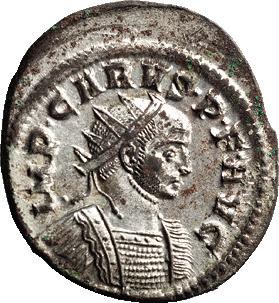



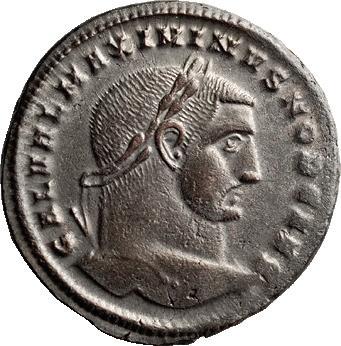
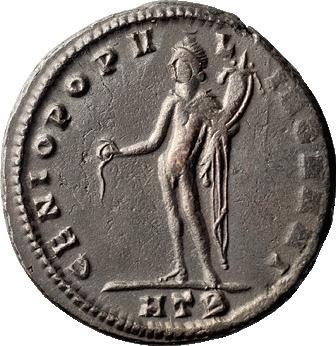
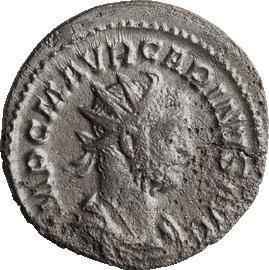
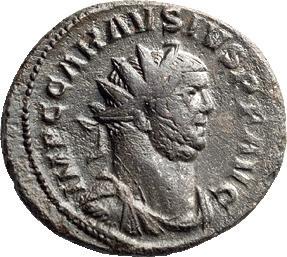



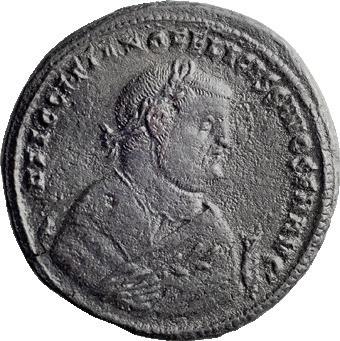
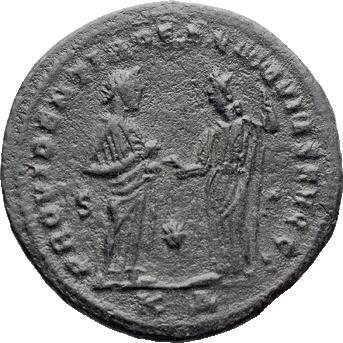





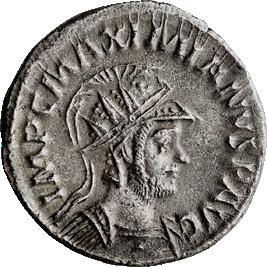

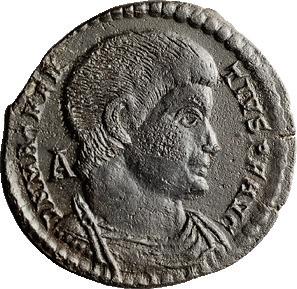
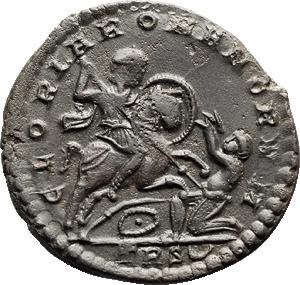
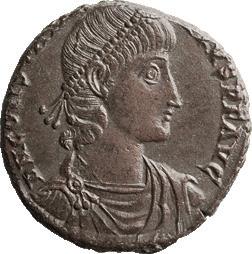
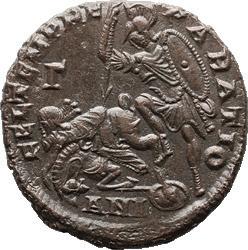
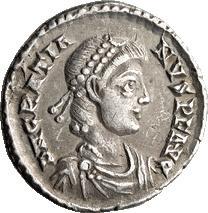
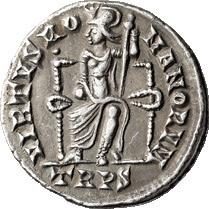

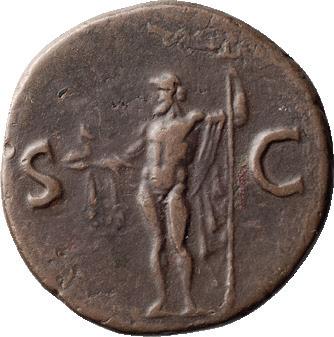
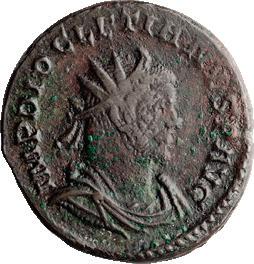
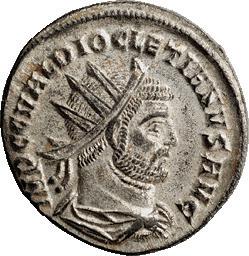

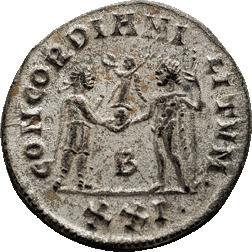


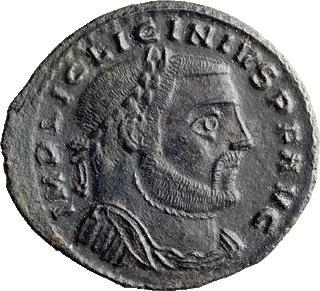


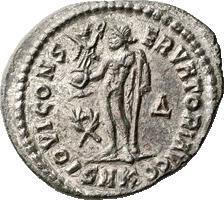

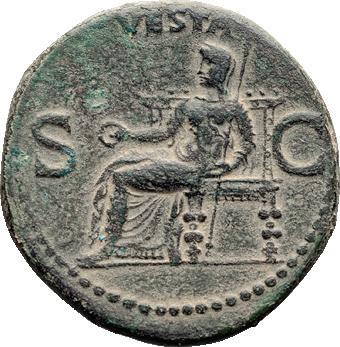
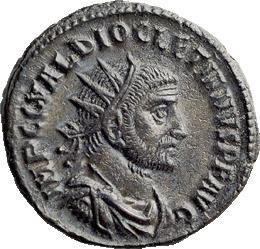
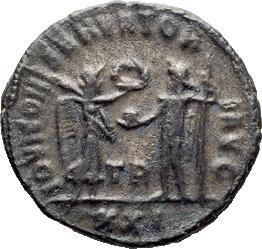

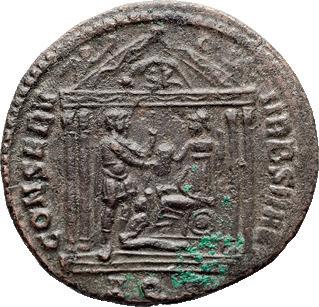
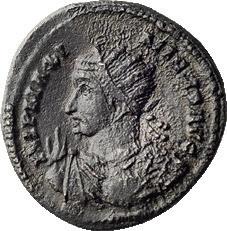

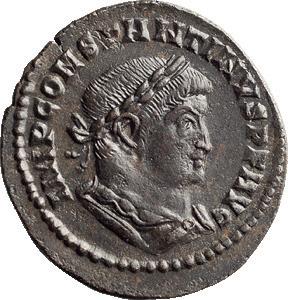

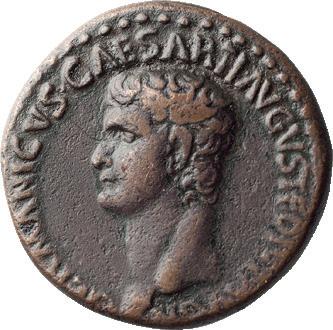
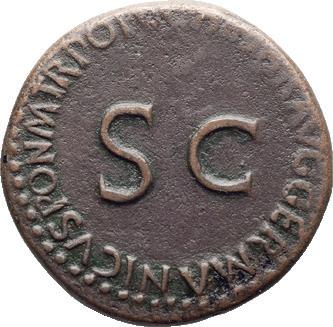
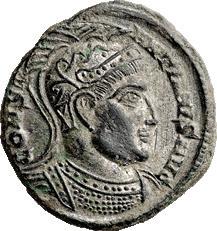
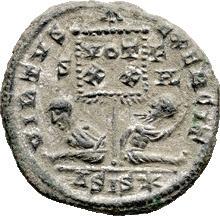
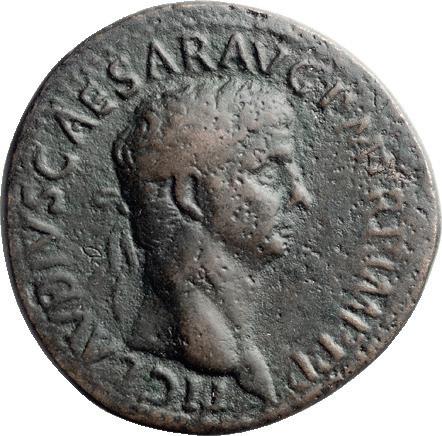
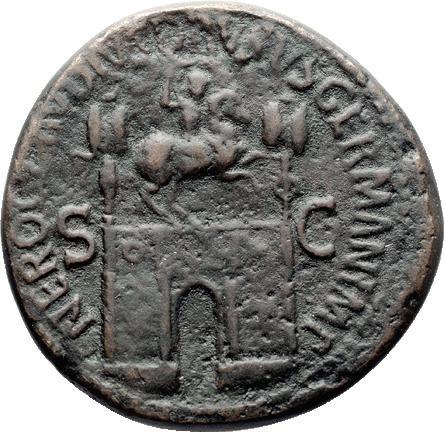
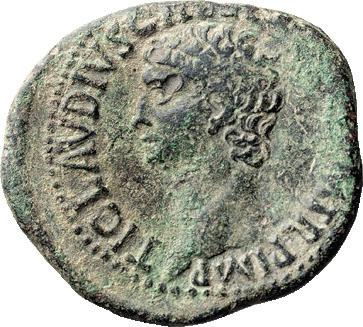
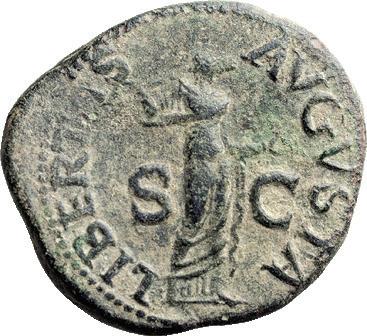
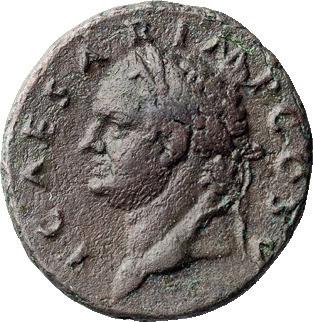
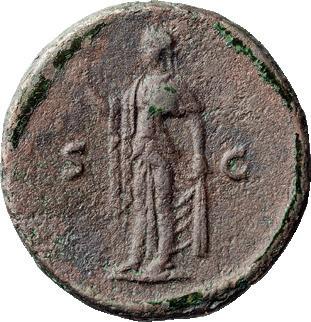

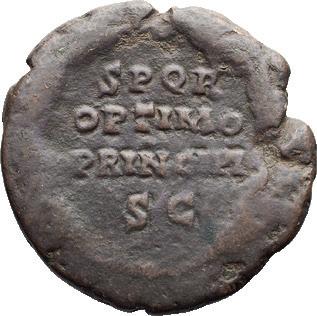

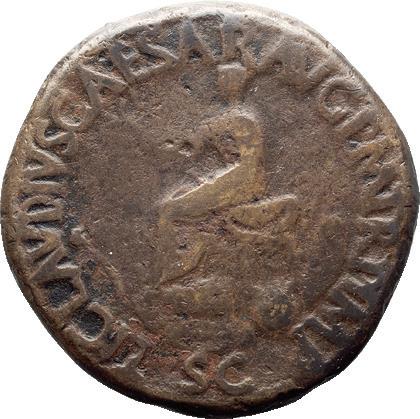
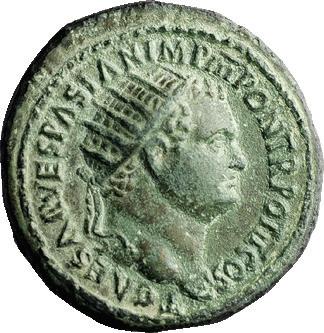
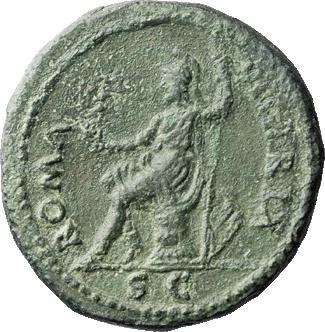
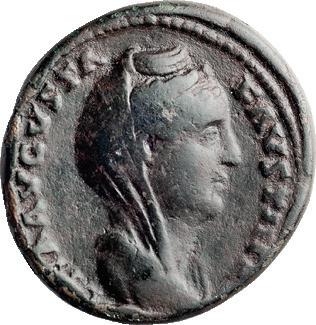






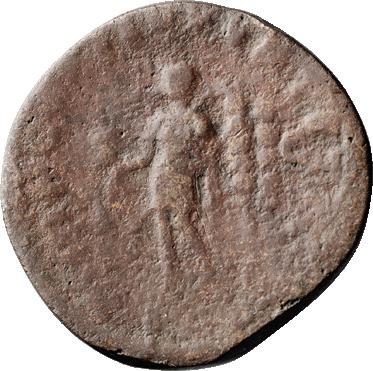
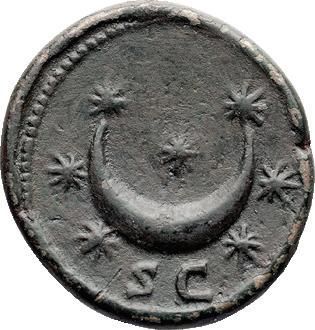

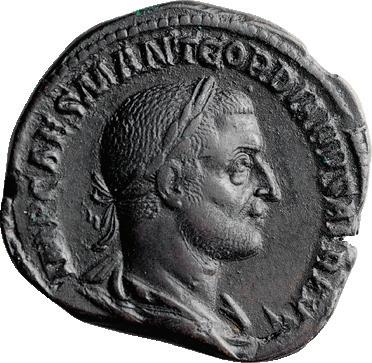
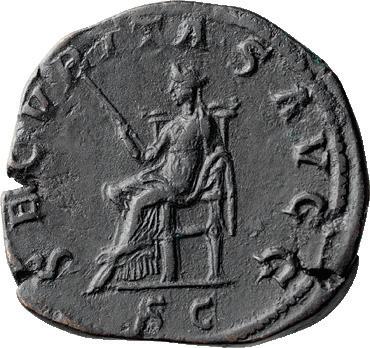

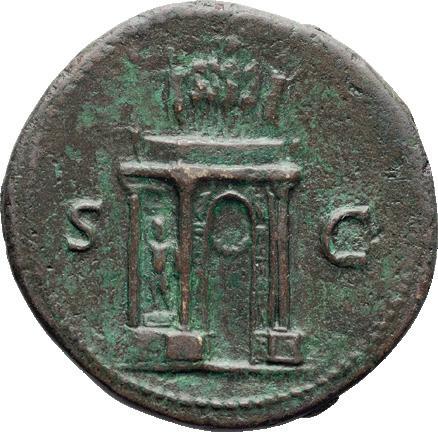

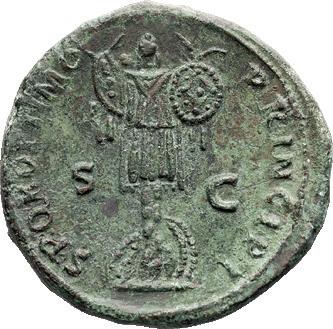

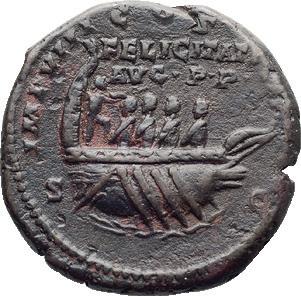
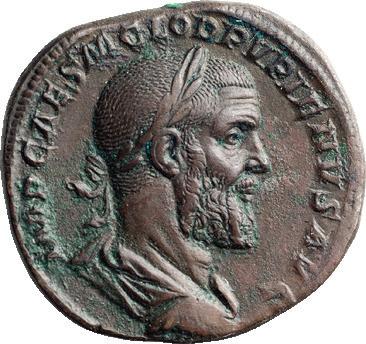

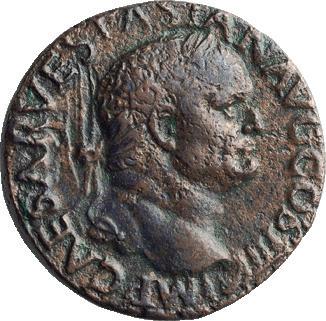

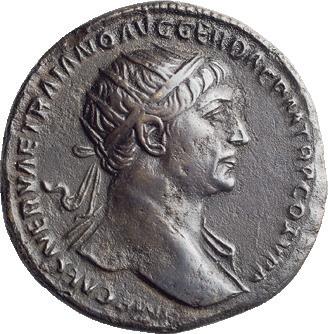

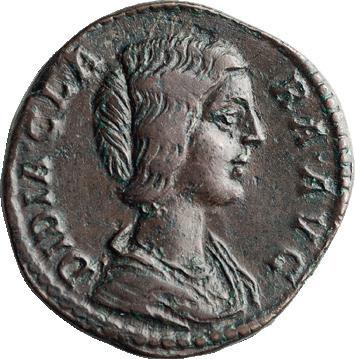


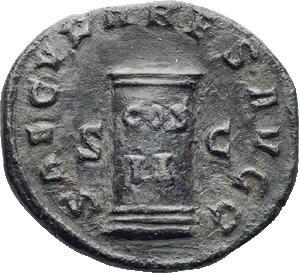
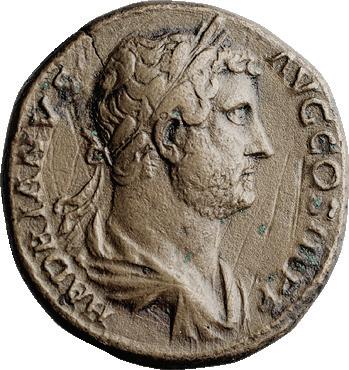
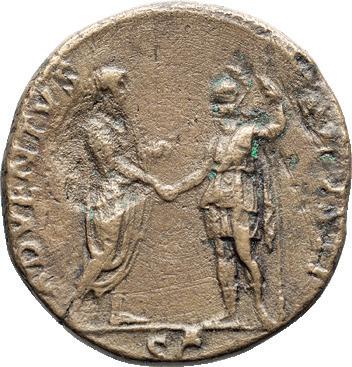
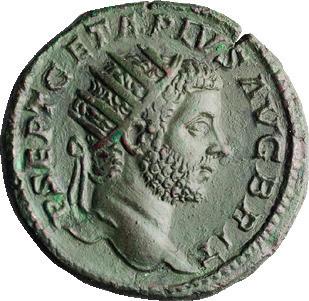
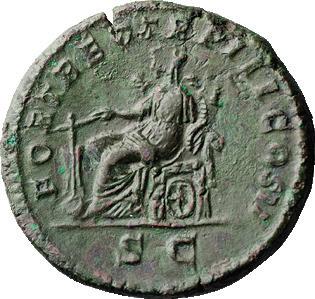
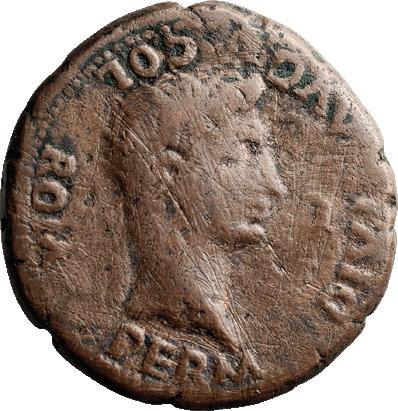

Head laureate r. Rx: FELICITAT[I] / AVG P P in two lines in field, IMP VIII on l., COS above, [III] on l., S - C on l. and r. below, Galley r. with four oarsmen and Neptune standing under arch in stern. Commemorates the emperor’s survival of near shipwreck during his return to Rome from the East in fall 176 AD. This is an excellent example of this type, generally relating to the return of the emperor. EF / VF 800
Didia Clara
463. DIDIA CLARA, DAUGHTER OF DIDIUS JULIANUS; Rome, Sestertius, 21.31g. BM-38, pl. 4.7 (same rev. die); C-4 (50 Fr.); RIC-20 (R2). Obv: DIDIA CLA - RA AVG Bust draped r. Rx: HILA - R TEMPOR S - C Hilaritas standing l. holding long palm and coruncopia. From A.M. Woodward’s obverse die 2, Coinage of Didius Julianus and His Family, Num. Chronicle 1961, p. 80 and pl. 10.2. This is an absolutely exquisite portrait of the daughter of Didius Julianus. Beautifully centered on a warm brown flan. The obverse is nearly EF. The reverse the same, except for a flat strike on the head of Hilaritas which is normal for this issue. The quality and patination of this coin suggest that it comes from an old collection, but we have not yet found it illustrated in any earlier auction catalogue. aEF 10000 Circus Maximus
464. CARACALLA; 198-217 AD, Rome, 213 AD, Sestertius, 23.92g. BM-251, RIC500a (R3), C-236 (60 Fr.). Obv: M AVREL ANTONIN[VS AVG] PIVS BRIT Bust laureate, draped, cuirassed r. Rx: P M TR P X[VI I]MP II around, COS IIII P P / S C in exergue, Circus Maximus, showing front wall with large entrance arch and eleven smaller arches; back wall with spectators, temple with altar before it, and top of arch surmounted by statues on r.; r. end wall topped by starter’s lodge and statues; triumphal arch surmounted by statue of emperor in quadriga at l. end; spina with turning posts at ends, obelisk in middle, plus apparatus with dolphins for numbering laps and statue atop column; finally in the arena at r., as though just emerging from the starting gates, three racing chariots. This coin has an ancient hole in it, meaning that a Roman must have wanted to wear it. Ignoring the hole, the portrait is a good EF, and the reverse a strong VF. Without the hole, a coin like this would go for about $20,000. gVF SOLD (NOT IN PHOTO PLATES)
Incredible portrait
465. GETA AS AUGUSTUS; Rome, 211 AD, Dupondius, 11.73g. BM-270, pl. 62.6 (same obv. die). Obv: P SEPT GETA PIVS AVG BRIT Head radiate r. Rx: FORT RED TR P III COS II around, S C in exergue, Fortuna Redux seated l. holding rudder on globe and cornucopia, wheel under seat. Struck before the arrival in Rome of news of Septimius Severus’ death in York on 4 February 211, since Geta has not yet assumed the title Pater Patriae. Rare with just SEPT rather than SEPTIMIVS in Geta’s obverse legend. This is the most flawless portrait of Geta that we’ve ever owned. Olive patination. MS 4000
466. MAXIMUS AS CAESAR; 235-238 AD, Rome, 236-8 AD, Sestertius, 17.98g. BM213, C-14 (10 Fr.), RIC-13. Obv: MAXIMVS CAES GERM Bust draped r., head bare. Rx: [PRIN]CIPI IVVENTV[TIS] around, S - C across field, Prince standing l. by two standards, holding baton and spear. F 170 Unimprovable Gordian I Africanus
467. GORDIAN I AFRICANUS; 238 AD, Sestertius, Rome, 20.73g. BM-12, C-11 (70 Fr.), RIC-11 (R). Obv: IMP CAES M ANT GORDIANVS AFR AVG Bust laureate, draped, cuirassed r. Rx: SECVRITAS AVGG around, S C in exergue, Securitas seated l. holding scepter. Ex Gemini XII, 11 January 2015, lot 396. Portraits of Gordian I Africanus are scarce but normally available only in VG-Fine, sometimes in VF. This coin is absolutely EF and bears a wonderful portrait of the aged emperor with complete obverse and reverse legends despite not being perfectly round. Choice EF 10000
Exquisite Pupienus
468. PUPIENUS; 238 AD, Rome, Sestertius, 19.28g. BM-49, pl. 46 (same rev. die); C-23 (15 Fr.); RIC-22a (S). Obv: IMP CAES M CLOD PVPIENVS AVG Bust laureate, draped, cuirassed r. Rx: PAX - PVBLICA around, S C in exergue, Pax seated l. holding branch and scepter. Ex Gemini VIII, 14 April 2011, lot 404; ex Spink, July 2000, G. Powell Collection, lot 1452. Choice EF 10000 Millennium Type 469. PHILIP II AS AUGUSTUS; 247-249 AD, Rome, 248 AD, Dupondius, 7.54g. RIC-265c. Obv: IMP M IVL PHILIPPVS AVG Bust radiate, draped, cuirassed r. Rx: SAECVLARES AVGG around, Low column inscribed COS / II, S - C across field. You normally don’t see Millennium Types of Philip II; an interesting rarity. EF 400 470. DIVUS AUGUSTUS AND DIVA LIVIA; Romula, Spain, AE 33, 24.94g. RPC-73, Sear-551. Obv: PERM - DIVI - AVG - COL - ROM Radiate head of Divus Augustus r., [star] above, [thunderbolt] before. Rx: IVLIA AVGVSTA GENETR[IX] - ORBIS Head of Livia l. on globe, [crescent] above. An interesting reverse type associating Livia with cosmic symbols (globe and crescent) and calling her “the mother of the world”. EF 150 471. GALBA; 68-69 AD, Alexandria, Egypt, Aug 28, 68 AD, Tetradrachm, 13.10g. Giessen-219, Köln-219. Obv. Laureate head r. Rx. Veiled bust of Eirene. F 350 472. ANTONINUS PIUS; 138-161 AD, Neapolis, Samaria, Year [88] = 159/60 AD, AE 32, 19.97g. SNG ANS-965, Sear-1506. Obv: AVTOK KAICAP ANTWNINOC CEBAC EVCE Bust laureate, draped r. Rx: ΦΛ NEAC ΠOΛEWC CVPIAC ΠAΛAICTINHC, probable date ET ΠH in exergue is illegible, Mt. Gerizim, consisting of two peaks, the broad peak on l. surmounted by a temple and an altar and with a stairway leading to the top, the narrow peak on r. surmounted by an altar only; at ground level, below the mountain, a colonnade. F 2100 473. CARACALLA; 198-217 AD, Pautalia, Thrace, AE 28, 13.56g. BM-30. Obv: Head of Caracalla laureate r. Rx: Coiled serpent with fish’s tail and radiate, nimbate head r.; around, city name in Greek with usual epithet “Ulpian”. aEF 250 474. GORDIAN I AFRICANUS; 238 AD, Alexandria, Tetradrachm, 12.03g. RPC3640. Obv: Bust laureate, draped, cuirassed r., seen from front. Rx: Zeus seated l., holding patera and scepter; eagle at feet; L A (date) in upper l. Formerly encapsulated; NGC 2400913-007, strike 5/5, surface 4/5. gVF 1200 475. VISIGOTHS IN SPAIN; Hispalis (Seville) mint, c. 650 AD, AE Pentanummium, 1.75g. Cf. Crusafont i Sabater-Group B type 21, 26, 121-124. Obv: Crude facing bust Rx: Cross; Ƨ - P across field. F 245 476. NEMFIDIUS, PATRICIAN OF PROVENCE; Merovingian. Nemfidius,
Patrician of Provence, c. 700-710 AD. Marseilles, AR Denier, 1.08g. MEC-558. Obv: Bust r., cross behind. Rx: HEF across field, cross above, cross below, border of dots. Fine 400
BYZANTINE BRONZE
477. BASIL II AND CONSTANTINE VIII; ca. 977-989 AD, Miliaresion, 3.18g. DO17b. Obv. Єn tOVtΩ hICAt’-bASILЄIC CΩhSt’, cross-crosslet, x in center, pellet within crescent on shaft, set on globe on four steps; crowned bust of Basil II facing (on l), with short beard, wearing loros, and crowned and draped bust of Constantine VIII facing (on r), beardless, wearing chlamys, all within triple border. Rx. + bASIL’ / C CΩhSTAh’ / ΠORFVROS’ / ΠISTOIbAS’ / RΩmAIΩ’, legend in five lines; diamond of four pellets above and below, all in triple border. VF 275 478. JUSTINIAN I, 527-565 AD; Constantinople, Year 12=538/9 AD, Follis, 23.80g. DO-37a, Hahn-95a, Sear-163. Obv. D N IVSTINIANVS P P AVG, helmeted and cuirassed bust facing, holding globus cruciger and shield, cross in r. field. Rx. Large M, cross above, ANNO in l. field, XII in r., A below; CON in exergue. Ex Harlan J Berk, Ltd Buy-Bid Sale Group 1001, Lot 479, Aug 2004. EF. EF 500 479. JUSTINIAN I, 527-565 AD; Antioch/Theoupolis, Year 31=557/8 AD, Follis, 19.20g. DO-227b. Obv: DN IVSTINIANVS PP AVG, diademed, draped, and cuirassed bust of Justinian I facing. Rx: Large M, cross above, ANNO to left, “XXXI” to r, letter r below; in exergue, THϵUP. Ex Harlan J Berk, Ltd Buy-Bid Sale 140, Lot #513 Oct 2004. Nearly EF. Nearly EF 250 480. ANDRONICUS I; Constantinople, Sept 1182- Sept 1185, Aspron Trachy, 4.21g. S-1985, BN-3-13. Obv: The Virgin Mary standing facing on daïs, holding bust of Holy Infant. Rx: Andronicus standing facing, holding labarum and globus cruciger, and being crowned by Christ to right. aEF 70 481. ANDRONICUS II AND MICHAEL IX; Constantinople, 1282-1328 AD, Basilikon, 2.16g. DO-53, Sear-2402. Obv: Christ enthroned, star in field to l. and r. Rx: The emperors standing holding labarum between them, legend “Emperors of the Romans”. Unevenly struck, which is not unusual for this issue. EF 200 BACTRIAN FROM THE MACDONALD COLLECTION
482. BACTRIA, APOLLODOTOS I, C. 160-150 BC; Lifetime issue, AE 21x19, 8.50g. Bopearachchi-6F. Obv: Apollo standing facing, holding bow and arrow. Rx: Tripod surrounded by border of dots, inscription around, monogram in inner r. field. Scarce variety; we find one on Coin Archives. Ex collection of Prof. David MacDonald. EF 150 483. BACTRIA, APOLLODOTOS I, C. 160-150 BC; Posthumous issue, AE 22, 7.59g. Bopearachchi-6R. Obv: Apollo standing facing, holding bow and arrow. Rx: Tripod surrounded by border of dots, inscription around, monogram in inner r. field. Scarce variety; we find none on Coin Archives. Ex collection of Prof. David MacDonald. gVF 125
484. BACTRIA, MENANDER, C. 155-130 BC; Tetradrachm, 9.85g. Bopearachchi15A. Obv: Draped bust of king r., wearing helmet adorned with wing and pelt of scales. Rx: Athena advancing l., monogram in r. field. Ex collection of Prof. David MacDonald. MS 1200 485. BACTRIA, MENANDER, C. 155-130 BC; Drachm, 2.45g. Bopearachchi-3B. Obv: Diademed heroic bust of king l., wearing aegis and brandishing spear. Rx: Athena advancing l., monogram in r. field. Ex collection of Prof. David MacDonald. Virtually MS 275 486. BACTRIA, MENANDER, C. 155-130 BC; Drachm, 2.42g. Bopearachchi-13B. Obv: Diademed and draped bust r. Rx: Athena advancing l., monogram in r. field. Ex collection of Prof. David MacDonald. Toned about ms 225 Wonderful Sensaitive Portrait
487. BACTRIA, STRATO I, C. 105-80 BC; Drachm, 1.91g. Bopearachchi-27D. Obv: Diademed and draped bust r. Rx: Athena l., brandishing thunderbolt and holding shield; Karosthi legend around, monogram in lower l. field. Ex collection Prof. David MacDonald. MS 700 488. BACTRIA, STRATO I, C. 105-80 BC; Rectangular AE 24x19, 9.71g. Bopearachchi-31D. Obv: Apollo standing facing. Rx: Tripod, monogram in l. field. Ex collection Prof. David MacDonald. gVF 400 489. BACTRIA, LYSIAS, C. 130-125 BC; Drachm, 2.45g. Bopearachchi-4C. Obv: Diademed and draped bust r., wearing elephant skin. Rx: Herakles standing facing, crowning himself and holding club, palm, and lion’s skin; monogram in lower l. field. Ex collection Prof. David MacDonald. MS 750
490. BACTRIA, ANTIALCIDAS, C. 115-95 BC; Drachm, 1.67g. Bopearachchi9A. Obv: Diademed and draped bust r. Rx: Zeus seated l.; at his feet, forepart of elephant l., with trunk raised; monogram beneath throne. Ex collection Prof. David MacDonald. MS 800
491. BACTRIA, ANTIALCIDAS, C. 115-95 BC; Drachm, 2.44g. Bopearachchi12A. Obv: Draped bust r., wearing helmet. Rx: Zeus seated l.; at his feet, forepart of elephant l., with trunk raised; monogram in r. lower field. Ex collection Prof. David MacDonald. MS 200
492. BACTRIA, ANTIALCIDAS, C. 115-95 BC; Drachm, 2.44g. Bopearachchi-13A. Obv: Draped bust r., wearing kausias. Rx: Zeus seated l.; at his feet, forepart of elephant l., with trunk raised; monogram in r. lower field. Ex collection Prof. David MacDonald. gEF 150 493. BACTRIA, ANTIALCIDAS, C. 115-95 BC; Drachm, 2.46g. Bopearachchi-13D. Obv: Draped bust r., wearing kausias. Rx: Zeus seated l.; at his feet, forepart of elephant l., with trunk raised; monogram beneath throne. Ex collection Prof. David MacDonald. Obverse softly struck. MS 250 494. BACTRIA, ANTIALCIDAS, C. 115-95 BC; Plated Drachm, 1.92g. Bopearachchi10A. Obv: Diademed and bust r. Rx: Zeus seated l.; at his feet, forepart of elephant r.; monogram beneath throne. Ex collection Prof. David MacDonald. Virtually MS 150 495. BACTRIA, ANTIALCIDAS, C. 115-95 BC; Square AE 17, 8.14g. Bopearachchi17A. Obv: Bust of Zeus r., thunderbolt over shoulder. Rx: Two palm branches between caps of Dioscuri; monogram to l. Σ to r. Ex collection Prof. David MacDonald. VF 200
496. BACTRIA, PHILOXENOS, C. 125-110 BC; Square Drachm, 2.47g. Bopearachchi-6D. Obv: Diademed, draped, and cuirassed bust r., wearing helmet decorated with bull’s horn and ear. Rx: King on horse rearing r., Σ to lower l.,

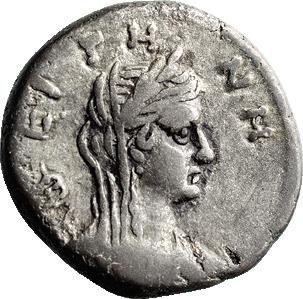


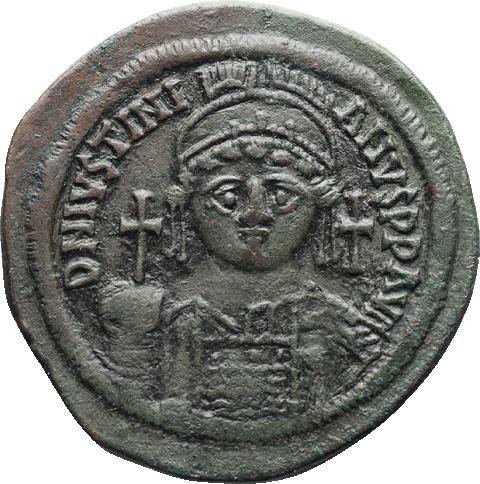


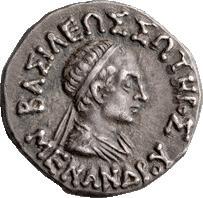
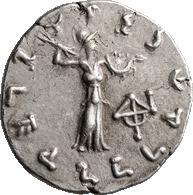
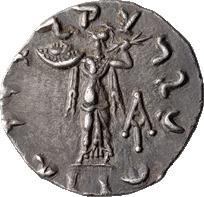
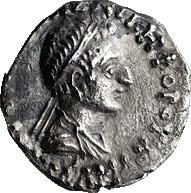



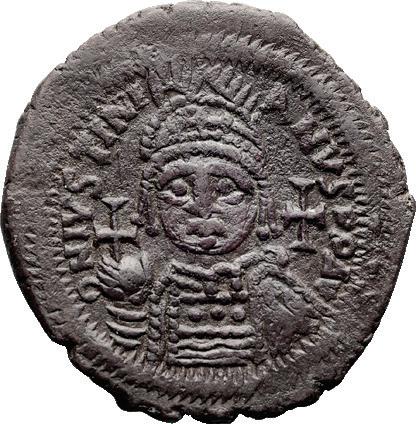




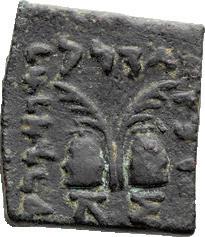
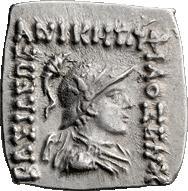
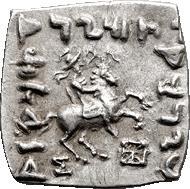

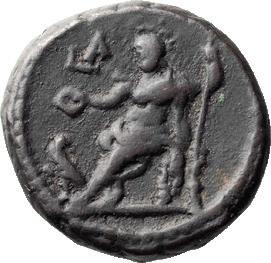
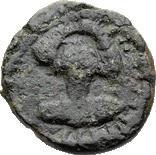
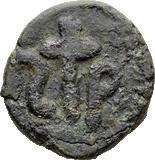
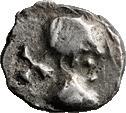


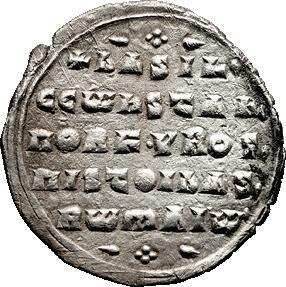
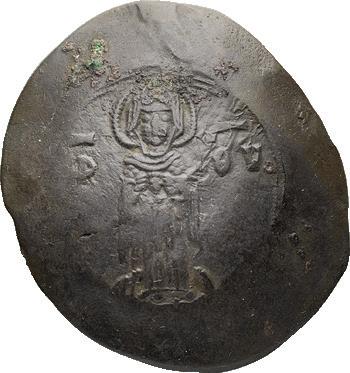
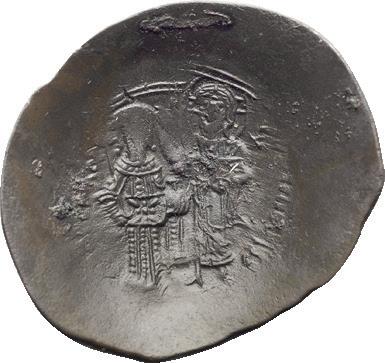
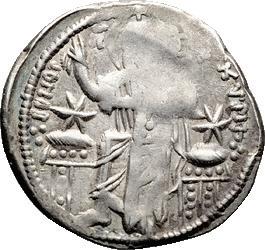
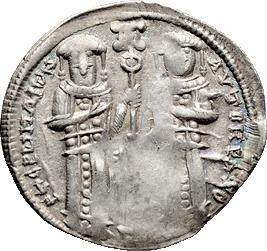
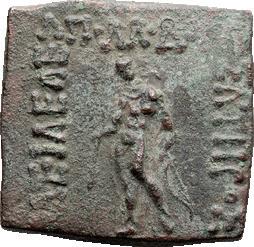
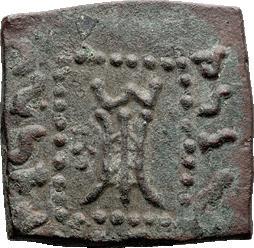
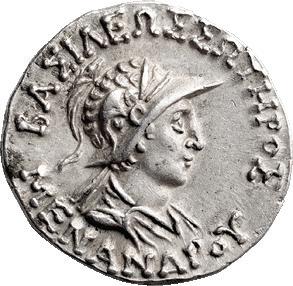
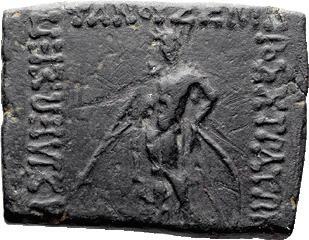
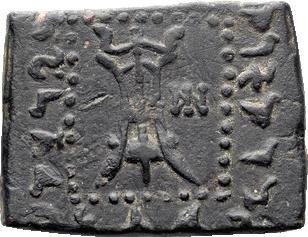

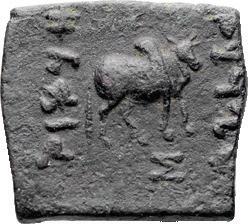

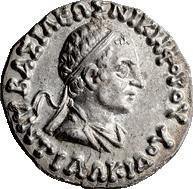




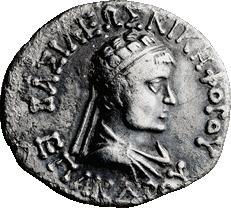
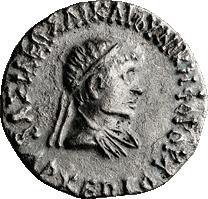
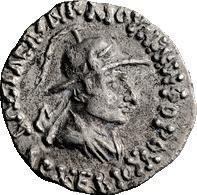
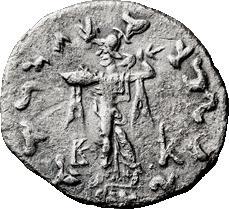
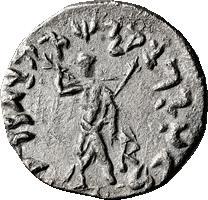
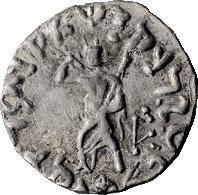

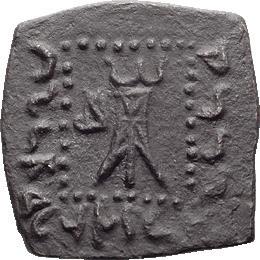
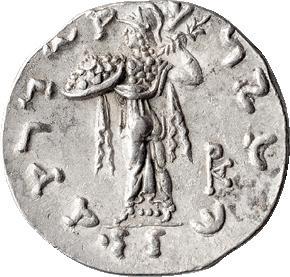
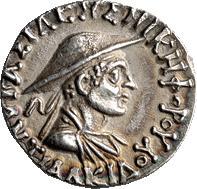



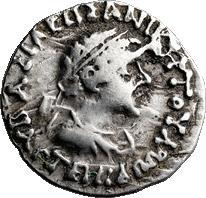
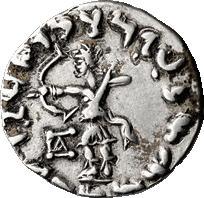


monogram to lower r. Ex collection Prof. David MacDonald. MS 400 497. BACTRIA, PHILOXENOS, C. 125-110 BC; AE 20, 7.47g. Bopearachchi-10G. Obv: Tyche standing l., holding cornucopia; monogram in lower l. field. Rx: Humped bull standing r. Ex collection Prof. David MacDonald. gVF 125 498. BACTRIA, EPANDER, C. 80-75 BC; Drachm, 1.91g. Bopearachchi-Series 1 var; cf 2B for this monogram pair on AE. Obv: Diademed and draped bust r. Rx: Athena l., brandishing thunderbolt and holding shield; Karosthi legend around, monograms to either side. Ex collection Prof. David MacDonald. Extremely rare. VF 1000
500. BACTRIA, ARCHEBIUS, C. 75-65 BC; Drachm, 2.10g. Bopearachchi-3C. Obv: Diademed and draped bust r. Rx: Zeus standing facing, brandishing thunderbolt and holding scepter; monogram in r. field. Ex collection Prof. David MacDonald. Light porosity. EF 400
501. BACTRIA, ARCHEBIUS, C. 75-65 BC; Drachm, 2.15g. Bopearachchi-5A. Obv: Diademed and draped bust r., wearing helmet. Rx: Zeus standing facing, brandishing thunderbolt and holding scepter; monogram in r. field. Ex collection Prof. David MacDonald. aEF 250
502. BACTRIA, ARTEMIDORUS, C. 100-80 BC; Drachm, 2.34g. BopearachchiSeries 3 var (monogram). Obv: Diademed and draped bust r. Rx: Artemis standing left, shooting bow; monogram in l. field. Ex collection of Prof. David MacDonald. Bold Fine / gVF 1000 Extremely Rare
503. BACTRIA, ARTEMIDORUS, C. 100-80 BC; Drachm, 2.39g. Bopearachchi-6C var (monogram). Obv: Diademed and draped bust r. Rx: Nike standing r., holding wreath; monogram in r. field. Ex collection of Prof. David MacDonald. Struck with worn die. Fine / aEF 750
Exquisite Lifelike Portrait
504. BACTRIA, HERMAEUS, C. 90-70 BC; Tetradrachm, 9.78g. Bopearachchi-. Obv: Diademed and draped bust r. Rx: Zeus seated l., monogram in r. field. Unlisted in Bopearachchi, but see 11Q for this control on a drachm. Ex collection of Prof. David MacDonald. Extremely rare. MS 2500
505. BACTRIA, HERMAEUS, C. 90-70 BC; Drachm, 2.00g. Bopearachchi-11L. Obv: Diademed and draped bust r. Rx: Zeus seated l., monogram in r. field. Ex collection of Prof. David MacDonald. MS 425
506. BACTRIA, HERMAEUS, C. 90-70 BC; Drachm, 2.33g. Bopearachchi-11P. Obv: Diademed and draped bust r. Rx: Zeus seated l., monogram in r. field. Ex collection of Prof. David MacDonald. Crude portrait. MS 225 507. BACTRIA, HERMAEUS, C. 90-70 BC; Drachm, 2.12g. Bopearachchi-15B. Obv: Diademed and draped bust r. Rx: Zeus seated l., monogram in r. field. Ex collection of Prof. David MacDonald. MS 150 Extremely Rare Type 508. BACTRIA, TELEPHUS, C. 80-70 BC; Drachm, 1.53g. Bopearachchi-1A. Obv: Anguipede facing, limbs terminating in lotus blossoms. Rx: Helios, radiate and holding scepter, standing l., and Selene, wearing crescent diadem, standing r.; monogram in r. field. Ex collection Prof. David MacDonald. VF 850 509. BACTRIA, APOLLODOTOS II, C. 80-65 BC; Tetradrachm, 9.33g. Bopearachchi-3B. Obv: Draped bust r. Rx: Athena advancing l., monogram in l. field. Ex collection of Prof. David MacDonald. EF 1000 510. BACTRIA, APOLLODOTOS II, C. 80-65 BC; Drachm, 1.93g. Bopearachchi-1D var (monogram position). Obv: Draped bust r. Rx: Athena advancing l., monogram in r. field. Ex collection of Prof. David MacDonald. Crudely-cut die. aEF 225 511. BACTRIA, APOLLODOTOS II, C. 80-65 BC; Drachm, 2.02g. Bopearachchi2D. Obv: Draped bust r. Rx: Athena advancing l., monogram in l. field. Ex collection of Prof. David MacDonald. VF 250 512. BACTRIA, DIONYSIOS, C. 55-45 BC; Drachm, 2.28g. Bopearachchi-1A. Obv: Diademed and draped bust r. Rx: Athena standing l., brandishing thunderbolt and aegis; monogram in r. field. Very rare. Prof. MacDonald cites this as the eighth recorded specimen, but a few others have since appeared. Bopearachchi cites six examples; we find four others on Coin Archives, so this is perhaps the eleventh known silver coin of this elusive king. Ex collection Prof. David MacDonald. Struck with worn die. Bold Fine 500 513. BACTRIA, ZOILOS II, C. 55-35 BC; Drachm, 1.78g. Bopearachchi-1A. Obv: Diademed and draped bust r. Rx: Athena advancing l., monogram in r. field. Ex collection of Prof. David MacDonald. Toned EF 200 514. BACTRIA, ZOILOS II, C. 55-35 BC; Drachm, 2.25g. Bopearachchi-1E. Obv: Diademed and draped bust r. Rx: Athena advancing l., monogram in r. field, Karosthi letter in l. field. Ex collection of Prof. David MacDonald. aEF 500 515. BACTRIA, ZOILOS II, C. 55-35 BC; Drachm, 1.88g. Bopearachchi-1K. Obv: Diademed and draped bust r. Rx: Athena advancing l., BO in . field, monogram and Karosthi letters in r. field. Ex collection of Prof. David MacDonald. Crude die. EF 400
516. BACTRIA, APOLLOPHANES, C. 35-25 BC; Drachm, 1.98g. Bopearachchi-1A. Obv: Helmeted and draped bust r. Rx: Athena advancing l., monogram in r. field. Ex collection of Prof. David MacDonald. Light porosity. aEF 2000
517. BACTRIA, APOLLOPHANES, C. 35-25 BC; Drachm, 2.13g. Bopearachchi1B. Obv: Diademed and draped bust r., wearing helmet. Rx: Athena standing l., monogram in r. field. Ex collection of Prof. David MacDonald. EF 2000 518. BACTRIA, STRATO II, C. 25 BC-10 AD; Drachm, 1.94g. Bopearachchi-2F. Obv: Diademed and draped bust r. Rx: Athena standing l. Ex collection Prof. David MacDonald. EF 150 519. BACTRIA, STRATO II & STRATO III, C. 25 BC - 10 AD; Drachm, 1.94g. Bopearachchi-Series 6, 1. Obv: Diademed and draped bust r. Rx: Athena standing l. Ex collection Prof. David MacDonald. EF 200 520. BACTRIA, STRATO III, C. 10 AD; Drachm, 1.97g. Bopearachchi-Series 1 var (as Strato II). Obv: Diademed and draped bust r. Rx: Athena standing l., monogram in r. field, Karosthi letters to either side. Ex collection Prof. David MacDonald. EF 200 521. BACTRIA, STRATO III, C. 10 AD; Drachm, 2.24g. Bopearachchi-Series 1 var (as Strato II), Mitchiner-468e. Obv: Diademed and draped bust r. Rx: Athena standing l., monogram in r. field, Karosthi letters to either side. Ex collection of Prof. David MacDonald. Crudely-cut die. EF 200
522. INDO-SCYTHIANS, AZES I, C. 60-20 BC; Tetradrachm, 8.49g. Senior-82.312. Obv: King r. on horse r., Karosthi letter before. Rx: City goddess standing l., monogram and Karosthi letter in l. field, Karosthi letter in right field. Ex collection of Prof. David MacDonald. gEF 275 523. INDO-SCYTHIANS, AZES I, C. 60-20 BC; Tetradrachm, 8.51g. Senior-98.424. Obv: King r. on horse r., Karosthi letter before. Rx: Athena standing r., Φ above Greek monogram in l. field; in r. field, Karoshthi monogram. Ex collection of Prof. David MacDonald. Virtually MS 225 524. INDO-SCYTHIANS, AZES I, C. 60-20 BC; Drachm, 2.33g. Senior-76.1. Obv: Zeus standing l. rx: Nike standing r., monogram in r, field. Ex collection of Prof. David MacDonald. Virtually MS 250 525. INDO-SCYTHIANS, AZES I, C. 60-20 BC; Drachm, 1.93g. Senior-90.27. Obv: King r. on horse r. Rx: Athena standing r., monogram in l. field; Karoshthi letter in r. field. Ex collection of Prof. David MacDonald. aEF 100 526. PAURAVAS IN THE PUNJAB; Late 2nd-1st century BC, BI Karshapana of 32 rattis, 4.38g. Mitchiner-vol. 7, 959, BMCAI-35-6. Obv: Lion standing r. with raised tail; inscription around. Rx: Fenced-in tree, monograms around. The Pauravas are best known for their early king Porus, whose narrow and hard-fought defeat by Alexander inspired the latter’s famed elephant decadrachms. According to Mitchiner, by the time the present rare coin was struck, the Pauravas lived further east. Extremely rare; we find only one other sale, in Roma E95, lot 615 (1,400 GBP hammer.) Ex collection of Prof. David MacDonald. gVF 1750
527. COLCHIS, DIOSCOURIAS (BLACK SEA); ca. 105-90 BC, Trichalkon AE, 6.40g. SNG BM-1021, Sear-3629, HGC-7, 205, SNG Cop-102/3. Obv. Caps of the Diosuri surmounted by stars. Rx. Arranged cross field in three lines, divided by upright thyrsus:
Ex coll. of Prof. David MacDonald, 2025. Dark green toning. gVF 300 ROMAN PROIVINCIAL Triskeles with Gorgon
528. AUGUSTUS; 27 BC-14 AD, Panormus, Sicily, AE 23, 10.02g. RPC-641 (44 spec.). Obv: Bare head of Augustus r., ΠAN. behind, upwards. Rx: Triskeles with gorgon face and wheat ears between legs. Ex Collection Prof. David MacDonald. VF / EF 400
529. AUGUSTUS; 27 BC-14 AD, Carthage, Zeugitana, AE 23, 8.72g. RPC-745 (16 spec.). Obv: Head bare of Augustus l. Rx: Circular legend around the four letters P P above D D. Ex Collection Prof. David MacDonald. aEF
400
530. MACEDONIA, AMPHIPOLIS, TIME OF HADRIAN; AE 23, 6.60g. RPC III657a. Obv: Emperor in military dress standing l. holding spear and parazonium. Rx: Artemis Tauropolos on bull r., holding billowing veil. This type has generally been attributed to Augustus. Doubts have lingered however, resulting in its exclusion from RPC I. The editors of RPC III initially also declined to include it, but it’s now been added to the online version as 657a. Ex collection of Prof. David MacDonald. VF 400
531. AUGUSTUS, CYRENAICA AND CRETE; 27 BC-14 AD, AE 28, 12.57g. RPC942, BM-36. Obv: Face to face bare heads of Augustus (on left) and Agrippa (on right), CAESAR TR POT AGRIPPA around. Rx: SCATO PROCOS in laurel wreath. Ex collection of Prof. David MacDonald. F 400 Superb Caesar Portrait
532. AUGUSTUS AND DIVUS JULIUS CAESAR; Thessalonica, Macedonia, Time of Augustus, AE 20.5x23, 11.93g. RPC-1554 (88 spec.). Obv: ΘEOC Wreathed head of Julius Caesar r. Rx: Bare head of Augustus r., mint name ΘECCAΛo - NIKEΩN around. Ex collection of Prof. David MacDonald. Ex Malter list XIX, #R9. While this coin itself is not rare, it is rare to find a Caesar portrait as sharp as this one. aEF 1000
533. MACEDONIA, AMPHIPOLIS; AE 21, 9.44g. RPC-1626, SNG Cop-89. Obv: Bare head right. Rx: Artemis Tauropolos on bull r., holding billowing veil. Ex collection of Prof. David MacDonald. aEF 300
534. AUGUSTUS; 27 BC-14 AD, CA Mint, Asia Minor, AE 24, 10.96g. RPC-2231. Obv: CAISAR Head of Augustus bare r. Rx: AVGV / STVS in two lines in laurel wreath. Ex Collection Prof. David MacDonald. EF 400 535. AUGUSTUS AND LIVIA; Smyrna, Ionia, AE 20, 4.97g. RPC-2466 (74 spec.). Obv: Jugate portraits r. of Augustus, laureate, and Livia, draped. Rx: Aphrodite Stratonikis standing front, leaning on column and holding scepter and Nike; to r., dove. gVF 350
536. AUGUSTUS AND LIVIA, CAIUS AND LUCIUS; Magnesia ad Sipylum, Lydia, AE 20, 4.42g. RPC-2449 (12 spec.). Obv: Jugate portraits of Augustus and Livia r. Rx: Bare heads of Gaius and Lucius Caesars, face to face. Ex Collection Prof. David MacDonald. Bold Fine 250
537. AUGUSTUS AND LIVIA; Smyrna, Ionia, Leontiskos Hippomedontos, c. 10 BC (?), AE 20, 4.87g. RPC-2466 (74 spec.). Obv: Jugate, laureate head of Augustus and draped bust of Livia r. Rx: Aphrodite Stratonikis standing front, holding scepter and Nike, and leaning on column; to r., dove. Ex Collection Prof. David MacDonald. Bold Fine 125 Peacock Reverse
538. AUGUSTUS; 27 BC-14 AD, Samos, Ionia, AE 18, 4.67g. RPC-2681 (20 spec.). Obv: Head of Augustus laureate r. Rx: Peacock standing r. on caduceus, scepter behind. Ex Collection Prof. David MacDonald. It is extremely unusual to find a peacock on a roman coin other than those of deified empresses. EF 500 539. AUGUSTUS; 27 BC-14 AD, Mylasa, Caria, AE 21, 6.47g. RPC-2791 (17 spec.). Obv: Bare head of Augustus r. Rx: Magistrate’s name and title in wreath. Ex Collection Prof. David MacDonald . EF 250 540. AUGUSTUS; 27 BC-14 AD, Mylasa, Caria, AE 22, 6.62g. RPC-2786 (15 spec.). Obv: Bare head of Augustus r. Rx: Head of Zeus Labraundos r. Ex Collection Prof. David MacDonald. gVF 300 541. AUGUSTUS; 27 BC-14 AD, Mylasa, Caria, AE 22, 3.52g. RPC-2790 (2 spec. only, in BM and Berlin). Obv: Bare head of Augustus r. Rx: Head of Zeus Labraundos r. Ex Collection Prof. David MacDonald. Rare. gF 250 542. TIBERIUS AND LIVIA; 14-37 AD, Aphrodisias, Caria, 14-29 AD, AE 19, 3.35g. RPC-2842 (13 spec.). Obv: CEBACTOI Laureate head of Tiberius and draped bust of Livia, jugate r. Rx: Cult statue of Aphrodite; above, star and crescent. Ex Collection




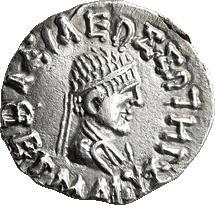
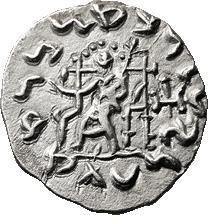
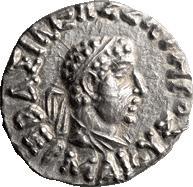
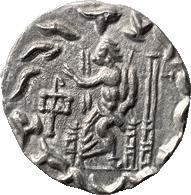
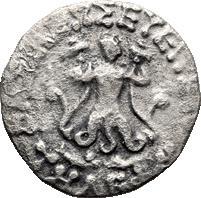



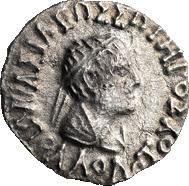

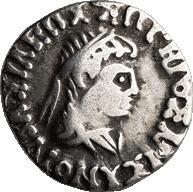
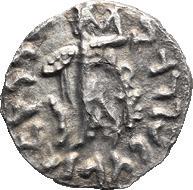
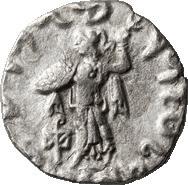

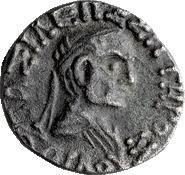
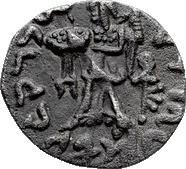

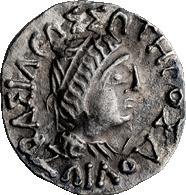
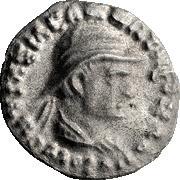


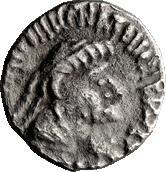
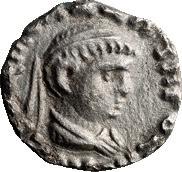
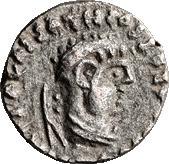

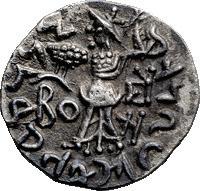

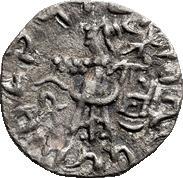
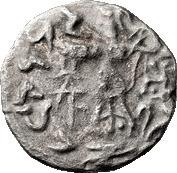

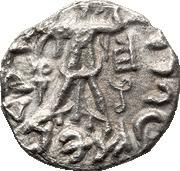



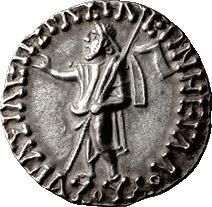
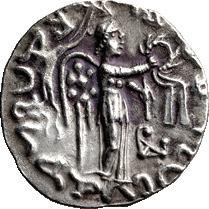

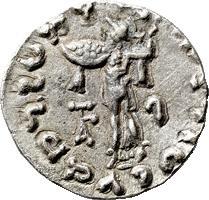
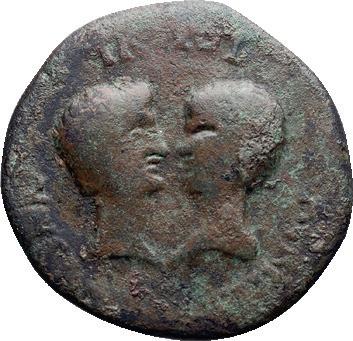

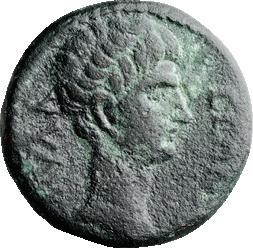
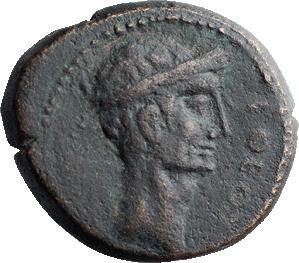



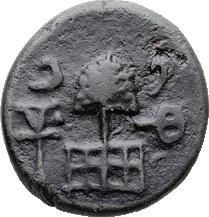




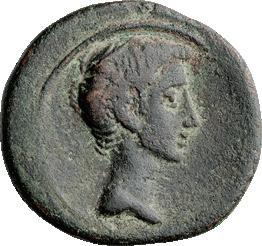
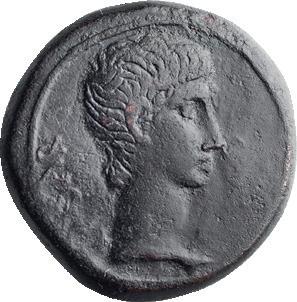

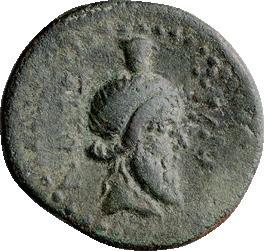
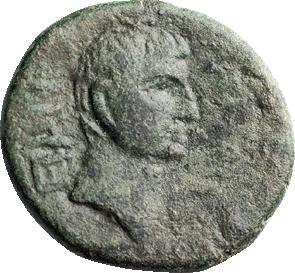




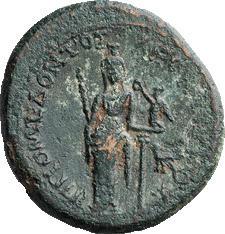
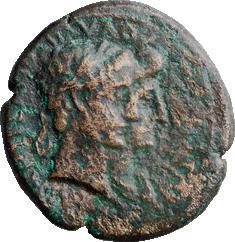
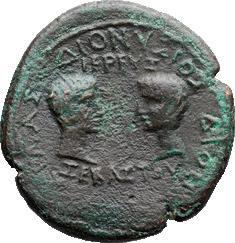


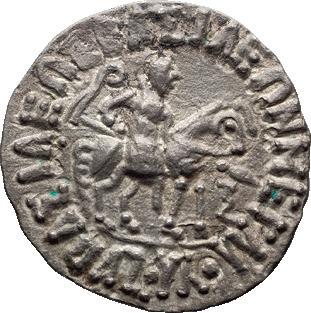

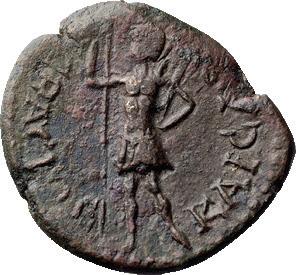


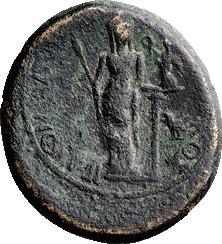

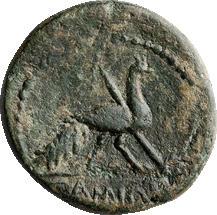


Prof. David MacDonald; acquired from Harlan Berk, with a hand-written Berk ticket (pre-digital) by Curtis Clay. According to RPC p. 466, the reverse legend “Apollonius, son of the Aphrodisians”, suggests that Apollonius may have been a benefactor of the city. VF 400
Impereral portrait in high releif 543. AUGUSTUS OR TIBERIUS; Laodiceia ad Lycum, Phrygia, AE 19, 7.43g. RPC2906 (17 spec.). Obv: Bare head of Augustus or Tiberius r. Rx: Zeus Laodiceus standing l., holding eagle and staff; in r. field, monogram KOP. Ex Collection Prof. David MacDonald. EF 350 544. AUGUSTUS; 27 BC-14 AD, Hierapolis, Phrygia, AE 19, 6.08g. RPC-2947 (2 spec. only, in BM and a Kovacs list). Obv: Head bare of Augustus r. Rx: Tripod. Ex Collection Prof. David MacDonald. Rare. VF 450 545. AUGUSTUS AND GAIUS CAESAR; Apameia, Phrygia, AE 18, 6.23g. RPC3129 (17 spec.). Obv: Head of Augustus laureate r. Rx: Gaius Caesar in facing quadriga. Ex Collection Prof. David MacDonald. VF 300 546. AUGUSTUS; 27 BC-14 AD, Sebaste, Asia, AE 17, 4.14g. RPC-3153, pl. 132 (same obv. die?). Obv: Bare head of Augustus r. Rx: Zeus seated l., holding eagle and scepter. Ex Collection Prof. David MacDonald. gVF 275 547. AUGUSTUS; 27 BC-14 AD, Synnada, Phrygia, AE 18, 6.07g. RPC-3183 (2 spec. only, in BM and Oxford). Obv: Head of Augustus bare r. Rx: Zeus seaed l., holding Nike and scepter. Ex Collection Prof. David MacDonald. Rare. EF 500 548. AUGUSTUS; 27 BC-14 AD, Amorium, Phrygia, AE 19, 6.76g. RPC-3233 (10 spec.). Obv: Bare head of Augustus r.; before neck, lituus. Rx: Eagle standing r. on thunderbolt; in background, caduceus. Ex Collection Prof. David MacDonald Bold portrait. aEF 325 549. AUGUSTUS; 27 BC-14 AD, Antiochia ad Orontem, Seleucis and Pieria, AE 28, 17.80g. RPC-4247. Obv: Head laureate of Augustus r. Rx: Large S C (double-struck in a laurel wreath of eight leaves). Ex Collection Prof. David MacDonald. aEF 300 550. AUGUSTUS; 27 BC-14 AD, Antiochia ad Orontem, Seleucis and Pieria, AE 22-24, 9.79g. RPC-4248. Obv: Head of Augustus laureate r. Rx: Large S C within laurel wreath of eight leaves. Ex Collection Prof. David MacDonald. Obverse in high relief. Choice EF 385
551. AUGUSTUS; 27 BC-14 AD, Gabala, Seleucis and Pieria, 13/14 AD, AE 22, 5.89g. RPC-4452 (8 spec.). Obv: Head bare of Augustus r. Rx: Goddess seated l., holding poppy and long scepter; before her, sphinx. Ex Collection Prof. David MacDonald. VF 300 552. AUGUSTUS; 27 BC-14 AD, Chalcis, Syria, Year 286 = 27/26 BC, AE 19, 4.77g. RPC-4775 (7 spec.). Obv: Head of Augustus bare r. Rx: Head of Zenodorus the Tetrarch bare l. Ex Collection Prof. David MacDonald. Scarce. Magnificent double portrait. Near MS 400 Dolphin Reverse 553. AUGUSTUS; 27 BC-14 AD, Berytus, Phoenicia, AE 18, 7.90g. RPC-4536 (8 spec.). Obv: CAESAR Laureate head of Augustus r. Rx: Dolphin and trident in wreath. Ex Collection Prof. David MacDonald. gVF / EF 375 554. AUGUSTUS; 27 BC-14 AD, Berytus, Phoenicia, AE 15, 3.17g. RPC-4538 (16 spec.). Obv: Eagle standing l., wings half-raised, on [thunderbolt]. Rx: AVG in large letters across field. Ex Collection Prof. David MacDonald. EF 300 555. AUGUSTUS; 27 BC-14 AD, Ascalon, Judaea, AE 22, 12.02g. Cf. RPC-4877 (8 spec.). Obv: Bare head of Augustus r.; on either side, C - E. Rx: Tyche-Astarte standing l. on [prow], holding scepter and aplustre. Ex Collection Prof. David MacDonald. EF 400 556. AUGUSTUS OR TIBERIUS; AE 17, 4.29g. Obv: Bare head of Augustus or Tiberius r. Rx: Zeus seated l., holding patera and scepter. Attribution uncertain. Ex Collection Prof. David MacDonald. VF 250 Roman Mint Quality Portrait 557. TIBERIUS AS CAESAR; 3-14 AD, Lugdunum, Gaul, Semis, 4.62g. BM-578; Giard, Lyon-102, pl.XXVII. Obv: Bare head of Tiberius l. Rx: ROM ET AVG, Altar of Lugdunum. Ex Collection Prof. David MacDonald. The portrait of Tiberius on this coin struck under Augustus is as good as a Roman denarius. EF 300 Only Three Recorded 558. TIBERIUS; 14-37 AD, Apameia, Seleucis and Pieria, Year 326 = 14/15 AD, AE 22-26, 9.48g. RPC-4374 (3 spec. only; 1 in BM and 2 in a Kovacs list). Obv: Head of Tiberius laureate r. Rx: Nike standing l., holding wreath and palm. Ex Collection Prof. David MacDonald. Rare. gVF 425 First Complete Set of Colosseum Sestertii 559. SET OF COLOSSEUM SESTERTII BY TITUS AND DOMITIAN (PLATE COIN IN DAVID HENDIN’S REPRINTING OF 6TH EDITION OF GUIDE TO BIBLICAL COINS); 79-81 AD, Rome, Two coins in lot.
Coin #1: Titus; 79-81 AD, Rome, c. 80-81 AD, Sestertius, 27.99g. BM-190 pl. 50.2 (same rev. die), Paris-189 pl. LXXXI (same dies), RIC-184 (R2), Cohen-400 (80 Fr.). Obv: Colosseum seen from front and above between obelisk on base (Meta Sudans) and porticoed building of two stories (Baths of Titus), without legend. Rx: IMP T CAES VESP AVG P M TR P P P COS VIII S - C Titus seated l. holding branch and roll on curule chair set on globe among arms. Ex Gemini XIII, 6 April 2017, lot 162. From a British collection, acquired in 1978 by Paul Munro Walker, Bournemouth. See N.T. Elkins, The Flavian Colosseum Sestertii, Numismatic Chronicle 166, 2006, p. 216, 6, pl. 31 (our dies). To demonstrate the popular nature of Vepasian’s rule, the Colosseum was built on the site of Nero’s demolished Golden Palace. The reverse type of Titus seated as master of the world (his curule chair set on globe), bringing peace (olive branch) by means of victory over enemies (captured arms), fits well with the recently discovered dedicatory inscription of the Colosseum, stating that the emperors constructed it “from booty” (ex manubis), doubtless chiefly the booty of the Jewish War.
Coin #2: Domitian, Divus Titus; 81-96 AD, Rome, 81 AD, Sestertius, 25.02g. C-399 (80 Fr.), BMC Titus-191 note, RIC-131 (R), pl. 137 (same dies). Will be the plate coin in David Hendin’s 7th edition of his Guide to Biblical Coins, 6625A (PLATE COIN). Obv: No legend. The Flavian amphitheater filled with spectators, seen partly from
above; Meta Sudans to l., two-storied porticus of the Baths of Titus to r. Rx: DIVO AVG T DIVI VESP F VESPASIAN Togate Titus seated l. on curule chair, holding branch and roll, and placing his feet on a captured cuirass; the curule chair rests on a globe, and other captured shields, spears, and a helmet are scattered before, below, and behind the emperor; S C in exergue. Titus himself struck the first Colosseum sestertii, but their production was then briefly continued by Domitian for Divus Titus, using one of the same Colosseum obverse dies that Titus had already used, coupled with two new reverse dies naming Divus Titus. Elkins knew just ten specimens of this Colosseum sestertius struck by Domitian for Divus Titus. To the best of our knowledge, a pair of Colosseum sestertii of this original period has never been offered together. The only other Colosseum coins issued were an exceptionally rare aureus, sestertius, and As issued by Severus Alexander in 223 AD, and bronze medallions struck with several bust varieties under Gordian III.
Further study in the British Numismatic Chronicle of 2006, in an article by Nathan T Elkins, “The Flavian Colosseum Sestertii: Currency or Largess?” shows that our Titus Colosseum is Elkins 7, of which 11 examples are recorded. But in total, there are about 40 examples from all recorded dies. Of Domitian Colosseums, there are 10 recorded by Elkins. Our die is Elkins 9, of which there are six recorded, giving us a total of 10 by both dies, with our coin being the eleventh. Our coin is certainly unrecorded, as when we obtained it, it was in a slab from a far-less-used slabbing company, identified as Titus, and listed as corroded. In fact, our coin was not truly corroded at all, but rather heavily encrusted, and when it was artfully cleaned, it revealed the legend DIVO T AVG, which made it the excessively rare issue of Domitian.
These coins are expected to feature in multiple upcoming publications; our Titus Colosseum is anticipated to replace #625B in David Hendin’s “Guide to Biblical Coins” after the current 6th edition sells out. In this edition of David Hendin’s Book, he lists the Domitian issue of the Colosseum, #626, as “RRR”, the highest level of rarity. Even though this coin is listed in his book, it is not illustrated.
Additionally, Harlan J Berk has agreed to re-write Zander Klawans’s book on Greek and Roman coins at the request of Whitman Publishing; in that book, this coin will certainly be illustrated
Coin #1: VF
Coin #2: Some isolated corrosion, otherwise EF / VF 300,000 for pair
UNITED STATES COINS
560. 1805-Medal, Eccleston Medal GW-88, Baker-85. 76mm, Bronze. An impressive Early US medal celebrating the Father of the American Nation. Interestingly, this medal shows Washington in plate armor, evoking the warrior rather than the statesman. Dies executed by Thomas Webb for Daniel Eccleston, an interesting figure in his own right. Eccleston was an Englishman with radical politics that stayed at Mount Vernon on a tour of North America before the Revolution. Three medals were presented to Chief Justice John Marshall, Bushrod Washington (The nephew of George Washington and to the current President, Thomas Jefferson. The present specimen is a lovely chocolate brown with several minor rim bumps to be expected of such a large medal. These medals are also notorious for the weak strike of the reverse 850 561. 1904-Medal, CH. BU, Hendershott 30-280; America Welcomes The World. 50.5 mm. Bronze. Allegorical grouping of four women representing Europe, Asia, South America and North America, leaving offerings on a stone plinth, with an olive tree in the background. Rev. St. Louis 1904 America Welcomes The World. Design by De Paulis 175 562. 1907 Great White Fleet Departure Plaque. By Charles E. Barber and George T. Morgan. Failor-Hayden 532. Bronze 80mm x 62 mm. An intensely interesting piece struck by the US mint and designed by two titans of 20th century numismatics. Post 1892 mint medals, with the exception of assay medals are not well researched. We believe this to be a pre world war two restrike based on the finish but sadly information on these extraordinary pieces are limited 300 563. Rare and Important Early 1930(s) San Francisco Silver Ingot The San Francisco Mint has a storied history, having first opened its doors in 1854 to coin the vast amounts of gold being extracted from California’s gold fields. More than a century later, its operations had shifted to striking only proof and special-issue coins. In the early 1930s, the Mint began accepting silver from the public for refining, producing odd-weight bars in return. At that time, it was the only government-run facility in the United States offering this service. The present bar is one of the earliest known examples from that period. Ken Conaway, a noted cataloger and collector of San Francisco silver bars, identifies several features as hallmarks of the earliest production: early lot numbers, curved serifs on the number 9, and a 99.75% purity mark. Although this bar is marked “210,” that number represents a lot number, not a serial number. While we cannot definitively confirm that it was among the first 210 bars produced at the San Francisco Mint, the available evidence strongly suggests it is an exceptionally early example of this scarce and highly sought-after type 6500
564. NEO ASSYRIAN CARNELIAN BEAD, ca. 9th-6th Century AD. A bead in the form of a seated monkey with paws forward, folded on its lap. Central piercing for suspension. Ex Krysko Collection, MA, purchased European art market 1980s-1990s. 15 mm 450
565. NEO ASSYRIAN BRONZE PAZUZU, ca. 9th-6th Century BC. A bronze pendant of the of the grotesque Pazuzu facing forward. The Assyrian king of evil wind demons is depicted with bulging eyes and contorted snarling mouth. Suspension loop intact. Ex Krysko Collection, MA, purchased European art market 1980s-1990s. 24 mm 1250
566. NEO ASSYRIAN BRONZE PAZUZU, ca. 9th-6th Century BC. A bronze pendant of the of the grotesque Pazuzu facing forward. The Assyrian king of evil wind demons is depicted with bulging eyes, forehead protrusions and open snarling mouth. Suspension loop at top. Ex Krysko Collection, MA, purchased European art market
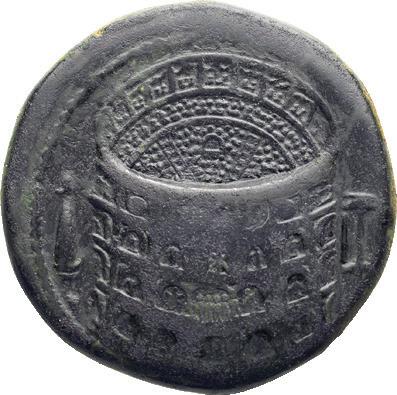



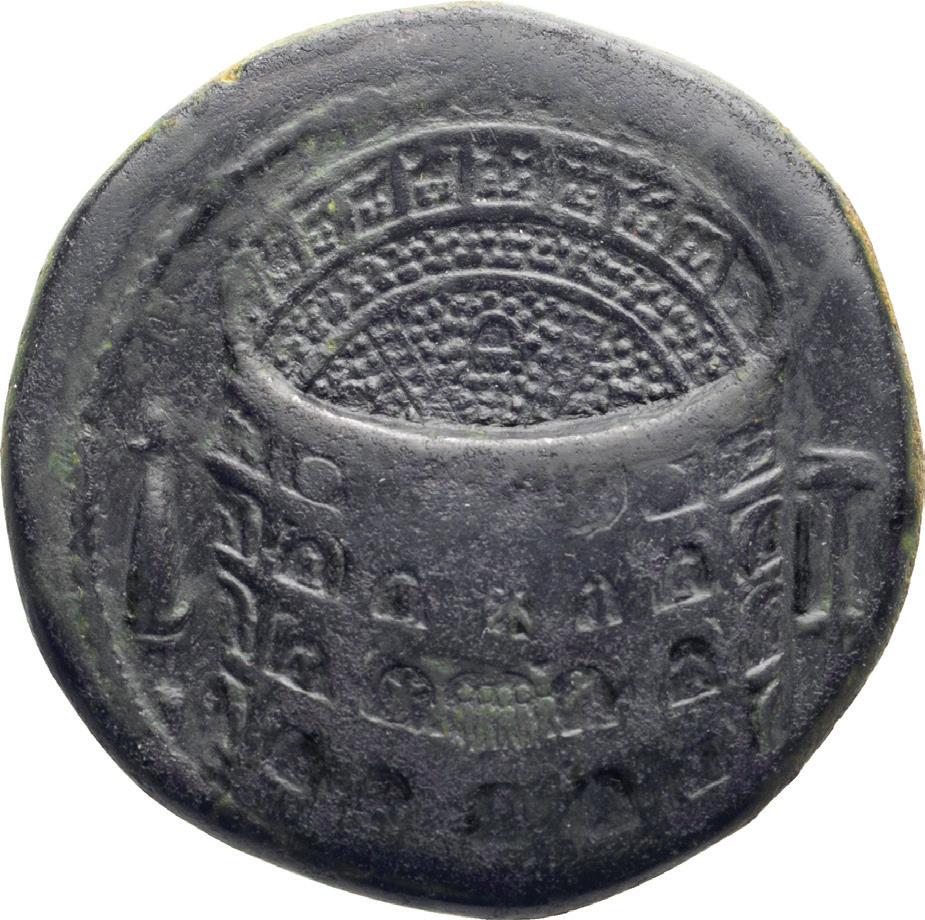
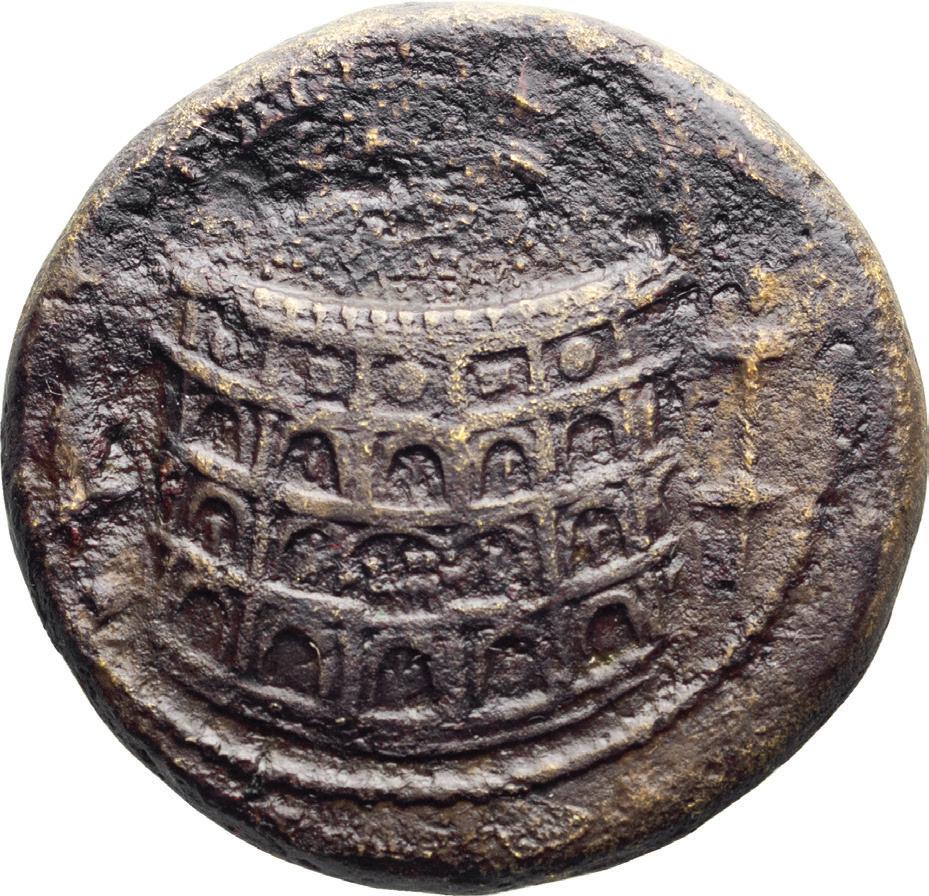
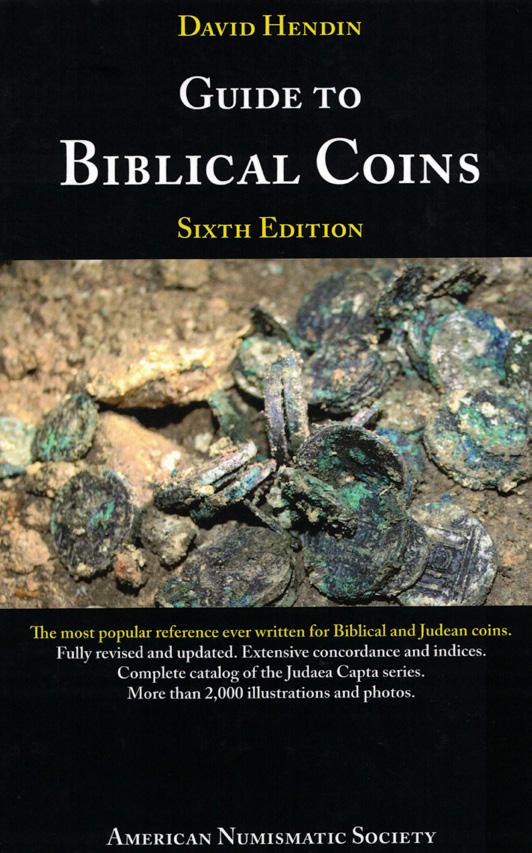
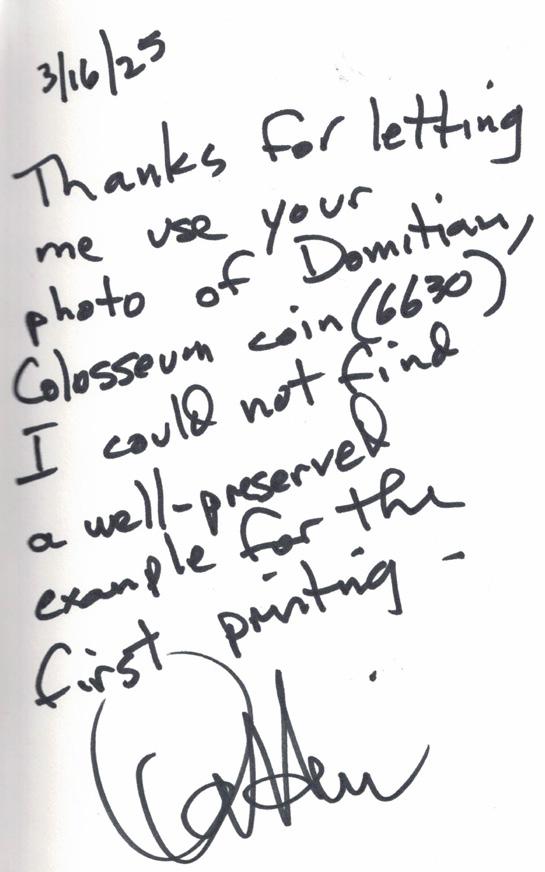


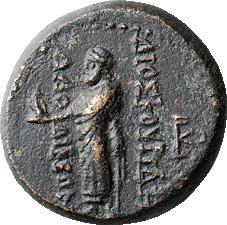

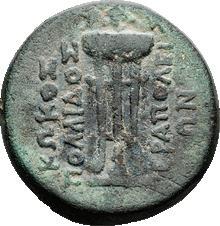
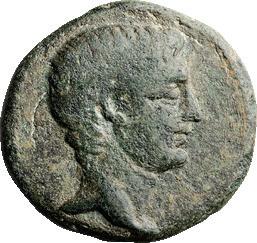



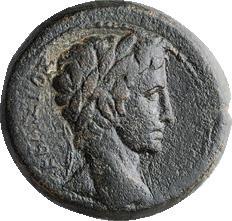
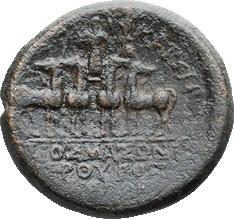

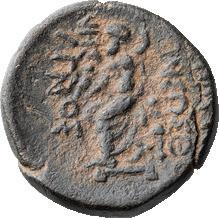


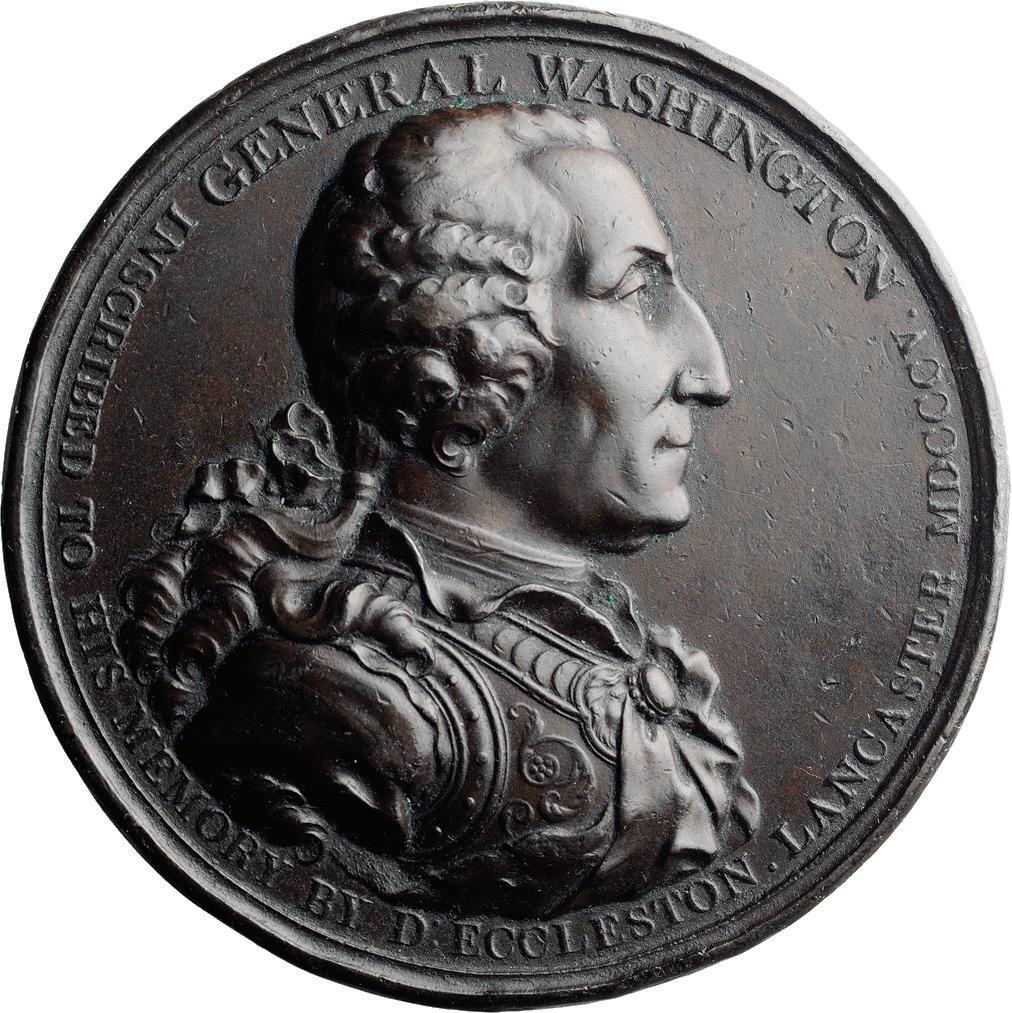

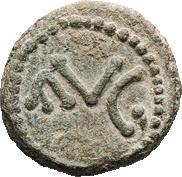
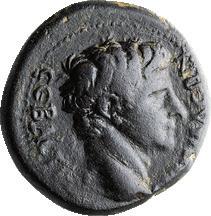


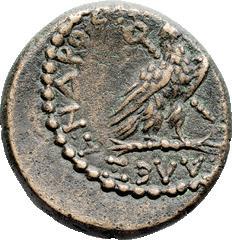
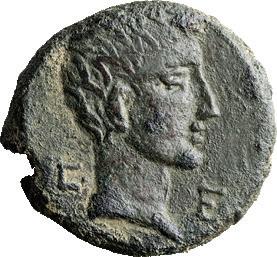


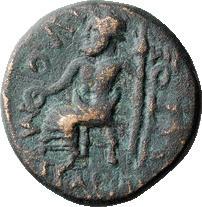

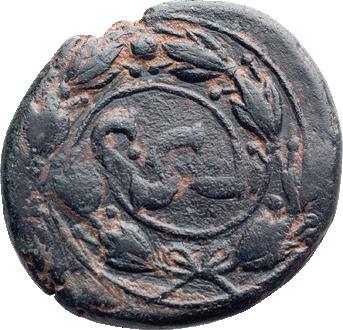

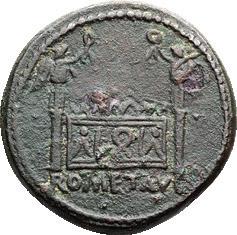
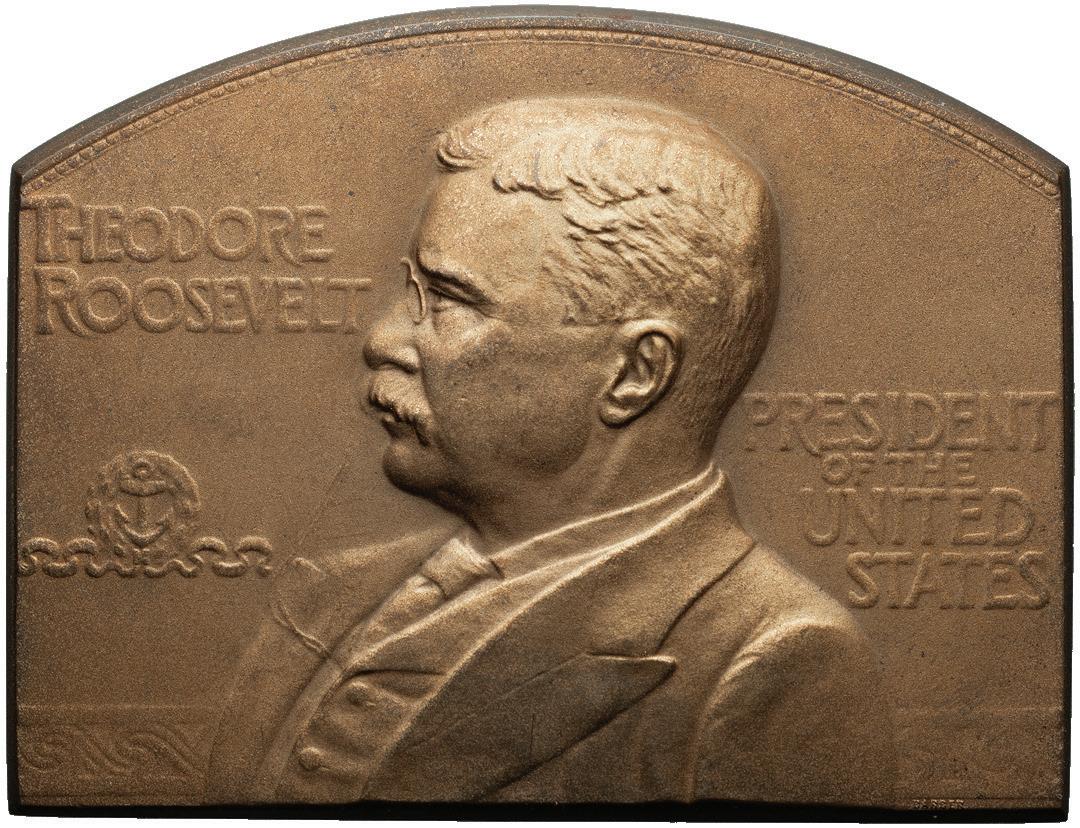
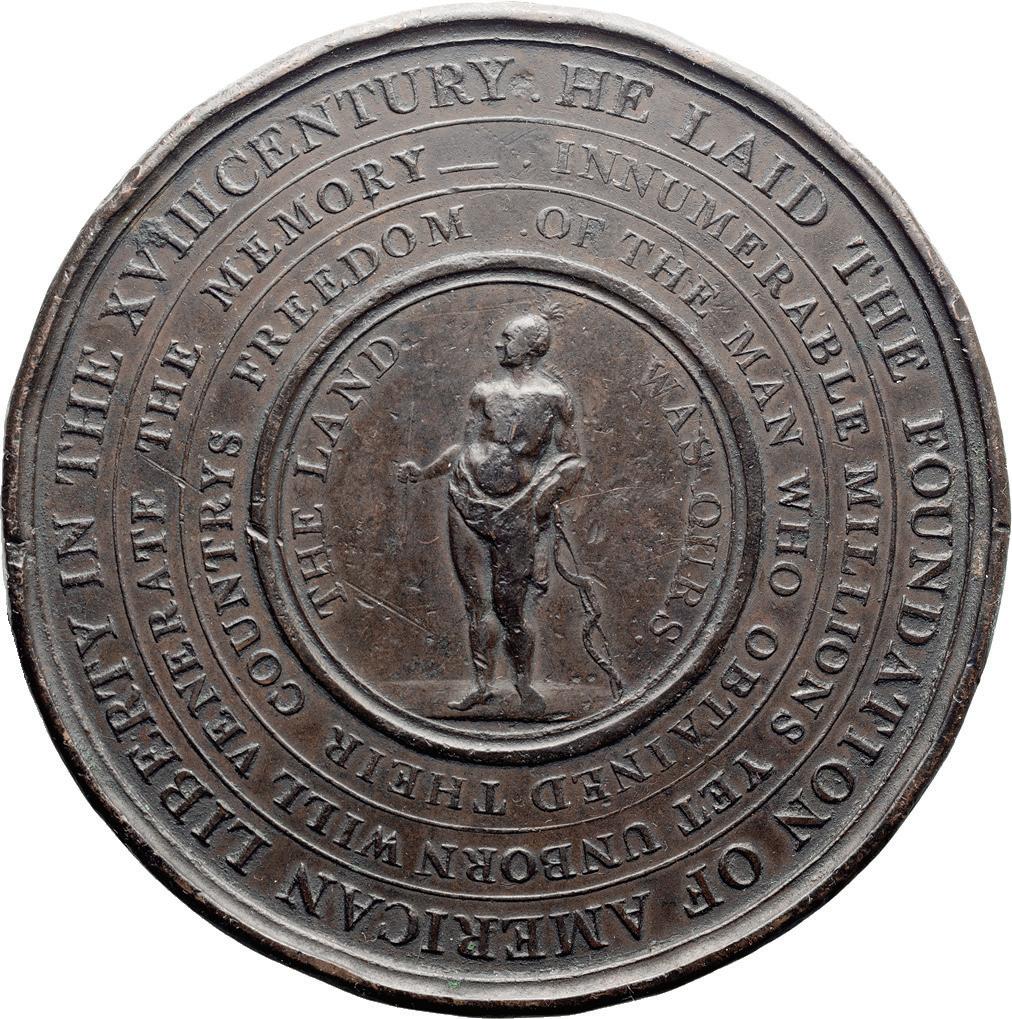
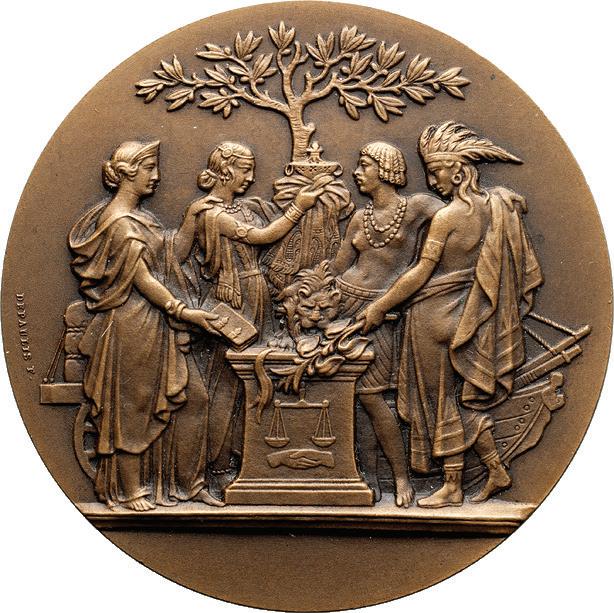

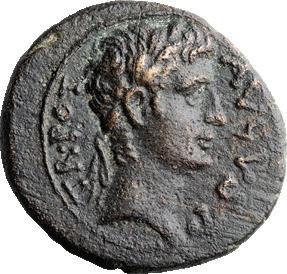
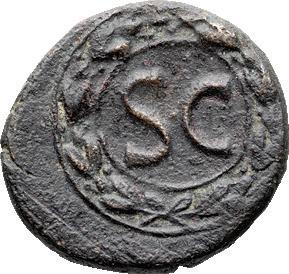
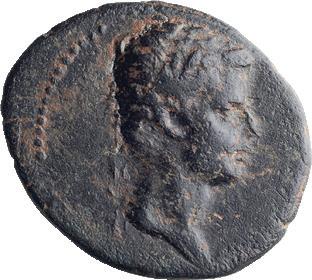
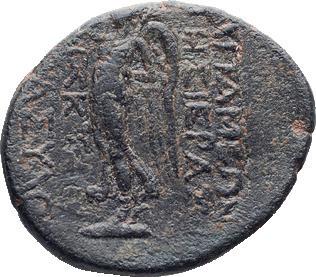
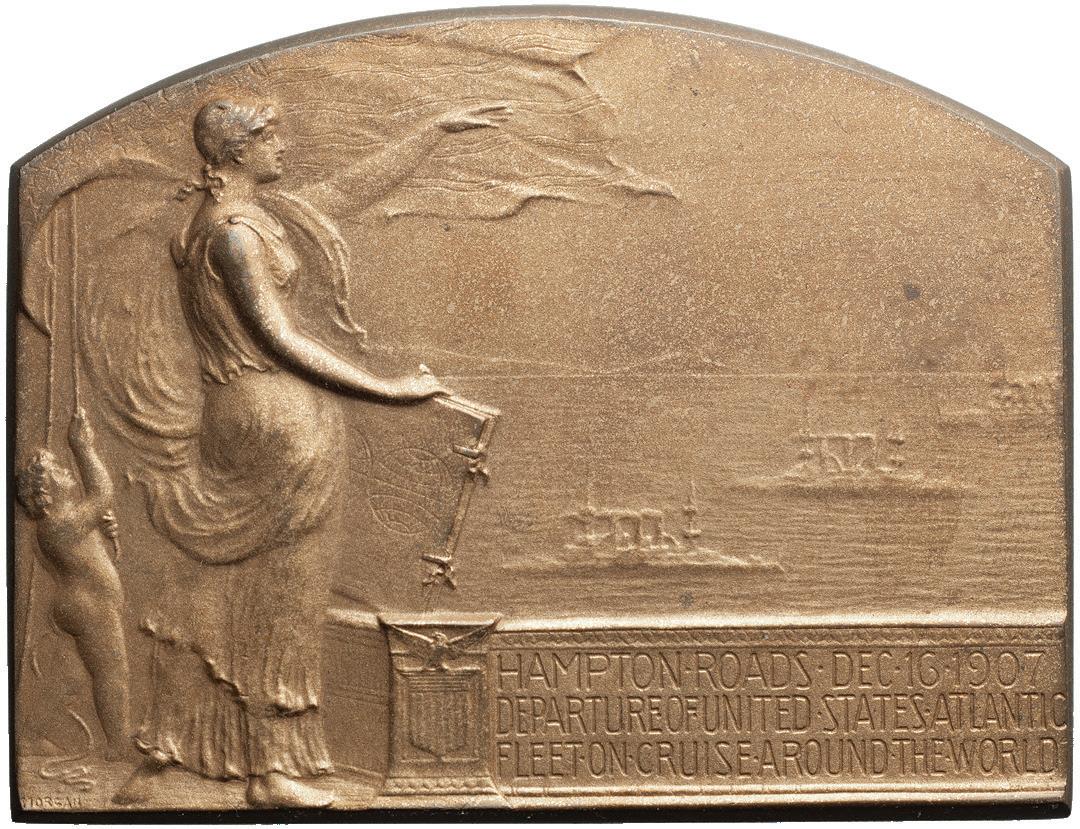
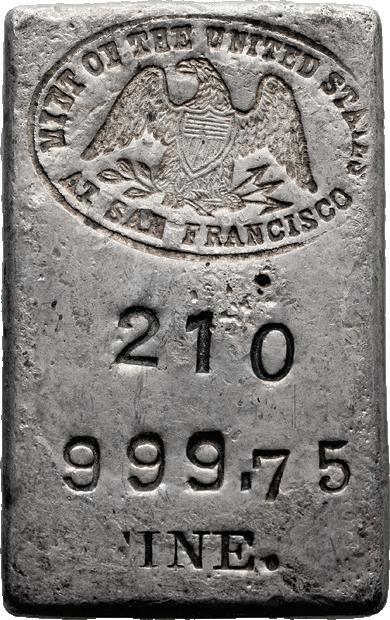

1980s-1990s. 10 mm 400
CYLINDER SEALS
567. MESOPOTAMIAN HEMATITE CYLINDER SEAL, 2nd Millennium BC. With worshipers. L. 1” (2.5 cm) 800
568. AKKADIAN SHELL CYLINDER SEAL, ca. 2350-2200 BC. A complex contest frieze between five sets of Bullmen and lions on hind. Some wear is present. Ex Krysko Collection, MA, purchased European art market 1980s-1990s. 28 mm 1500
569. MITANNIAN LIMESTONE CYLINDER SEAL, ca. 2nd Millennium BC. A central cross with flared ends and rays extending from the center is bordered by a single lined circle. To either side, v-chevrons and geometric shapes envelop the cross to either side. A single lined border above and below finishes the design.
Ex Krysko Collection, MA, purchased European art market 1980s-1990s. 31 mm 900
570. MITANNIAN BANDED CHALCEDONY CYLINDER SEAL, ca. Late 2nd Millennium BC. A scene of animals with a central lion leaping left. Above the lion, a fish swims right. Before the lion, a scorpion rests below and a large bird with head facing left and wings extended flies up. Bordered to top and bottom by single lines. Ex Krysko Collection, MA, purchased European art market 1980s-1990s. 11 mm 1250
571. SYRIAN EASTERN MEDITERRANEAN, Levant, ca. 2nd Millennium BC. Two horses, one facing left, the second facing on his side to the right. The horse facing to the left has his head extended to the other horse. The second horse seems to rise on hind, head high.
Ex Krysko Collection, MA, purchased European art market 1980s-1990s. 19 mm 900
572. SYRIAN GREEN JASPER CYLINDER SEAL, ca. late 2nd Millennium BC. A central male figure faces right on one knee, his hands raised. Before him, a lion faces right, one paw extended with two birds above in flight next to a rhomb. Behind the kneeling man, a bull faces right. Between them, a head of a man right. Behind the bull, a second smaller man with hand raised faces right. Behind him, a woman faces away, her head turned right. She rests on an ibex facing left. Five crescent moons are present above
Ex Krysko Collection, MA, purchased European art market 1980s-1990s. 17 mm 2250
573. SYRIAN LARGE GLAZED LIMESTONE CYLINDER SEAL, ca. mid 2nd Millennium BC. A seal in two registers. The top register is adorned with a complex knotwork. Two single lines separate the registers. Below a presentation scene with a seated official meeting a supplicant man in long gown before him. Behind, three other men wait in line, holding goods. Ex Krysko Collection, MA, purchased European art market 1980s-1990s. 41 mm 2000
574. NEO ASSYRIAN CARNELIAN CYLINDER SEAL, ca. 8th-6th Century BC. Two attendants with hands raised in supplication and attendance face a central Tree of Life with a winged sun above. Behind the supplicant to the right, two pillars rest, above them, the Pleiades. Drill type engraving.
Ex Krysko Collection, MA, purchased European art market 1980s-1990s. 19 mm 1275
575. NEO ASSYRIAN CARNELIAN CYLINDER SEAL, ca. 8th-6th Century BC. A winged griffon facing right advances with wings extended and head forward. Above a crescent moon, behind a star. Behind the griffon as well, a tree. Geometric designs before the head of the beast. Engraved in linear style.
Ex Krysko Collection, MA, purchased European art market 1980s-1990s. 13 mm 650
576. NEAR EASTERN WESTERN SEMITIC WHITE MARBLE STAMP SEAL, Late Bronze Age, ca. 2nd Millennium BC. A pseudo inscription is surrounded by hatch marks and feathered designs. The seal itself is a handled cachet with a knob, a piercing centrally is present for suspension.
Ex Krysko Collection, MA, purchased European art market 1980s-1990s. 15 mm 1650
577. NEAR EASTERN WESTERN SEMITIC LIMESTONE SEAL, ca. 7th-6th Century BC. Limestone with black inclusions, done in the style of Neo-Assyrian scaraboids. Two deer face prancing. Above each, a bird in flight facing inwards. Surrounding, drill point engraved designs.
Ex Krysko Collection, MA, purchased European art market 1980s-1990s. 17 mm 650
578. NEO ASSYRIAN CHALCEDONY SEAL, ca. 7th-6th Century BC. An ostrich with head turned to the left, wings spread. Drill style engraving
Ex Krysko Collection, MA, purchased European art market 1980s-1990s. 17 mm 950
579. NEO ASSYRIAN BANDED CARNELIAN STAMP SEAL, ca. 7th-6th Century BC. A scaraboid shaped stamp seal with vertical piercing for suspension. The face shows an ostrich with head facing left, its wings extended fully. Drill point style engraving.
Ex Krysko Collection, MA, purchased European art market 1980s-1990s. 18 mm 950
580. SASSANIAN MILKY CHALCEDONY STAMP SEAL, ca. 224-651 AD. An O type stamp seal with central piercing for suspension. On the face of the seal, a winged lion faces right, forepaw raised, and wings extended. Ex Krysko Collection, MA, purchased European art market 1980s-1990s. 9 mm 450
581. SASSANIAN CARNELIAN STAMP SEAL, ca. 224-651 AD. An O type stamp seal with piercing for suspension. On the face, a horse faces left, head down bucking. Above, a star.
Ex Krysko Collection, MA, purchased European art market 1980s-1990s. 14 mm 750
582. SASSANIAN CHALCEDONY STAMP SEAL, ca. 224-651 AD. An O type stamp seal with central piercing for suspension. On the face, a lion sits facing right, star behind. Ex Krysko Collection, MA, purchased European art market 1980s-1990s. 9 mm 450
EGYPTIAN
583. EGYPTIAN BRONZE CROWNED OXYRHYNCHUS, Late Period, 26th Dynasty, ca. 664-343 BC. The body with long dorsal fin and bifurcated tail, incised broad collar and eyes; the fish is crowned with a horned sun disc with frontal uraeus, behind which is a suspension loop. Rectangular integral base. L. 5 1/2” (14 cm) 2850
584. EGYPTIAN FAIENCE USHABTI, Late Period, ca. 715-330 BC. Green faience ushabti with single column of incised inscription down on the front. Wearing a false beard and holding the typical agricultural implements to serve in the afterlife. H. 5” (12.7 cm) 900
585. EGYPTIAN FAIENCE CUP WITH CARTOUCHE SETI 1, Late Period, ca. 700-30 BC. Blue-green glazed faience pottery conical cup having areas of tan color surface mottling. Black finely painted hieroglyphic register containing a royal cartouche Seti 1. A nice example. Provenance; Private New York City Egyptologist collection acquired from Arte Primitivo, lot 84. Ex CT collection, ex John Winnie Jr. collection, Georgia, 1980s-90s. H. 2” W. 2 1/4” (5 cm x 5.7 cm) 1950 586. EGYPTIAN DARK GREEN JASPER SCARAB, Late Period, ca. 664-332 BC. Ex Krysko Collection, MA, purchased European art market 1980s-1990s. L. 3/4” W. 1/2” (1.9 cm x 1.3 cm)
400 TERRACOTTA
587. SYRO-HITTITE TERRACOTTA FIGURE, ca. 2000-1700 BC. A terracotta idol with bird-like features including a pinched, beak-like nose and large, applied eyes. Ex-Rockefeller. H. 5 1/2” (14 cm)
600
588. GREEK TERRACOTTA VOTIVE KORE, ca. 6th Century BC. Standing draped female figure with long beaded hair. Her arms are held closely to her sides, himation drapes across her body from the left shoulder.
Ex Numismatic & Ancient Art Gallery AG, late 80s-early 90s. H. 6 3/4”, H. with base 10 3/8” (26.4 cm) 750 589. CANOSAN TERRACOTTA HORSE, ca. 3rd Century BC. A lifelike depiction of the animal in a dramatic rearing posture, with its forelegs lifted high. Its mane is thick, cropped short, and styled with sharp precision. The mouth is slightly open, creating a tense, focused expression, as if the animal is poised for action. The overall stance conveys power and alertness.
Ex Pearlstein. L. 7” (17.8 cm) 2250
CERAMICS
590. CYPRIOT EARLY CYPRO-GEOMETRIC BICHROME JUGLET, ca. 1000 BC. Red ware with one handle; white painted body decorated with black rings on the neck and three concentric circles on the body. De-accession from the Cyprus Museum of Jacksonville, North Carolina, acquired legally with the knowledge of the Cypriot Government; likely ex Cesnola Collection. H. 3 5/8” (9.2 cm) 1250 591. APULIAN RED-FIGURE VASE FRAGMENT, ca. 4th Century BC. Fragment of partial horsehead and riders hand. Provenance: Estate of artist Philip Pearlstein (1924-2022), New York.
L. 2 5/8” (6.7 cm)
450
592. APULIAN LEKANIS COVER, ca. 4th Century BC. Black glaze with some misfiring; concentric rings decorate the reserved knob.
Ex Colosseum Coin Exchange 1997. W. 3 7/8” (9.8 cm)
125 593. APULIAN LEKANIS COVER WITH HARE, ca, 4th Century BC. Red figure lid with running hare and palmettes.
Ex Paraskevaides Collection 2002. W. 3 7/8” (9.8 cm)
485 594. APULIAN RED SLIP KYLIX, ca. 4th Century BC. The inner surface of the cup with deep orange-red color and some darker decorative bands. The outer surface mostly covered in the same reddish slip with some reserved areas at the top. The cup rests on a small delicate foot.
Ex Paraskevaides Collection 2003.
W. 7 1/4” H. 2 5/8” (18.4 cm x 6.7 cm)
450 595. APULIAN SKYPHOS, ca. 4th Century BC. Professionally restored from large fragments.
Ex Paraskevaides Collection 2003.
H. 4 3/4” W. 7 7/8” (12.1 cm x 20 cm)
450 596. APULIAN SKYPHOS, ca. 4th Century BC. Professionally restored from large fragments.
Ex Paraskevaides Collection 2002.
H. 4 3/4” W. 7 7/8” (12.1 cm x 20 cm)
400 597. SOUTH ITALIAN DAUNIAN WARE JUG, ca. 6th-5th Century BC. A simply decorated jug with three bands of applied slip around the body, one around the short collar neck. Vertically set handle joined at the painted lip and first register on body.
Ex Paraskevaides Collection 2003. H. 5 1/2” (14 cm)
325 598. DAUNIAN KALATHOS, ca. 5th-4th Century BC. The vessel features a flattened base, cylindrical body and a wide flaring rim with added rays. Thick bands or red bordered by thinner bands adorn the body. Restored from a few fragments.
Ex Paraskevaides Collection 2003. H. 5” (12.7 cm)
650 599. DAUNIAN OLLA VESSEL, ca. 6th-4th Century BC. The piece features the typical wide funnel shaped rim and squat body with flat underside. The buff pottery is decorated with various bands and striations in rich brown umber. Two arched loop handles and two paddle handles arise from the center of the body. Area of restoration on the funnel.
Ex Paraskevaides Collection 2003. H. 8 1/2” (21.6 cm)
950
600. DAUNIAN BULL VESSEL, KYATHOS, ca. 6th Century BC. Wide, flat rim and high handle with zoomorphic horn-like projections, black and red geometric decorations.
Ex Paraskevaides Collection 2003. H. 12” (30.5 cm)
2000
601. GNATHIAN KYLIX WITH DOVE, ca. 4th Century BC. A shallow bowl with two upturned handles attached to either side. The inner surface of the drinking vessel features a decorative ivy tendril. Small white dove on the tondo. Repaired from large fragments. Restoration on one of the handles’ junction with the body.
Ex Paraskevaides Collection 2003. H. 2 1/2” x W. 8 1/8” (6.4 cm x 20.6 cm)
600
602. CAMPANIAN BLACK GLAZED BOWL WITH GORGON, ca. 4th
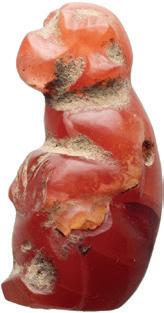

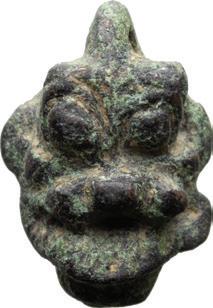

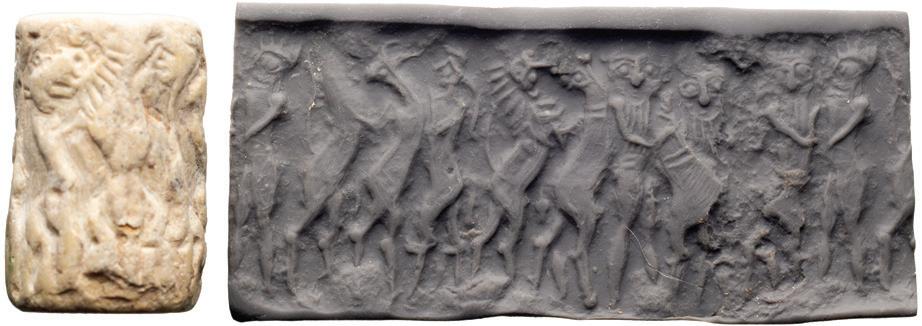


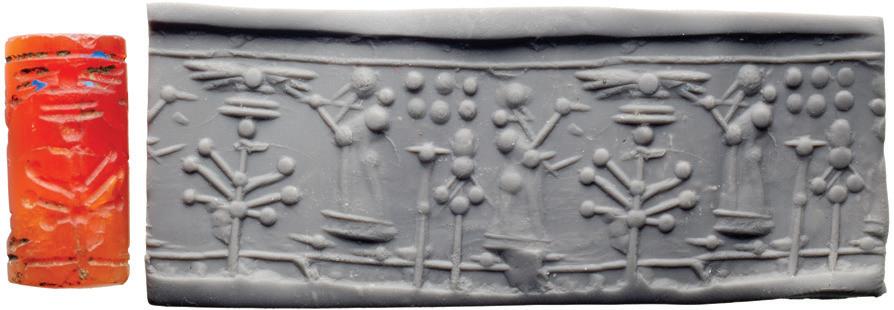

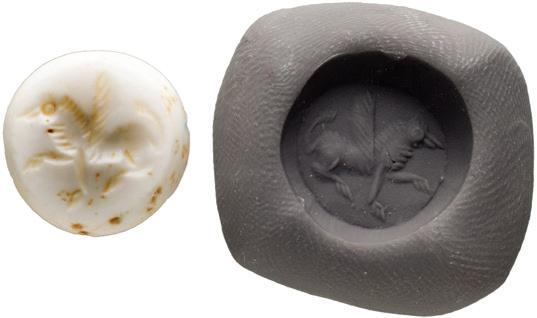

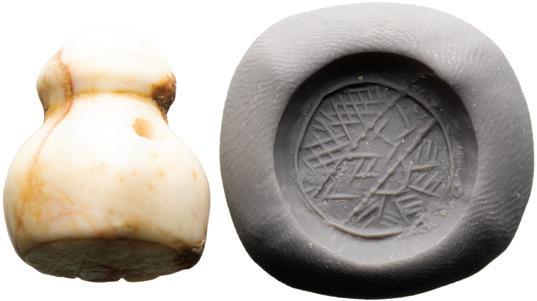
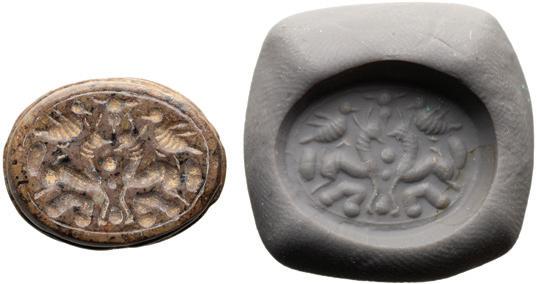
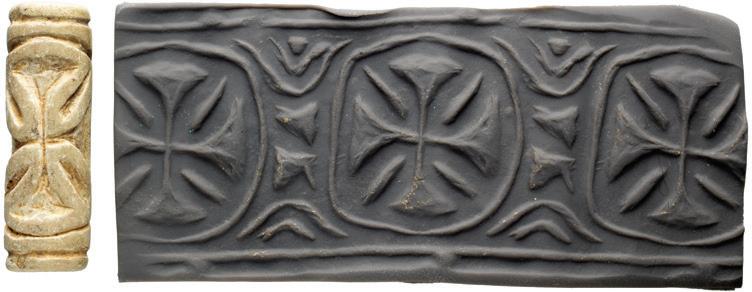



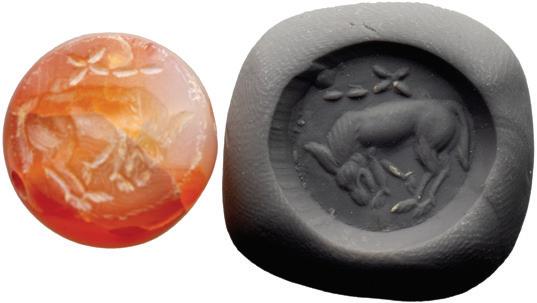

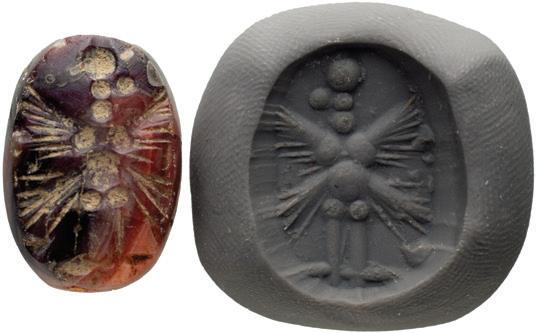
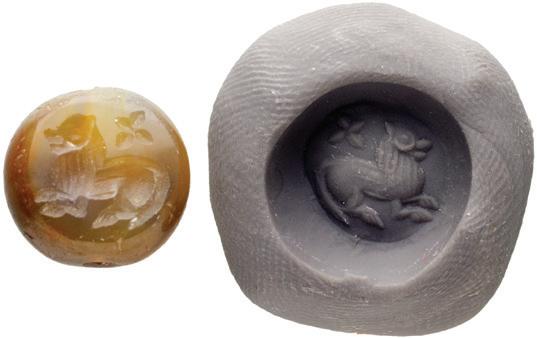









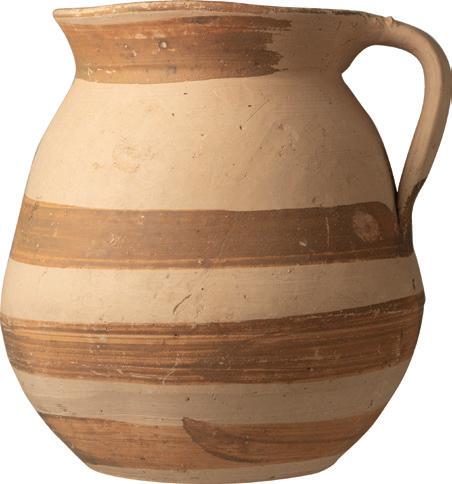
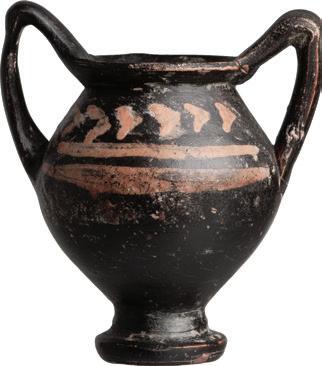
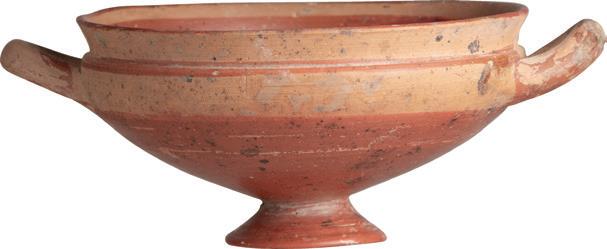




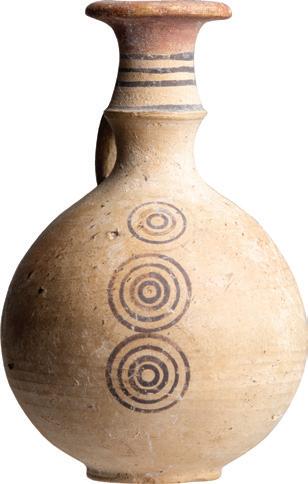

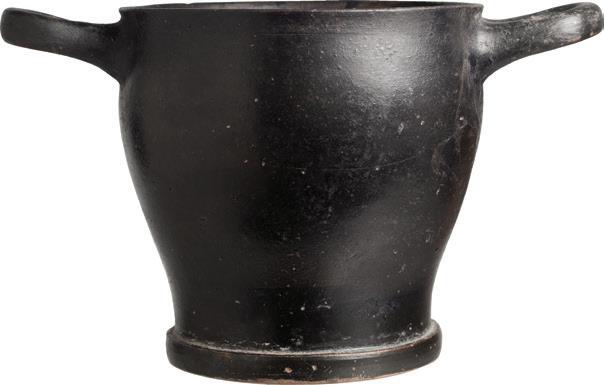

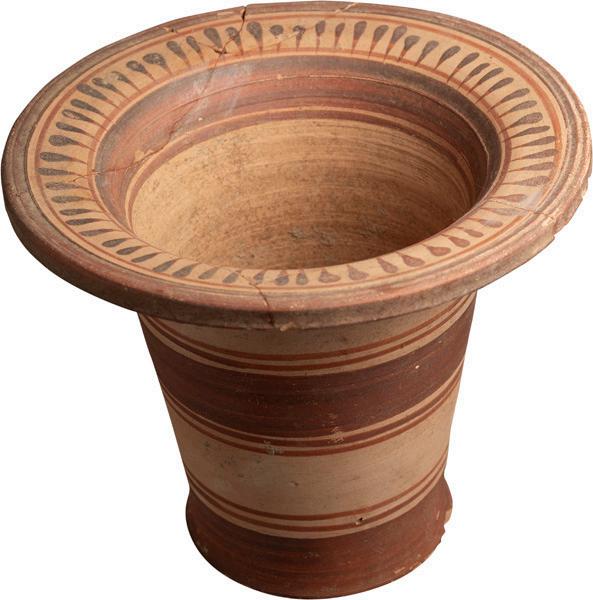

Century BC. Black glazed pottery footed bowl with an impressed interior design; a small gorgonian medallion surrounded by palmettes sits within a stamped chain. Small hatch marks cover the remainder of the tondo and slightly beyond. Ex Harlan J.Berk, Ltd., 2002. H. 2 1/2” W. 6 1/4” (6.4 cm x 15.9 cm) 1250 603. CAMPANIAN BLACK GLAZED BOWL, ca. 4th Century BC. A very attractive bowl with highly lustrous surfaces; the thick walls are decorated with an ornate ovolo pattern. Wide ring foot on the underside. Ex Elefteriou Collection; London, UK 2002. D. 7 1/2” (19 cm) 750 604. MAGNA GRAECIA MINIATURE XENONWARE AMPHORISKOS, ca. 4th Century BC. In miniature form, the robust body with central carination tapering to a slender foot, two high arching handles attach at the out-turned lip and body. Black glaze with a band of curvilinear design in red, two bands below. Ex Paraskevaides Collection 2003. H. 2 1/2” (6.4 cm) 275 605. CORINTHIAN ARYBALLOS, ca. 6th Century BC. A small globular vessel used to hold oils or perfumes. The body with quatrefoil design with added red leaves.
Ex Harlan J. Berk, Ltd., 2004. H. 2 1/2” (6.4 cm)
INTAGLIO
622. ROMAN CHALCEDONY INTAGLIO, ca. 1st-3rd Century AD. Depicting helmeted Mercury with, staff, satchel, and snake. L. 1/2” W. 3/8” (1.3 cm x 1 cm)
650
350
606. ATTIC BLACK-FIGURED FRAGMENT FROM A BAND CUP, ca. 540530 BC. The fragment decorated with a stylized lion with incised striations that accentuate his full mane. His tail sweeps up and over his body while he gazes back. Provenance: Alex G. Malloy, New York. A.S. Richter Collection, California, acquired 14 January 1997; private Connecticut Collection. H. 3” (7.6 cm)
400
607. ATTIC VI-CUP, ca. 475 BC. Finely potted, this rare vessel is notable for its elegant silhouette and the lustrous black glaze that envelops nearly the entire surface—including most of the underside of the stem foot—leaving only the slightly concave edge unglazed. The decoration is minimal and refined, featuring two incised lines at the base of the stem.
Repaired. W. 8 1/8” H. 2 3/4” (20.6 cm x 7 cm)
850
608. ATTIC BLACK GLAZED FOOTED DISH, ca. 5th Century BC. Stable crack on the underside; two small drill holes on the foot. Acquired by current owner in 2003. 3 1/2” diameter (8.9 cm)
300
609. ATTIC BLACK GLAZE STEMLESS KYLIX, ca. 5th Century BC. The double handled vessel featuring a broad bowl with curved walls, sitting upon a tiered foot.
Ex Paraskevaides Collection 2002. W. 6 3/4” (17.1 cm)
400 BRONZES
610. LURISTAN BRONZE IBEX FIBULA, ca. 9th-7th Century BC. The ibex is positioned facing left, its legs tucked beneath its body. It features prominent muscles, large round eyes, and impressive horns that curve back over its head. Reverse pin and catch missing.
Provenance: Stephen Joel Albert (6 February 1941–27 December 1992), New York; thence by descent. L. 1 3/4” (4.4 cm)
750
611. GREEK BRONZE KOUROS, ca. 6th Century BC. Ex Numismatic & Ancient Art Gallery AG, late 80s-early 90s. H. 1 3/4”, H. with base 3 3/8” (4.4 cm x 8.6 cm) 950
612. ROMAN BRONZE BULL, ca. 2nd-3rd Century AD. The bull modeled with defined musculature and facial detail, he stands foursquare on an integral plinth. L. 1 5/8” H. 1 1/2” (4 cm x 3.8 cm)
450
613. ROMAN BRONZE DOUBLE PHALLIC AMULET, ca. 1st-3rd Century AD. This amulet features three distinct symbols— the phallus, male genitalia, and the mano fica (a vulgar hand gesture). Each individually served as a powerful apotropaic symbol, believed to protect against the Evil Eye. By incorporating multiple apotropaic symbols in one amulet, the user reinforced its protective potency. The more explicit or defiant the imagery, the better it could safeguard the wearer. W. 2 1/8” (5.4 cm) 850
614. ROMAN BRONZE LION HEADED IRON KEY, ca. 2nd Century AD. A bronze handle cast in the form of a crouching, snarling lion, its powerful jaws clenched around an object. The key emerges from the rear, elegantly integrated into the decorative terminal.
Provenance: East Coast collection, New York Gallery, New York City, New York, USA; ex-collection of a European gentleman based in the United Kingdom, formed in the 2000s, acquired on the German art market. L. 3 1/8” (7.9 cm) 1650 BYZANTINE
615. LATE ROMAN OR BYZANTINE HANGING CENSER, ca. 5th-7th Century AD. The vessel with deeply curved walls adorned with a dramatic relief scene of fish, waterfowl, and humans. Three pierced nubs on the rim for suspension. Dia. 4 1/2” H. 2 5/8” (11.4 cm x 6.7 cm) 3750
616. BYZANTINE BRONZE RELIQUARY CROSS, ca. 9th-12th Century AD. This cross, like others of its kind, consists of two cross-shaped halves joined by a hinge at the base, allowing it to open and reveal a hollow compartment intended to contain a relic. A beautiful, complete example. L. 3 1/2” W.1 3/8” (8.9 cm x 3.5 cm) 1250
617. BYZANTINE BRONZE RELIQUARY CROSS HALF, ca. 9th-12th Century AD. Cruciform Christ Pantokrator facing. L. 4” (10.2 cm) 650
618. BYZANTINE HALF RELIQUARY CROSS, ca. 9th-12th Century AD. Deeply incised, facing orans posture. L. 3 7/8” W. 2 1/8” (9.8 cm x 5.4 cm)
750
619. BYZANTINE BRONZE HARNESS RING WITH BELLS, ca. 9th-12th Century AD. A decorative ornamental piece of a horse’s regalia. L. 1 3/4” W. 1 1/2” (4.4 cm x 3.8 cm)
450
620. BYZANTINE SILVER CROSS PENDANT, ca. 9th-12th Century AD. A smaller pendant crafted in silver, inscribed on one side. Loop intact. L. 1 1/4” W. 3/4” (3.2 cm x 1.9 cm) 900
621. MEDIEVAL BYZANTINE LARGE BRONZE CROSS, ca. 9th-11th Century AD. Fashioned from two thin hammered sheets of bronze. This bronze Byzantine cross has flaring arms each terminating in pairs of discs. The cross could be carried in a processional and/or, as wear on the lower arm of the cross might indicate, affixed in a stand. L. 8 5/8” W. 5 5/8” (21.9 cm x 14.3 cm) 1850
623. ROMAN CARNELIAN INTAGLIO, ca. 1st-3rd Century AD. A larger intaglio with a draped lady, possibly Venus leaning on a pedestal. L. 1” W. 11/16” (2.5 cm x 1.7 cm)
1250
624. ROMAN SARDONYX INTAGLIO, ca. 1st-3rd Century AD. Depicting a bearded theater mask. L. 3/4” W. 1/2” (1.9 cm x 1.3 cm) 1450
625. ROMAN ROCK CRYSTAL INTAGLIO, ca. 1st-3rd Century AD. Perseus slaying the Cetus (sea monster). L. 1 1/8” W. 15/16” (2.3 cm x 2.4 cm)
950 626. ROMAN CARNELIAN INTAGLIO, ca. 1st-3rd Century AD. Two facing figures, one seated with frond behind. L. 5/8” W. 1/2” (1.6 cm x 1.3 cm)
1400
650 627. ROMAN EROTIC INTAGLIO, ca. 1st-3rd Century AD. Erotic scene with an eros looking on. L. 11/16” W. 9/16” (1.7 cm x 1.4 cm)
628. ROMAN CARNELIAN INTAGLIO, ca. 1st-3rd Century AD. Standing Fortuna with her attributes. L. 7/16” W. 5/16” (1.1 cm x .8 cm)
500 629. ROMAN AGATE INTAGLIO, ca. 1st-3rd Century AD. Head in profile. L. 11/16” W. 1/2” (1.7 cm x 1.3 cm) 1250
630. ROMAN RED JASPER INTAGLIO, ca. 1st-3rd Century AD. Profile. L. 11/16” W. 1/2” (1.7 cm x 1.3 cm) 1250
631. ROMAN CARNELIAN INTAGLIO, ca. 1st-3rd Century AD. Winged Victory facing Athena. Small chip to edge. L. 11/16” W. 1/2” (1.7 cm x 1.3 cm)
950
632. ETRUSCAN BANDED AGATE SCARAB WITH SIREN IN GOLD SETTING, ca. 4th Century BC. Sotheby, Wilkinson & Hodge, Catalogue of The Story-Maskelyne Collection of Ancient Gems, 5 July 1921, lot 59. Marjorie Bronfman (1917-2012), Montreal, acquired prior to 31 March 1966; gifted to her daughter, Dr. Corinne Bronfman (1947-2022), Washington, D.C.; thence by descent.
Stone L. 3/8” W. 1/4” (1 cm x .6 cm), Ring W. 3/4” approx. size 6 2500 JEWELRY
633. SYRIAN WESTERN ASIATIC PENANNULAR EARRING, ca. 18th-16th Century BC. Made from gold foil over a copper core. Striations decorate the loop which is opened at one side. W. 3/4” (1.9 cm)
400
634. PHOENICIAN FACE BEAD, POLYCHROME, ca. 5th-2nd Century BC. Face bead with large added blob eyes, exaggerated with applied nose, flanked by additional knobs in yellow. Some pitting and weathering. L. 7/16” W. 7/16” (1.1 cm x 1.1 cm)
300
635. PHOENICIAN RAM’S HEAD PENDANT, ca. 4th-3rd Century BC. Suspension loop intact. L. 3/4” W. 1/2” (1.9 cm x 1.3 cm)
325 GLASS
636. PHOENICIAN GLASS RECTANGULAR VESSEL, ca. 5th-3rd Century BC. H. 1” W. 7/8” (2.5 cm x 2.2 cm)
900 MISCELLANEOUS
637. SCYTHIAN FAIENCE HORSE PLAQUE, ca. 9th-8th Century BC. Exceptional color. The plaque is highly stylized with notched details. Two pairs of attachment holes on the body.
Ex-Rockefeller. L. 3 5/8” (9.2 cm)
2500
638. GREEK ITALIC AMBER RAM’S HEAD PROTOME, ca. late 6th-early 5th Century BC. In the form of a ram’s head, the somewhat flattened head well-detailed with ridged, underslung horns, a grooved ridge at the flat back. Similar pieces have sold for double what we are asking.
L. 15/16” (2.4 cm)
2500
639. ROMAN BONE DIE, ca. 1st-3rd Century AD. This six-sided die is fashioned from bone, with each face meticulously incised to denote its numerical value. The markings consist of circular motifs, each comprising a prominent outer ring encircling a smaller central circle.
Ex Krysko Collection, MA, purchased European art market 1980s-1990s. 14mm
300 SCULPTURE
640. CYPRIOT LIMESTONE HEAD OF A PRIEST OR VOTARY, ca. 5th Century BC. Wearing a conical headdress, his face with pointed chin, long nose, and large almond-shaped eyes.
D.M. Collins Antiques, London, 1949; Private Collection New York, thence by decent, collection of Dr. Gary Moore, 1950s, NY; private collection acquired 1983. L. 5” W. 2 3/4” (12.7 cm x 7 cm) 2350
641. ROMAN MARBLE BASE WITH FOOT, ca. 1st-2nd Century AD. Carved on a fragmentary integral base, and wearing a sandal with horizontal strap above the toes.
Ex. Howard Nowes, NY, Volume III, #2, Winter 2001. Ex. W. Frolich Collection #3206. L. 9 3/4” H. 4 1/2” (24.8 cm x 11.4 cm) 1850
642. SABEAN LIMESTONE DOUBLE IBEX, ca. 1st Century AD. With characteristic high arching curled horns, small bulbous eyes, and a raised vertical line representing the nose, and small rectangular beards, pointed ears behind the horns.
Ex Numismatic & Ancient Art Gallery AG, late 80s-early 90s. H. 4 7/8” W. 3 1/2” (12.4 cm x 8.9 cm) H. with base 7 3/8” 1850 WEAPONS
643. NEAR EASTERN LEVANT OR ANATOLIAN SILVER DUCK BILL AXE, ca. 2nd millennium BC. Slightly thickened shaft hole incorporated into the moulded oblong “duckbill” design. Near shaft, two stretched oval fenestrations with raised edges. Central ridge running the length of the blade.
Complete, small hole at shaft guide, incrustation. Extremely rare in silver.
Ex Numismatic & Ancient Art Gallery AG, No. 8, lot 63, early 90s. L. 2 1/2” H. 1 1/2” (6.4 cm x 3.8 cm) 2000

